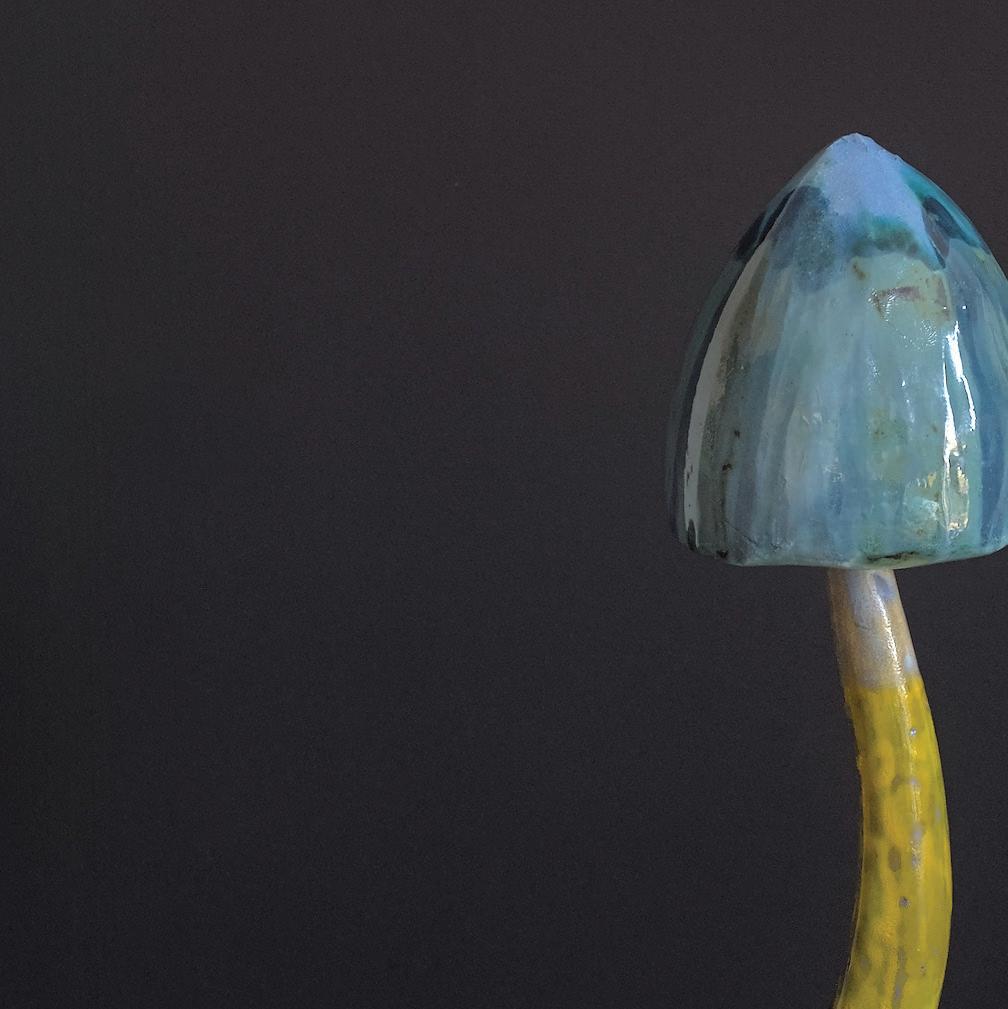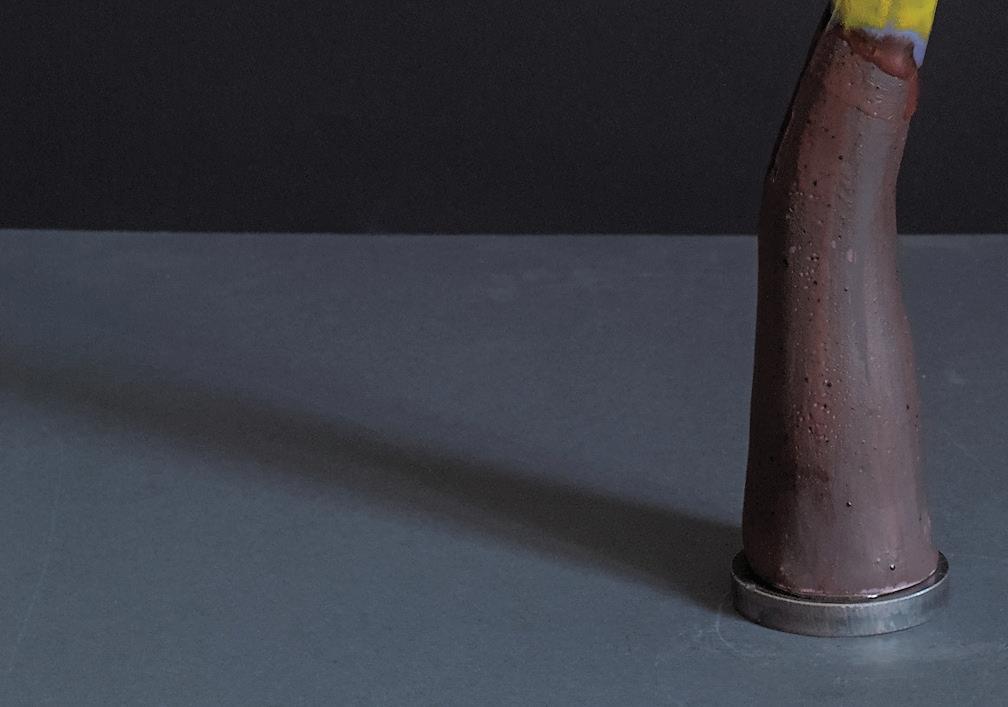Tim Copsey
Matthew Cronshaw
Fernando Garcés
Nina Gerada
Karine Hilaire
Clara Holt x Unurgent Argilla

Zuleika Melluish
Bisila Noha
Michael Rice
Unurgent Argilla
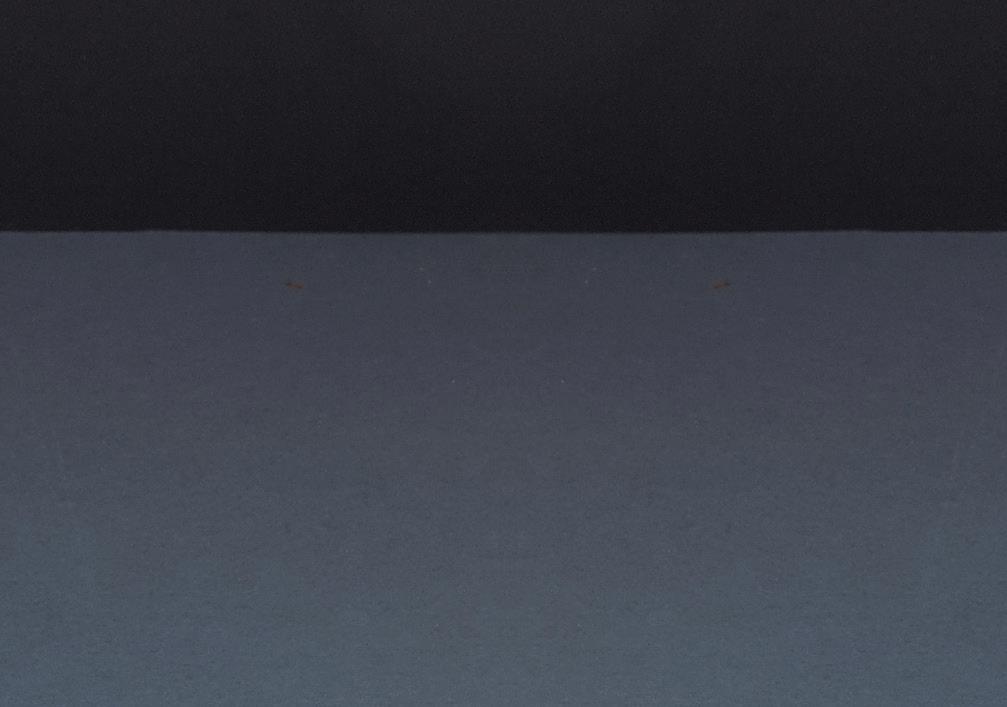
Lucia Zamberletti
Grounded
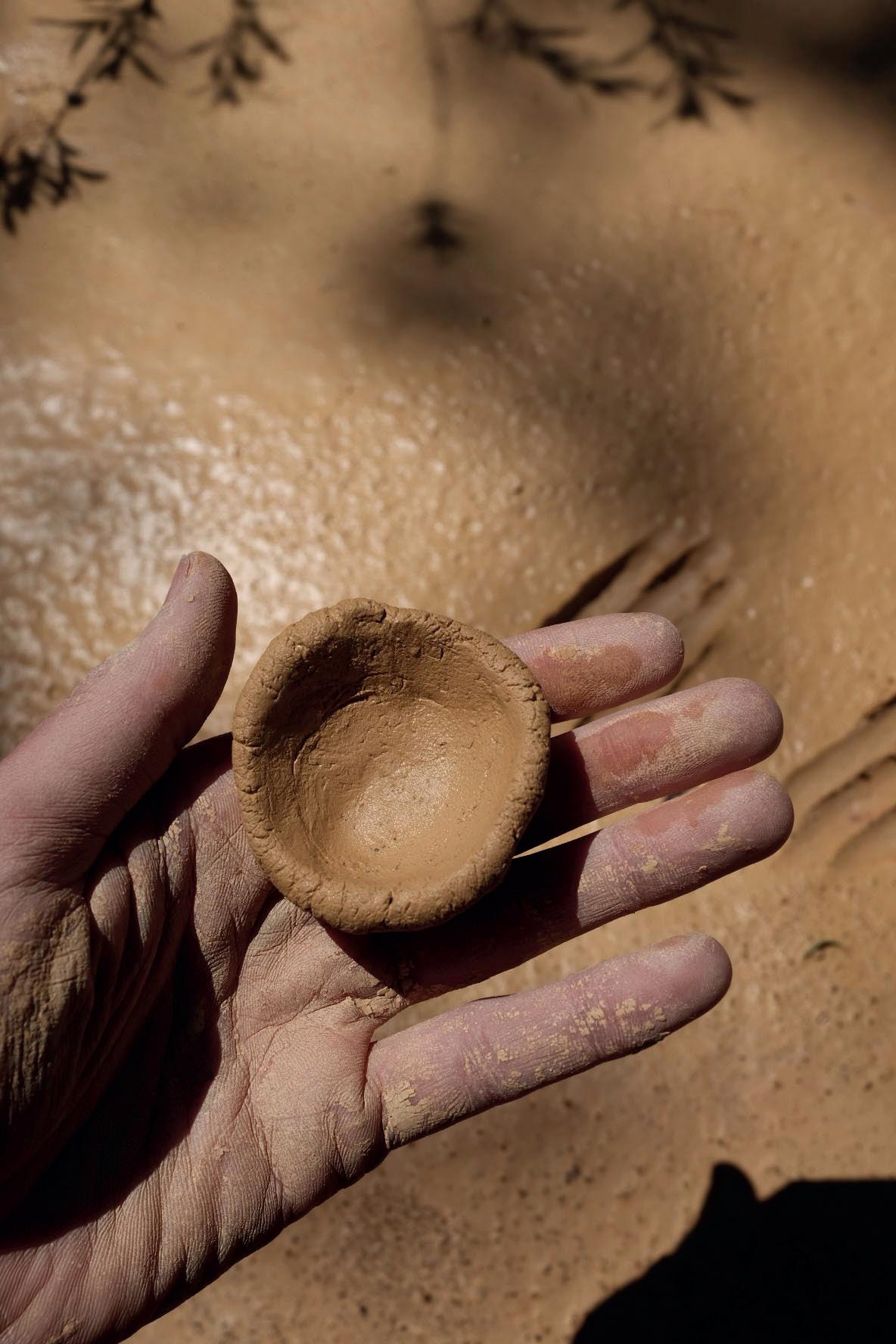
A curated collection by Thrown for Collect at Somerset House (3rd - 5th March 23)
Grounded brings together eleven distinctive artists using clay to explore material connections, landscape and heritage
Image left:
Wild kaolinitic clay from Valence
Photograph by Unurgent Argilla
Zuleika Melluish‘I am fascinated by the physical quality of plants: the textures and patterns of leaves, stems and flowers. For some years, I have been pressing plants into clay and continue to be captivated by the detail they leave behind. It seemed a logical progression then, to describe plants sculpturally, moving from inscribing clay with the structure of plants, to building their forms three-dimensionally.’
‘This collection began with my trying to find a way to capture the tangled messiness of the Jasmine that I have growing in my garden and have seen tumbling over walls as I walk around London. I love the way the neat scented flowers and the precise pinnate leaves contrast with the plant’s undisciplined rambling nature. Similarly Wisteria has a delicacy in flower that belies its rampant strength. Acanthus leaves are an age-old architectural motif, but their incredible sculptural flowers, made up of a tissue-thin corolla encased by spiny sepals, are often overlooked. By juxtaposing the assumed fragility of porcelain with malleable wire attached and visually softened with tissue paper, I aim to capture this contradiction of strength and delicacy which is so often a characteristic of plants and flowers.’
‘I enjoy the challenge of replicating every detail of the plant: first observing and dissecting the living plant and then modelling each component by hand. I am awed by the complexity of a plant’s construction and, beyond its botany, how every petal or leaf has a subtle difference in the way it curls or ripples or curves. These aspects lend themselves well to hand-making, so although a repetitive process, each small piece is satisfyingly unique.’
‘Living with these sculptures over the past months, I am startled to see how, in spite of the static nature of the material, they are constantly changing. As when looking up into the canopy of a tree or watching Wisteria flowers hanging in front of my studio window, these pieces are full of movement as they continually respond to the play of light. The absence of colour or glaze and the hardness of wire and porcelain allows the forms to take on a surprisingly organic life of their own, which is a very satisfying outcome considering the awesome vitality of the plants that are my inspiration.’
Detail of Jasmine (Wall Panel)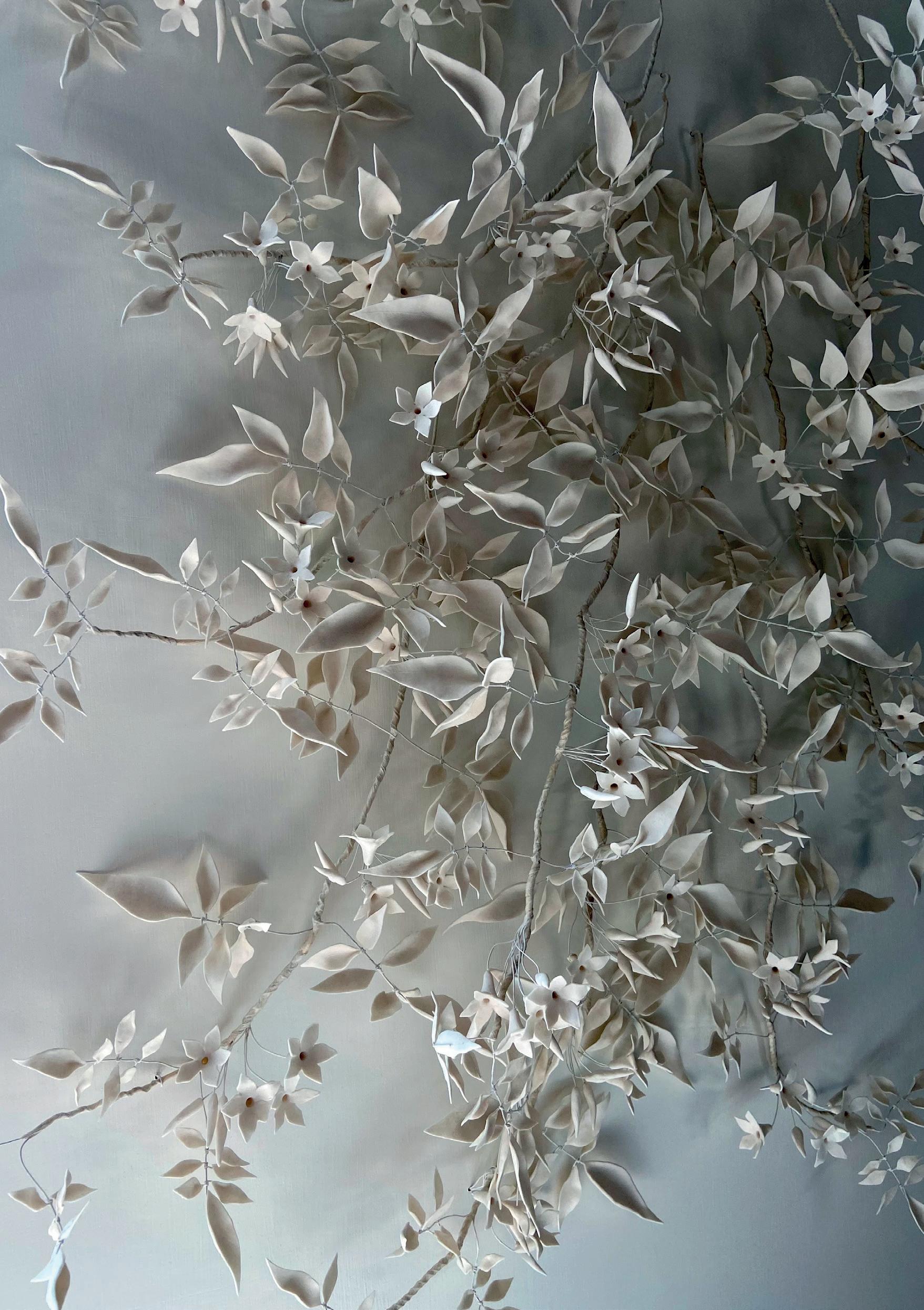
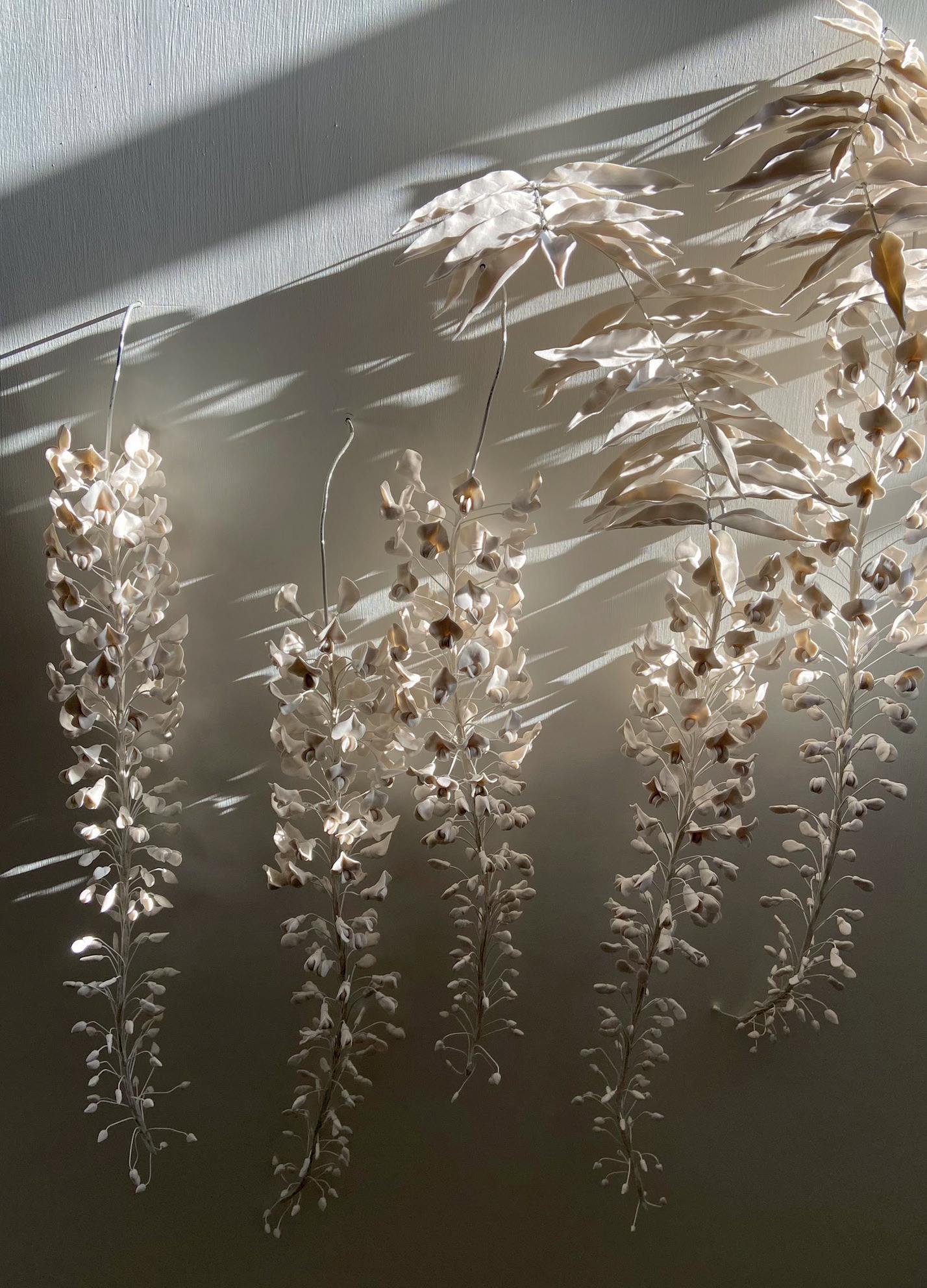
Zuleika Melluish is a London-based ceramicist whose work seeks to describe plants in both their physical form and pictorially whether viewed individually or grouped together.
Her work takes direct inspiration from the plants around her, from the Wisteria that covers the outdoors walls of her Kentish Town studio to the perennial garden that she has had the opportunity to create from scratch in the foothills of the Cambrian mountains in Wales.
“Making a garden is a long, slow process, and that, combined with its distance from my home in London, means it is an unruly garden untended for long periods of time so that nature takes over: plants self seed and grow where they will, wildlife nests and burrows without bounds. Every visit to the garden has a surprise with something new and unplanned appearing in the beds or lawns or dell. Inevitably this makes me look closely at what is growing, often initially just to identify the plants that have appeared, and then to respond with my own planting by trying to combine with and compliment what is already there. Through these observations I became enchanted with the complexity and detail in the flowers and foliage and have sought to capture both in my ceramics.”
Wisteria (Wall Panel)
Porcelain, wire and abaca paper, mounted on wooden board
H 122 cm, w 92cm, d 25 cm

Jasmine (Wall Panel)
Porcelain, wire and abaca paper, mounted on wooden board
H 122 cm, w 92 cm, d 20 cm
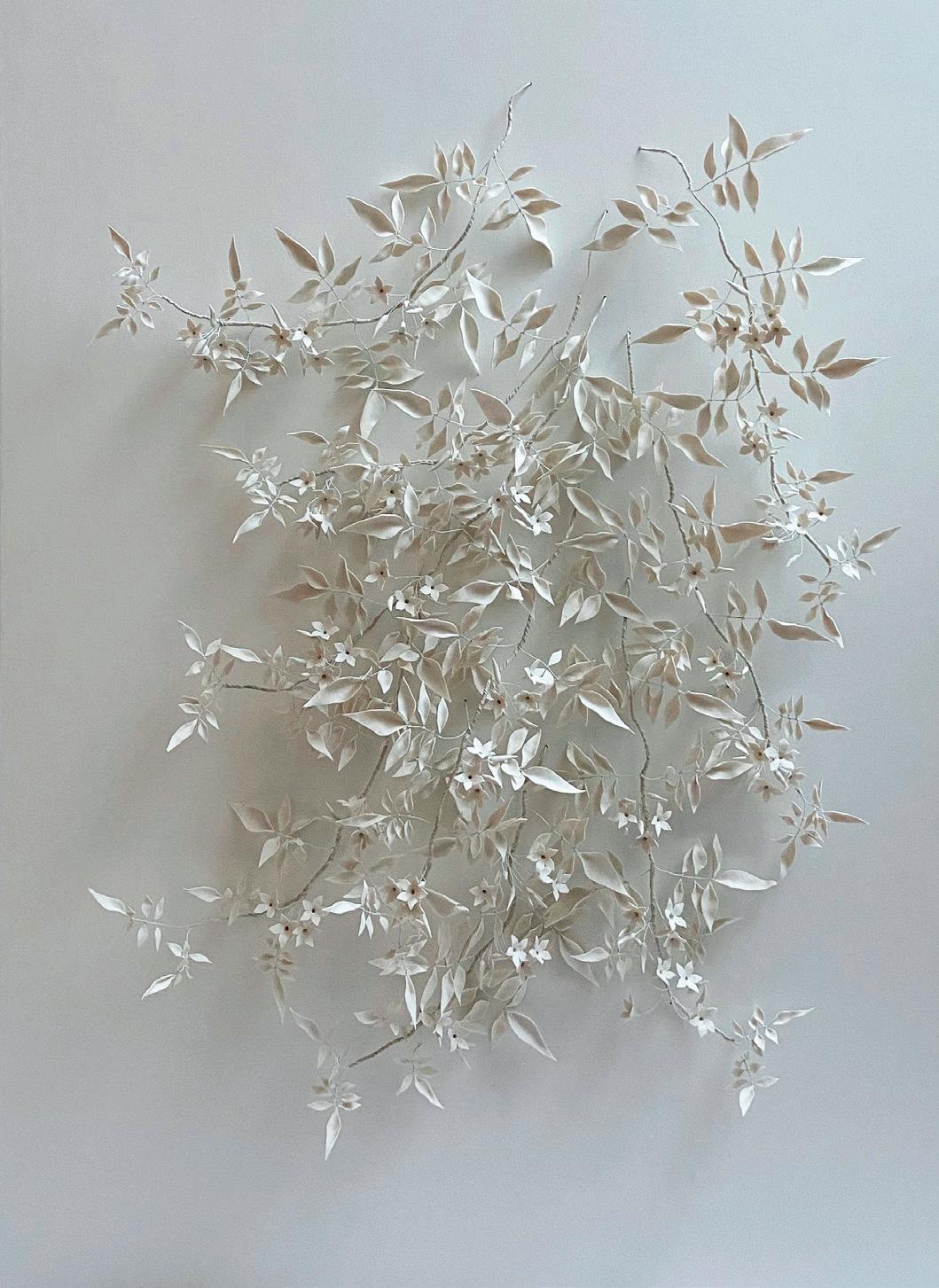
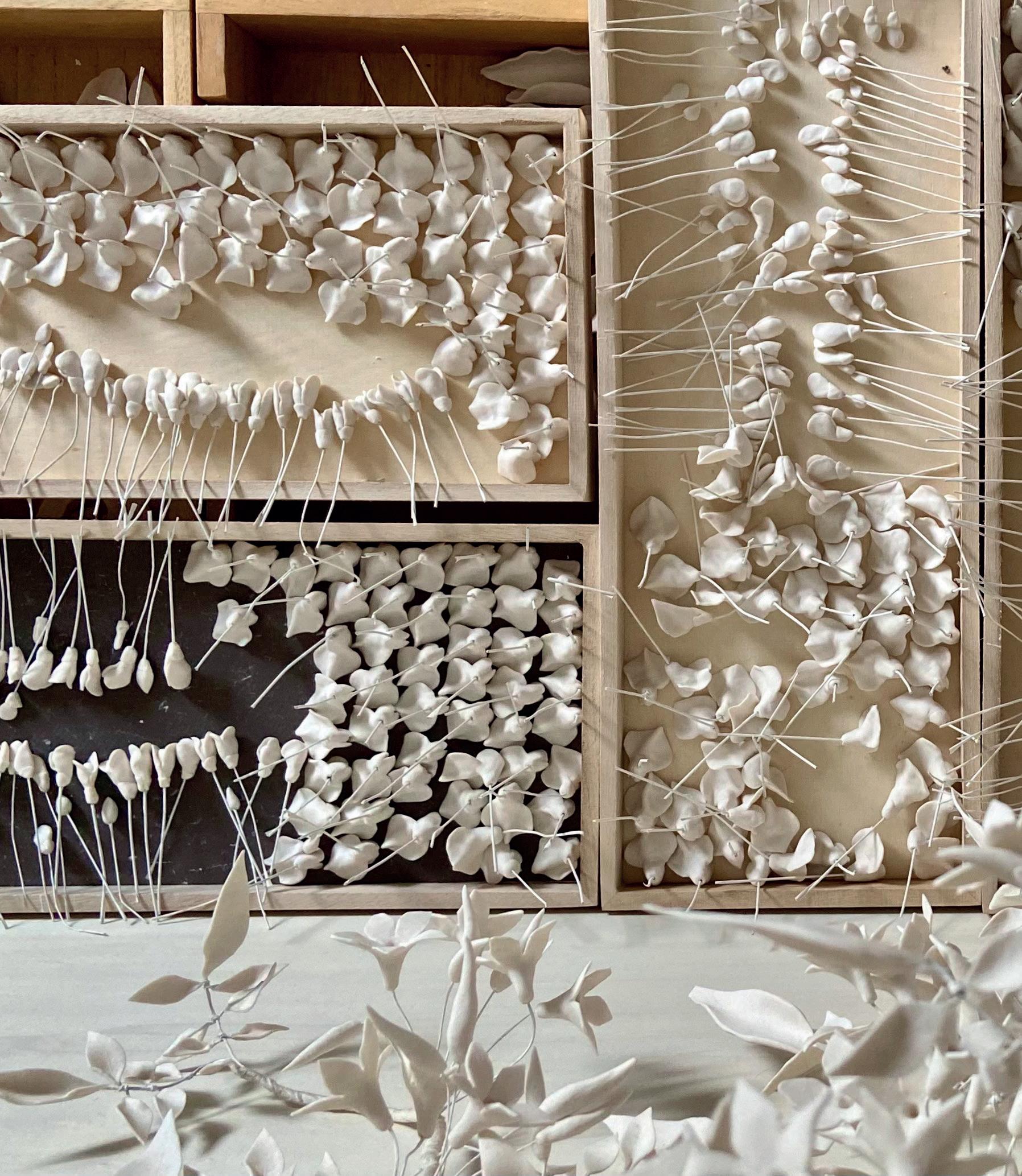
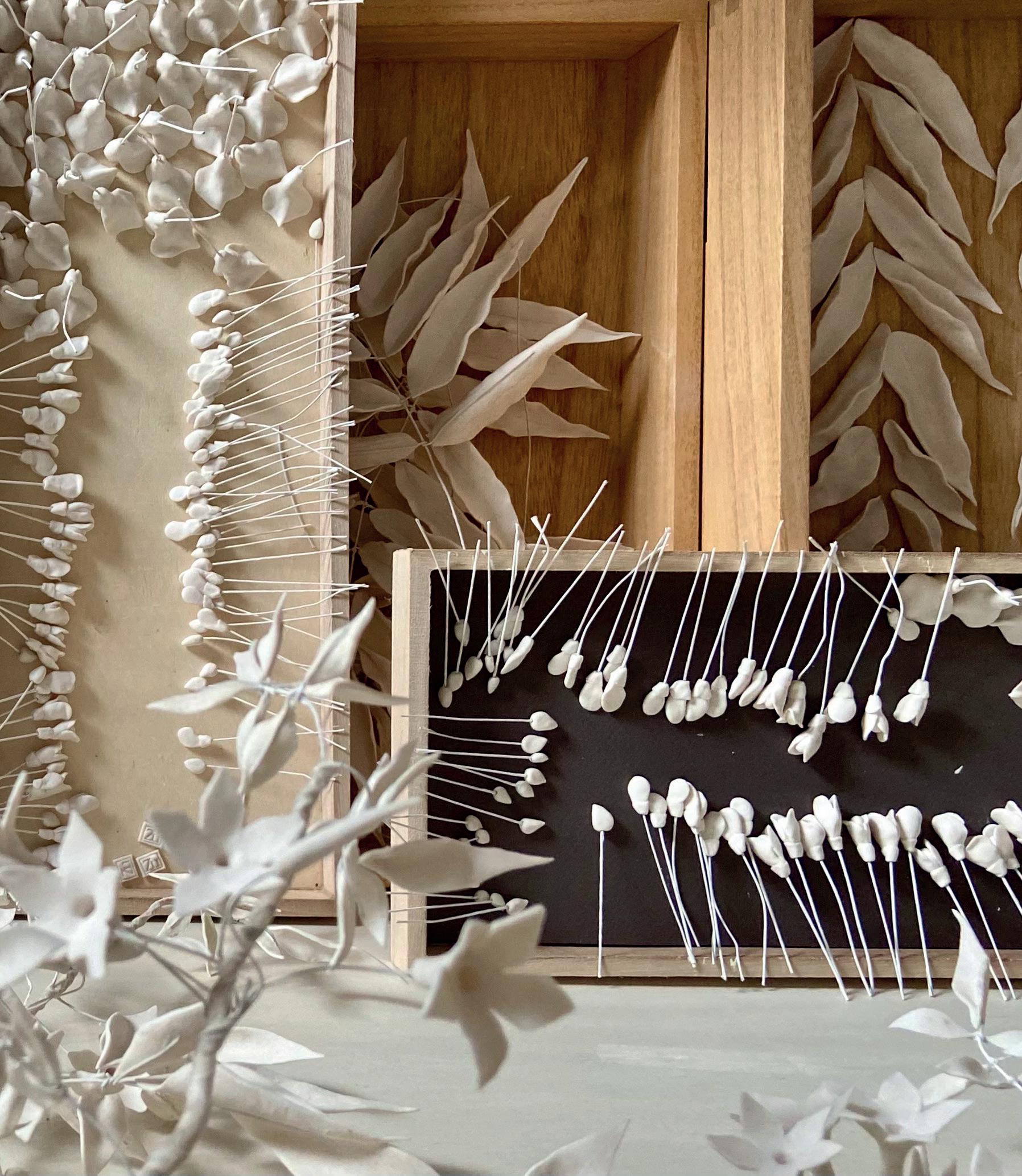
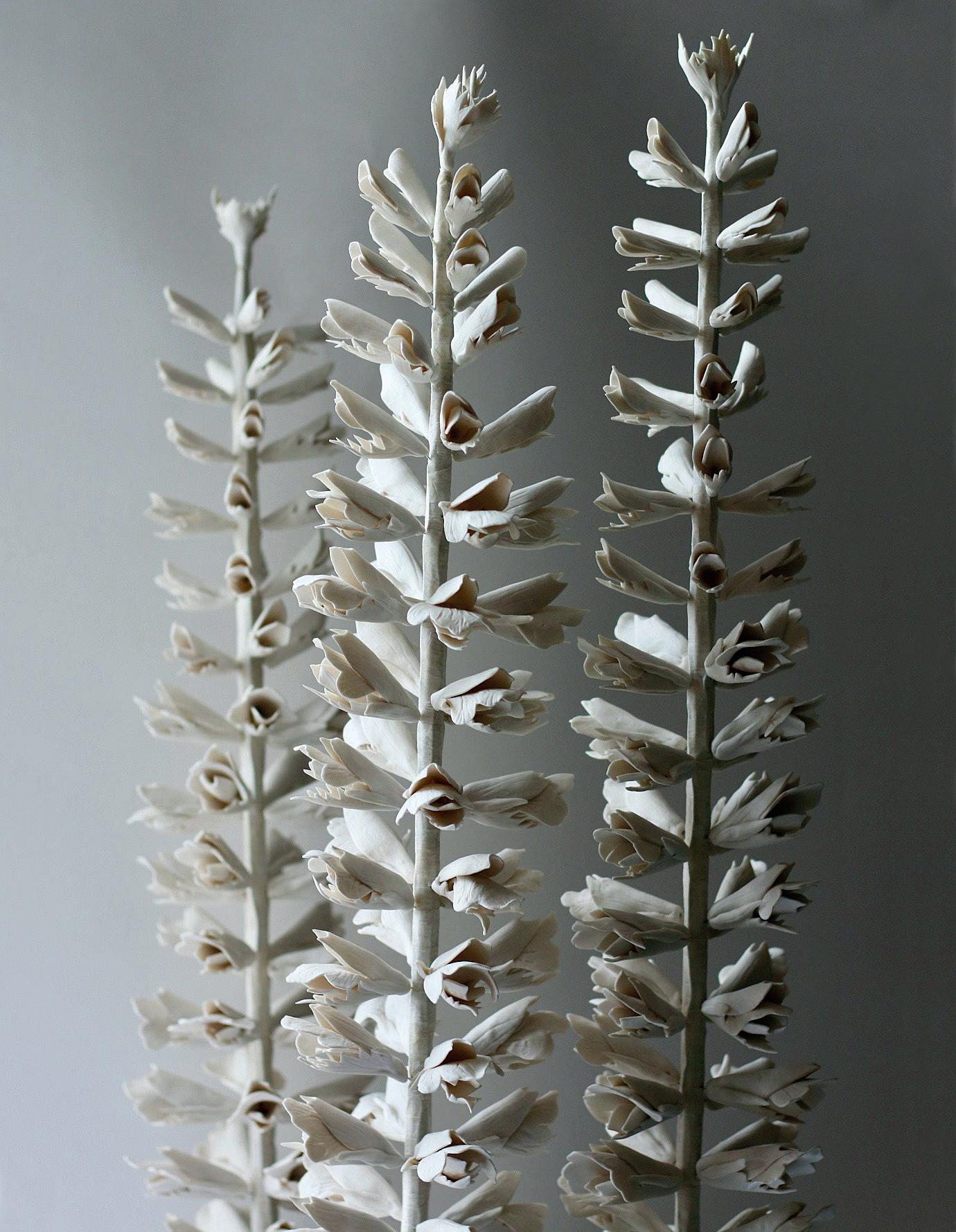
Acanthus 1, 2 & 3
Porcelain, wire, wood and abaca paper, mounted on wooden base
H 74, 76 & 80 cm, ø 15 cm
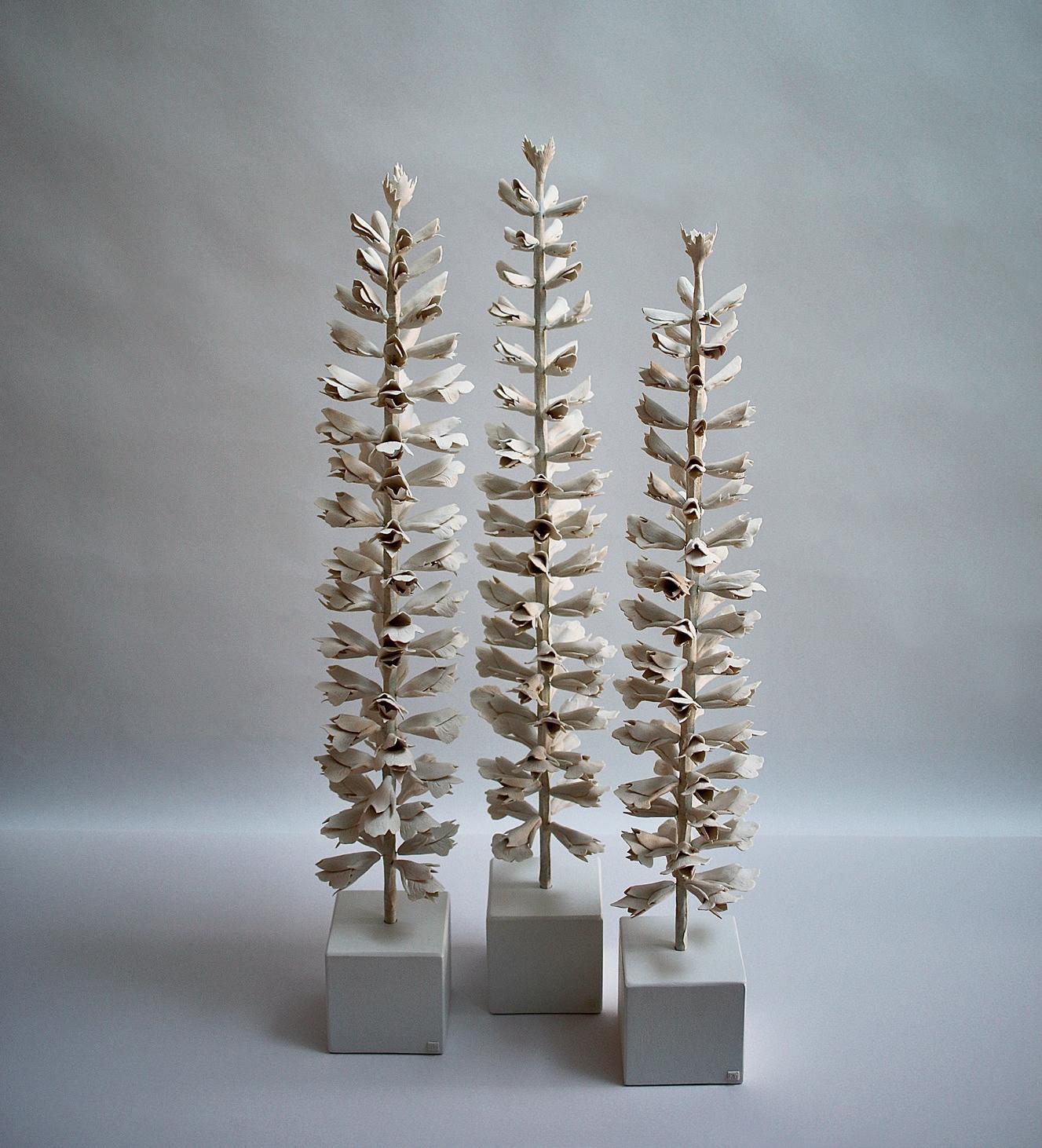
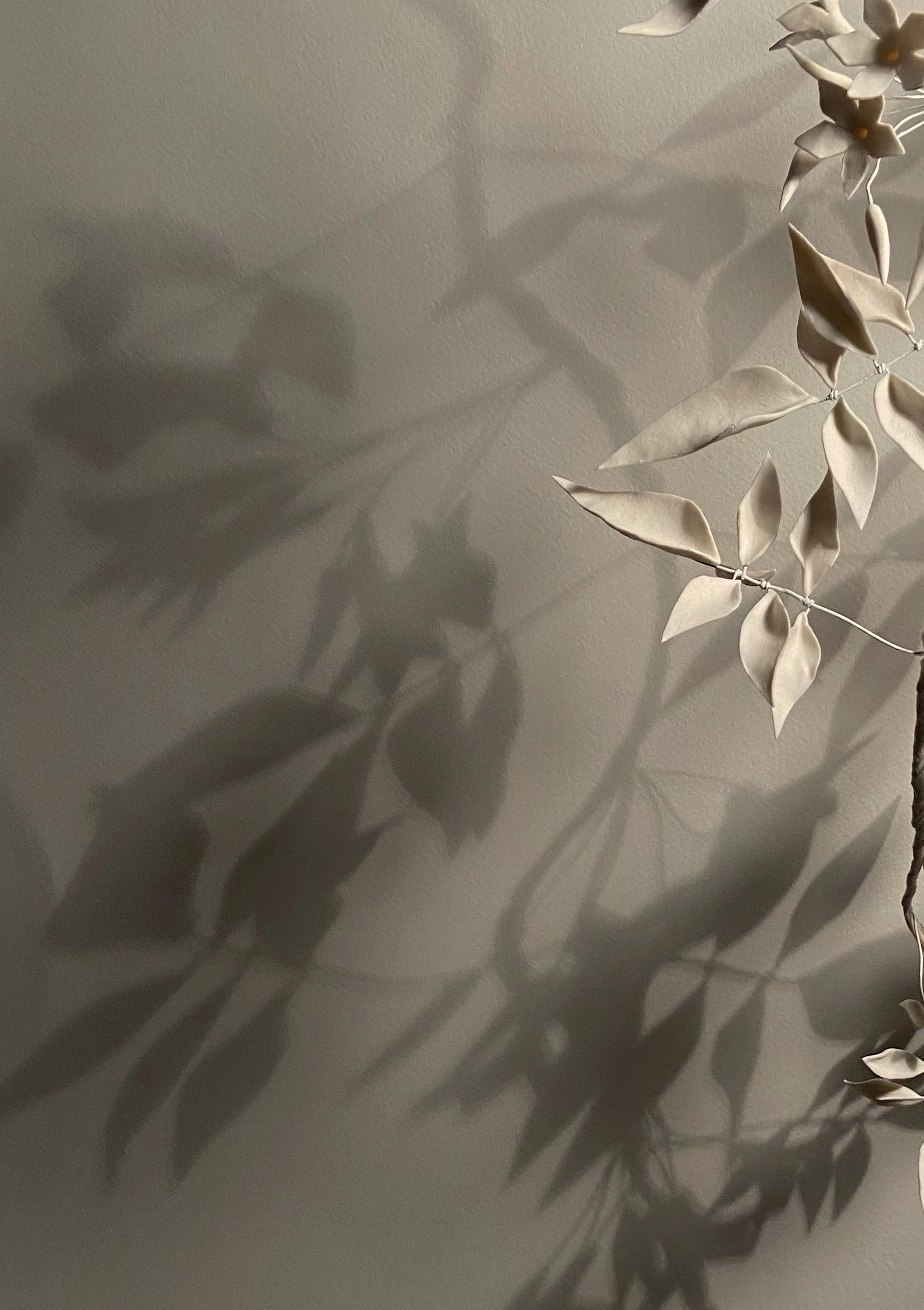
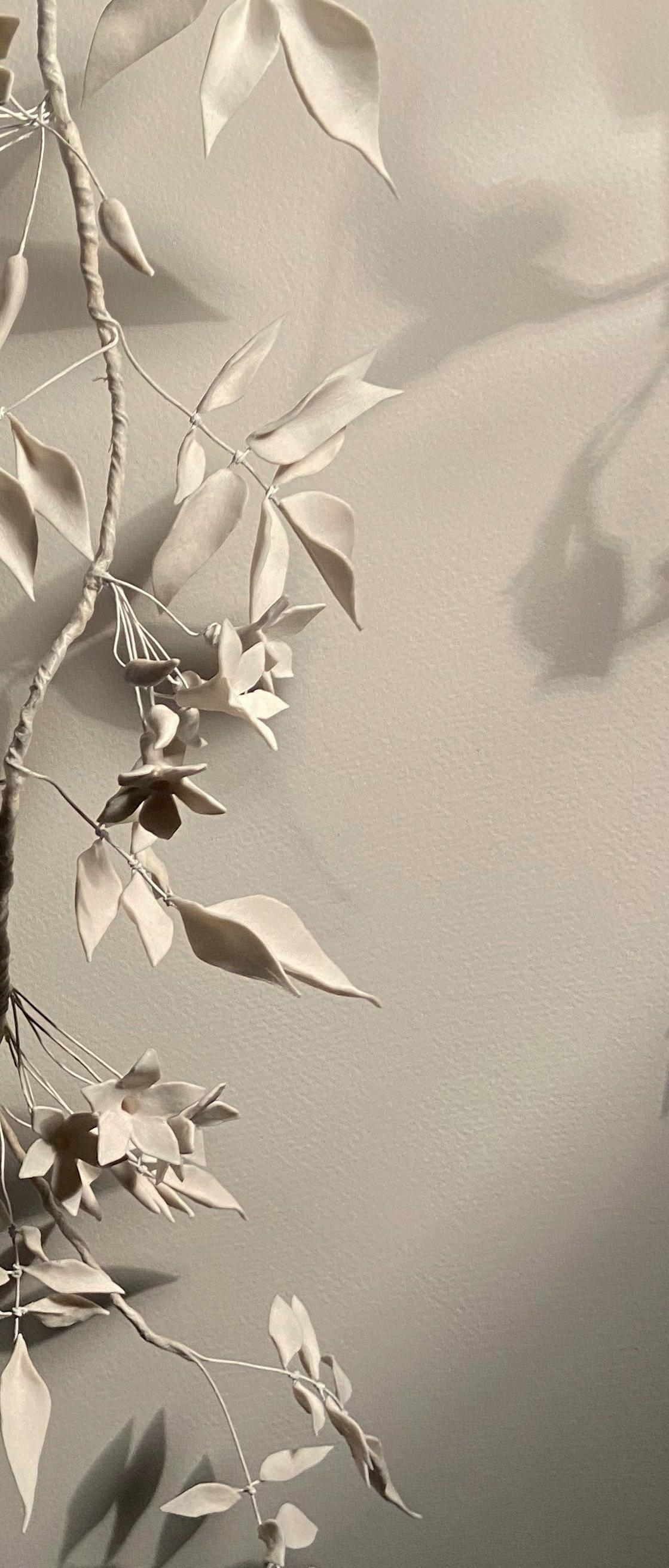
Unurgent Argilla
Nina Salsotto Cassina is an Italian ceramicist. In 2019 she founded Unurgent Argilla, focusing on material research of non-industrial wild materials. Unurgent Argilla is a vocabulary of wild materials, a study of what’s around us, repeated on spherical vessels which she uses as a canvas to convey a spatial narrative. The final vases function as both signposts and autobiographical archival memories.
She is currently focusing her research on foraging high fire clays from Italy and France, mainly in the Alps.
T he forms, inspired by the traditional Korean moonjar, are purposefully simple and sober to allow the properties of the material to speak. Hand-built or thrown at the wheel, the moonjars alter dependent on the clay body, its plasticity, grog and strength, with the goal of maintaining imperfections and abstracting the vessel as little as possible from its original earth.
The clays and rocks are collected in small quantities, by hand, without producing any waste and fired just once, lessening energy consumption.
Lago d’Orta 1
Wild clay from Lago d’Orta
Hand-built. Fired in oxidation at 1220°C
H 29 cm, ø 30 cm
The clay for this vase was foraged from a big deposit of clay south of Lago d’Orta, where different types of clays and kaolin have been mined for centuries.
This clay is mottled, heavily grogged and highly plastic. For this vase, it was left completely unprocessed to retain the natural pattern of the soil as found in nature.
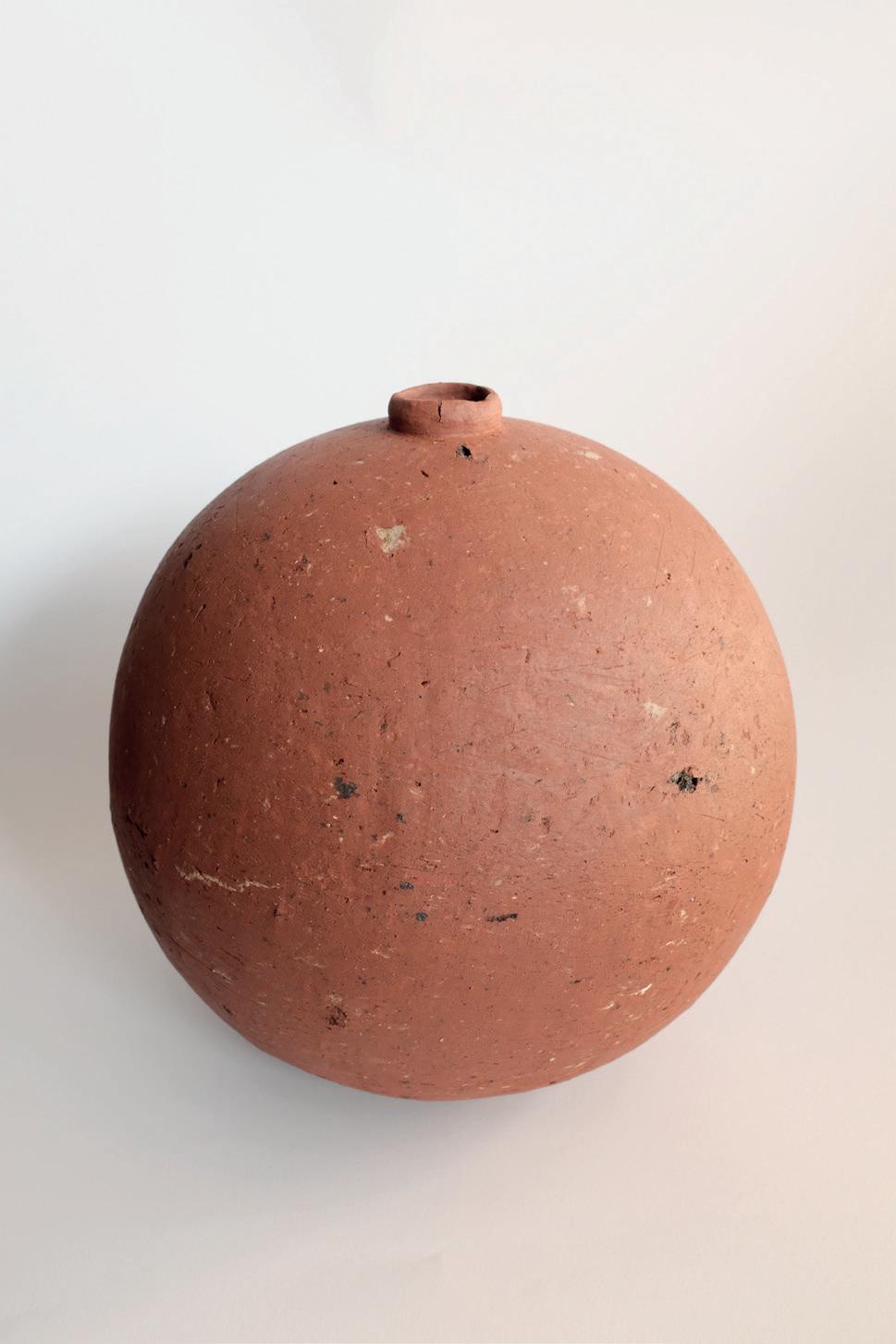
Valence
Wild kaolinitic clay from Valence
Turned at the wheel
Fired in oxidation at 1250°C
H 34 cm, ø 34 cm
The clay for this vase was foraged from a pool of secondary kaolin near Valence, gathered at the base of a large kaolin wall. This clay is found very pure in nature and doesn’t require any processing.
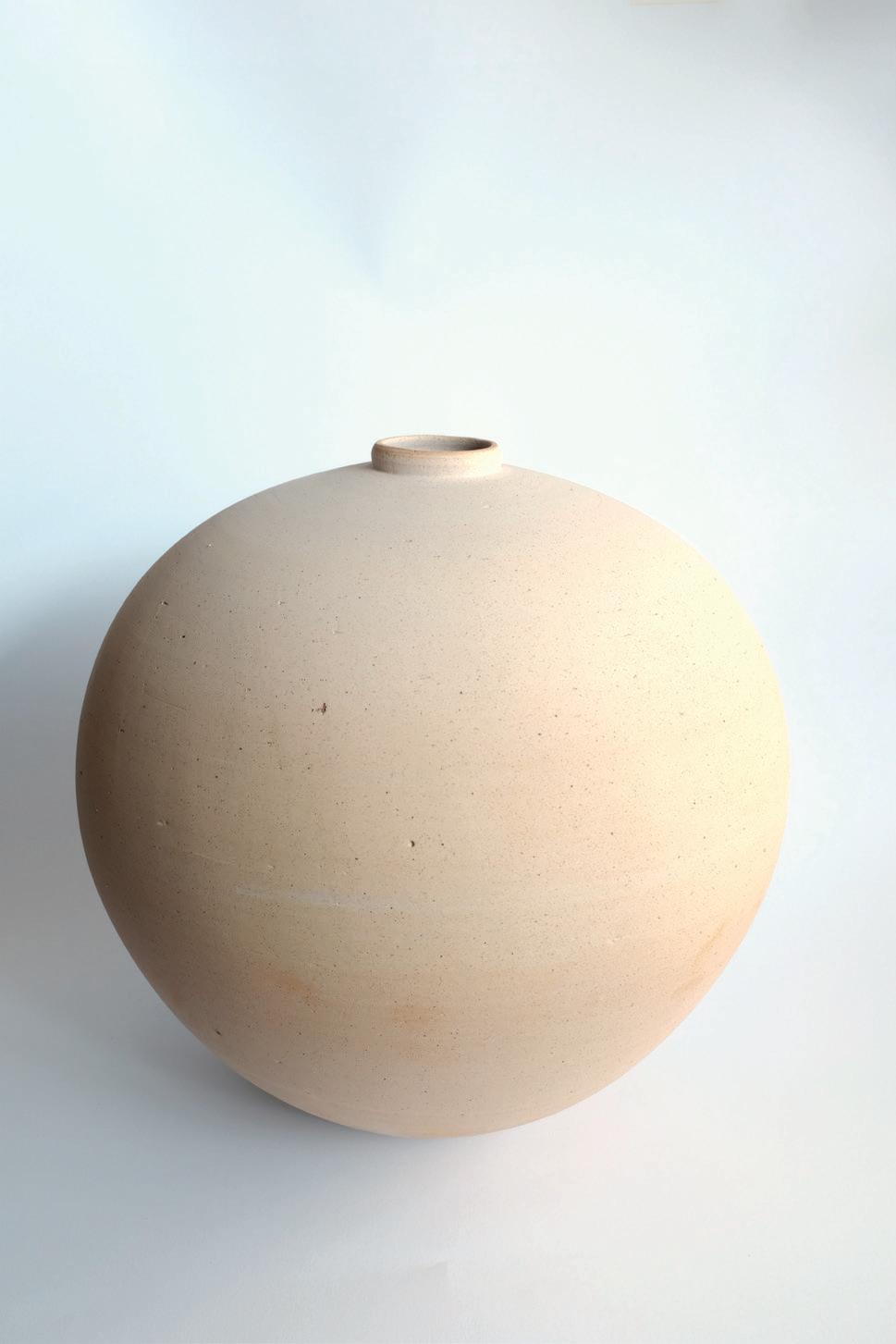
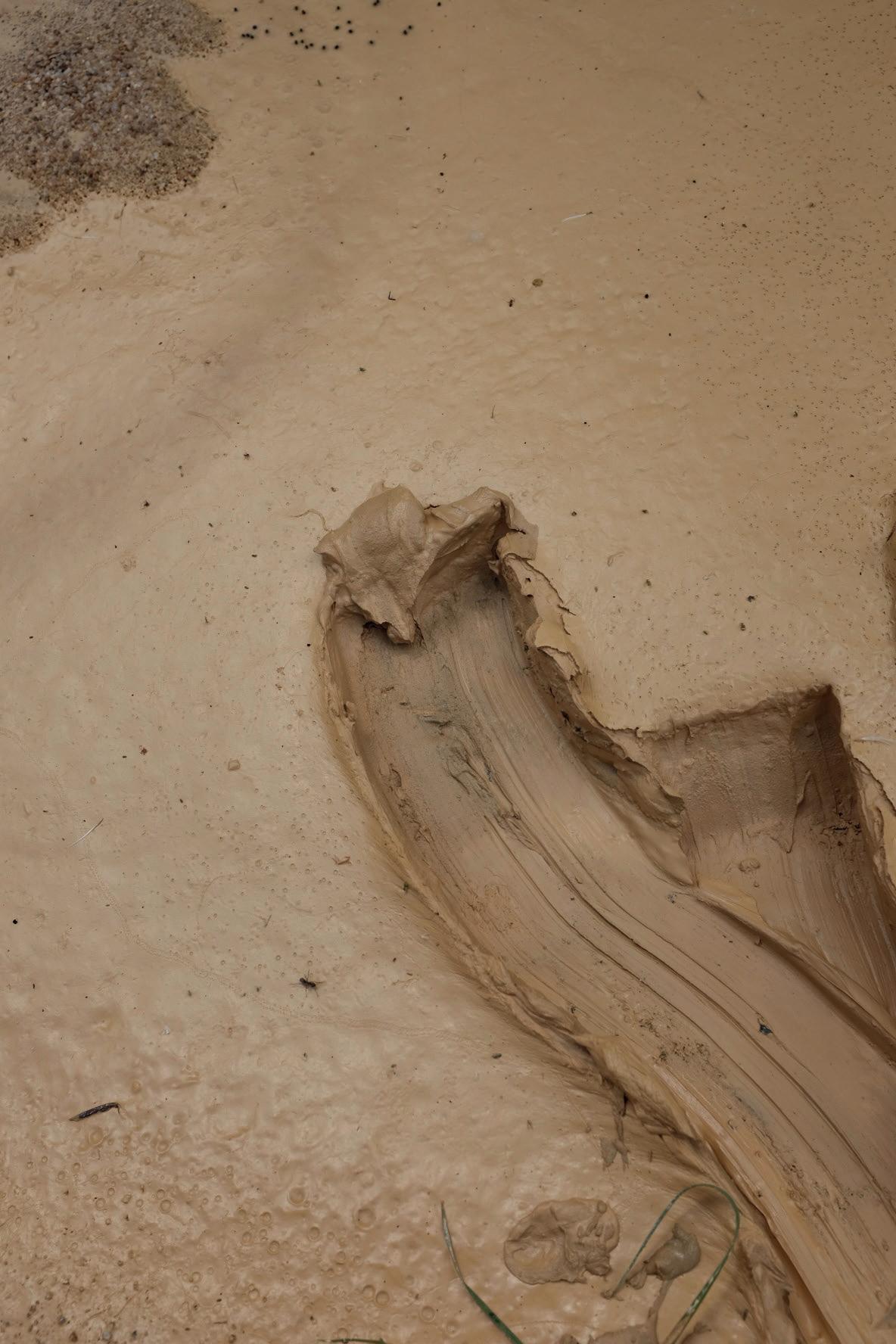
St Amand




Wild clay from St-Amand-en-Puisaye
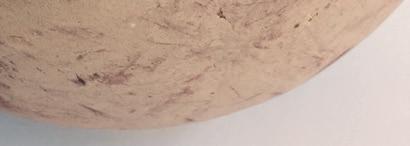
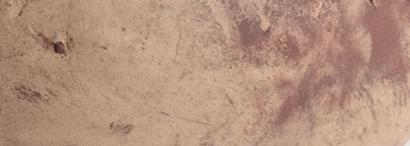
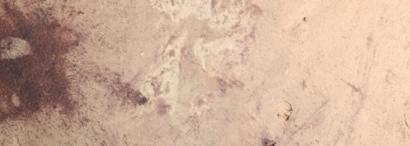
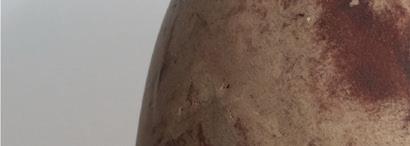
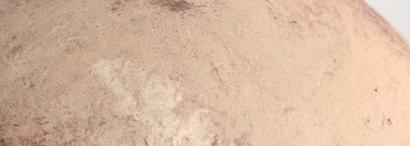
Hand-built. Fired in oxidation at 1250°C
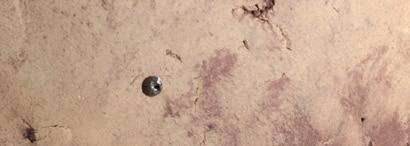
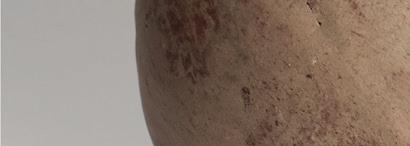
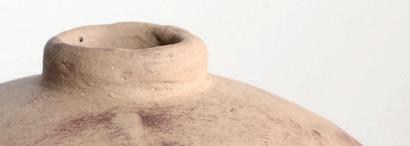
H 23 cm, ø 23 cm



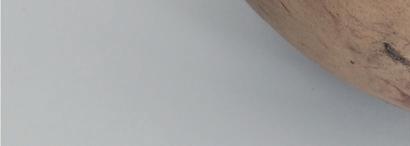
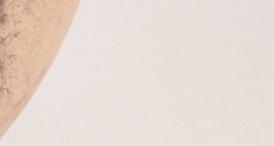
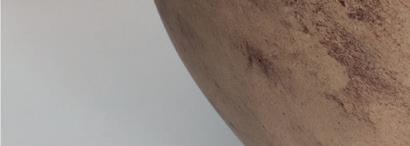
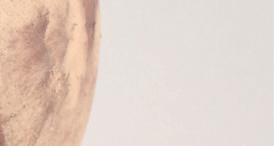
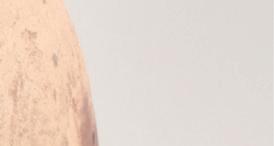

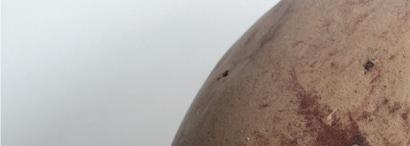








The clay for this vase was foraged from a big clay vein in Puisaye. It was sieved to eliminate the high quantity of sand. The sections of clay stained by oxides were processed separately and later loosely wedged with the lighter body to give back to the clay its natural mottledness.
The Puisaye region in France has a secular pottery tradition dating back to the Middle Ages, also thanks to the vast high fire clay deposits it sits upon.
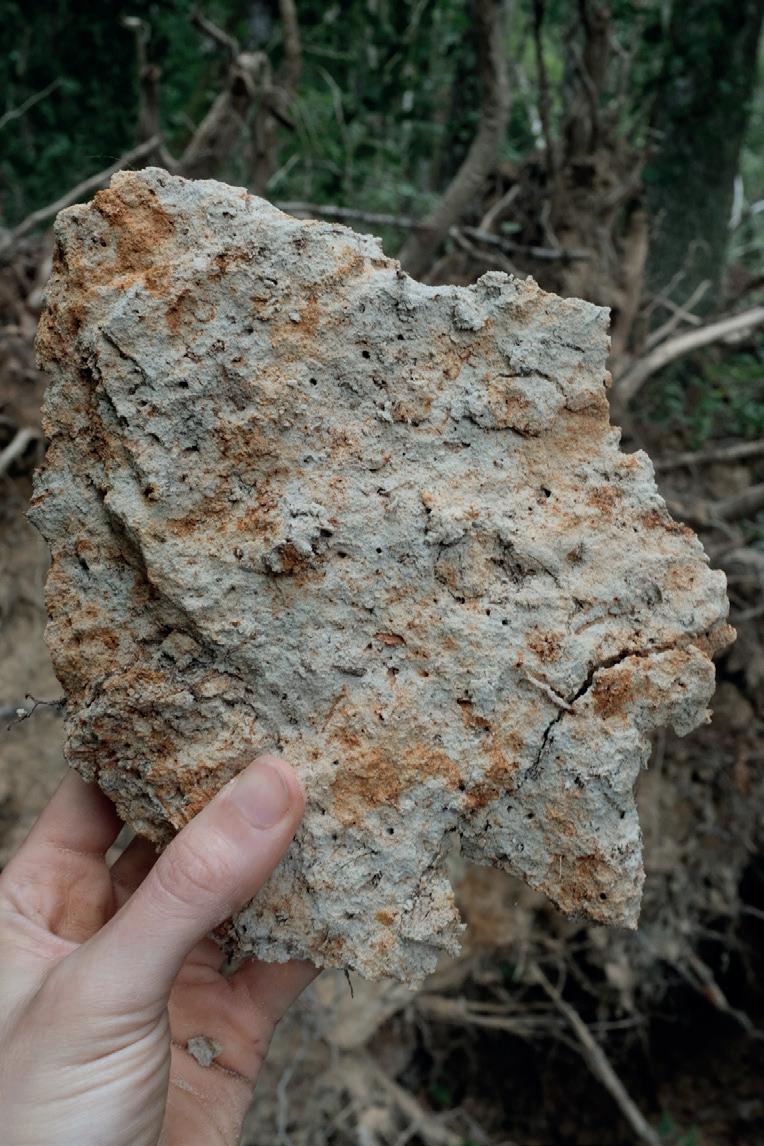
Grenoble
Wild kaolinitic clay from near Grenoble, wood ash
Turned at the wheel. Fired in oxidation at 1250°C
H 25 cm, ø 25 cm
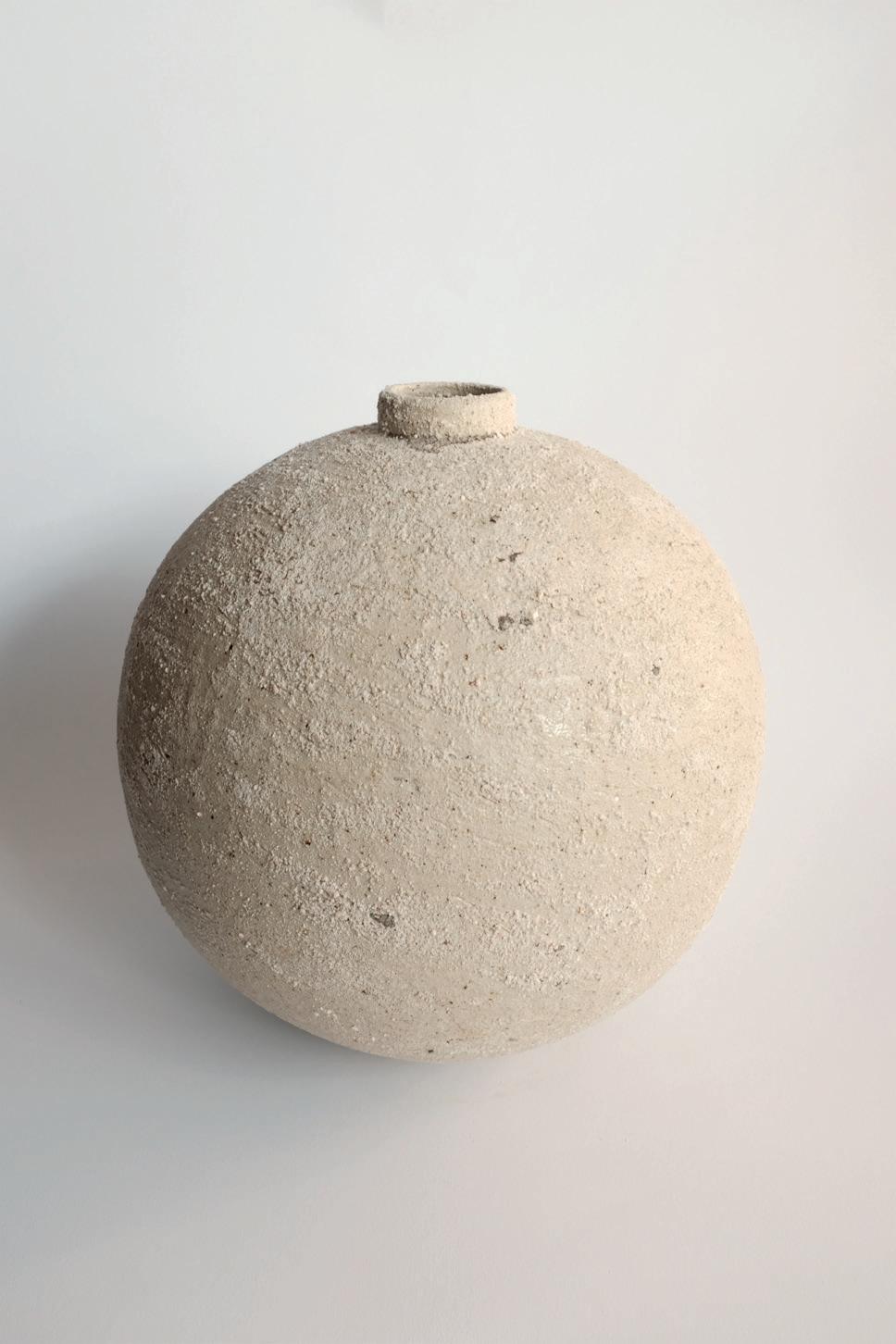
The clay for this vase was foraged from a pool of secondary kaolin near Grenoble, gathered at the base of a large kaolin wall.
The body was finely processed, corrected with around 3% bentonite for better plasticity, and thrown, to be later covered by the same wild clay, but unprocessed and coarser.
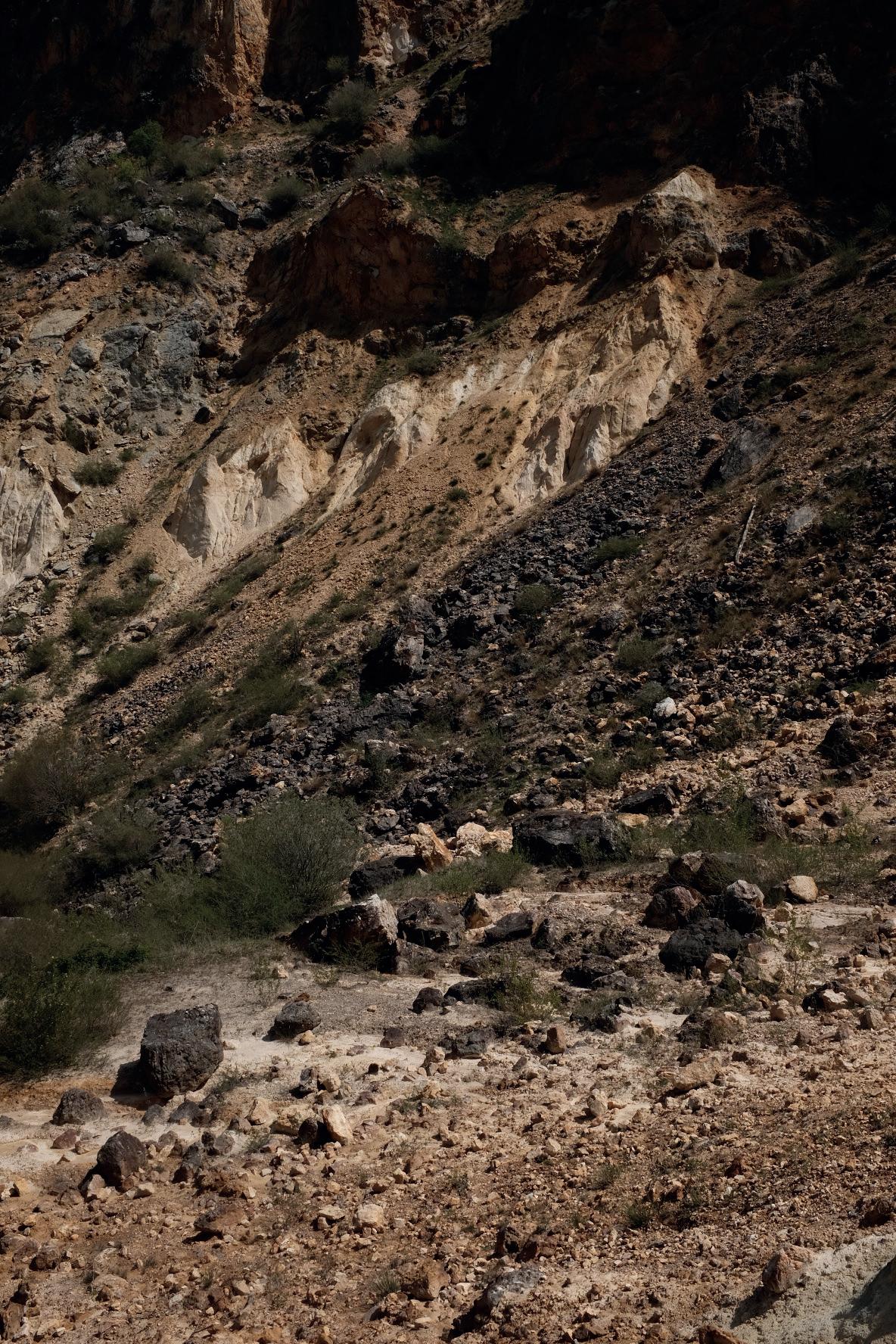
Treigny
Wild clay from Treigny
Thrown at the wheel. Fired in oxidation at 1250°C
H 27 cm, ø 26 cm

The clay for this vase was foraged from a big clay vein next to a road in Treigny, Puisaye. It was sieved to separate the sand, which was then reintroduced in smaller quantities. It was thrown at the wheel and later pierced with ochre and sandstone pebbles removed from the initial clay. Raw glazed with wood ashes, it was fired in an electric kiln.
The Puisaye region in France has a secular pottery tradition dating back to the Middle Ages, also thanks to the vast high fire clay deposits it sits upon.
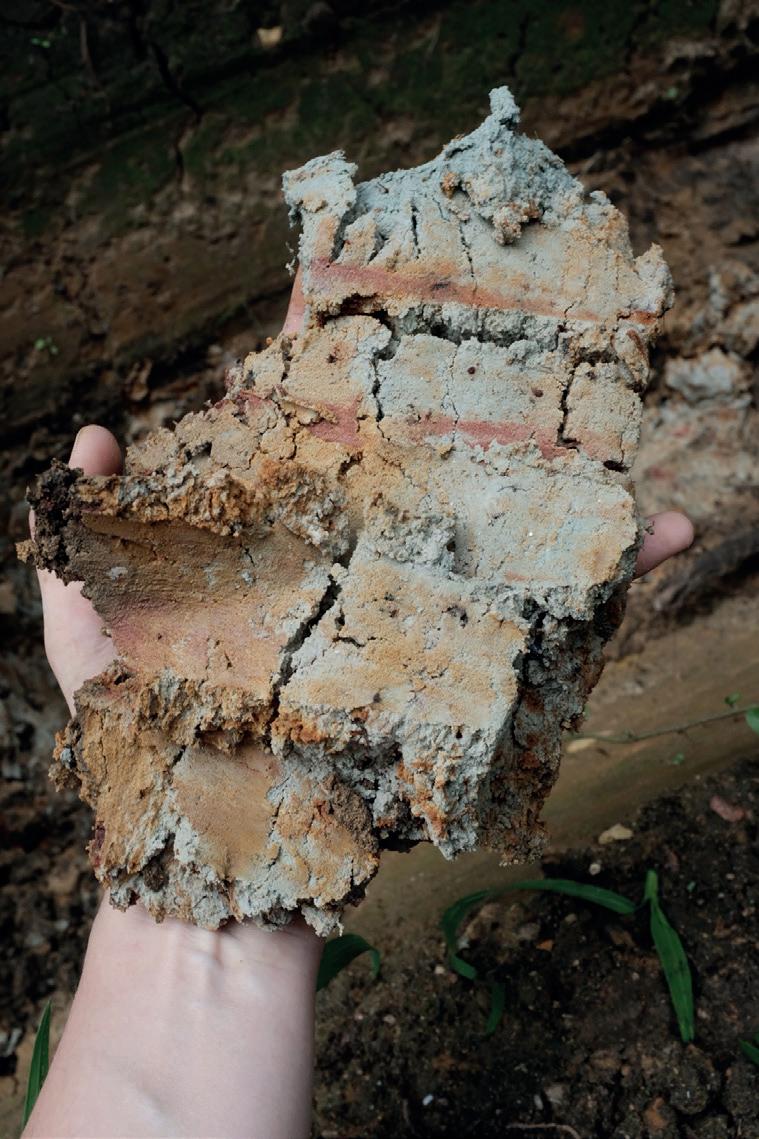
Lago d’Orta 2
Wild clay from Lago d’Orta
Thrown at the wheel
Fired in oxidation at 1220°C
H 25 cm, ø 26 cm
The clay for this vase was foraged from a big deposit of clay south of Lago d’Orta, where different types of clays and kaolin have been mined for centuries.
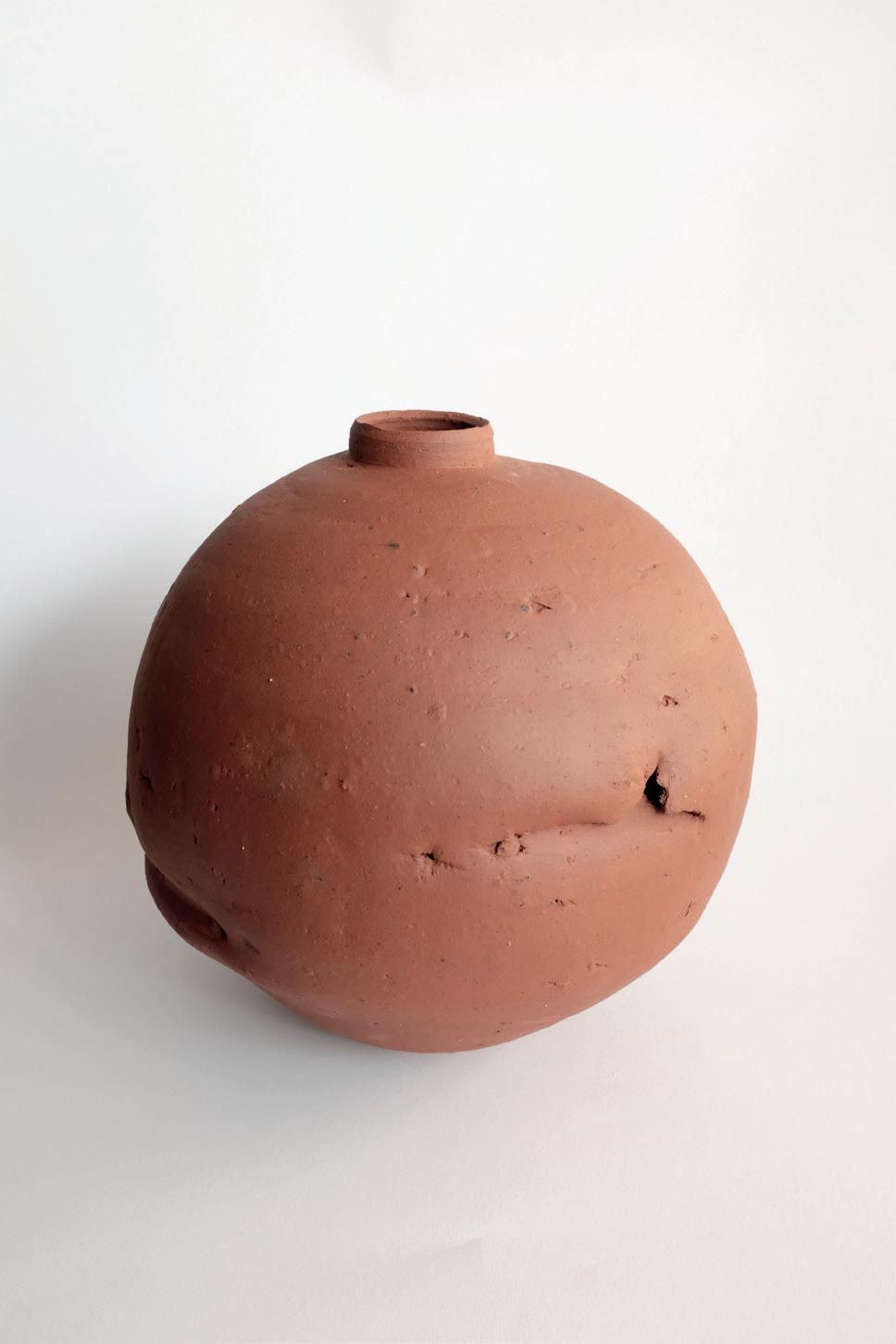
This clay is mottled, heavily grogged and highly plastic. For this vase, it was left completely unprocessed to retain also the biggest particles of grog and let them rip, dent and write on the surface of the vessel at the wheel.
In the peak of imperfection it becomes more visible both the gesture of throwing but also the character of each clay.
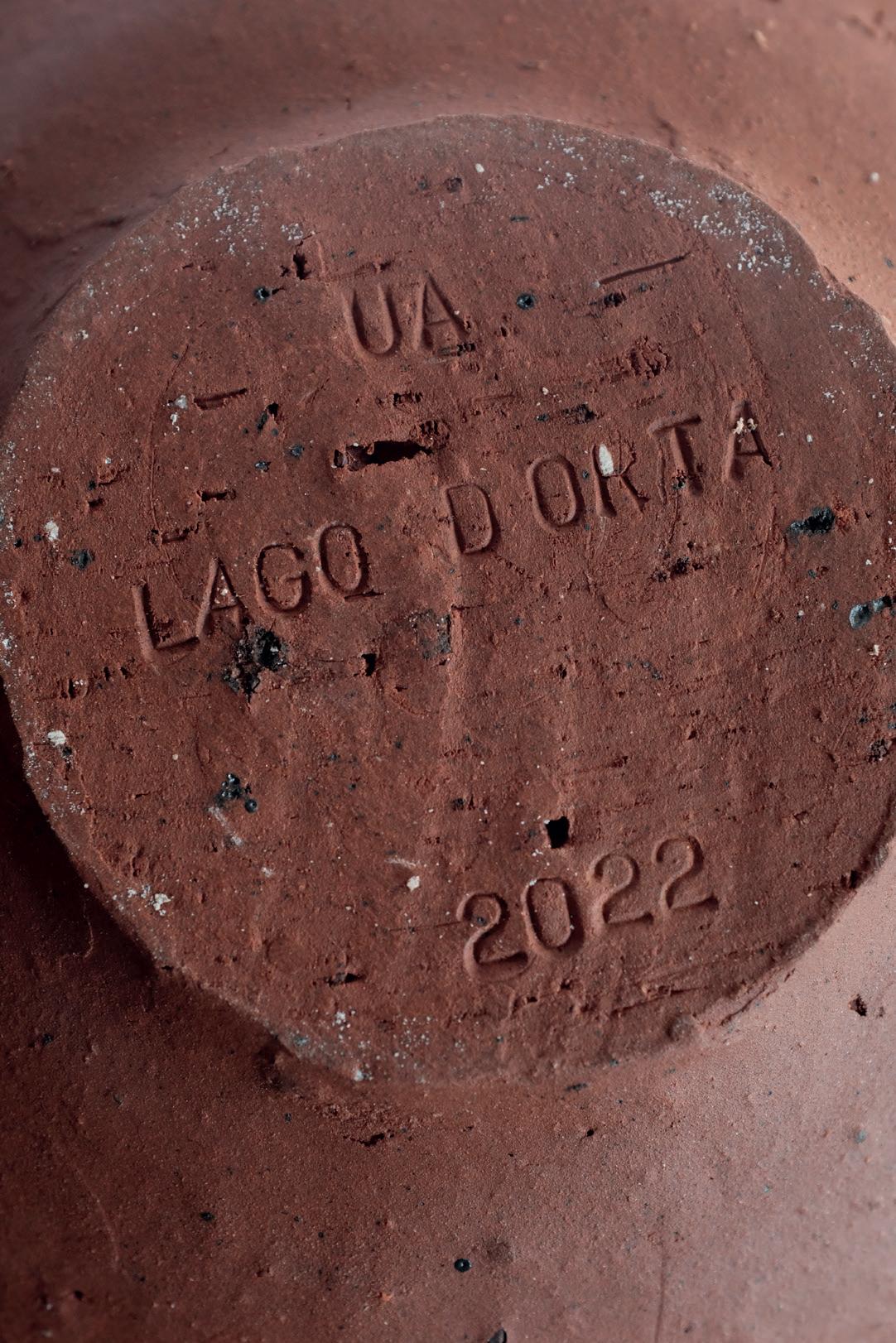
Tim Copsey
The Peak District Pennine landscape and its seasons are the backdrop to everything Tim Copsey makes: this is pottery on the border between function and sculpture; in essence vases, bowls, bottles and cups, although these are really just ‘Serving Suggestions’.
Works such as the Waterfall pieces are directly inspired by observing and depicting how water races over and around rocks, glistening and reflective, as direct a reference to pouring as the onomatopoeic ‘tok tok’ of the tokkuri form.
Tim finds deep inspiration in Japanese forms and techniques, early experiments in camouflage such as dazzle, prehistoric ceramic forms and Situationist art.
In addition to being a potter, he works with artists and creative organisations as a film maker. This affords him the opportunity to investigate how ceramics and film overlap. “I’m interested in the performative nature of how film can incorporate its subject”, this has resulted in a series of short films called ‘Serving Suggestions’.
Surfaces are built up over multiple firings, often starting in the wood kiln and ending with lustres. His work has been described as ‘beautifully ugly’ or like ‘space debris’ - he hopes that the work is playful, elemental if occasionally jarring or surprising and ultimately resonant of their materiality and the landscape from which they derive.
Detail of Snow (Blossom Vase)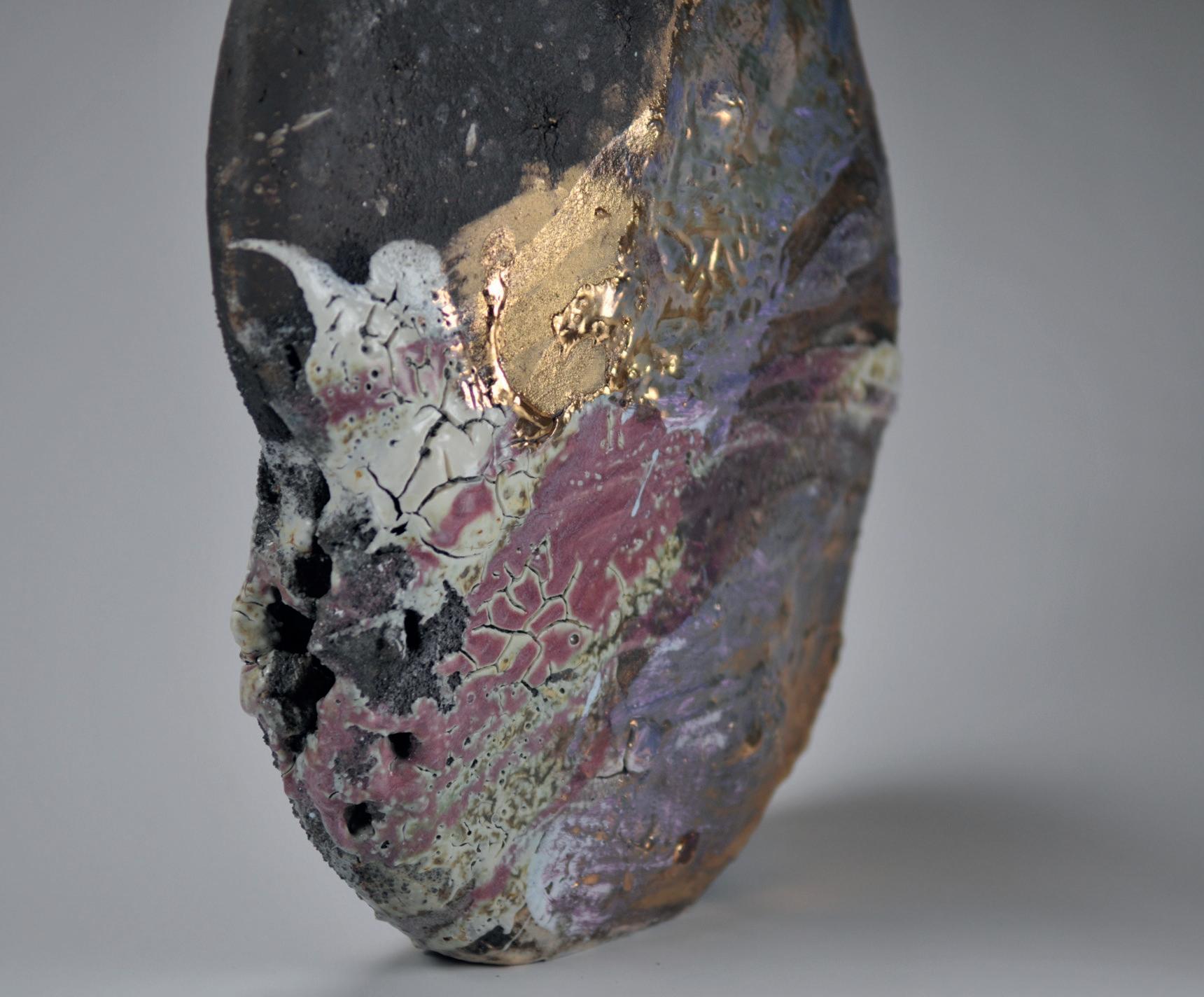
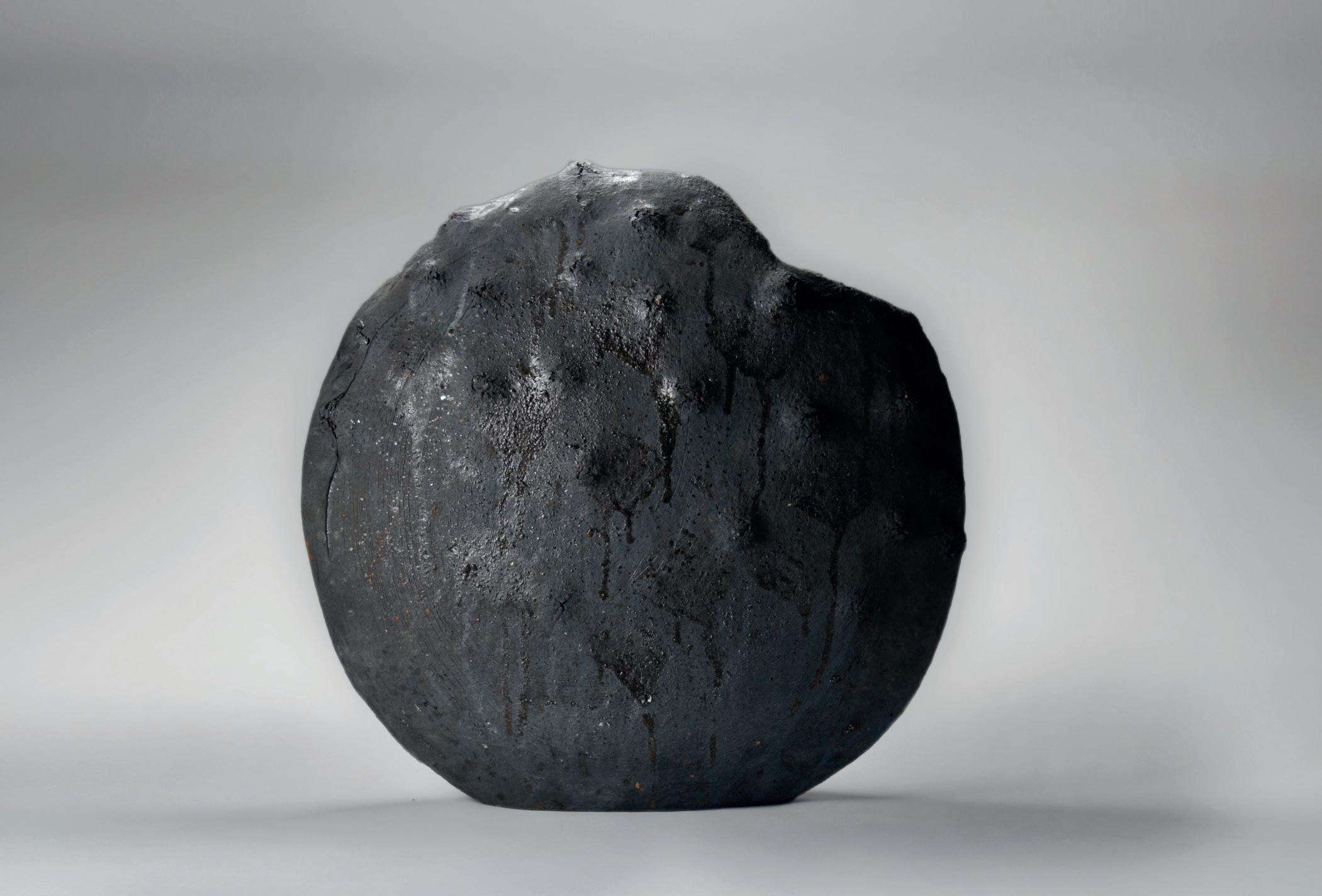
Billionaires Will Steal Our Moon
Stoneware (wood fired), black clay, black and white porcelain surface with Bleaklow grit
H 43 cm, w 43 cm, d 11 cm
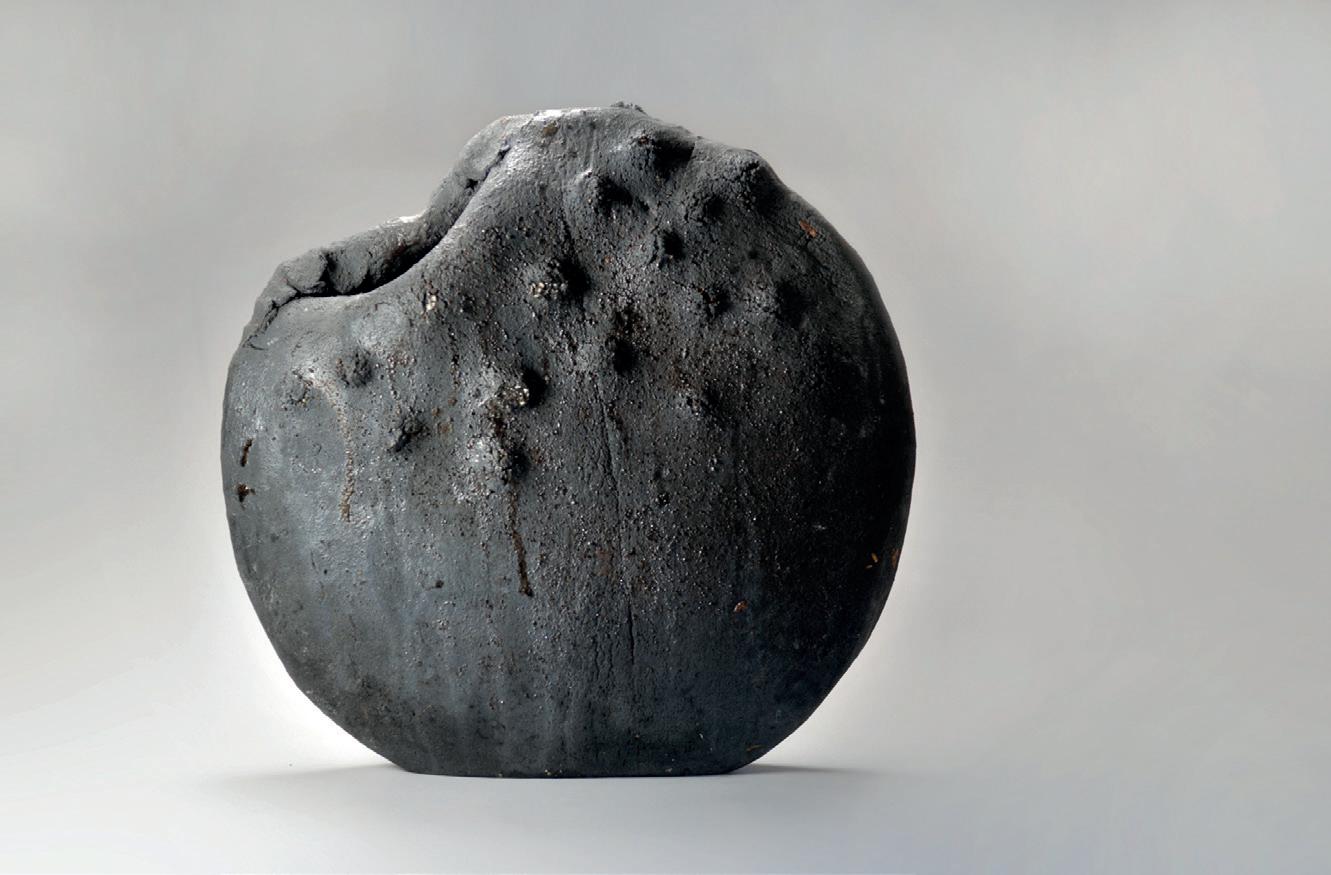
Smashing a Jewellers Window (Bloomsbury)
Stoneware (wood fired), wood ash and oribe glaze
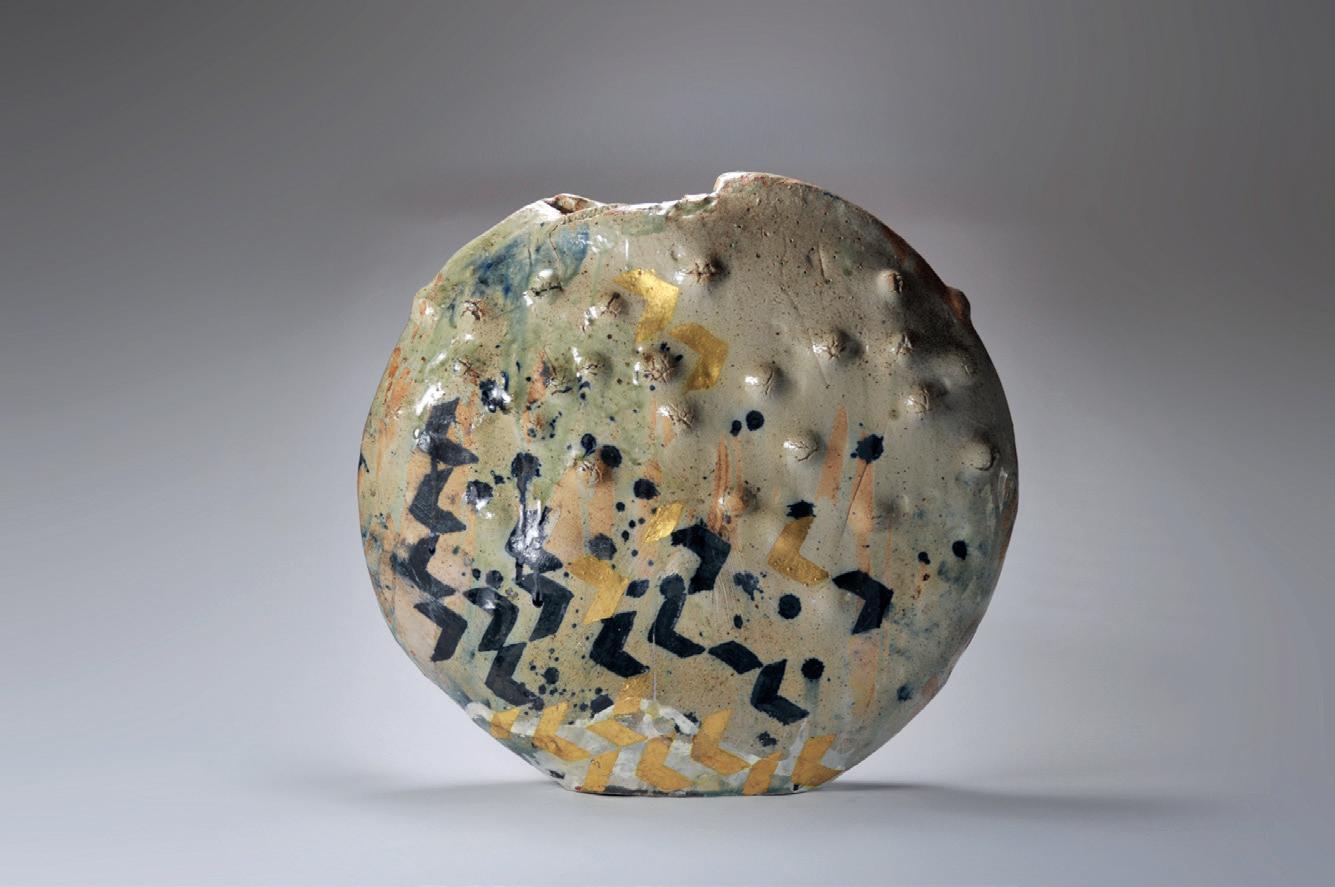
with cobalt and gold details
H 45 cm, w 45 cm, d 11 cm
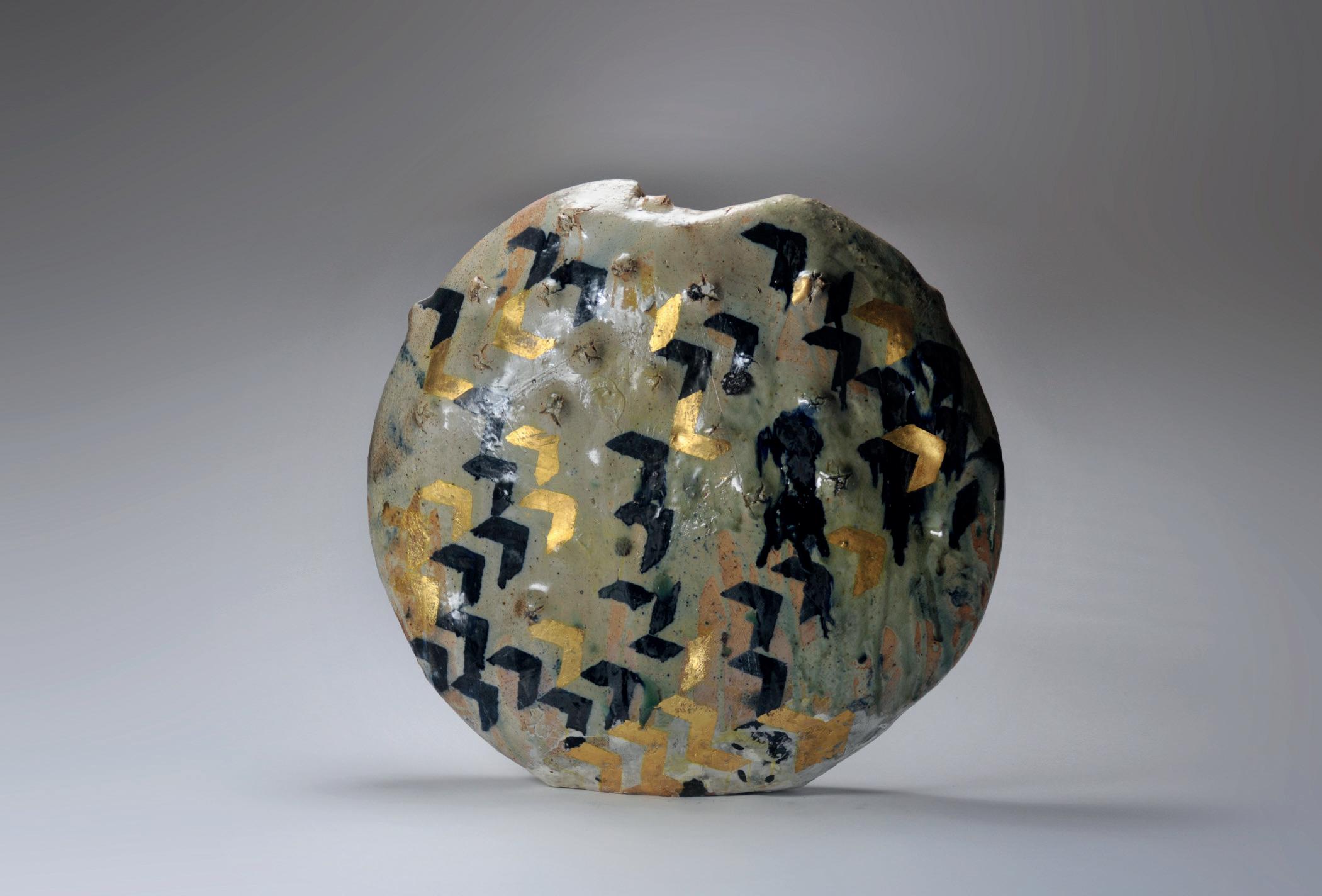
Cherry Blossom (Blossom Vase)
Earthenware (electric fired), hand painted cobalt detail with tinted
tin glazes and gold lustre
H 36 cm, w 29 cm, d 9 cm
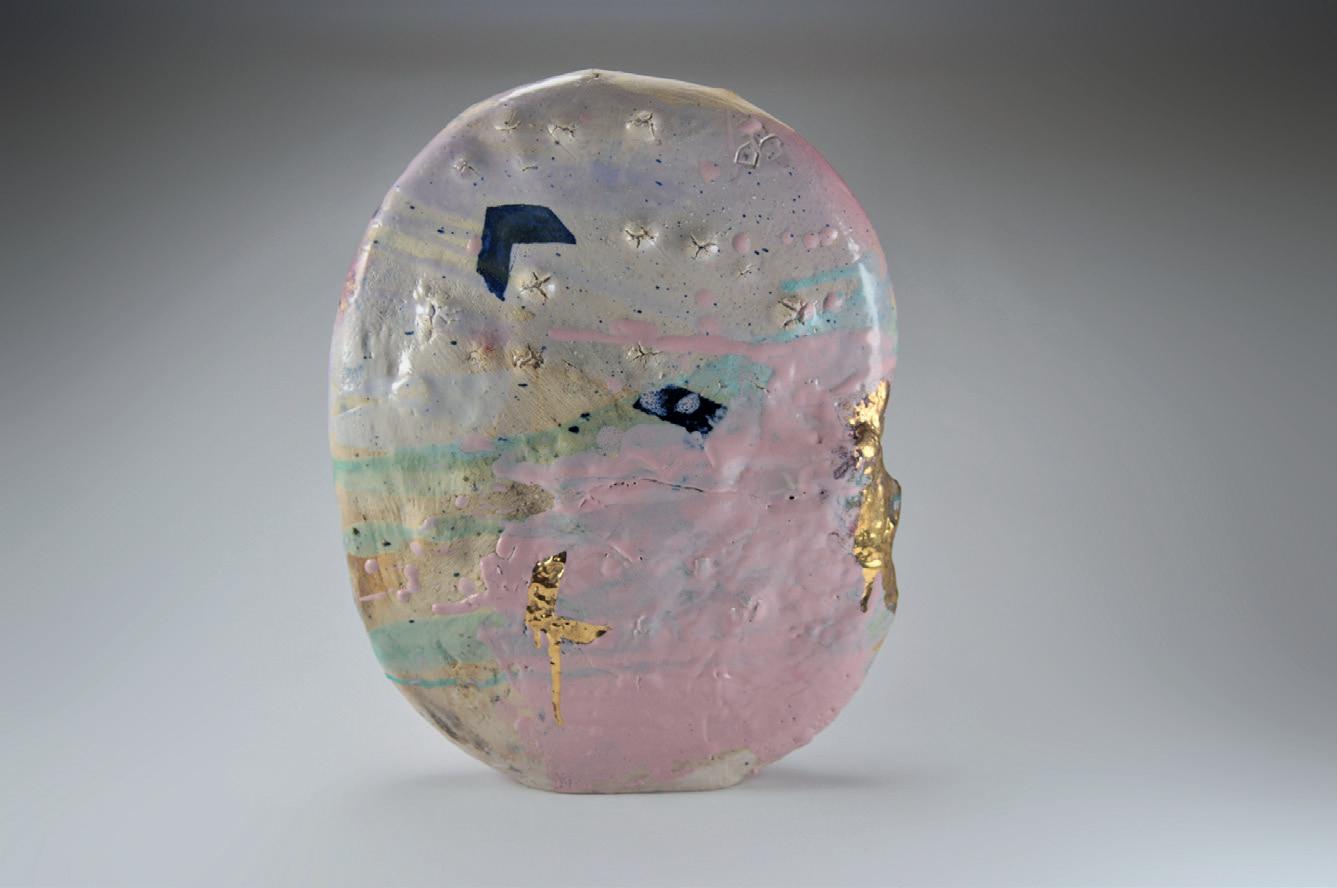
Snow (Blossom Vase)
Stoneware black clay (electric fired), shino, ash and oribe glazes
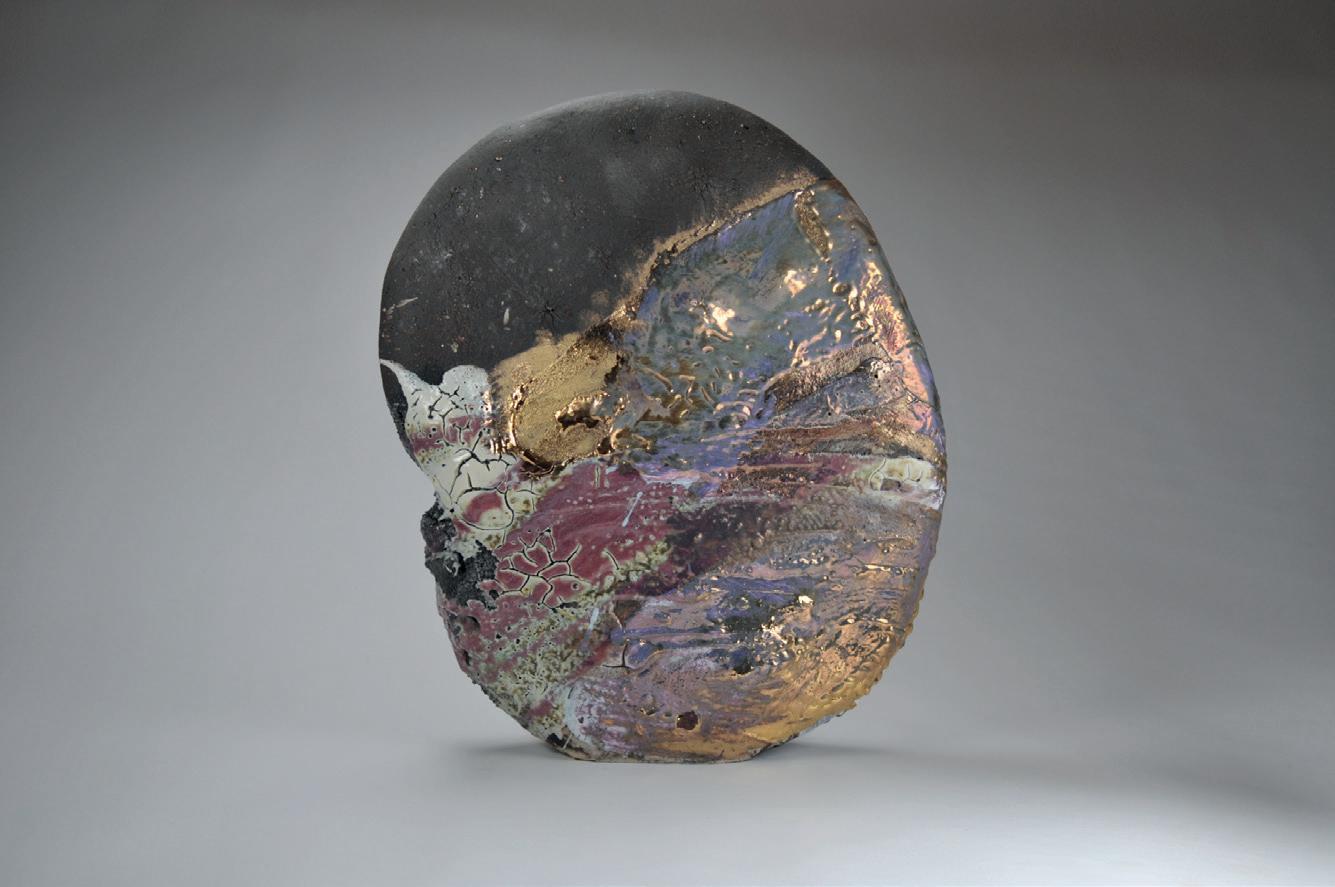
with silver and gold lustres
H 32 cm, w 29 cm, d 9 cm
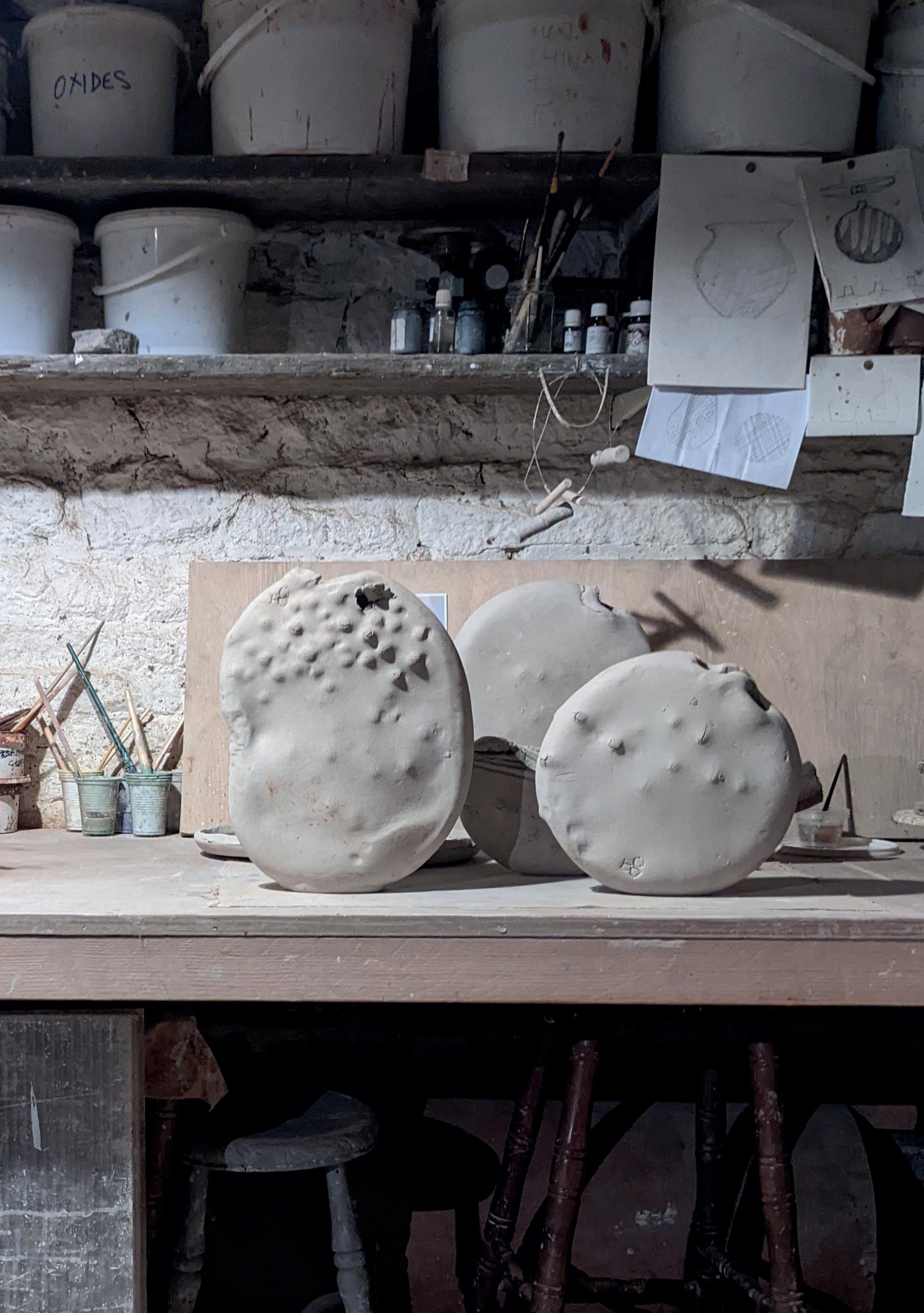
Issues Edge Vase
Stoneware black clay, black porcelain dust and bleaklow grit,
tenmoku glaze and silver lustre
H 27 cm, w 36 cm, d 9 cm
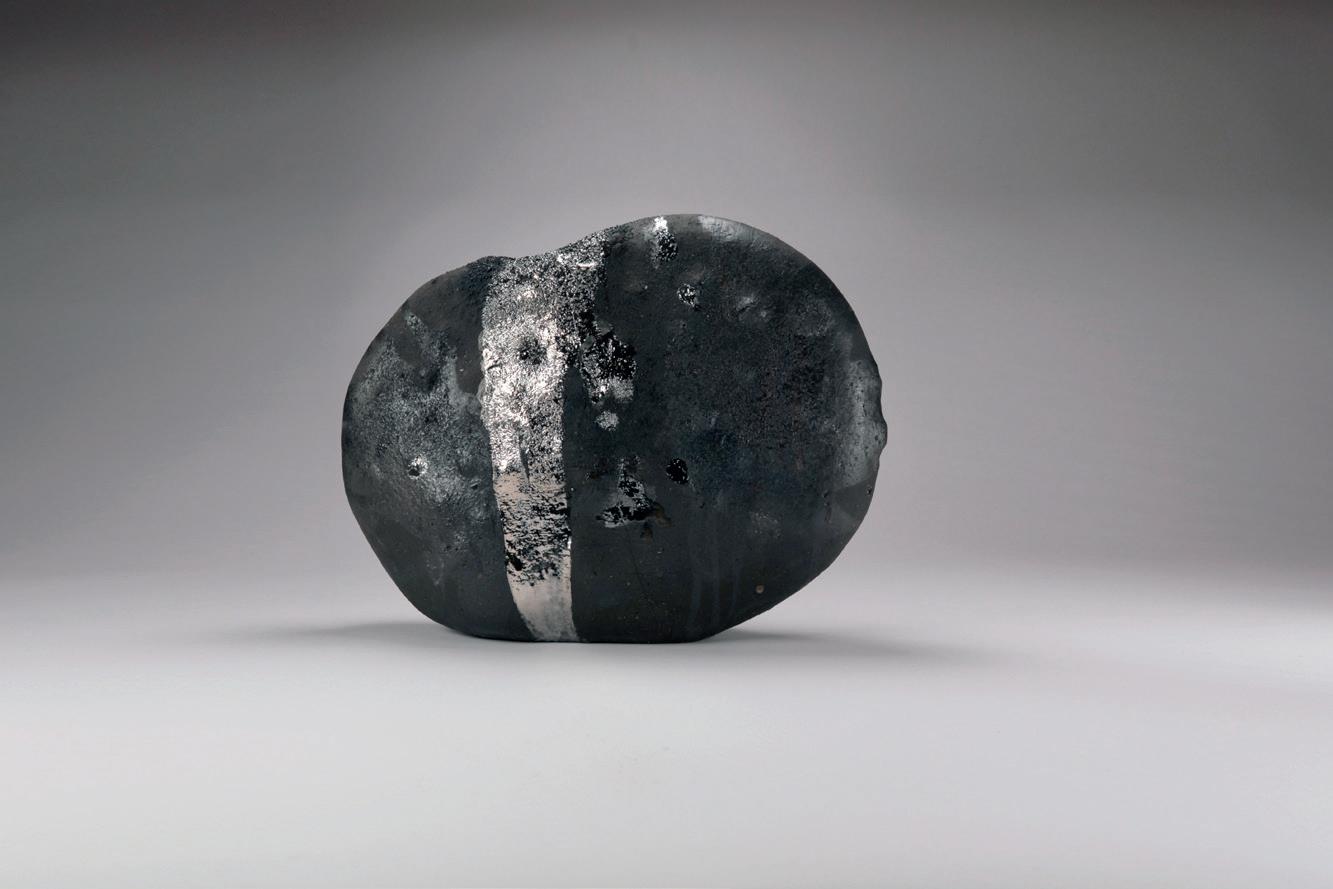
Issues Edge - Waterfall Tokkuri
Earthenware, ‘glitter’ and tin glaze with stone and porcelain inclusions and gold lustre
H 17 cm, w 16 cm
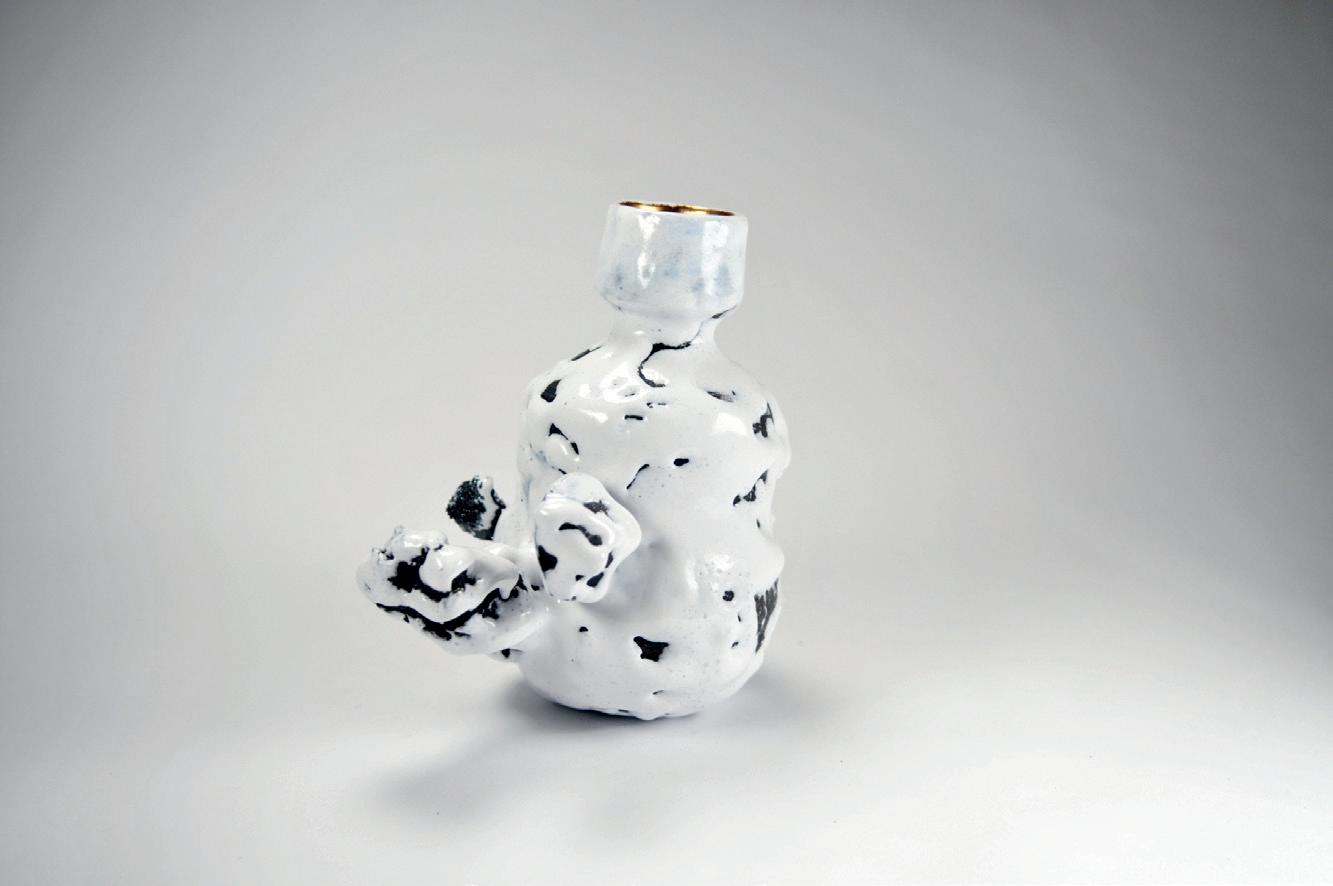
Waterfall Tokkuri
Earthenware, ‘glitter’, pink, copper and cobalt
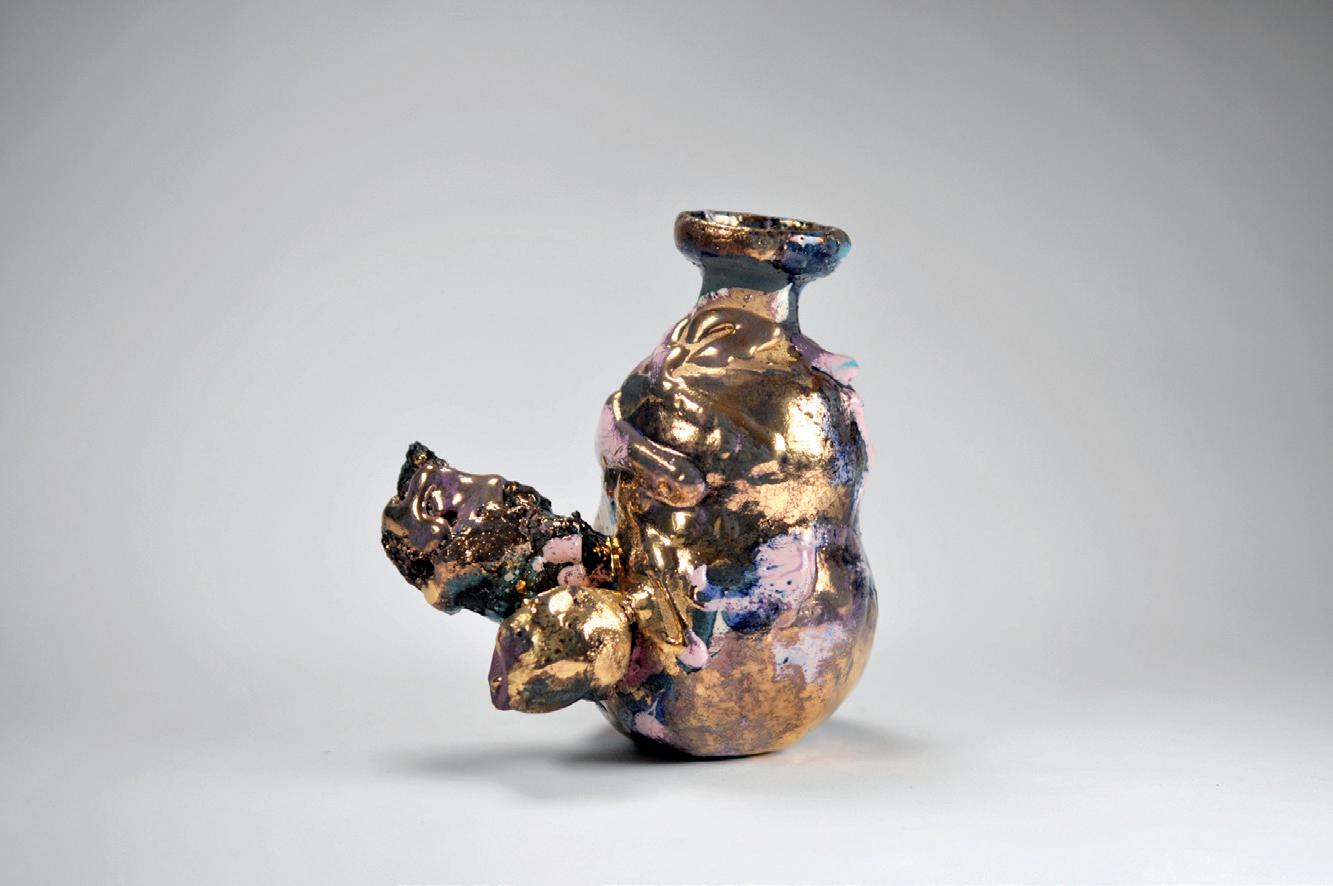
with stone and porcelain inclusions and gold lustre
H 16 cm, w 14 cm
Waterfall Tokkuri
Earthenware, ‘glitter’, pink, copper and cobalt
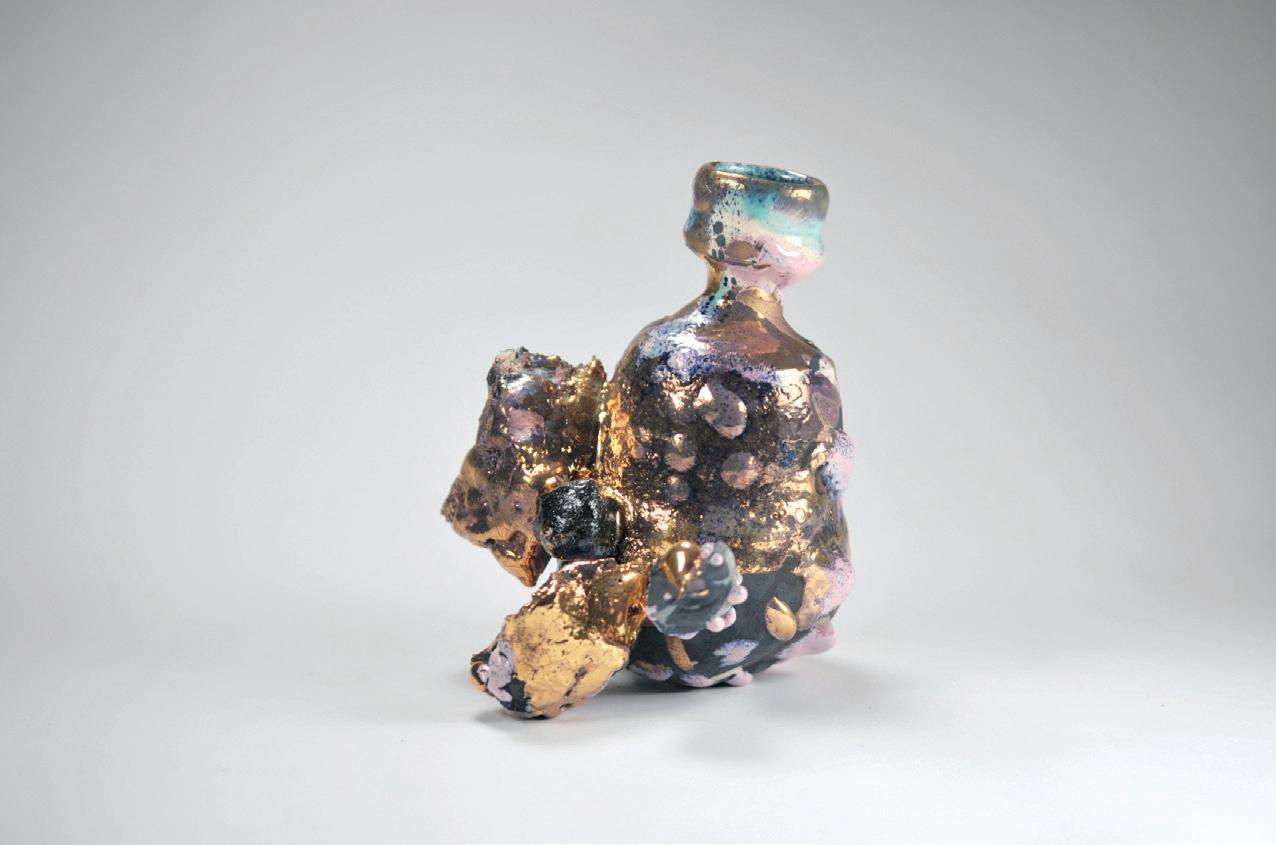
with stone and porcelain inclusions and gold lustre
H. 15 cm, w. 13 cm
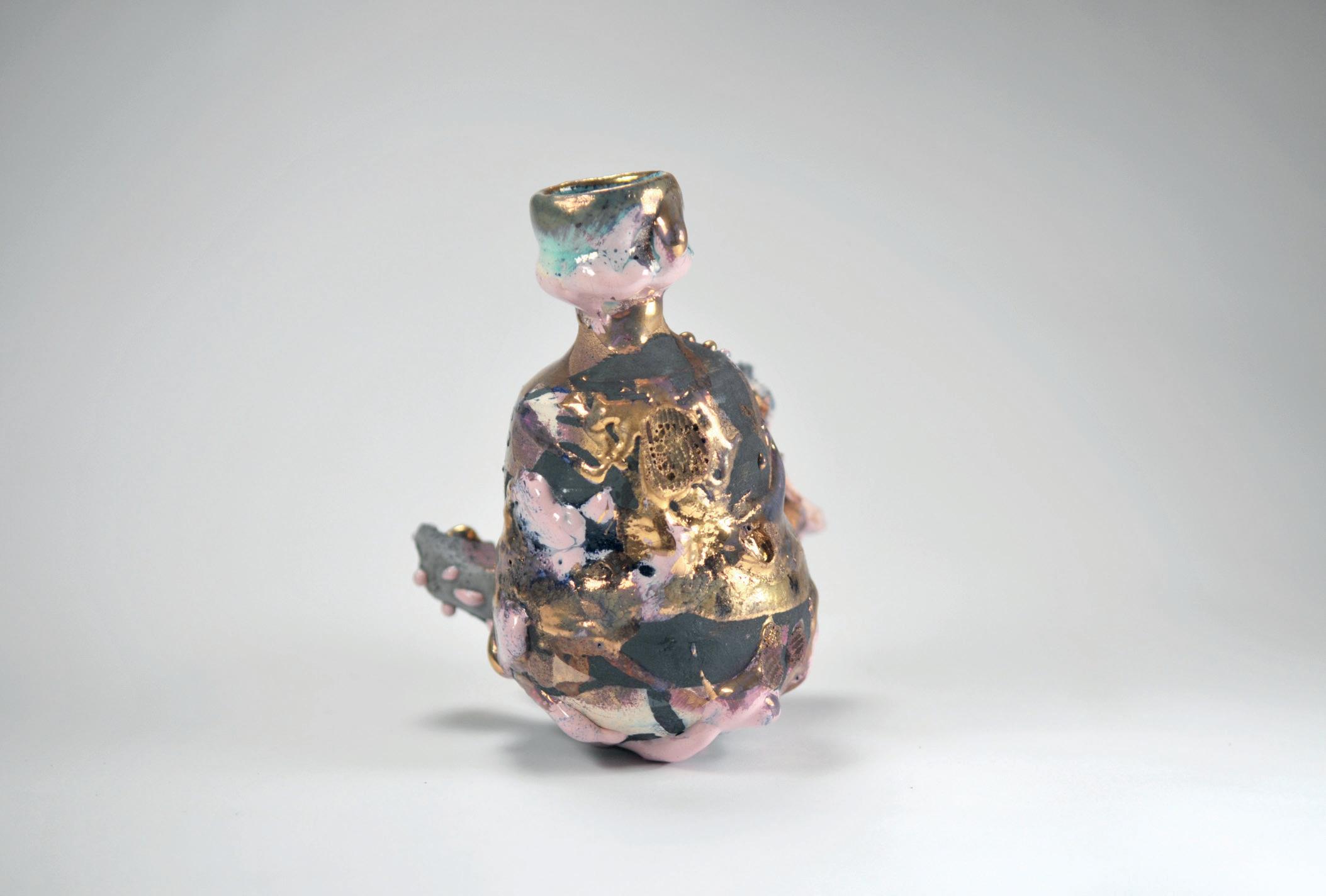 Michael Rice
Michael Rice
‘In my work I’m attempting to create sculptures, surfaces and textures that are difficult to date to a specific culture or place: my aim is that the aesthetic of the completed object is visually striking but also has a familiarity because of the form and the post-firing techniques that make the most out of the least materials.’
‘The finishes are straightforward yet complex and this creates a dialectic that I feel transcends simple visual meaning, moving into iconic or ceremonial territory. This complemented with the shape of the pieces creates a synthesis that gives them an archetypal presence.’
Michael Rice is an Irish artist, designer, maker and educator who specialises in ceramics; his work is concerned with surface, texture, natural geometry, gestalt principles and archetypal forms.
Michael has a Degree in Fine Craft Design, a Postgraduate Certificate in Education (Art and Design), and a Master’s Degree in Multi-Disciplinary Design, all from the University of Ulster, Belfast. His work is exhibited internationally.
Michael is a member of the International Academy of Ceramics based in Geneva and the IAC UNESCO representative for the UAE.
In 2016 Michael exhibited as a finalist in the Taiwan Ceramic Biennale at the Yingge Ceramics Museum in Taipei where his work was acquired for the museum’s permenant collection.
He was the runner-up in the Van Cleef & Arpels Middle East Emergent Designer Prize. In 2019 he was a finalist in the Korean Ceramic Biennale and in 2020 was again been selected as a finalist for the Taiwan Ceramic Biennale. In 2021 he exhibited in the Ceramic Expressions exhibition as part of Singapore Art Week and was also a finalist in the KOGEI Award in Toyama, Japan.
Michael is the Chair of the Visual Communication Department and an Associate Professor of Studio Art in the American University in Dubai.
Detail of Blue Fragment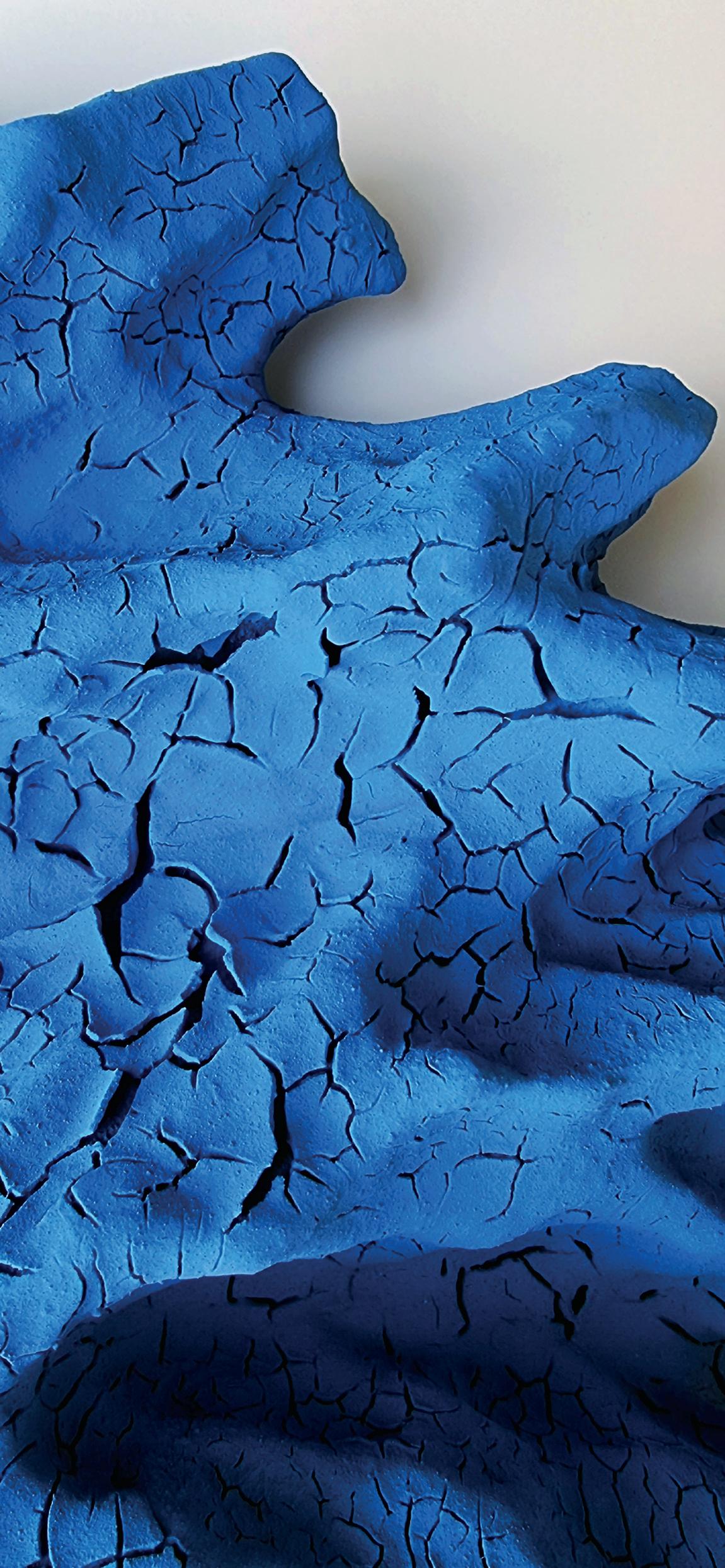
Blue Fragment
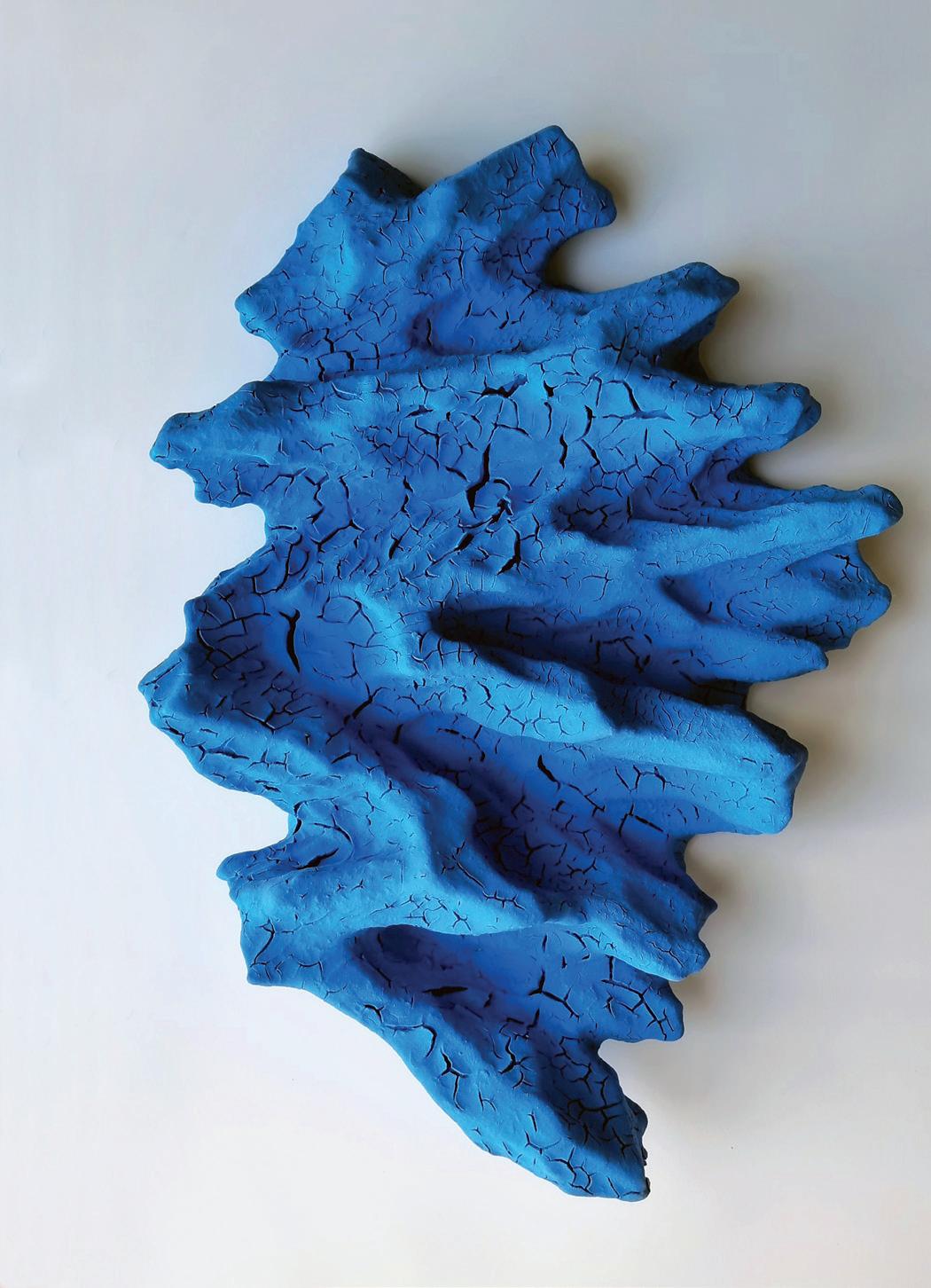
Stoneware, wall hung with french cleat on back
H 68 cm, w 46 cm, d 13 cm
Red Fragment
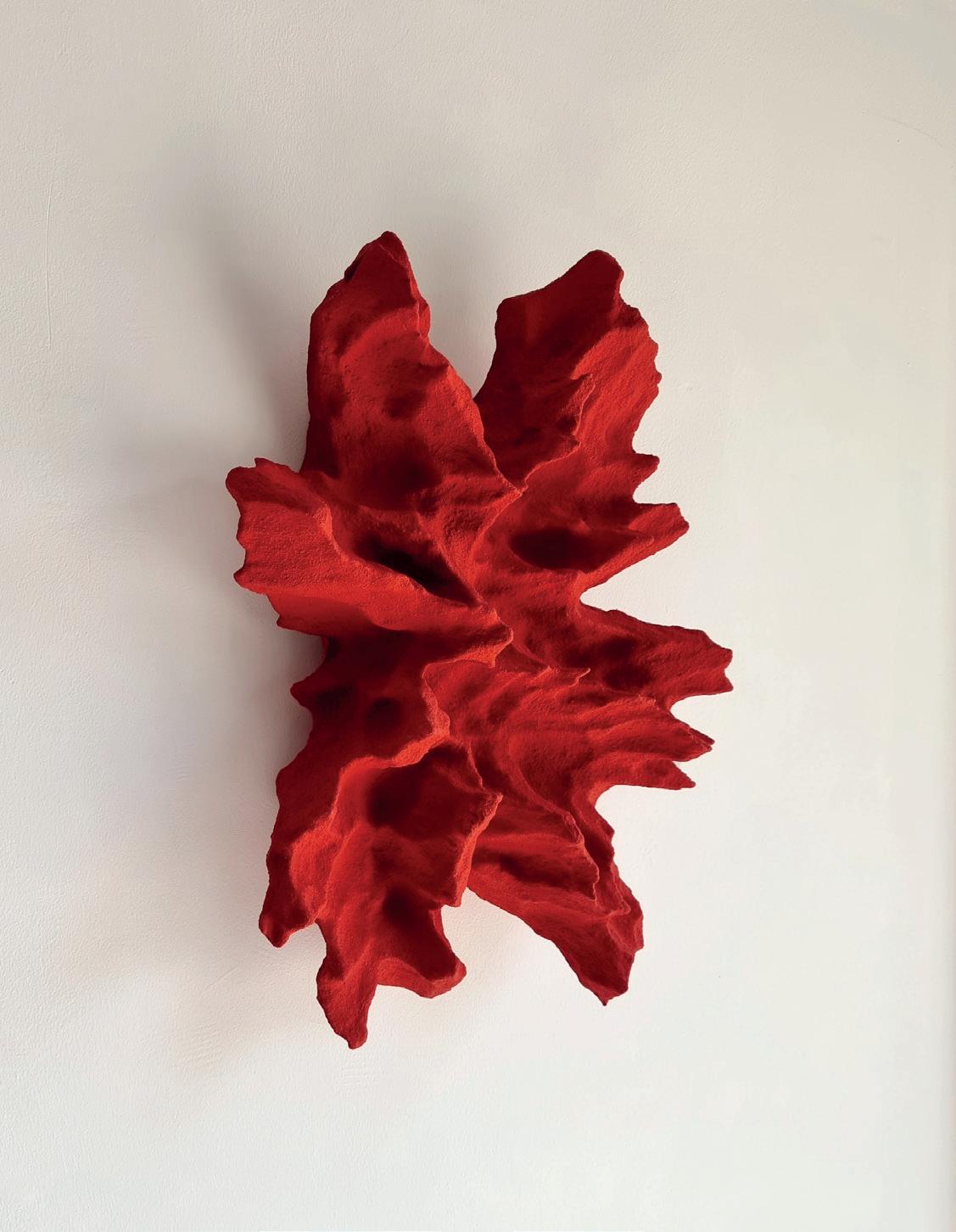
Stoneware, wall hung with french cleat on back
H 62 cm, w 40 cm, d 18 cm
Black Luster Fragment Vessel
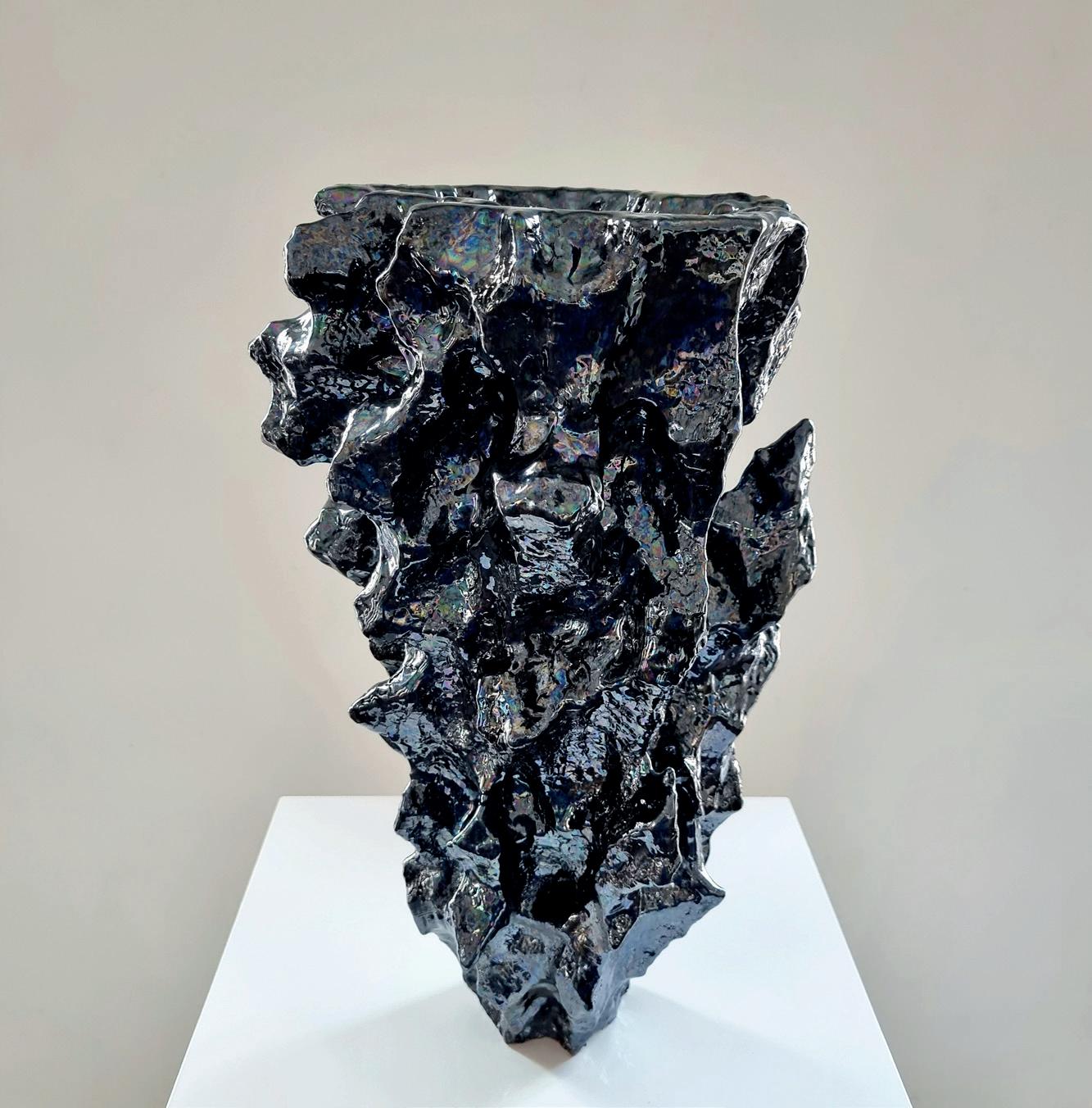
Stoneware
H 58 cm, w 35 cm, d 34 cm
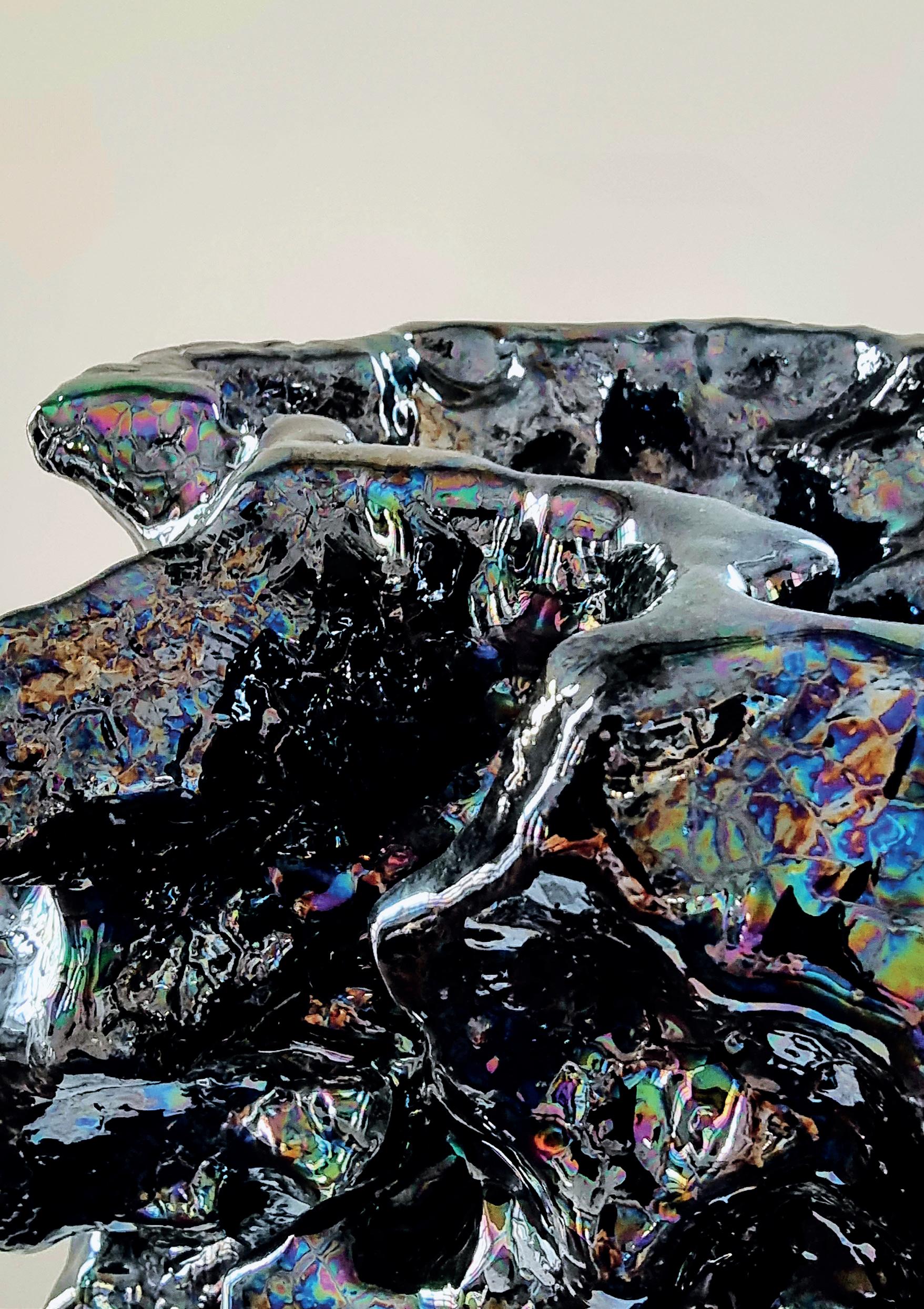
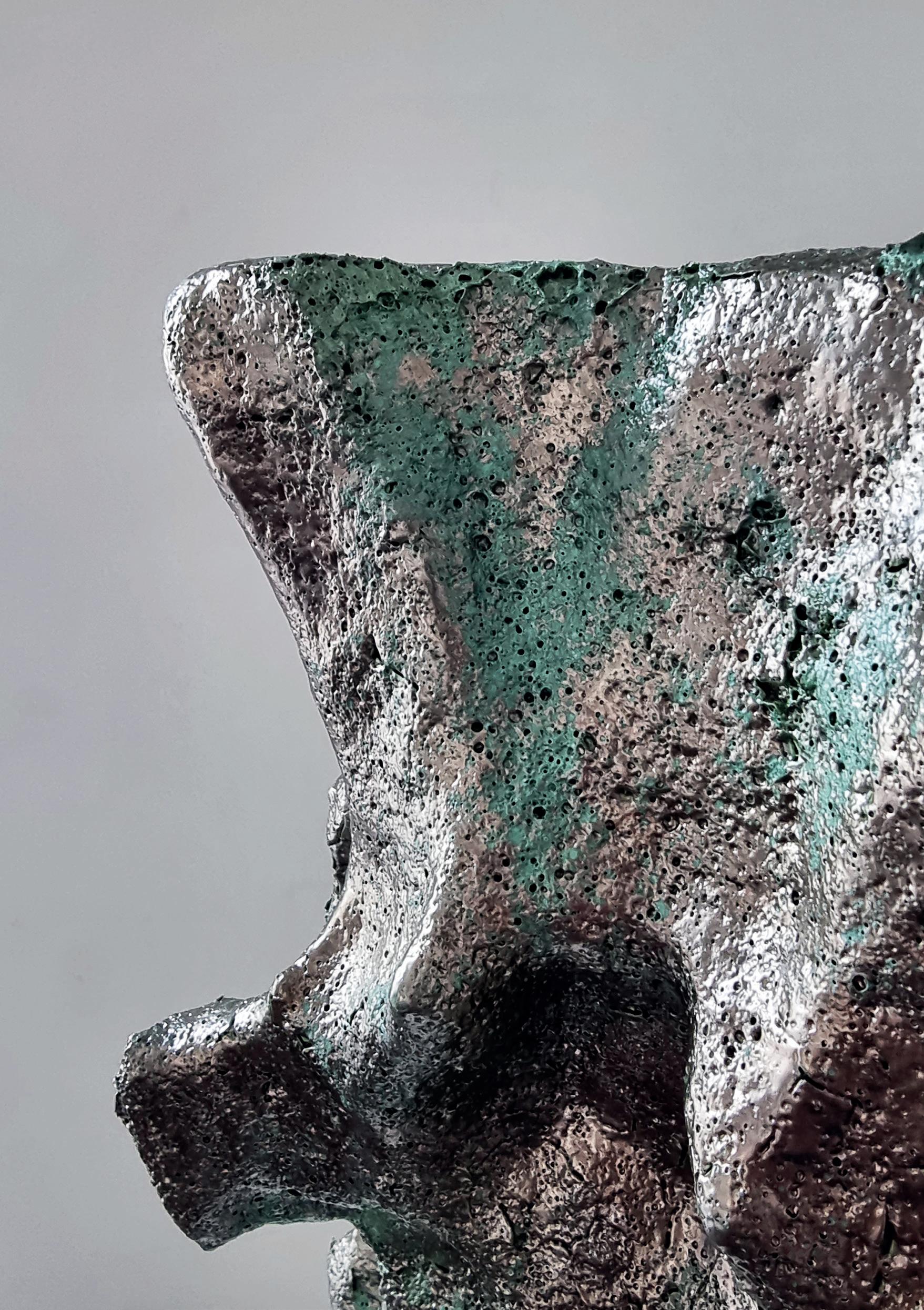
Metallic Fragment Vessel
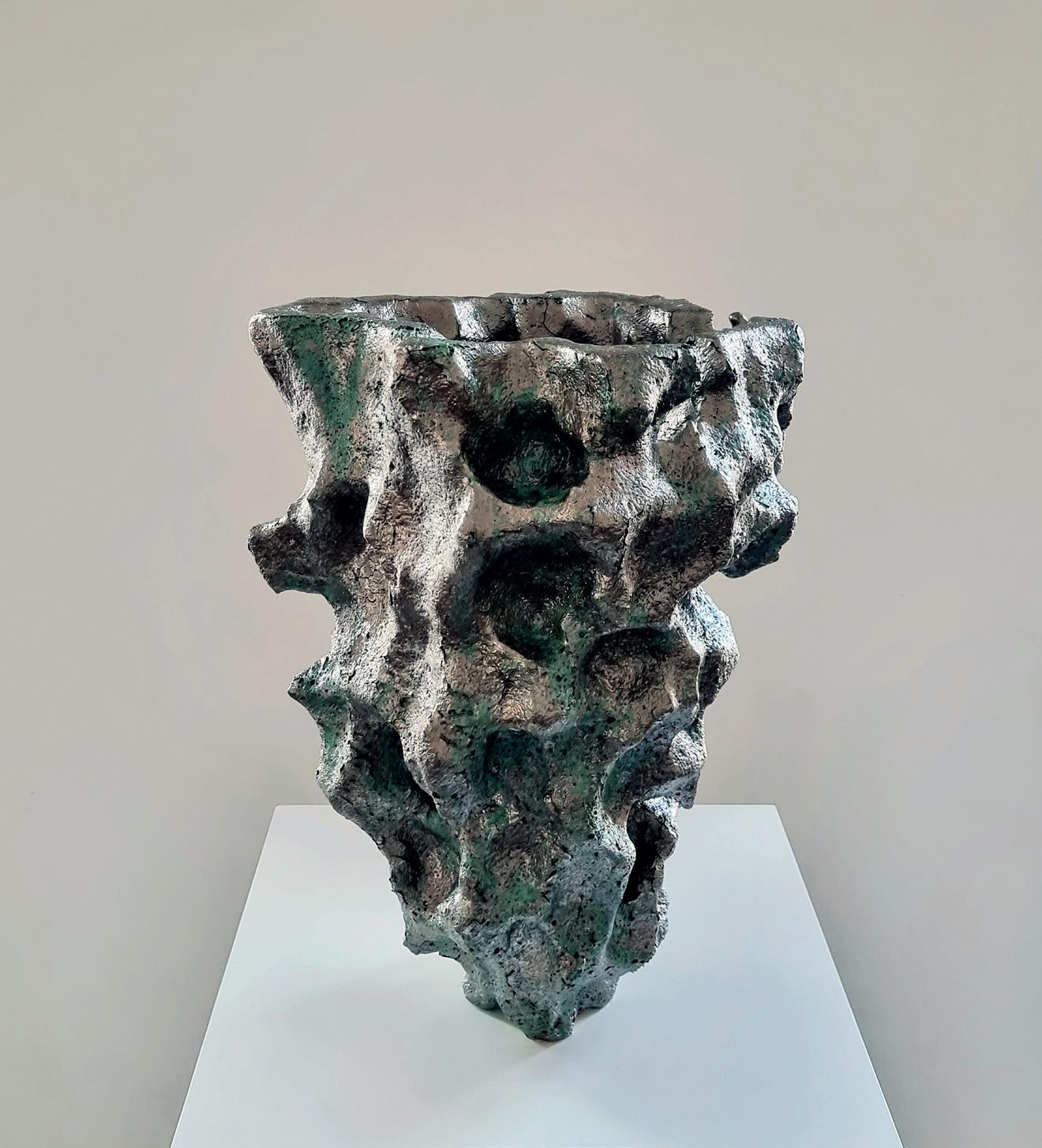
Stoneware
H 55 cm, w 39 cm, d 40 cm
Axosmilia
Stoneware, wall hung with separate small mount
H 59 cm, w 59 cm, d 8 cm
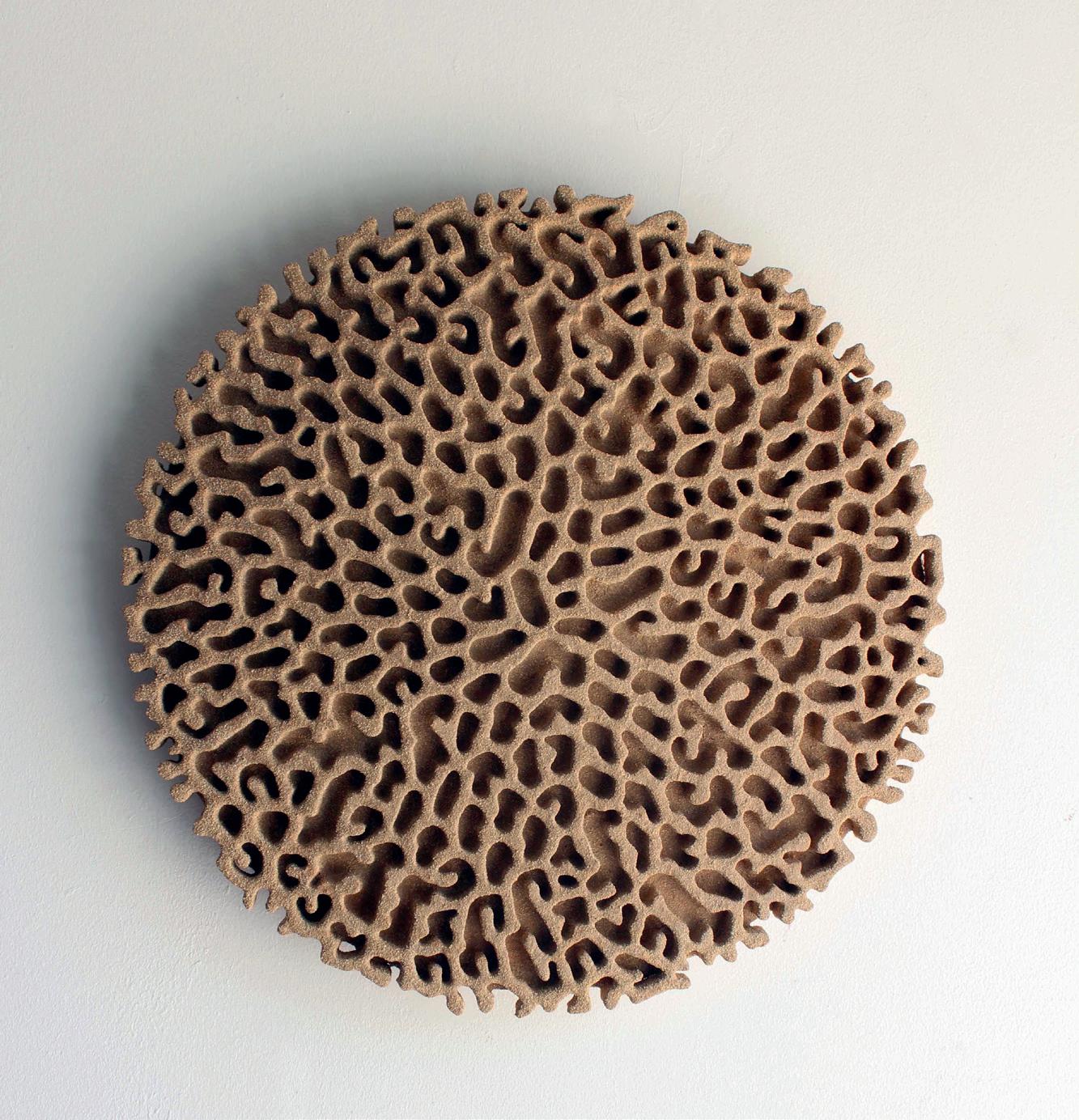
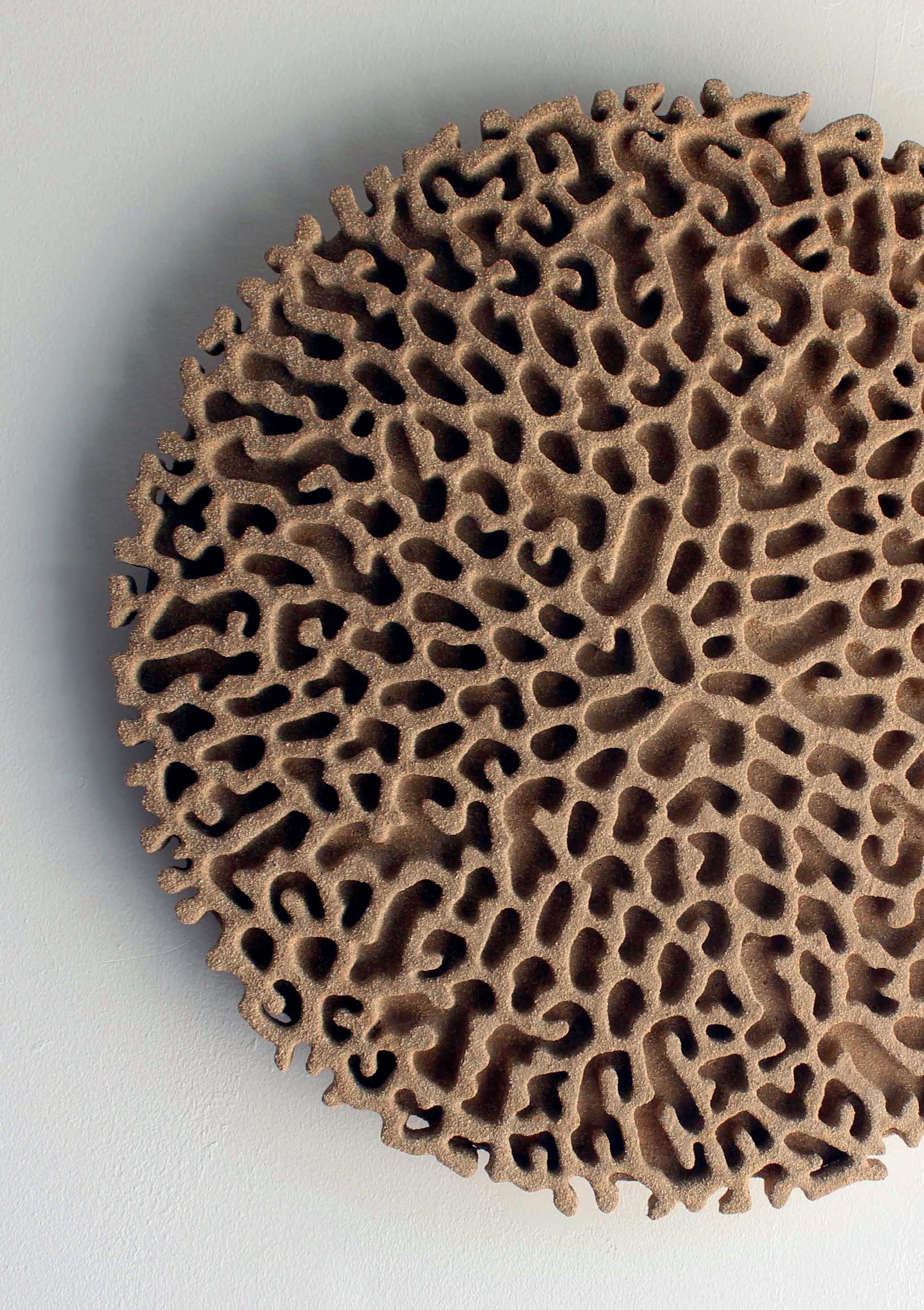
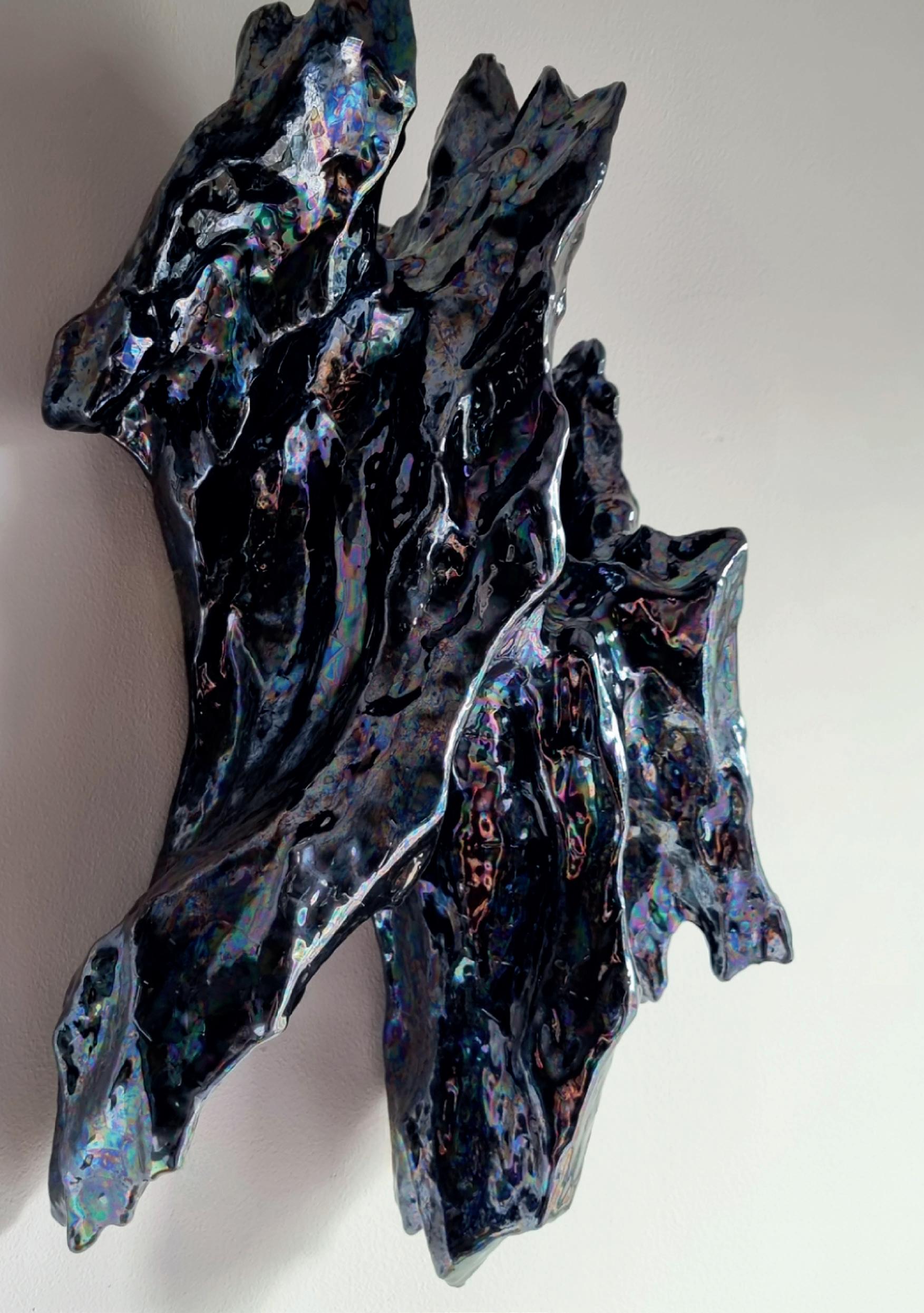
Black Luster Fragment
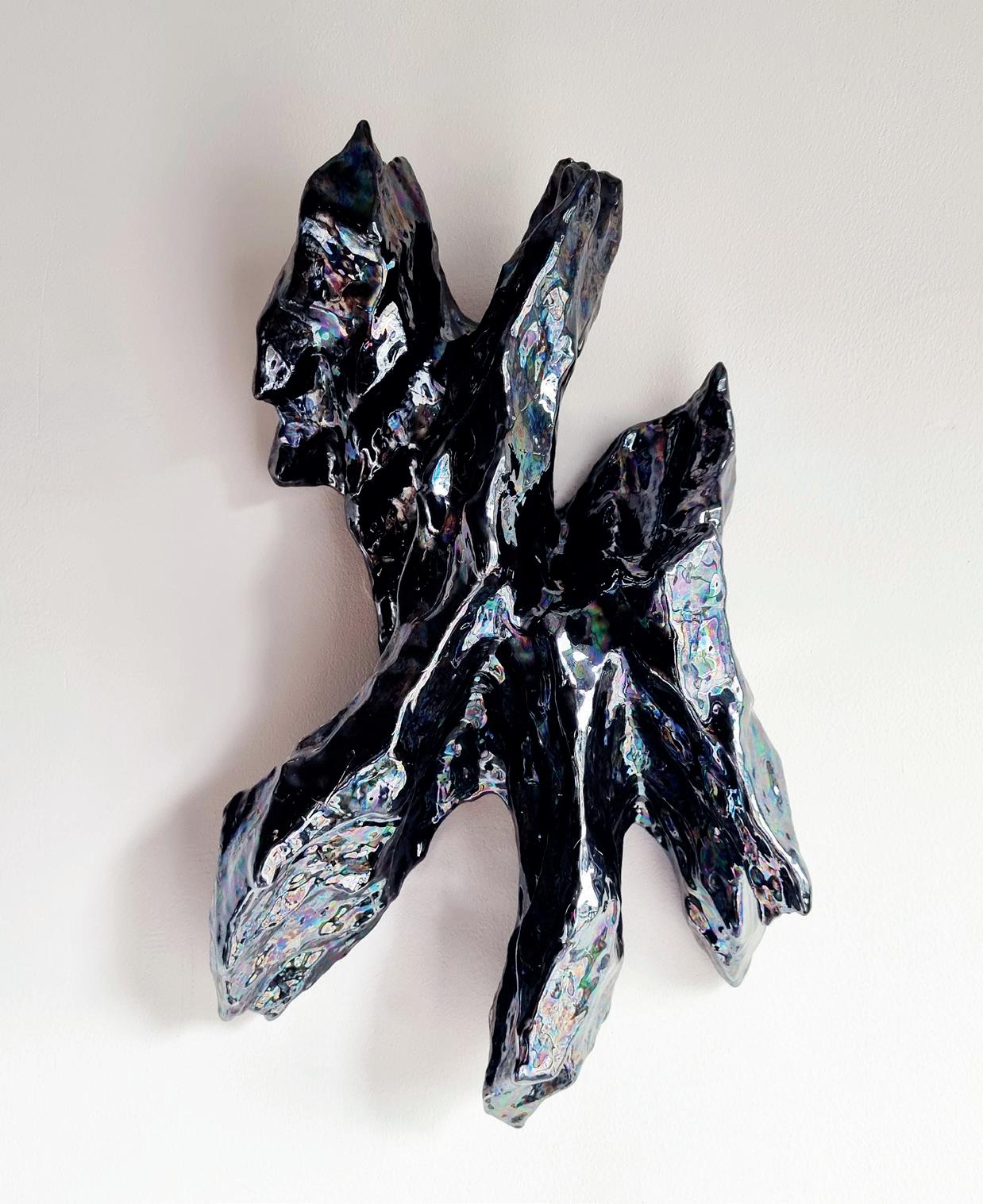
Stoneware, wall hung with small mount on back
H 58 cm, w 38 cm, d 17 cm
Lucia Zamberletti‘My approach to ceramics has been raw and pure with an urgency to create with my own hands after several years of working in the fashion industry as a product developer.’
‘I love to observe nature and live surrounded by it, witnessing the changing of the seasons leaves me with many impressions of natural life which I transform into sculptural pieces.’
‘I like to manipulate the clay, paying attention to its suggestions and live in the present. I often ride the wave of intuition and pleasure and make joyful pieces that spread an idea of beauty. I like to think that they can speak for themselves despite of who I am and where I come from.’
‘I also value imperfection which is a distinctive concept both in nature and in ceramics. I like to underline it in my works because it is how I mostly feel as a human being.’
‘I use both an electric kiln firing at low temperatures: 950°- 980°- 1020°- and a raku kiln firing mainly at 920°- 950°. I like to experiment with layers of glazes and mixing them up with engobes and oxides, obsessed with experimenting to find different colour combinations.’
Lucia Zamberletti is an Italian ceramic artist who has shown her work across Europe and in the USA.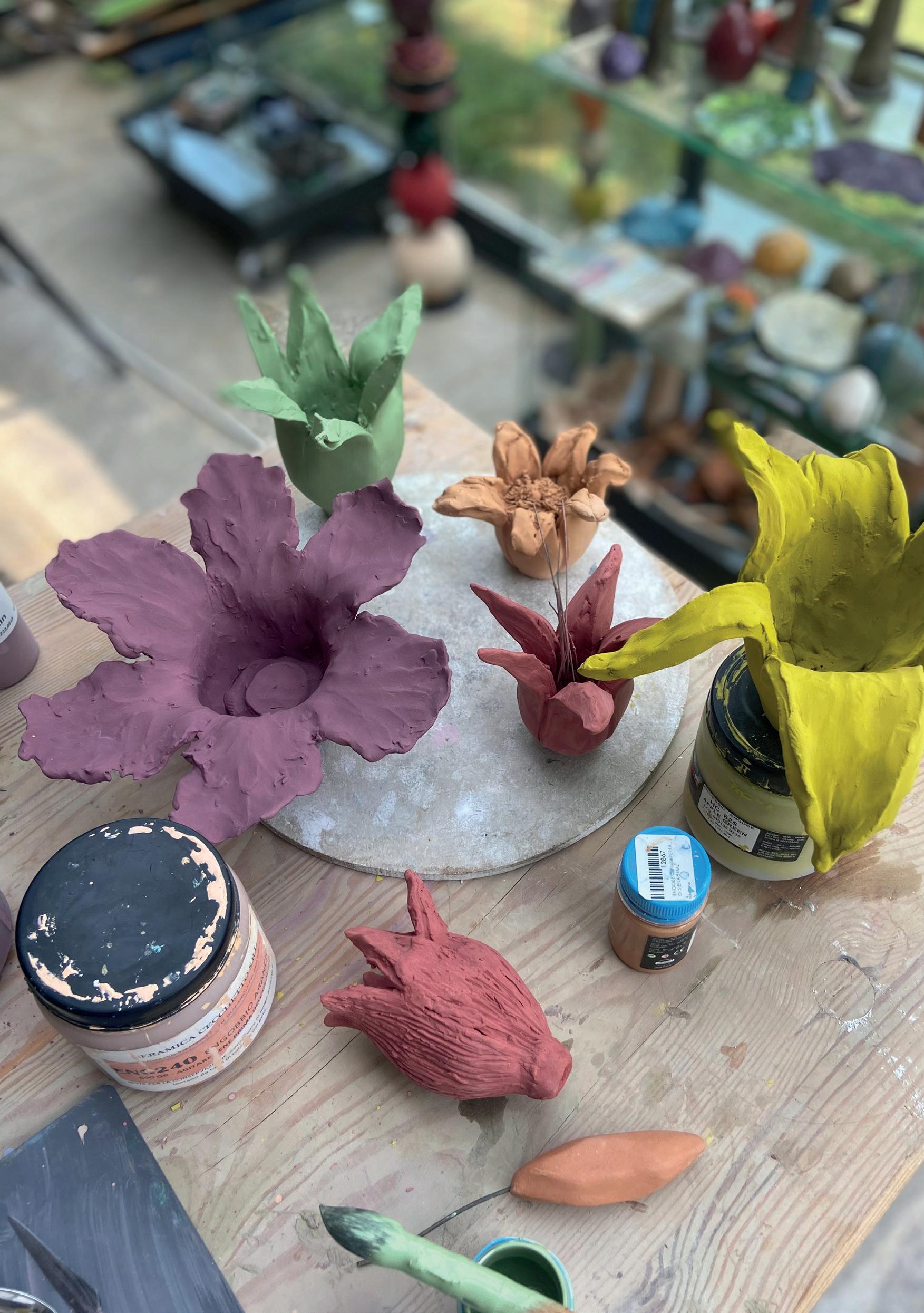
Artichoke #3
Fire clay, red clay and lilac clay, layers of coloured glazes and copper oxide
Fired in an electric kiln at 950° and 1020°
Fired in a raku kiln with metal gold & yellow glazes at 900°
H 20 cm, ø 16 cm
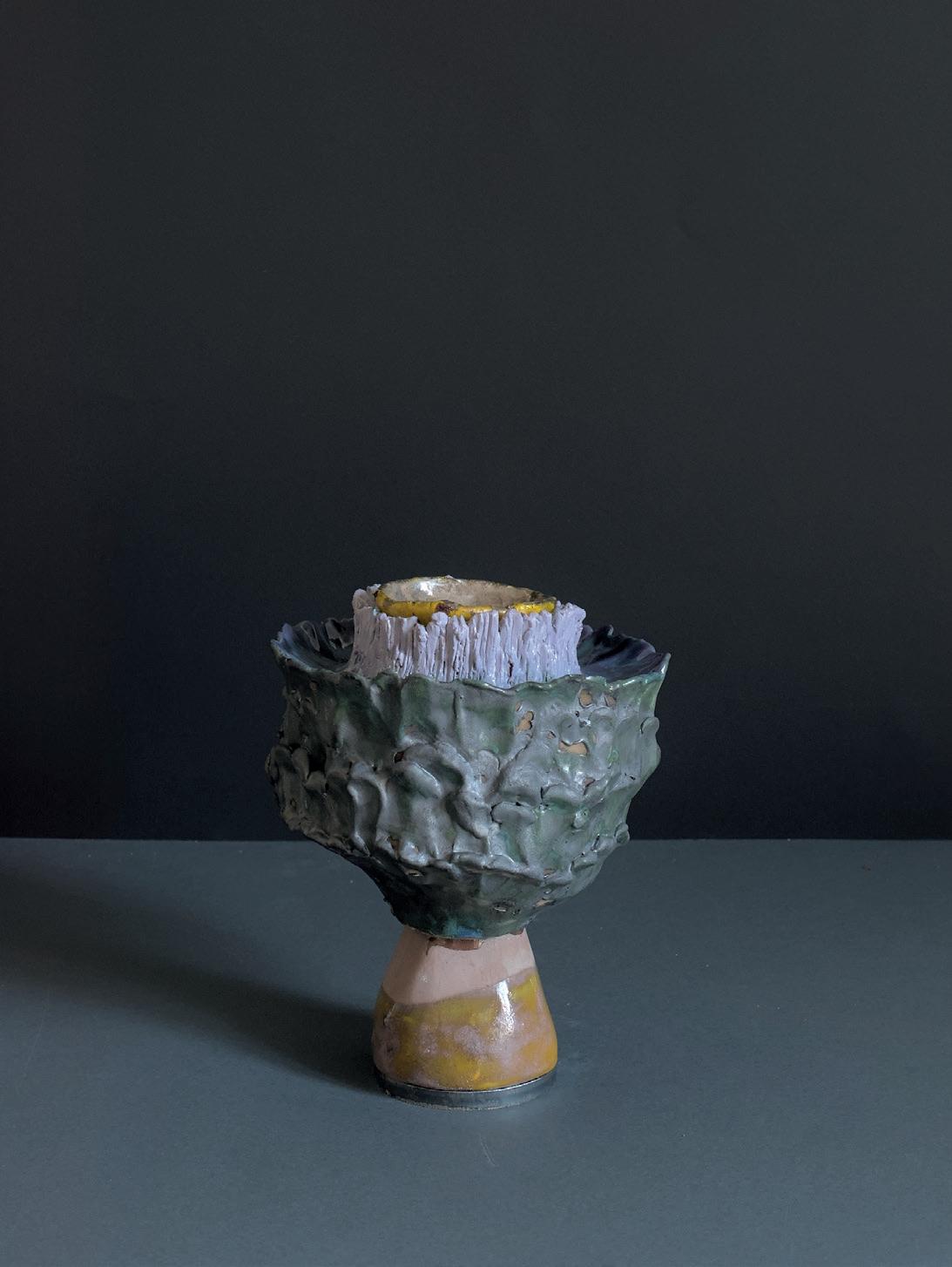
Red clay, fire clay and green clay with iron wire. Engobes, transparent glaze, red iron oxide and coloured and crackle glazes. Fired in an electric kiln at 950°, 980° and 1020°. Fired in a raku kiln with gold metallic glaze at 900°
H 38 cm, ø 10 cm
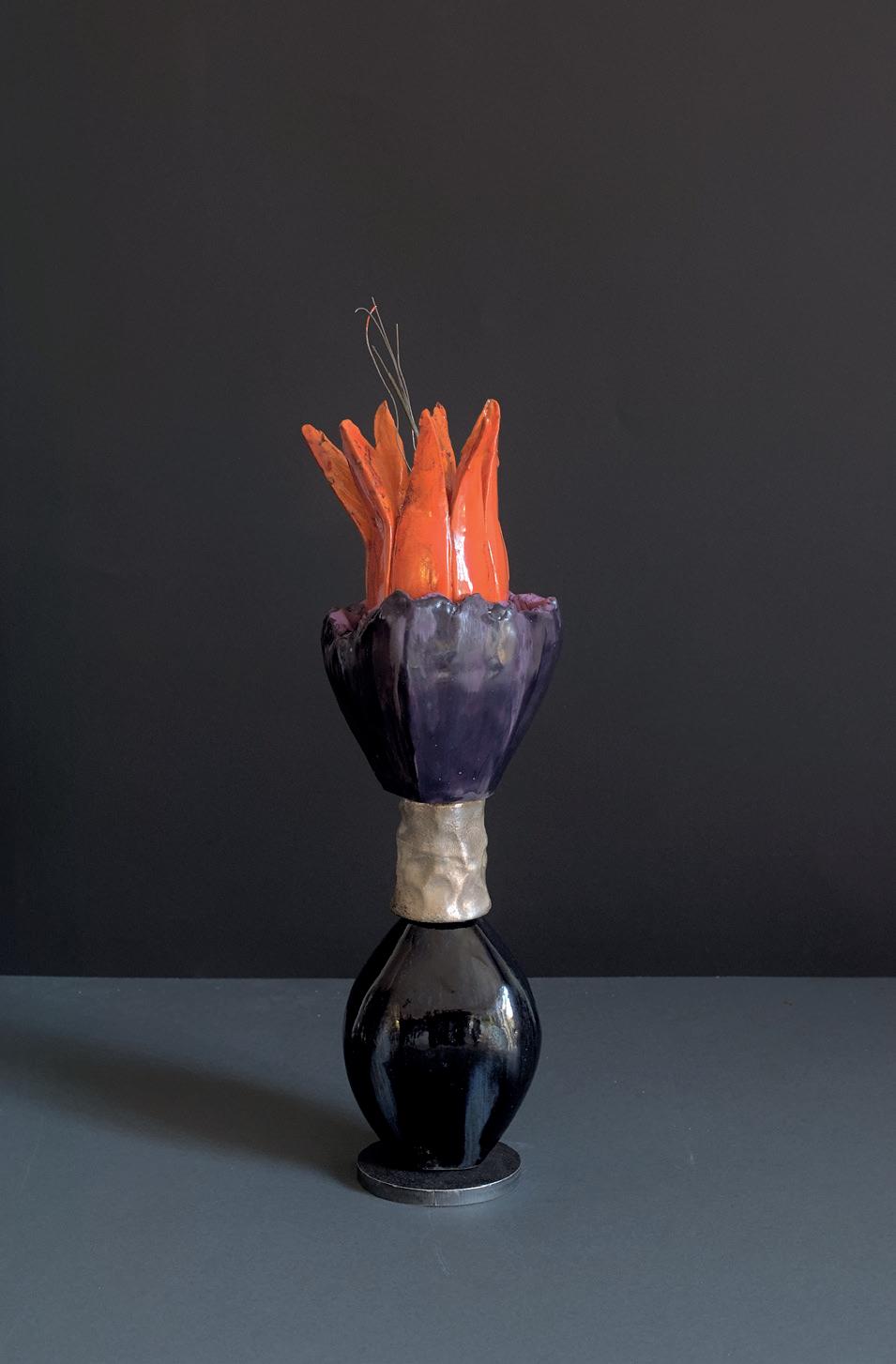 Bloomen #55
Bloomen #55
Funghi #45
White clay and fire clay with layers of matt & shiny coloured glazes, engobes and oxides. Fired in an electric kiln at 950° and 1020°
Fired in a raku kiln with green copper silver glazes at 920°
H 31 cm, ø 13 cm
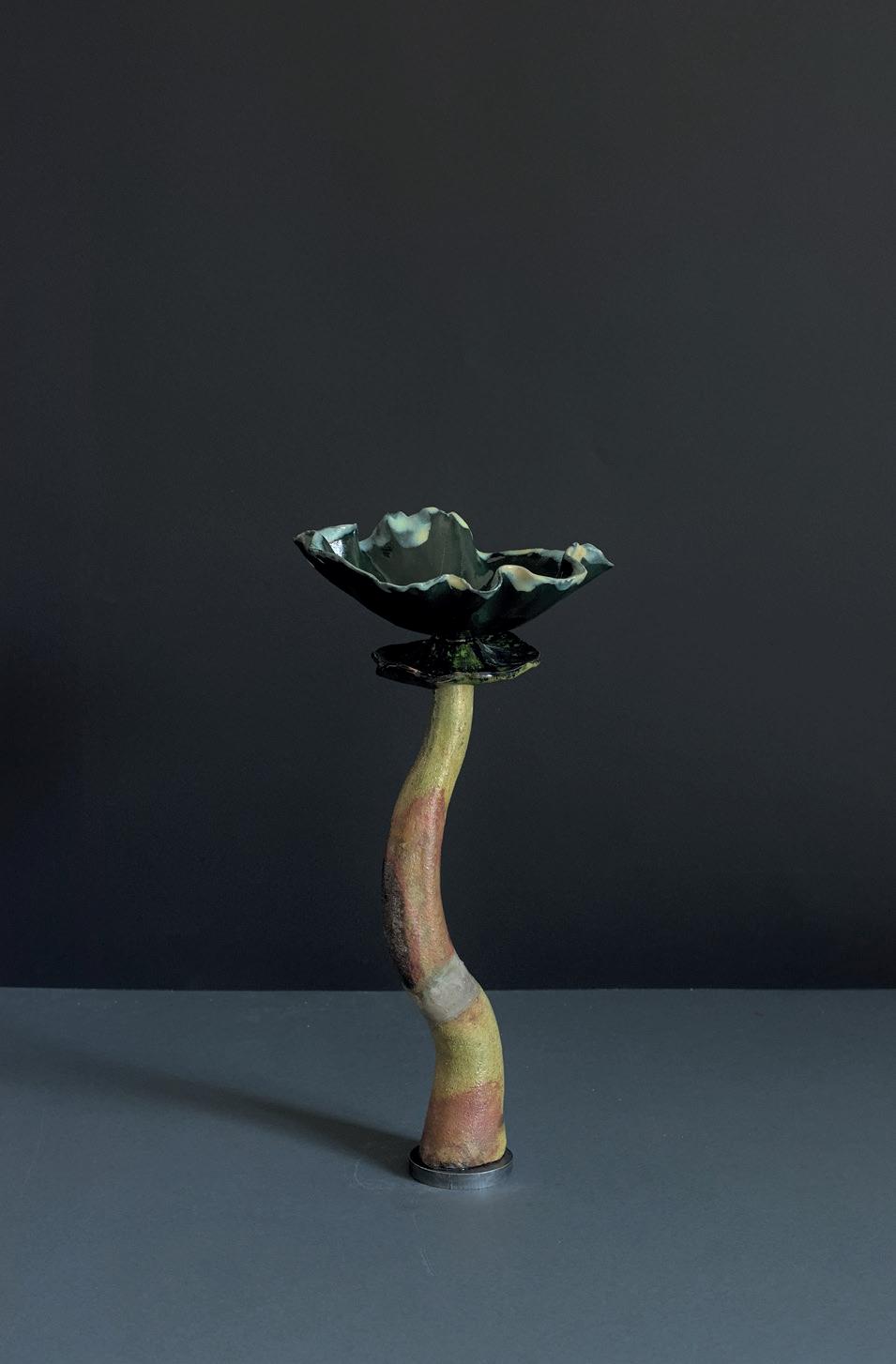
Bloomen #58
Red clay, fire clay and lilac clay
Engobes and transparent glaze, matt glazes and layers of coloured glaze
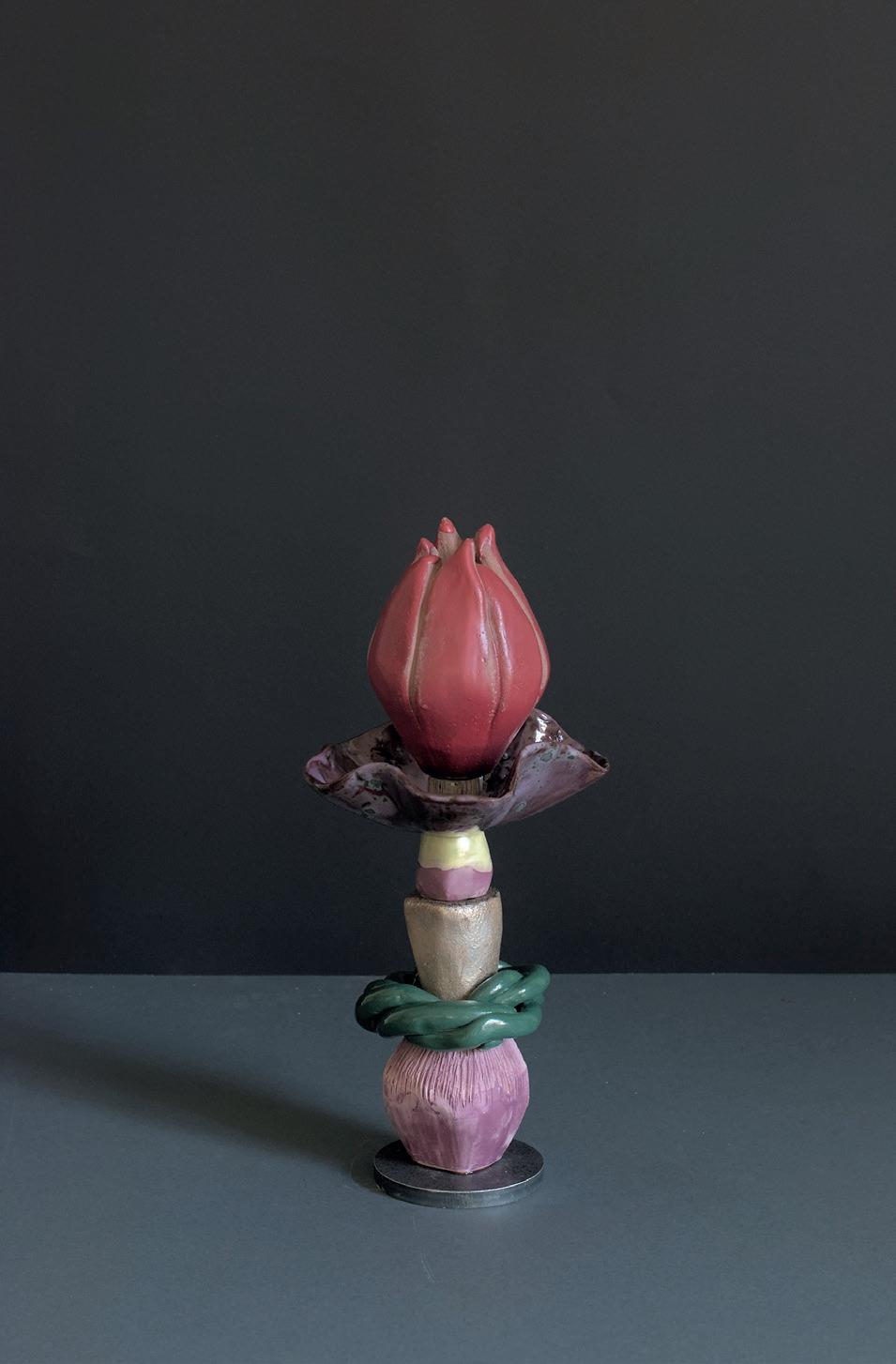
Fired in an electric kiln at 950° and 1020°
H 29 cm, ø 13 cm
Funghi #46
White clay and blue fire clay
Layers of coloured glazes, crackle transparent glaze and copper oxide
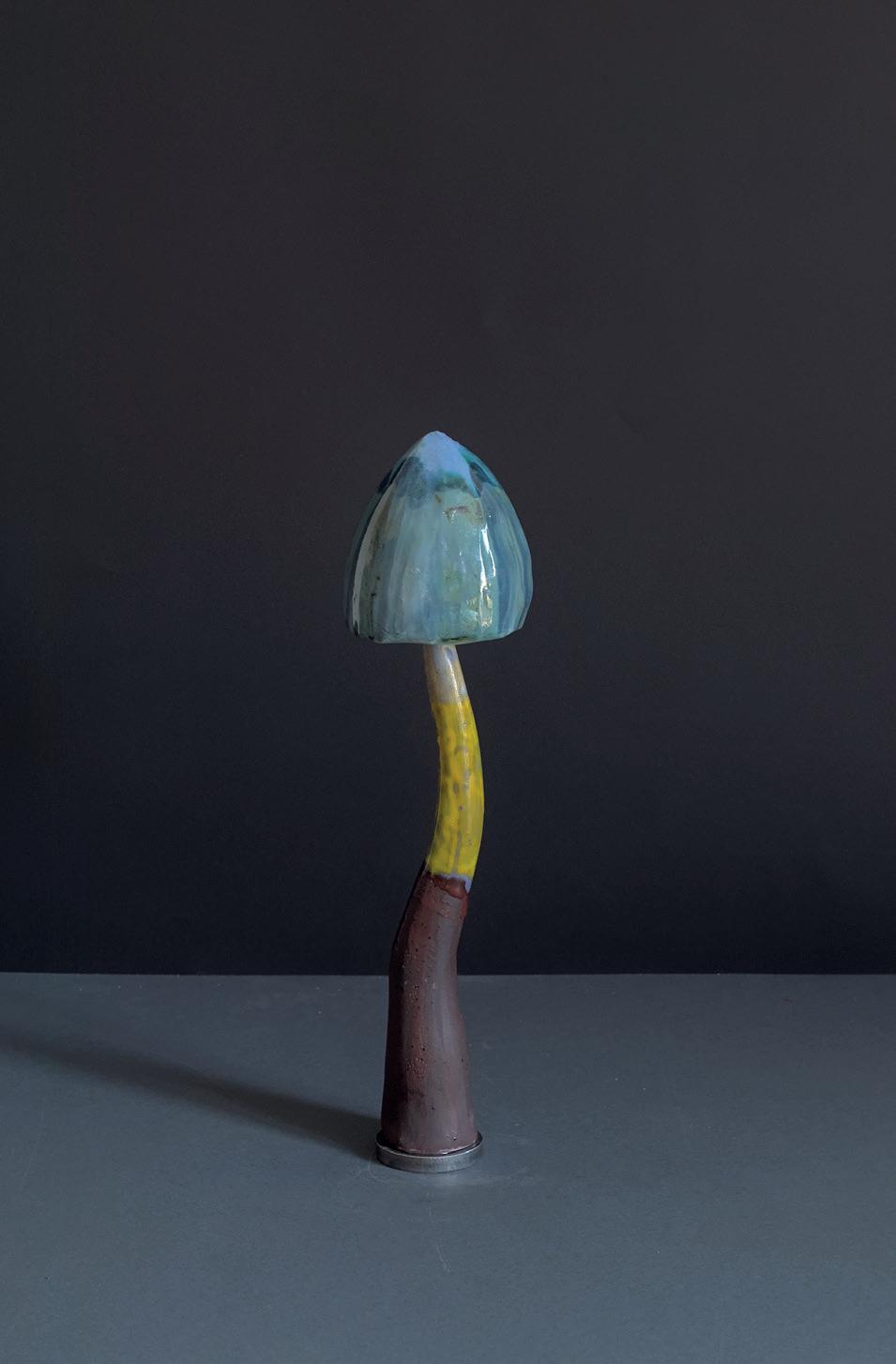
Fired in an electric kiln at 950°, 980° and 1020°
H 34 cm, ø 8 cm
Red clay and fire clay, matt glaze, layers of coloured glazes and oxides
Fired in an electric kiln at 950° and 1020°
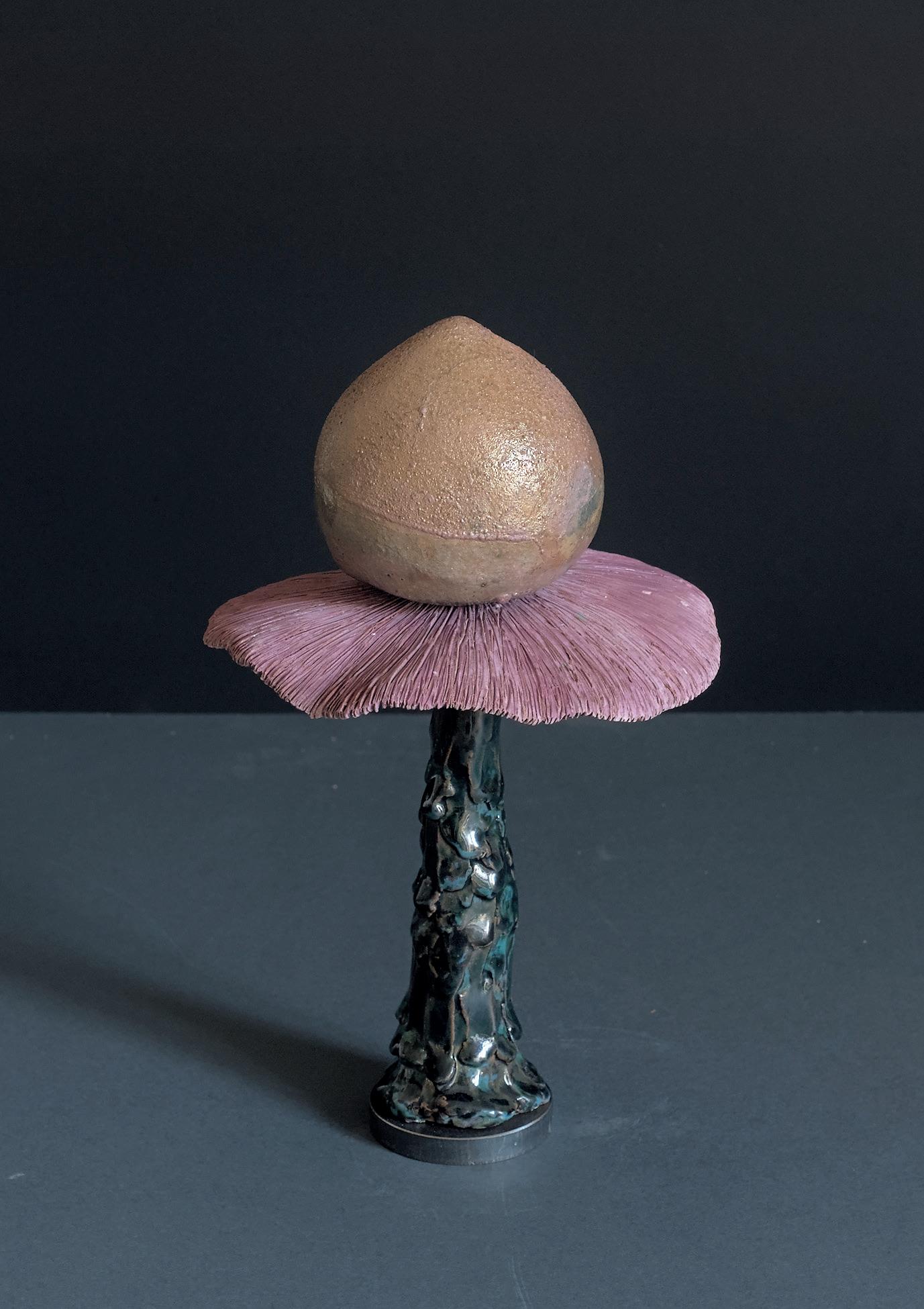
Fired in a raku kiln with metal gold glaze at 900°
H 23 cm, ø 15 cm
Funghi #51Tulip #4
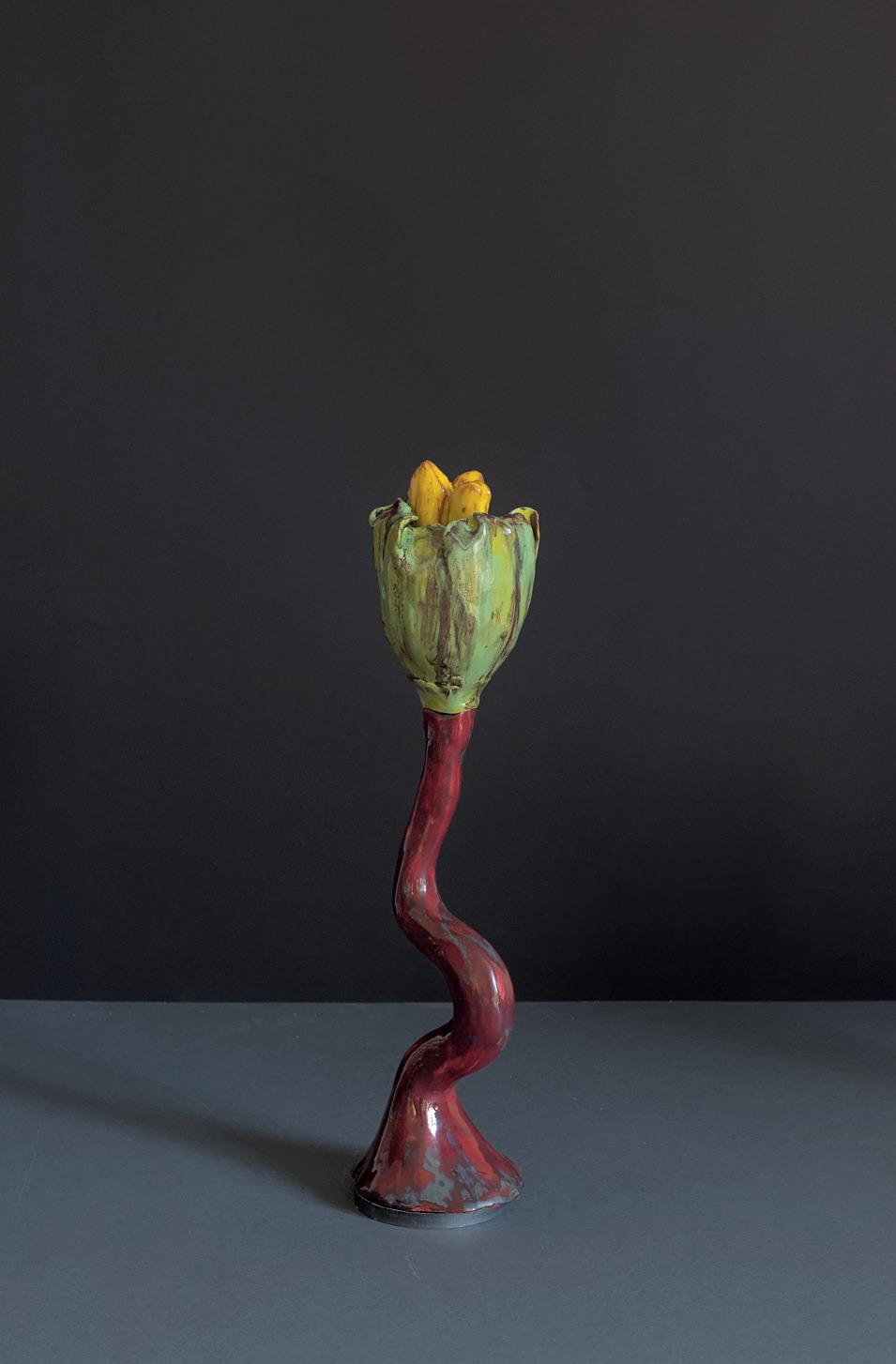
Red clay and yellow clay
Layers of coloured glazes, engobes and oxides
Fired in an electric kiln at 950° & 1020°
H 36 cm, ø 8 cm
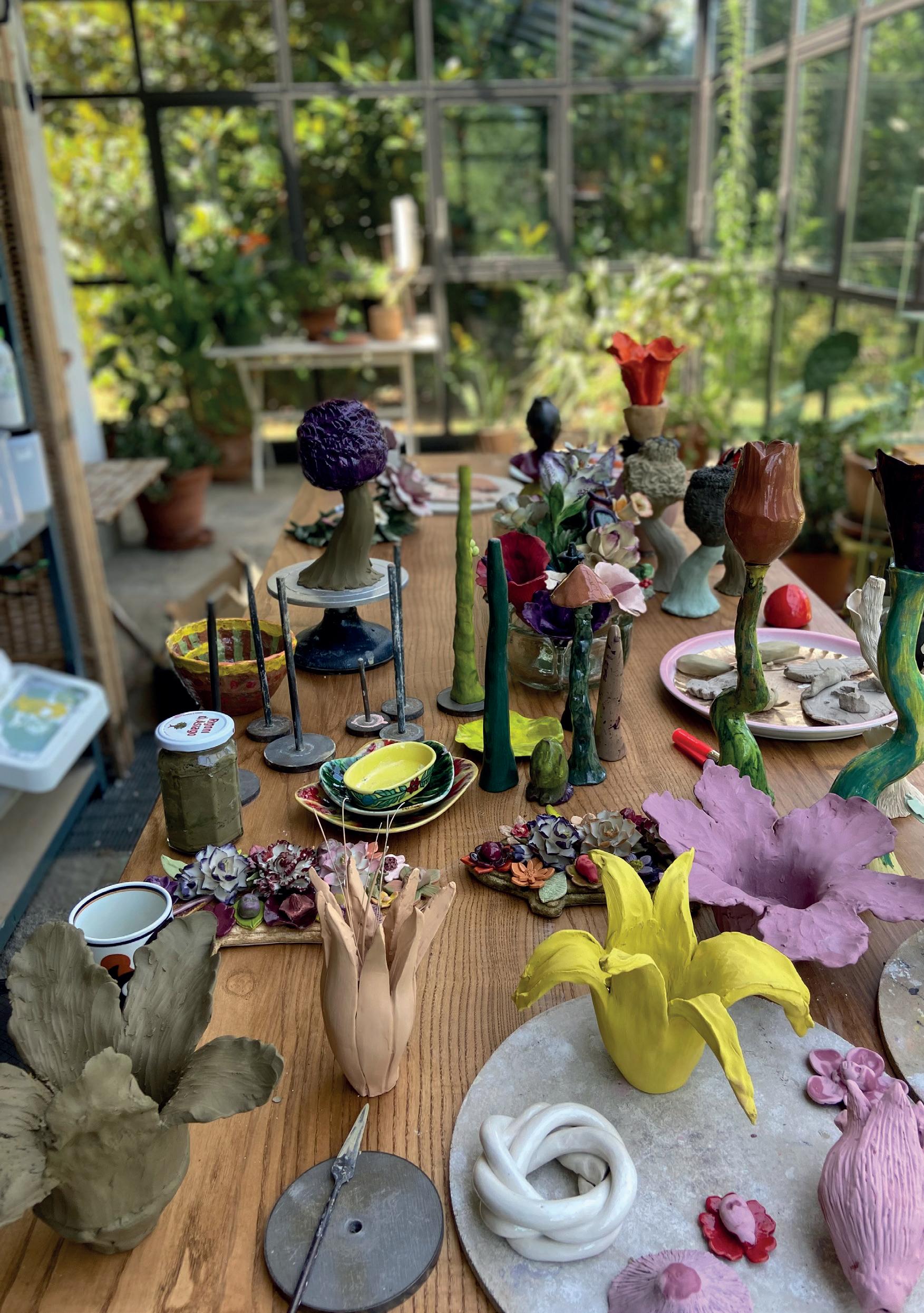
Funghi #40
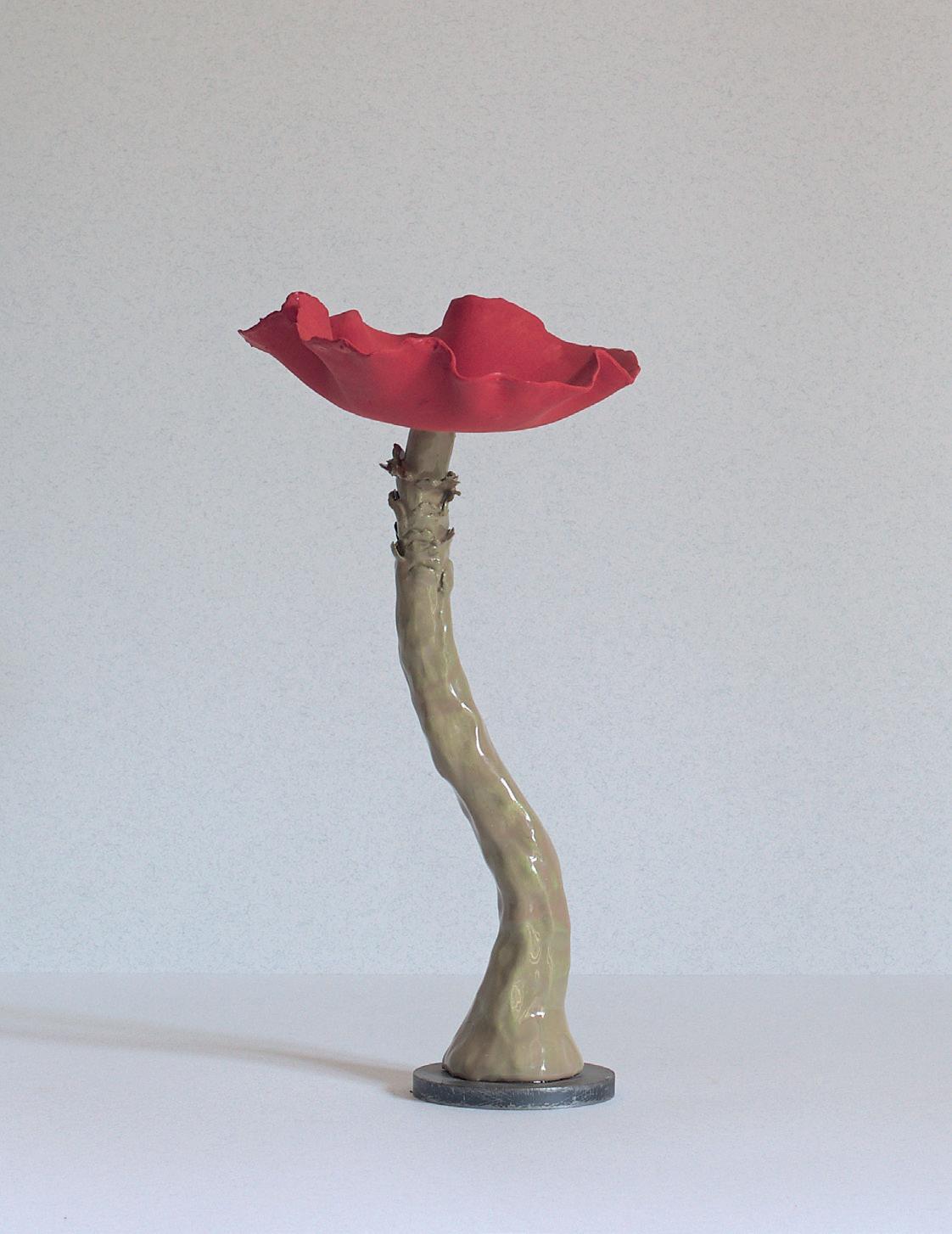
Red clay & yellow clay, layers of coloured glazes and engobes
Fired in an electric kiln at 950° and 1020°
H 29 cm, ø 17 cm
Red clay, fire clay, coloured and metallic glazes, engobes and transparent glaze
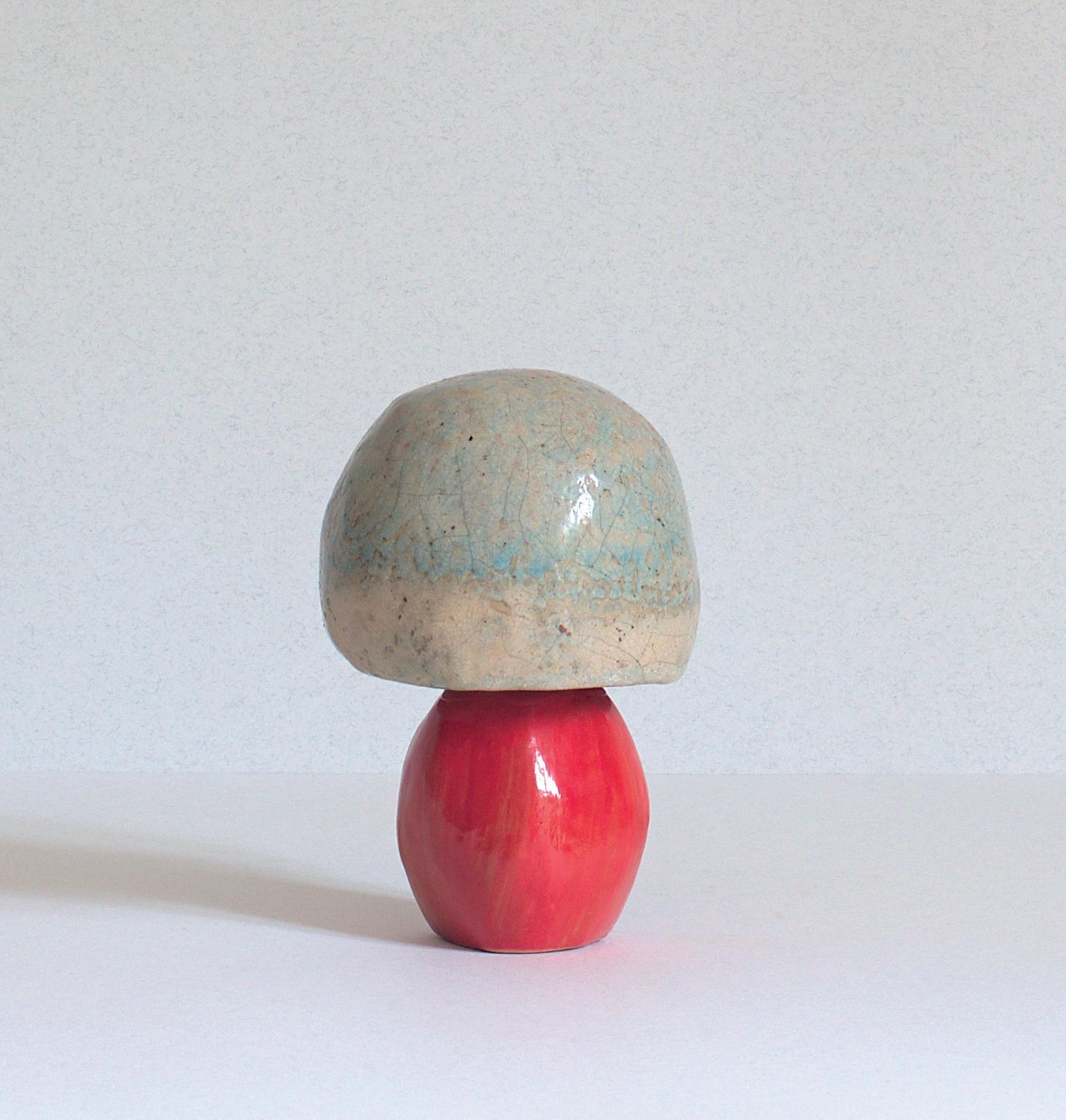
Fired in an electric kiln at 950° and 1020°. Fired in a raku kiln at 920°
H 17 cm, ø 10 cm
Funghi #37Bloomen #40
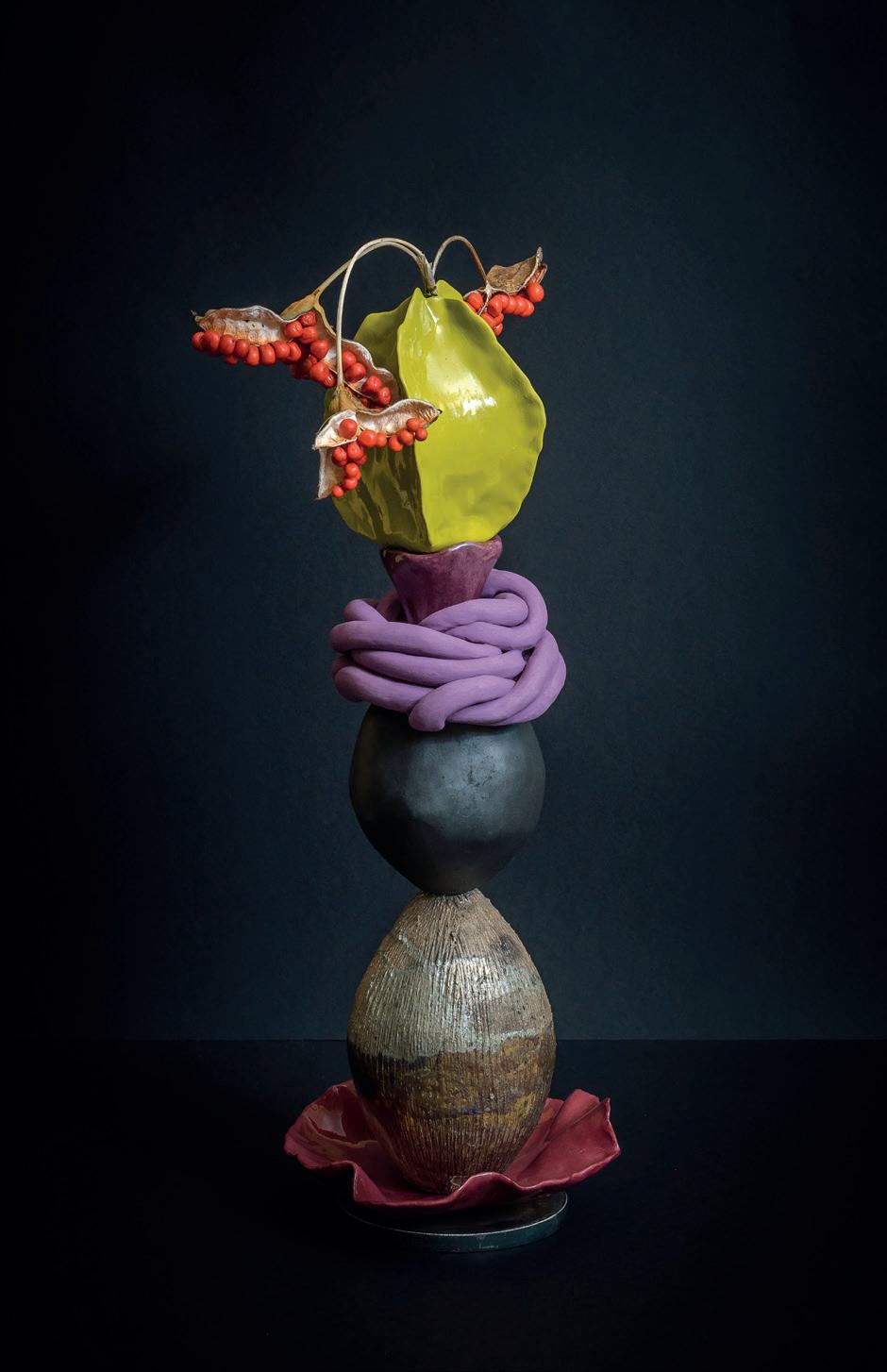
Red clay with layers of coloured glazes and metallic glazes
Fired in an electric kiln at 950° and 1020°
H 40 cm, ø 14 cm
Sassi Fioriti #15
Red clay with layers of coloured glazes & metallic glazes
Fired in an electric kiln at 950° and 1020°. Fired in a raku kiln at 920°
H 34 cm, ø 10 cm

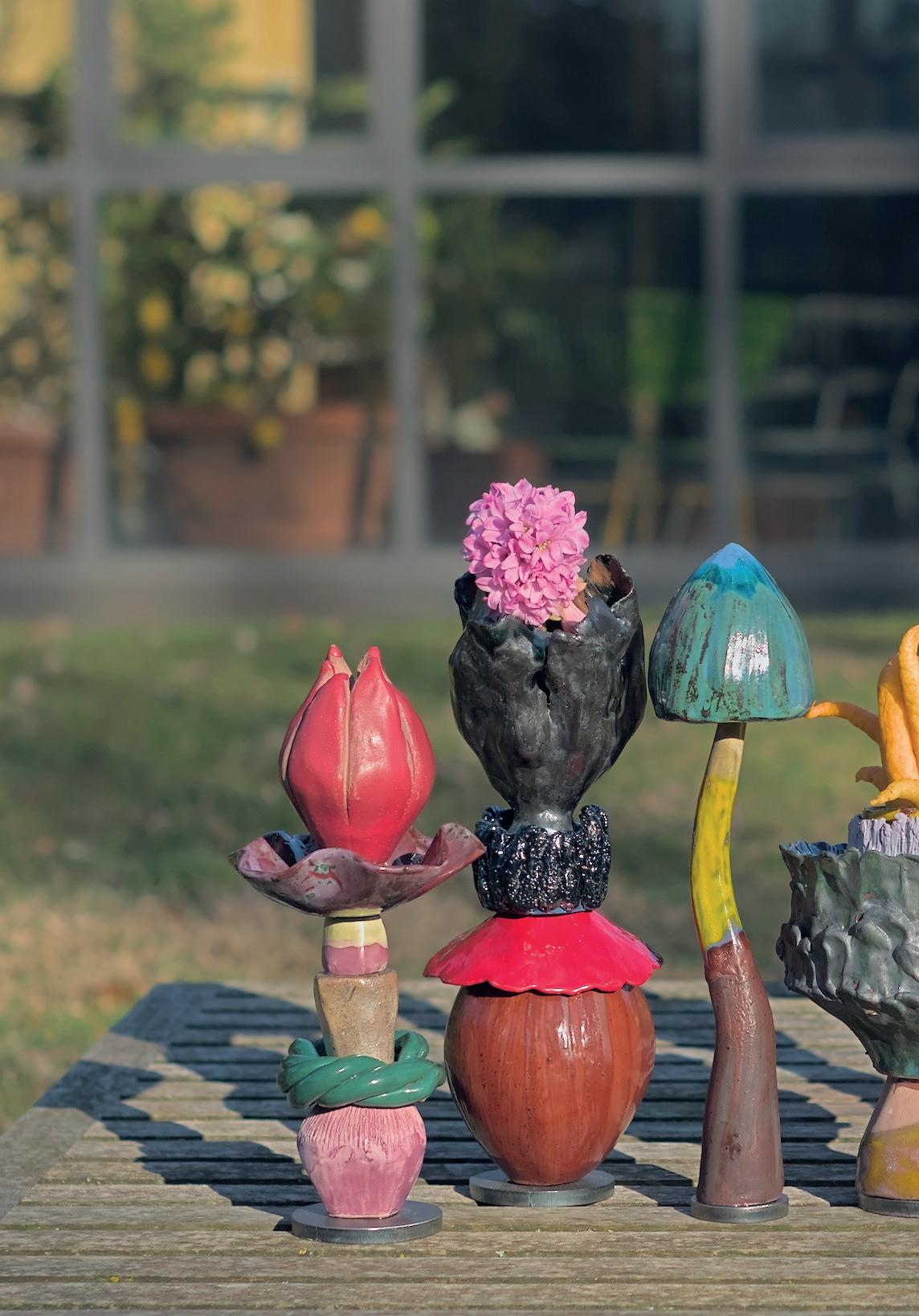
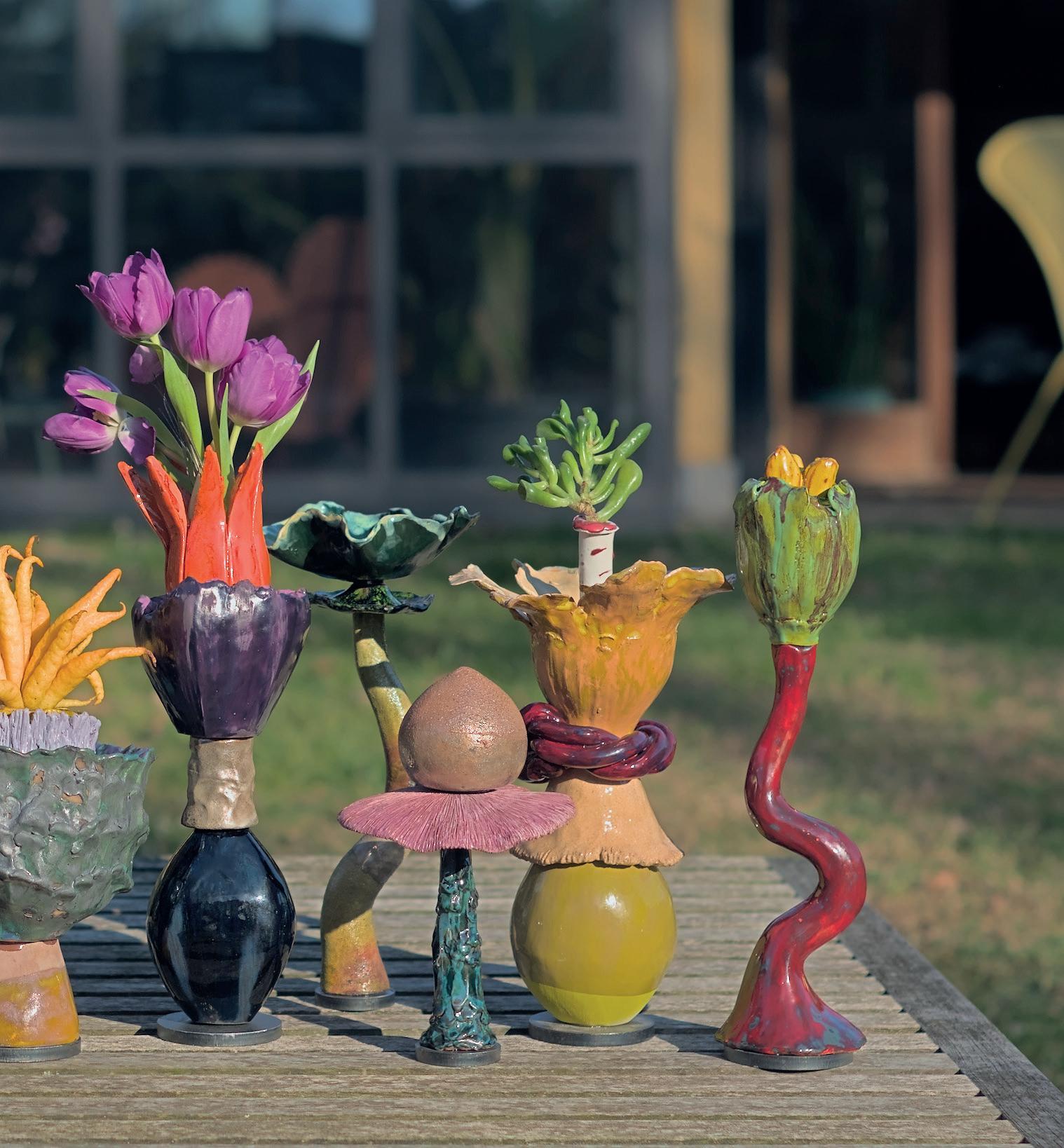
Bisila Noha
Bisila Noha is a Spanish ceramic artist based in London. Her work draws from influences and explorations of her Spanish and Equatorial Guinean heritage. Bisila aims to challenge Western views on art and craft; to question what we understand as productive and worthy in capitalist societies; and to reflect upon the idea of home and one-ness pulling from personal experiences in different pottery communities.
Her practice extends from wheelthrown pieces with the distinctive addition of marbled slip decoration to create eye-catching abstract landscapes; to sculptural pieces that mix throwing, coiling and carving and connect Bisila to her roots, the makers that precede her and our past.
Her work has been featured in many publications including the Financial Times and the New York Times.
Notable exhibitions include the Crafts Council’s exhibition ‘Maker’s Eye’ in 2021 and in 2022 the landmark exhibition ‘Body Vessel Clay’ at Two Temple Place - presenting the work of Ladi Kwali, Magdalene Odundo and Bisila Noha, three generations of Black women artists working with clay.
In 2022, two of Bisila’s sculptures were acquired by the V&A museum.
Photo credit: Karina Smagulova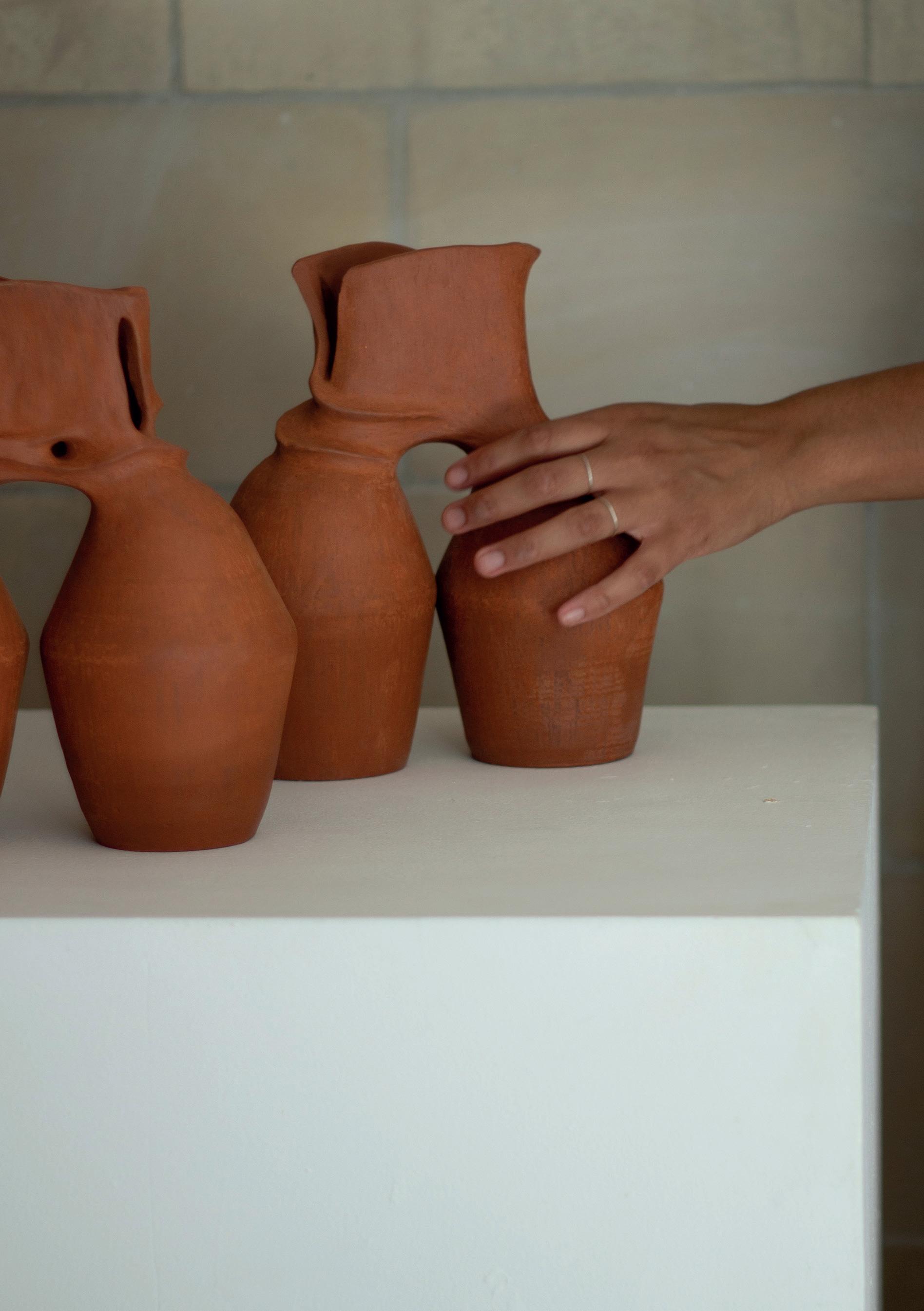
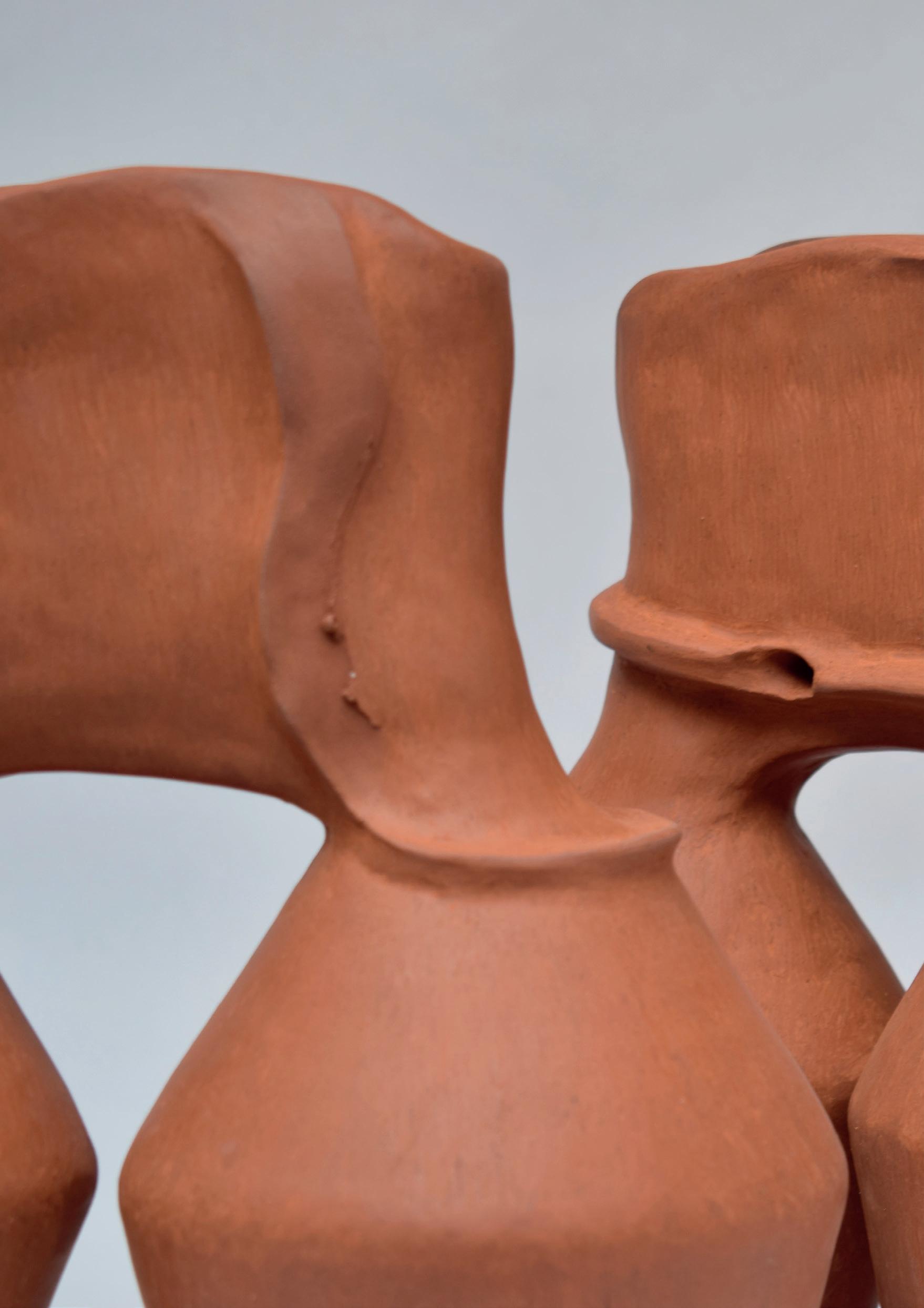
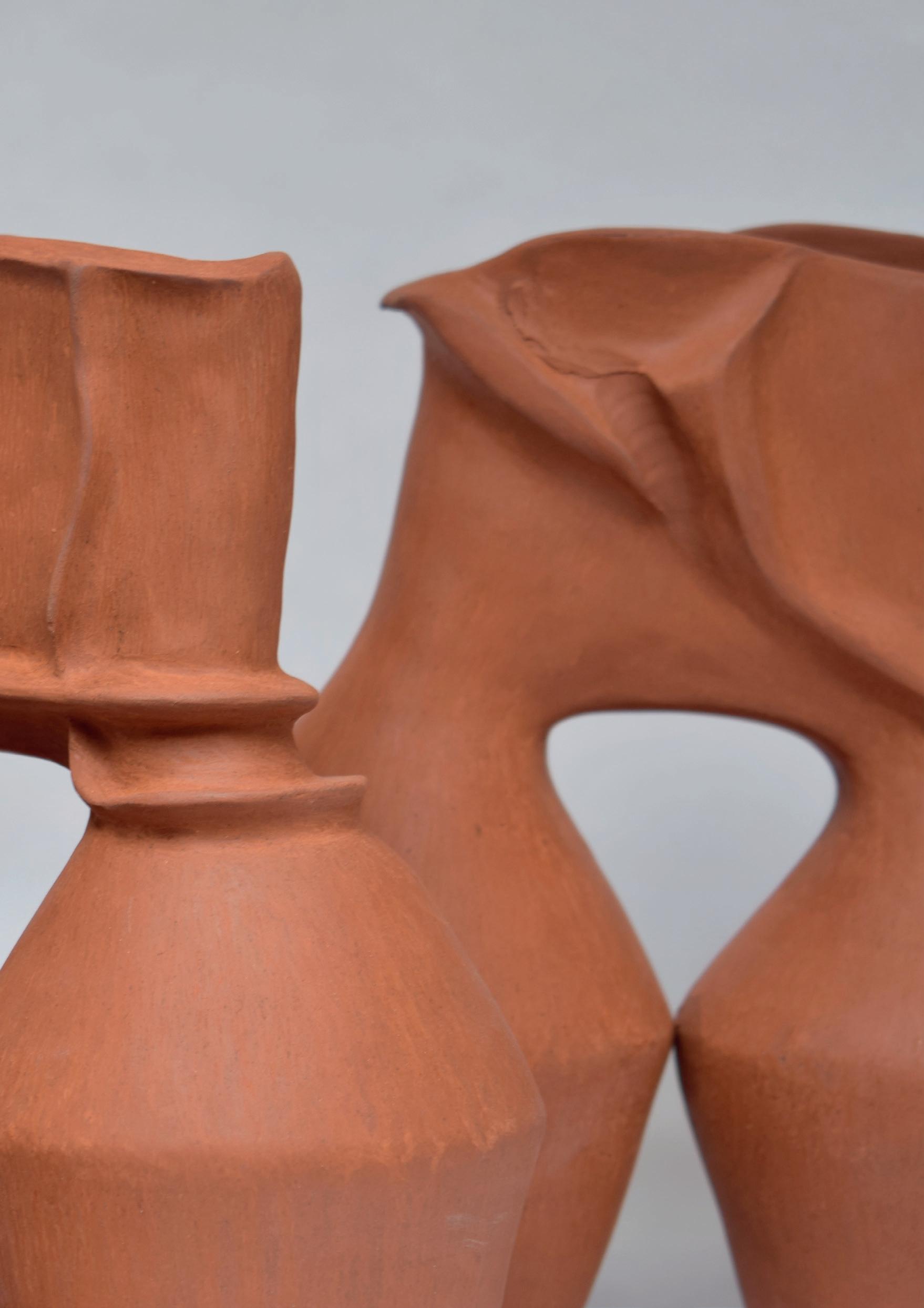
Wheel-thrown, coiled and carved terracotta
H 29 cm, w 22 cm, d 11 cm
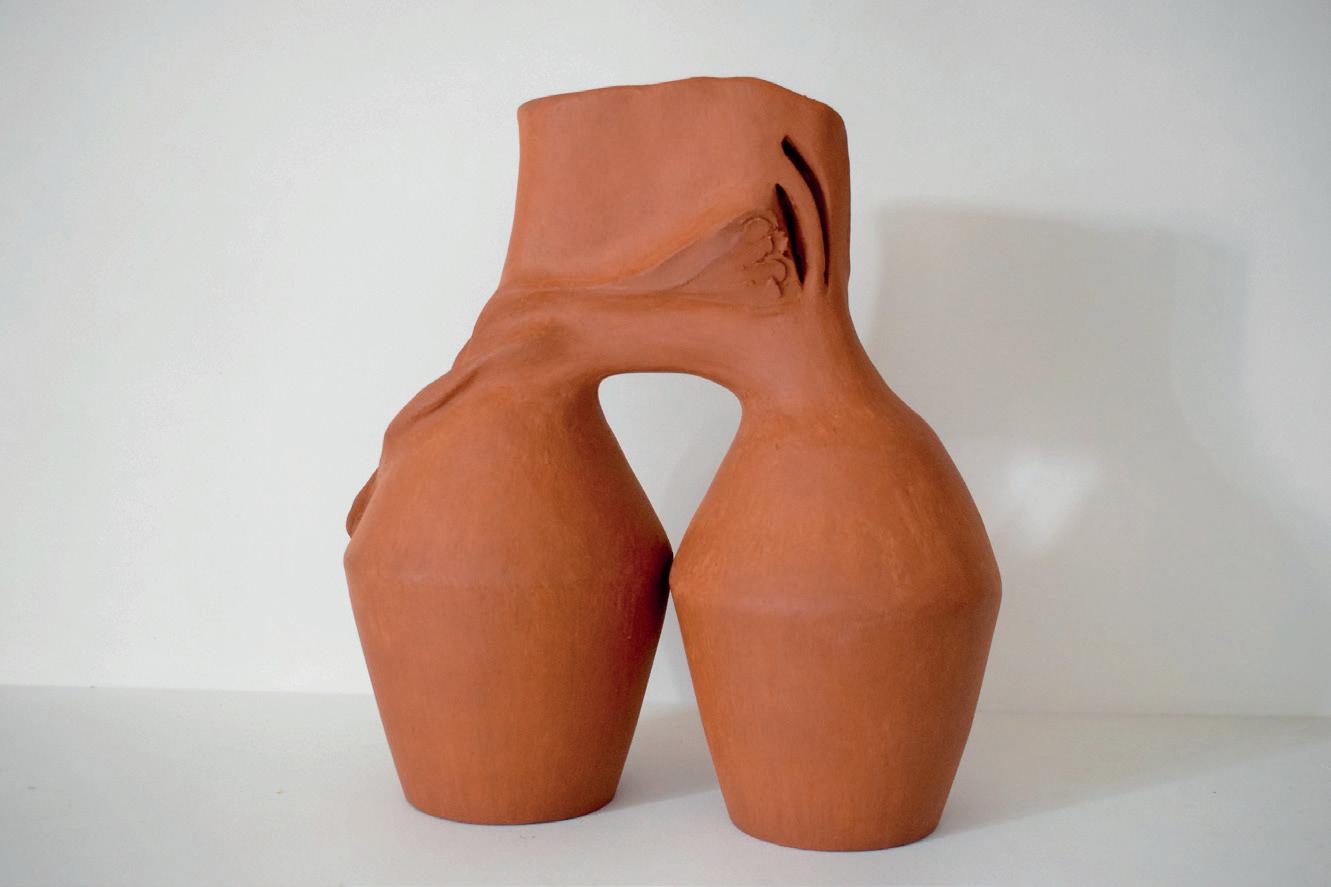 Reunion XV
Reunion XV
About the series ‘Searching for Kouame Kakaha: A celebration of the unnamed women of clay; our shared mothers and grandmothers’:
“Guided by my heritage of a love of beauty and a respect for strength — in search of my mother’s garden, I found my own.” Alice Walker, ‘In Search of Our Mothers’ Gardens’.
This body of work represents the now. It is nothing more than who I am right now
As a young woman, an artist, in search of my own voice and my place in a millennia-long lineage of women who have been working with clay. Women whose identity was shaped as the soil they stood on did in their hands.
I found a home in the houses of women potters in Mexico and Morocco - in the way their bodies danced with the clay; in their smiles. In the vessels of Kouame Kakaha (Ivory Coast, ca. 1960 - known date), Ladi Kwali or Mama Aicha. In the goddesses born in unknown Palaeolithic hands.
Though disconnected geographically and temporally, these women have shaped our past and influenced our present. If I want to know who I am, I need to know about them, immerse myself in the stories that the silhouettes of their vessels tell.
So this is where I am at.
Vessels and sculptures evoking the whispers I have heard. Figurines, traces, fingerprints. Endless curiosity. The unknown, the many different perspectives. Wanting to feel grounded by uprooting and rerooting. Heart wide open.
One stop of a life-long journey. In searching I will find. This is the now for now.
Bisila NohaWheel-thrown, coiled and carved terracotta
H 27 cm, w 24 cm, d 11.5 cm
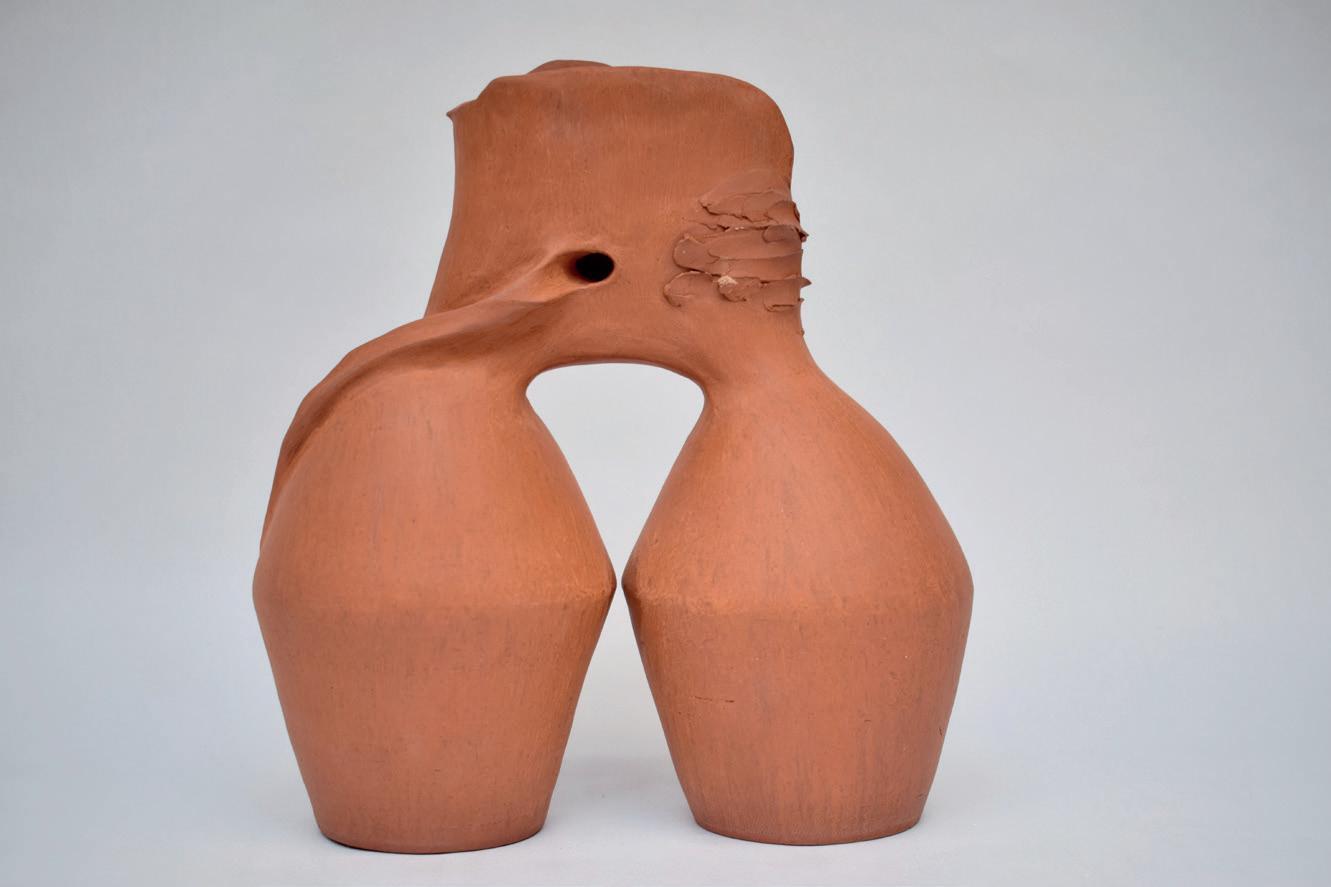 Reunion XVII
Reunion XVII
Reunion XVIII
Wheel-thrown, coiled and carved terracotta
H 24.5 cm, w 23 cm, d 11 cm
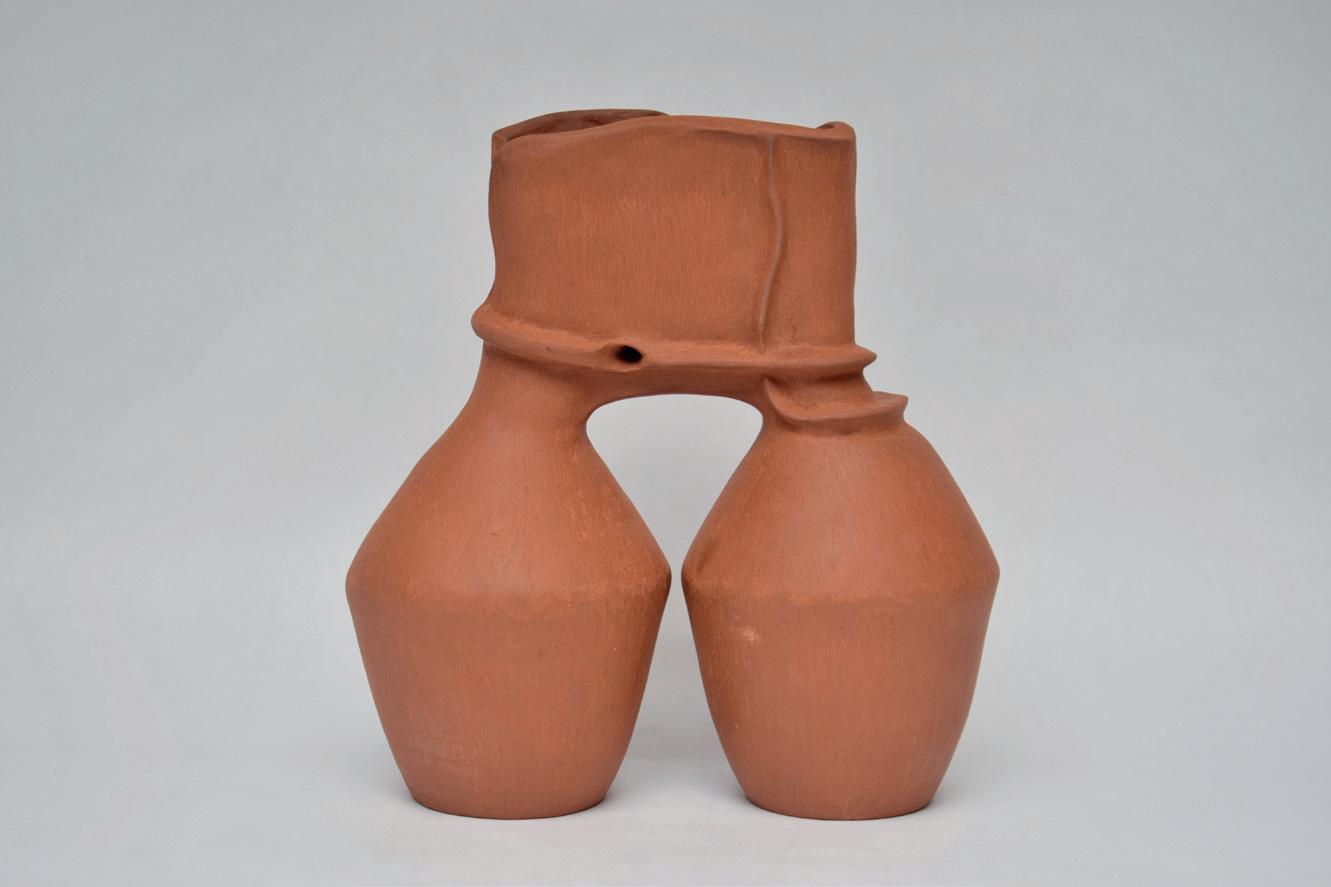
Wheel-thrown, coiled and carved terracotta
H 25 cm, w 25 cm, d 12 cm
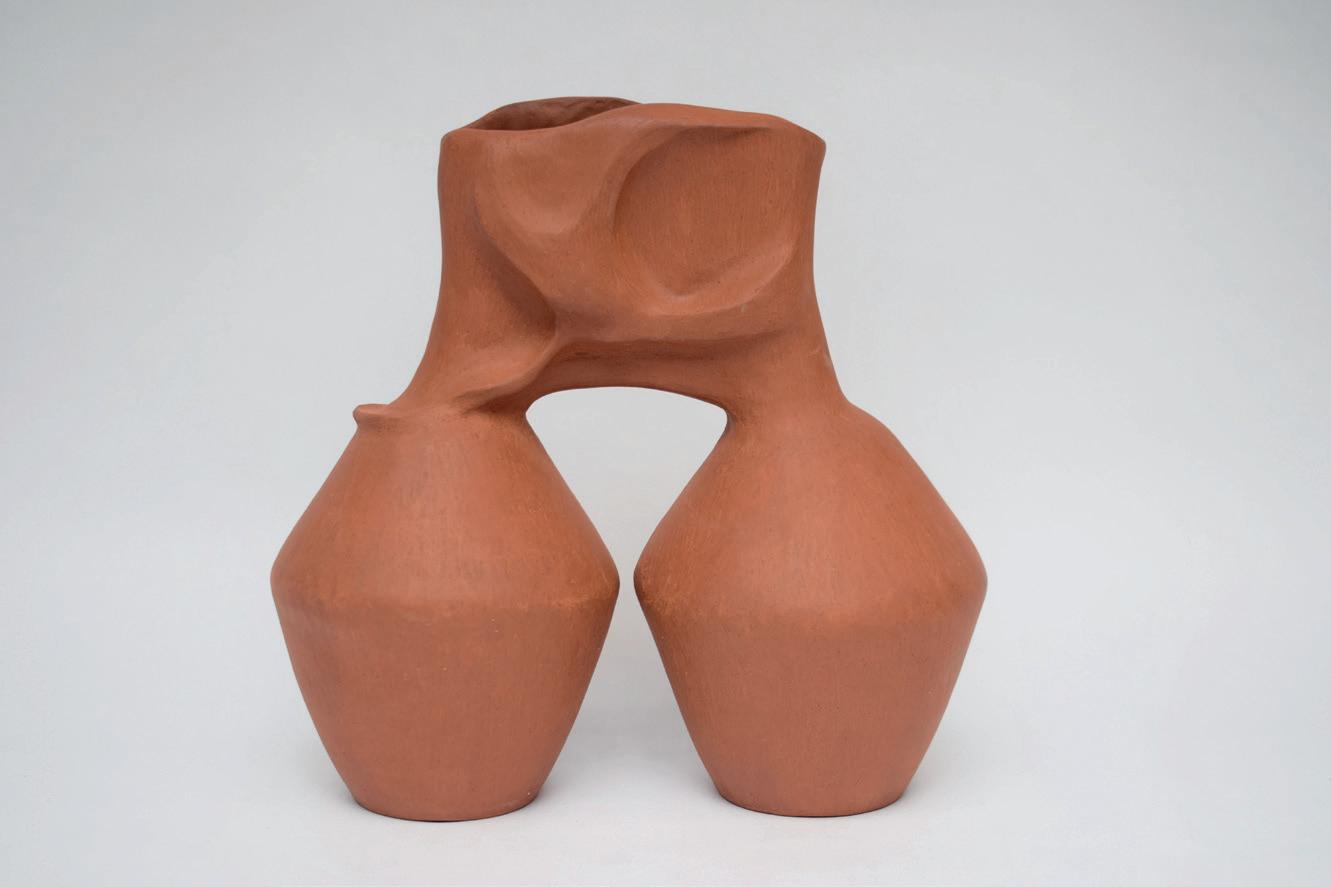 Reunion XIX
Reunion XIX
Reunion XX
Wheel-thrown, coiled and carved terracotta
H 25.5 cm, w 24 cm, d 12 cm
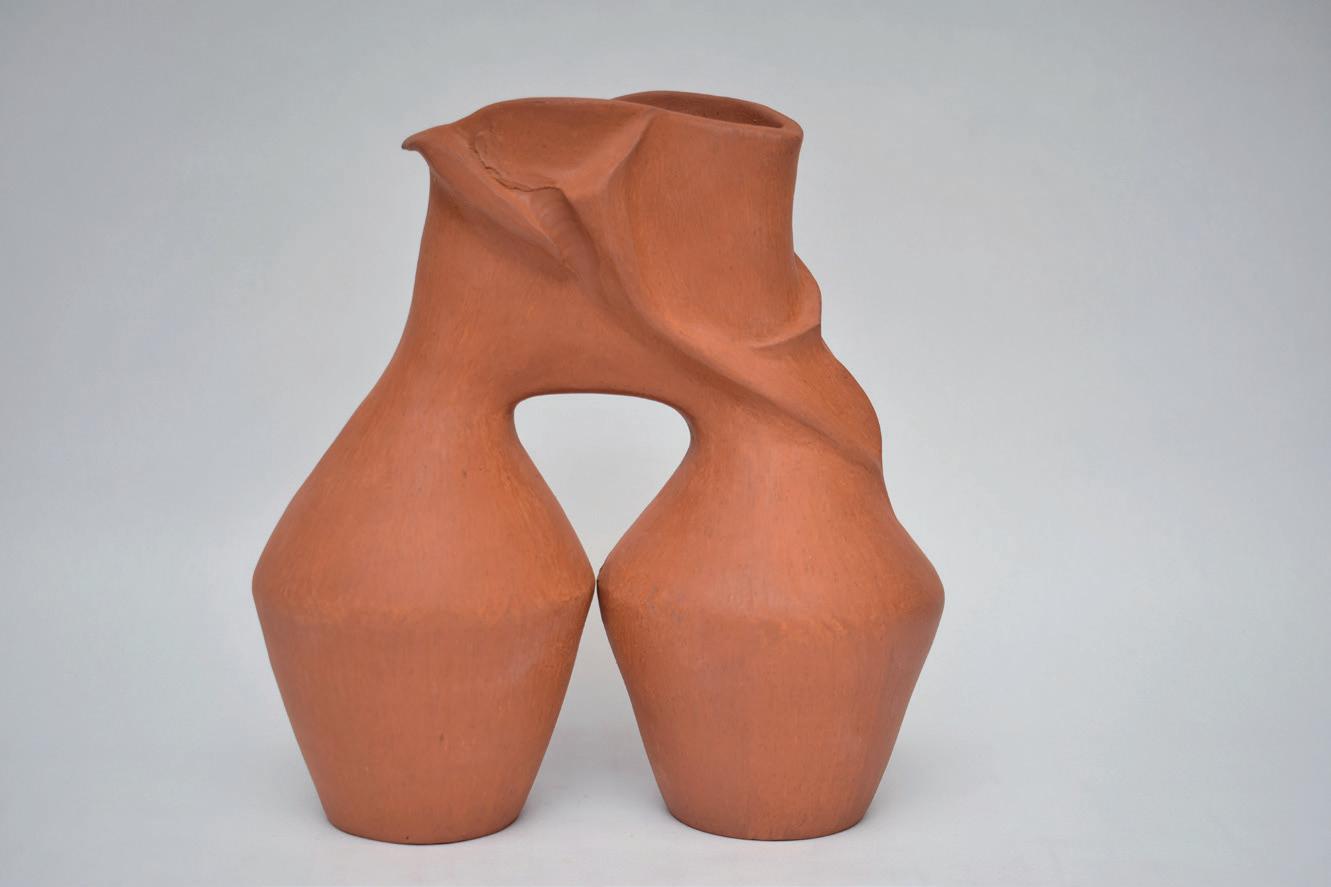
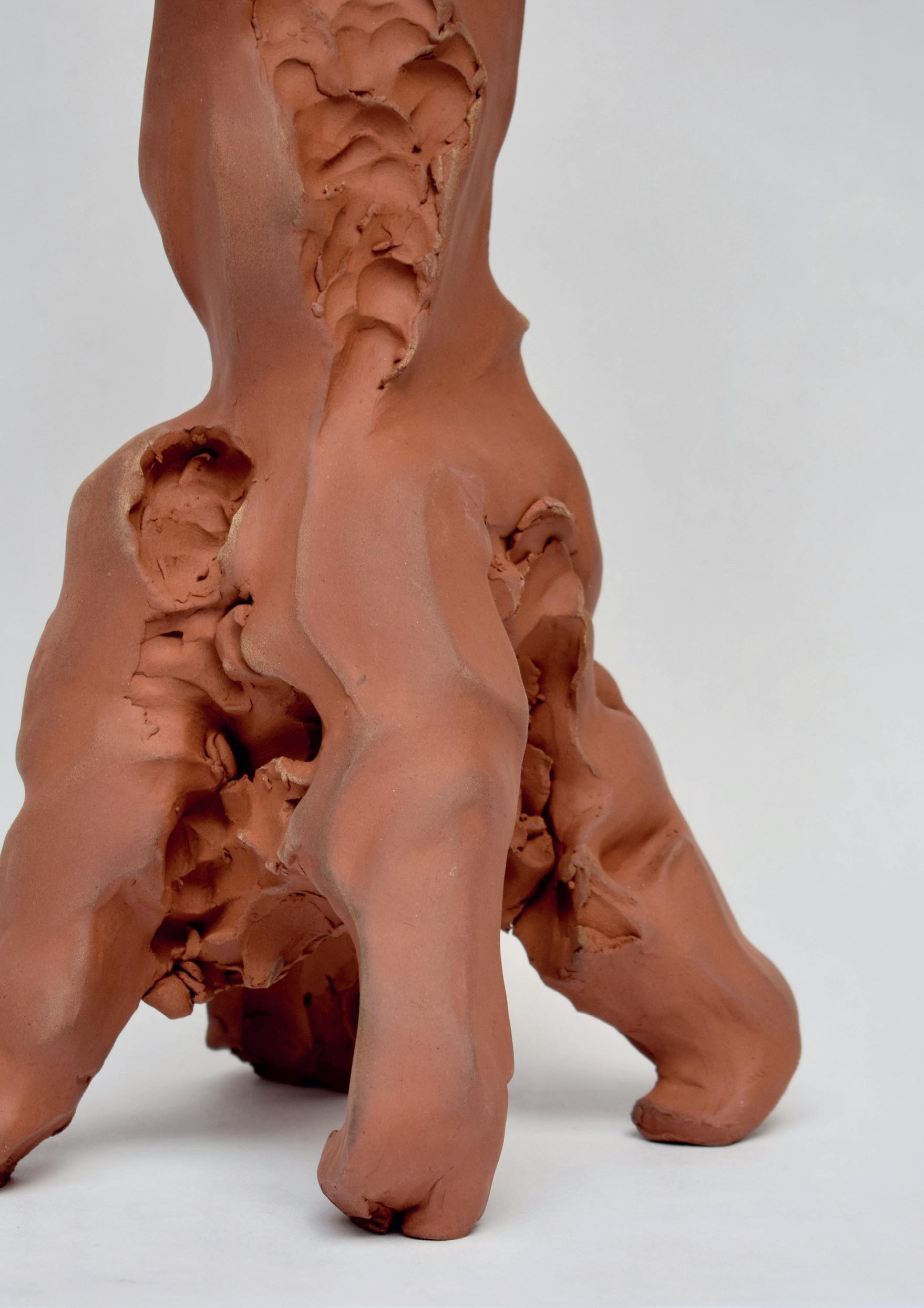
Dancing Goddess II
Terracotta
H 38.5 cm, w 20 cm, d 19 cm
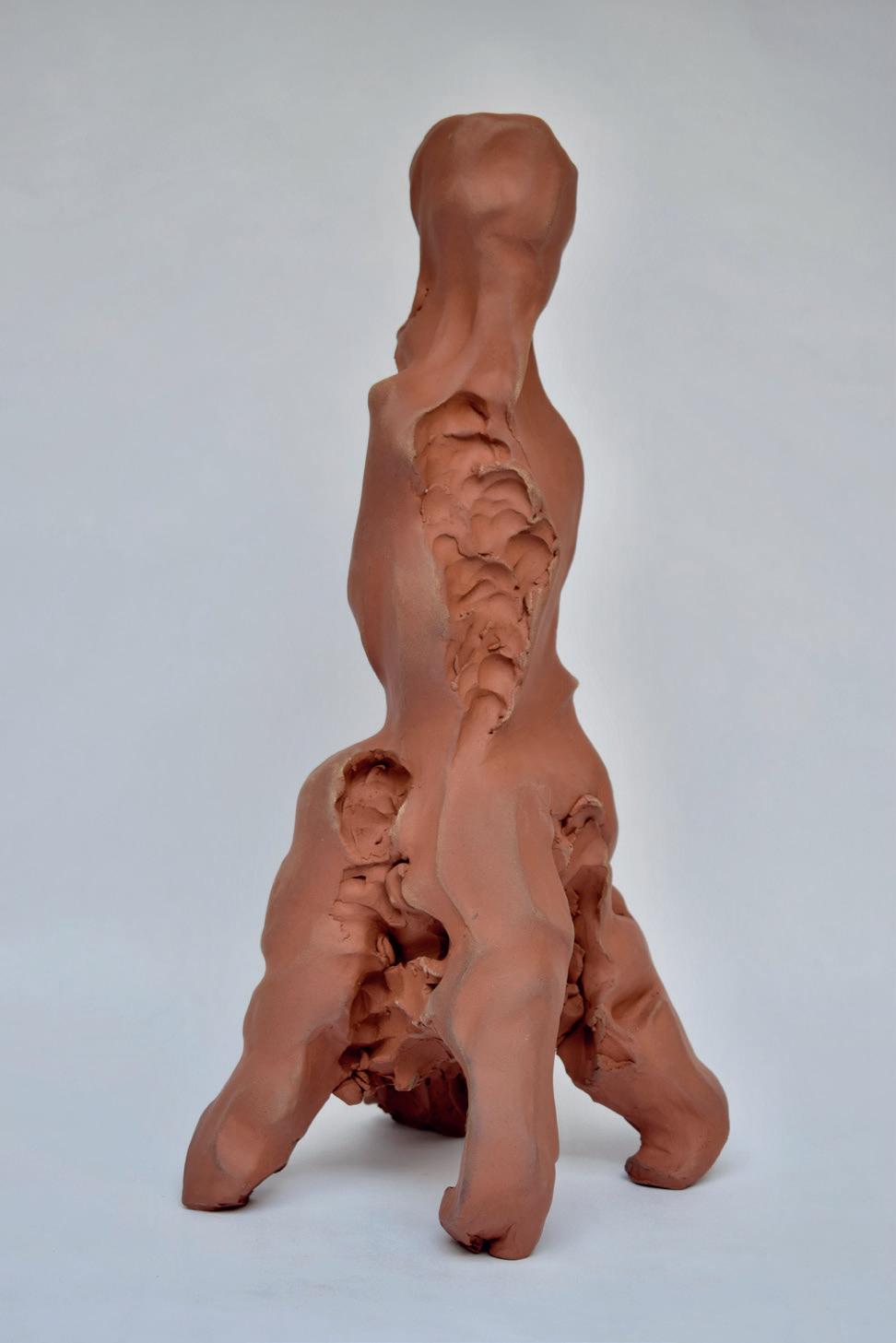
Ignis V
Wheel-thrown and coiled terracotta with plaster
H 26 cm, w 24 cm, d 12 cm
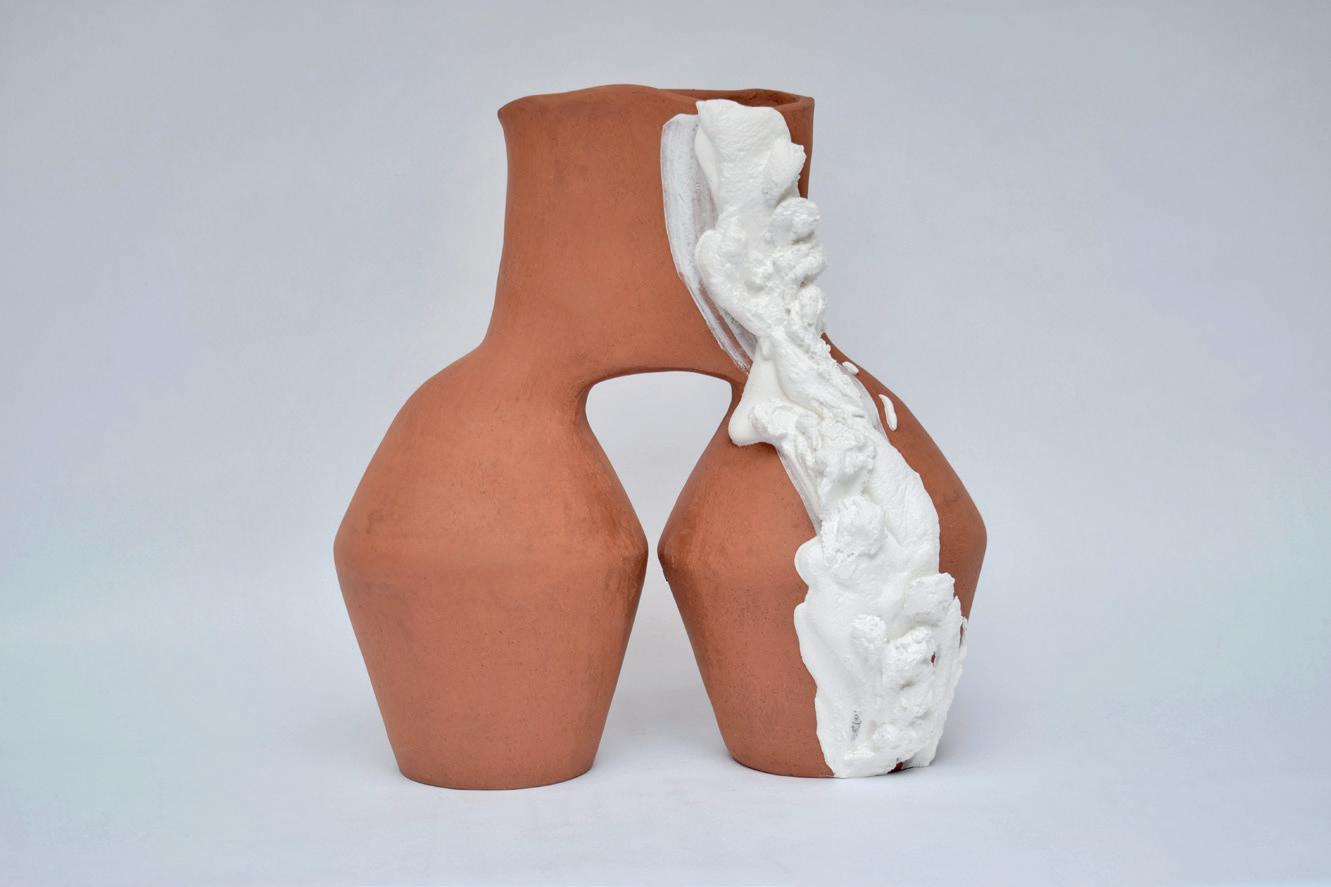
About the series Ignis: The materiality of the self :
We all carry a fire
It keeps us warm, it brightens our lives. Our inner child
Play, fun. No rules, no expectations. Creative, present.
All that I once sacrificed. Achieving, becoming, arriving ruled my life. Ignis is my pathway to a balanced existence.
Clay. The soil we stand on, we come from. It requires patience, steadiness, a slow pace. It needs care, attentiveness to be shaped, to prevent ruin. My adult, my parent.
Plaster, on the other hand, is the child. Spontaneous, quick. One minute liquid, the next hard like a stone. Be here or it is gone.
Bringing these two materials and the different qualities they have and foster together, has allowed me to be more me, to get closer to a sense of wholeness. Letting that fire burn, shine, while remaining grounded, nurtured. A balance resulting from the combination of materials I had once been told should not be combined. I transcended that conflict to find the joy and peace I had lacked.
Bisila Noha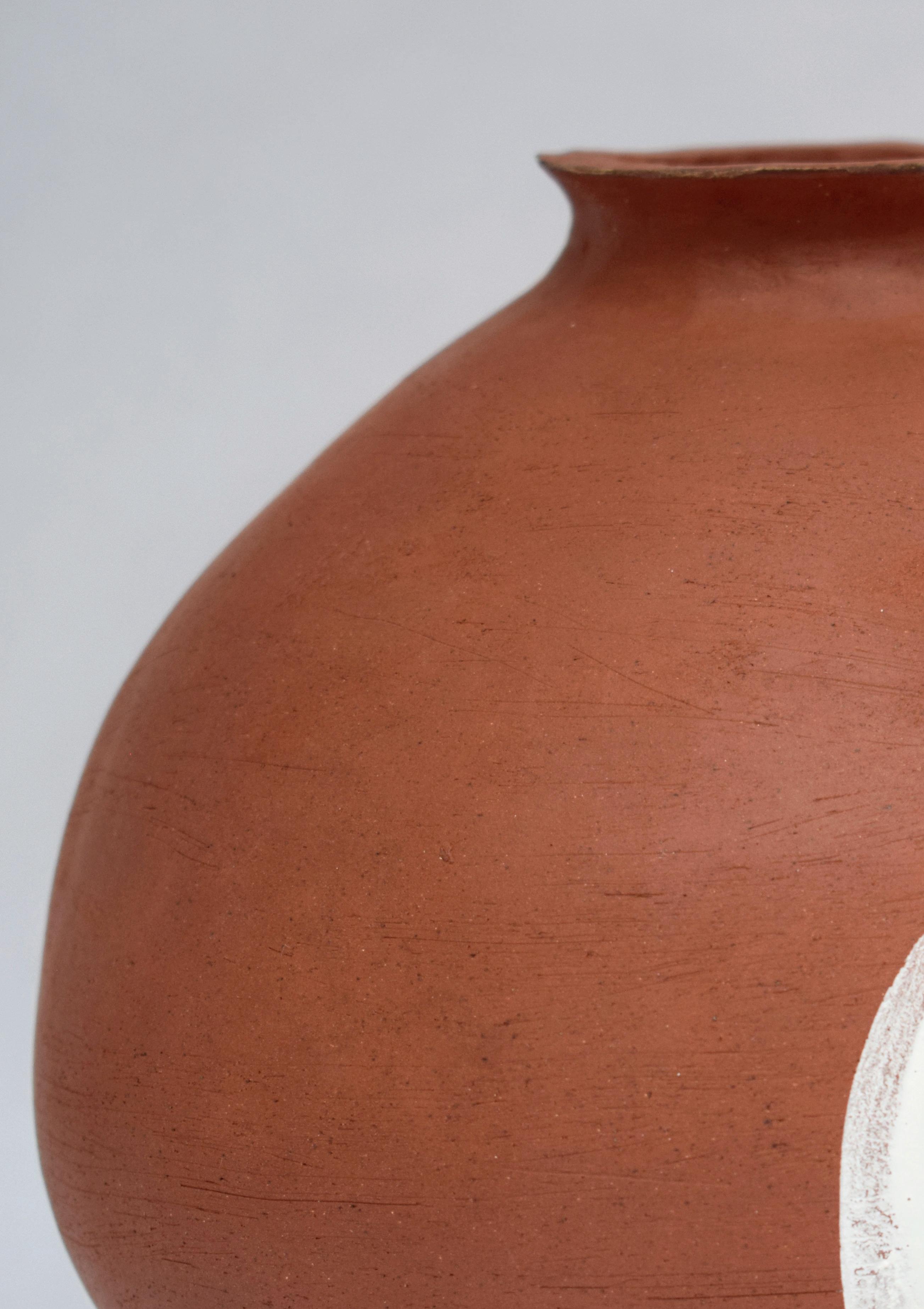
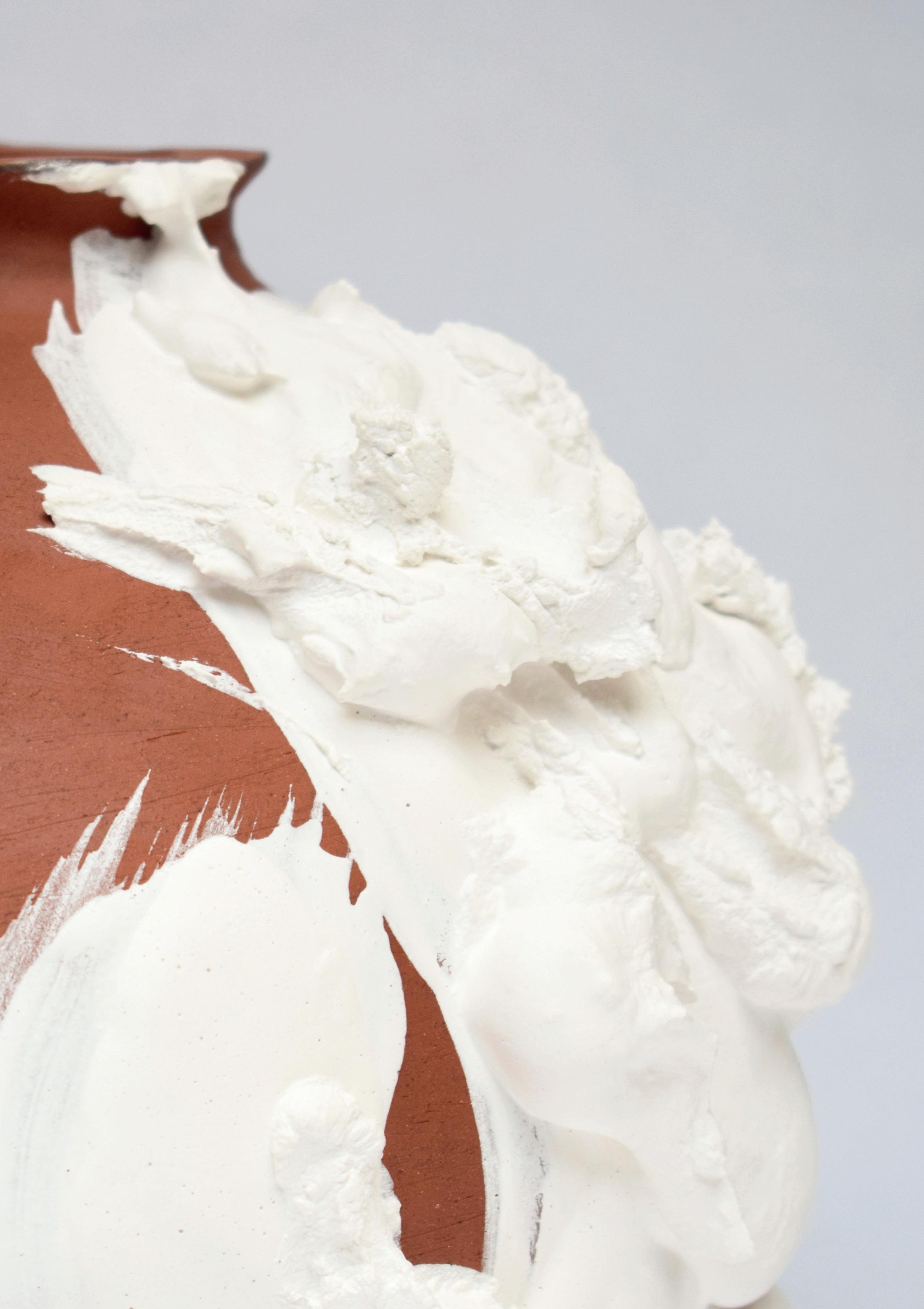
Ignis VII
Wheel-thrown and coiled terracotta with plaster
H 20 cm, ø 20 cm
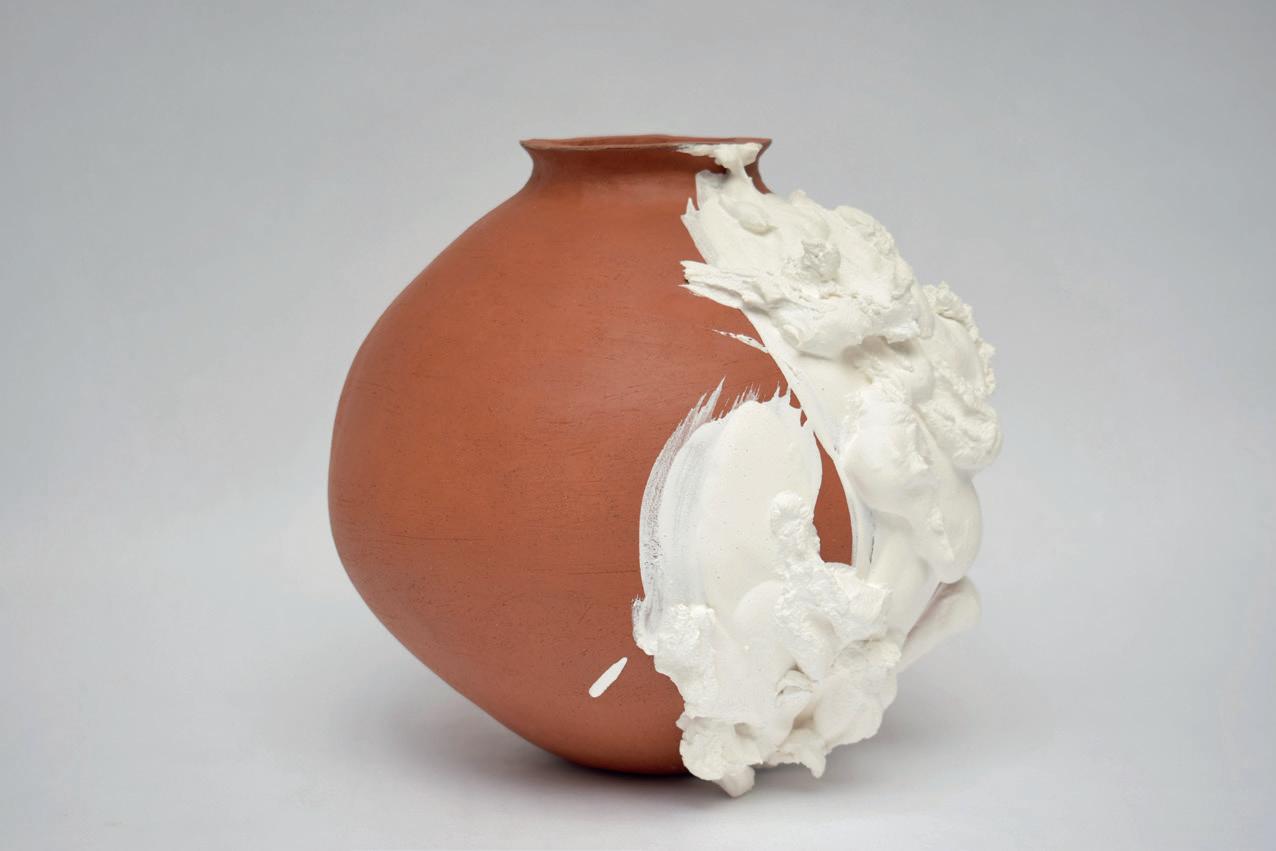
Ignis VIII
Wheel-thrown and coiled terracotta with plaster
H 41 cm, ø 25 cm
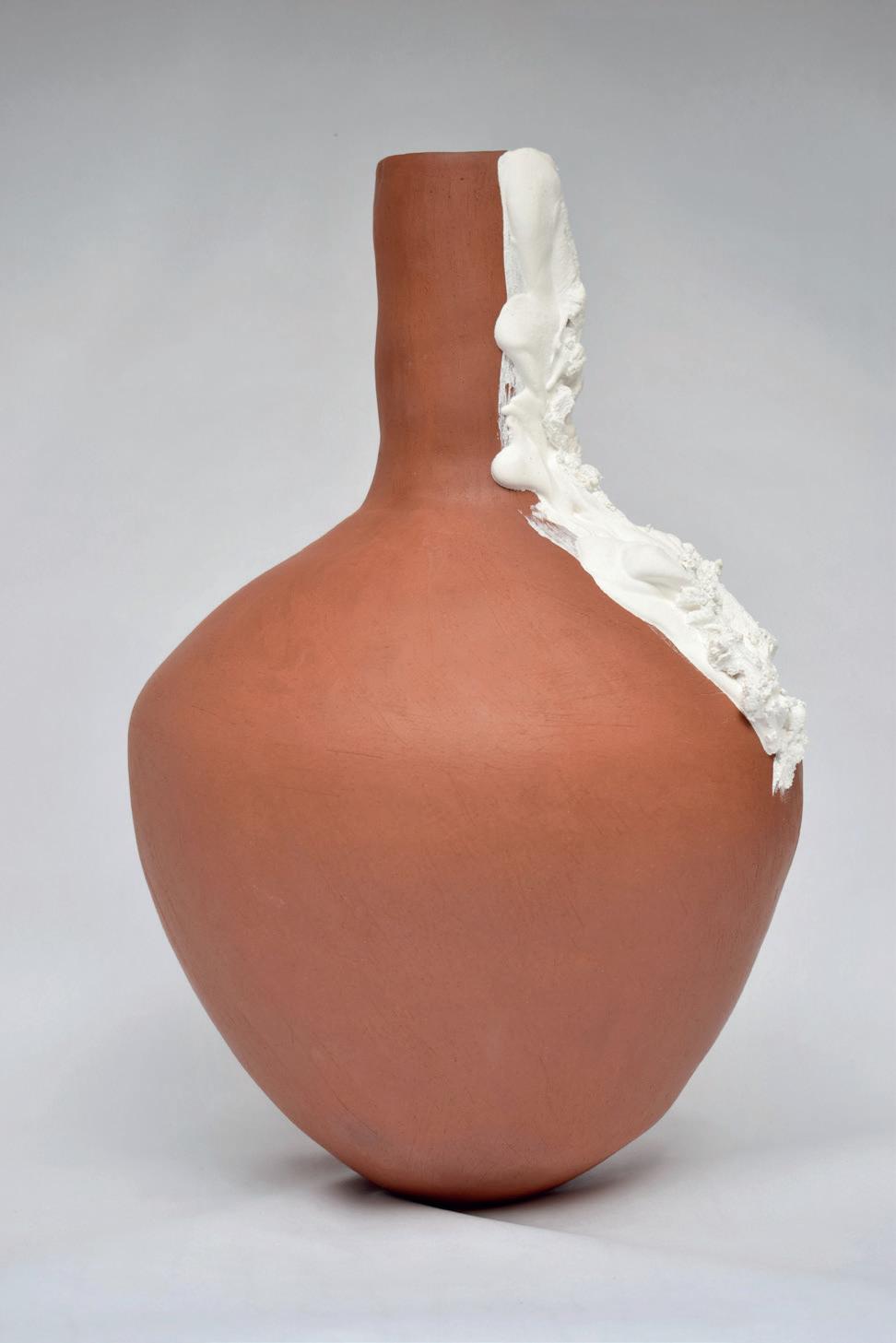
Karine Hilaire
‘I have always been inspired by a mix of cultural influences, especially by textiles and crafts from Africa, Latin America and Asia where I used to develop collections for fashion designers.’
‘This specific collection was inspired from a silver bangle, ellipse shaped on the outside and round on the inside, that my grandmother found while living in Central America. In Indian culture, bangles are not just ornaments; they symbolize femininity, health and prosperity. Hoops as a circle represent strength, unity, infinity and wholeness.’
‘In this collection, many of the hoops can be interchanged or positioned in different places, and in different orders to create interactions between the forms and motifs. Taking them apart and hanging them in a different way provides a tactile experience as well as a decorative and creative liberty.’
Karine Hilaire was born in the rocky back country of the Ardèche region in France and her craft was informed by its jagged contrasting landscapes.
Her love for textures, prints and colour brought her to Paris where she began a career in fashion developing collections for designers. She later completed an artisan degree and co-founded a ceramics studio.
Karine moved to London in 2015 to find a vibrant community of inspiring makers and now works from a studio in Kentish Town.
Her inspirations come primarily from crafts like basketry, batik and ikat textiles inspired from trips to India, Mexico and Asia. She enjoys combining all these influences to create boldly patterned pieces seeking to find a space between functionality and sculpture.
Image: Zebra Elephant Ear Vessel
All photographs for Karine Hilaire by Michael Harvey
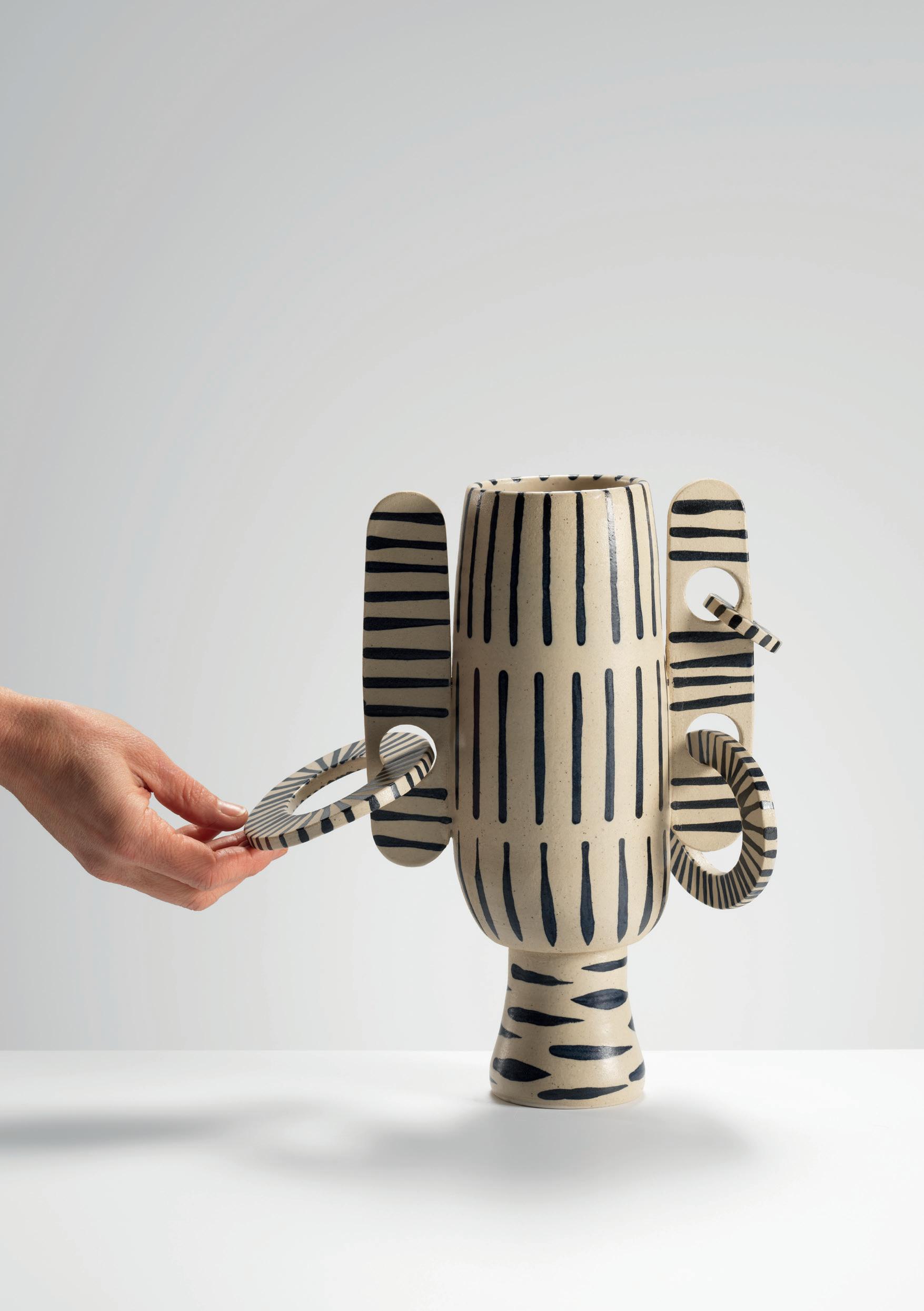
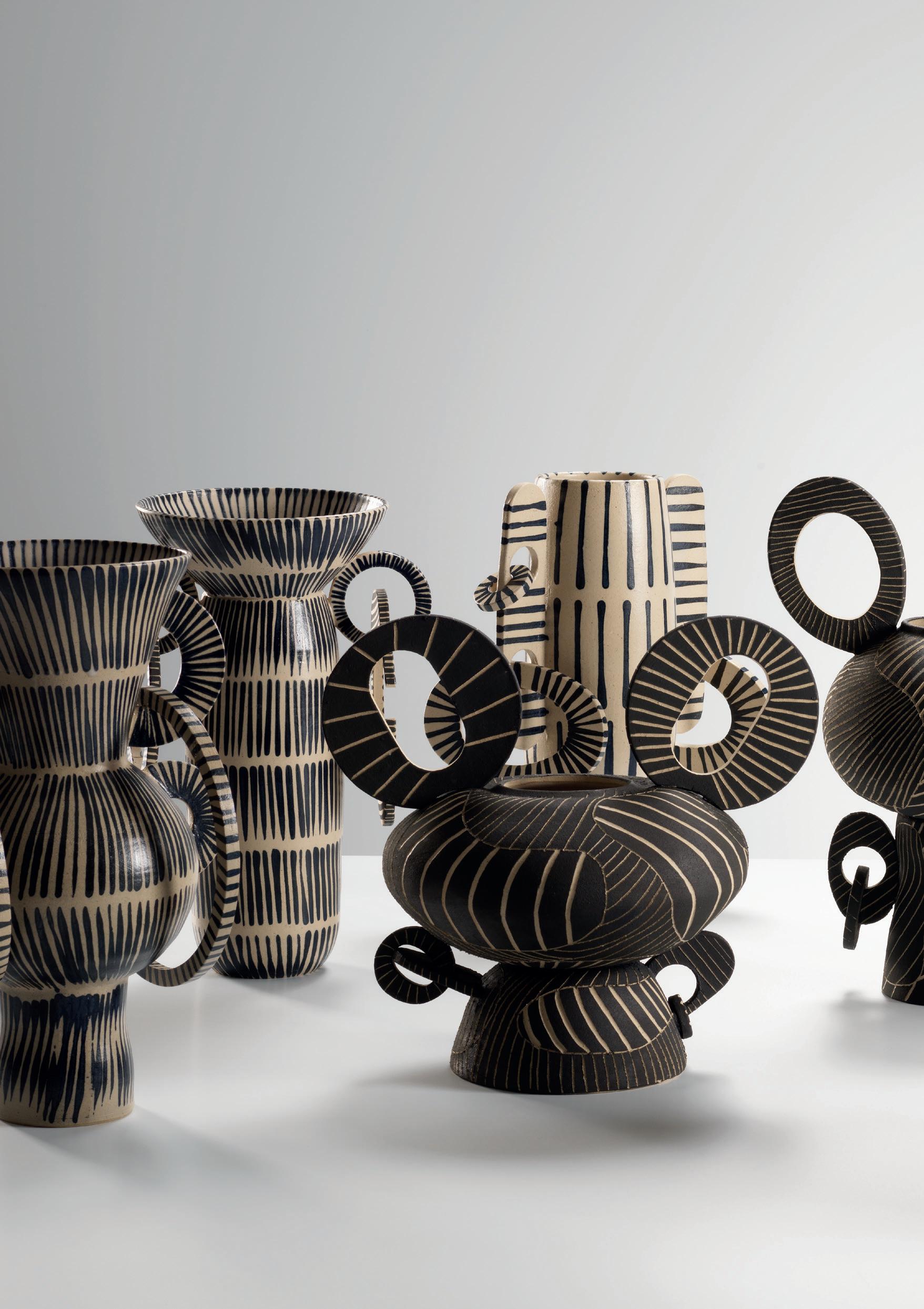
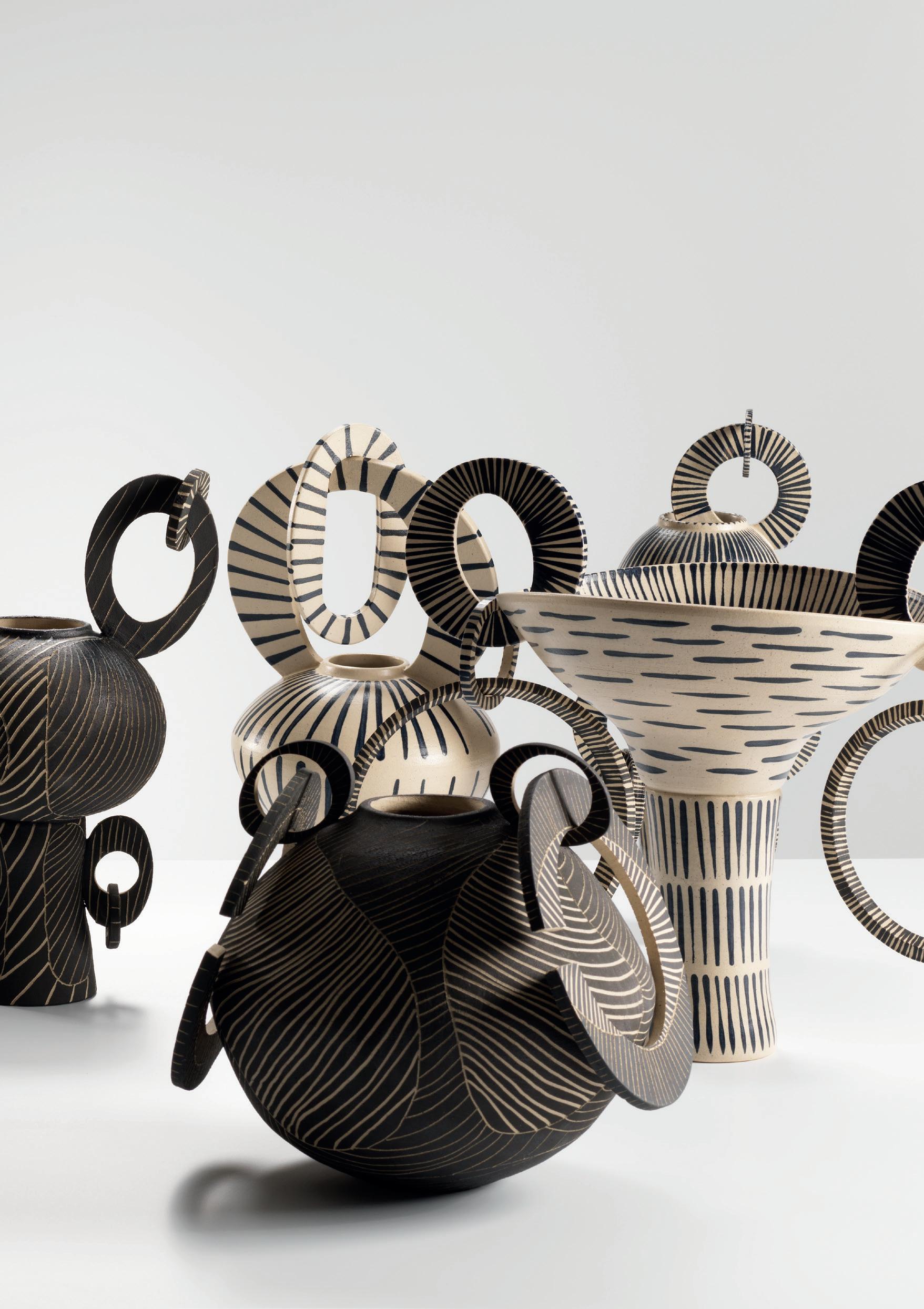
Zebra Cylinder Vessel with Oval Hoops
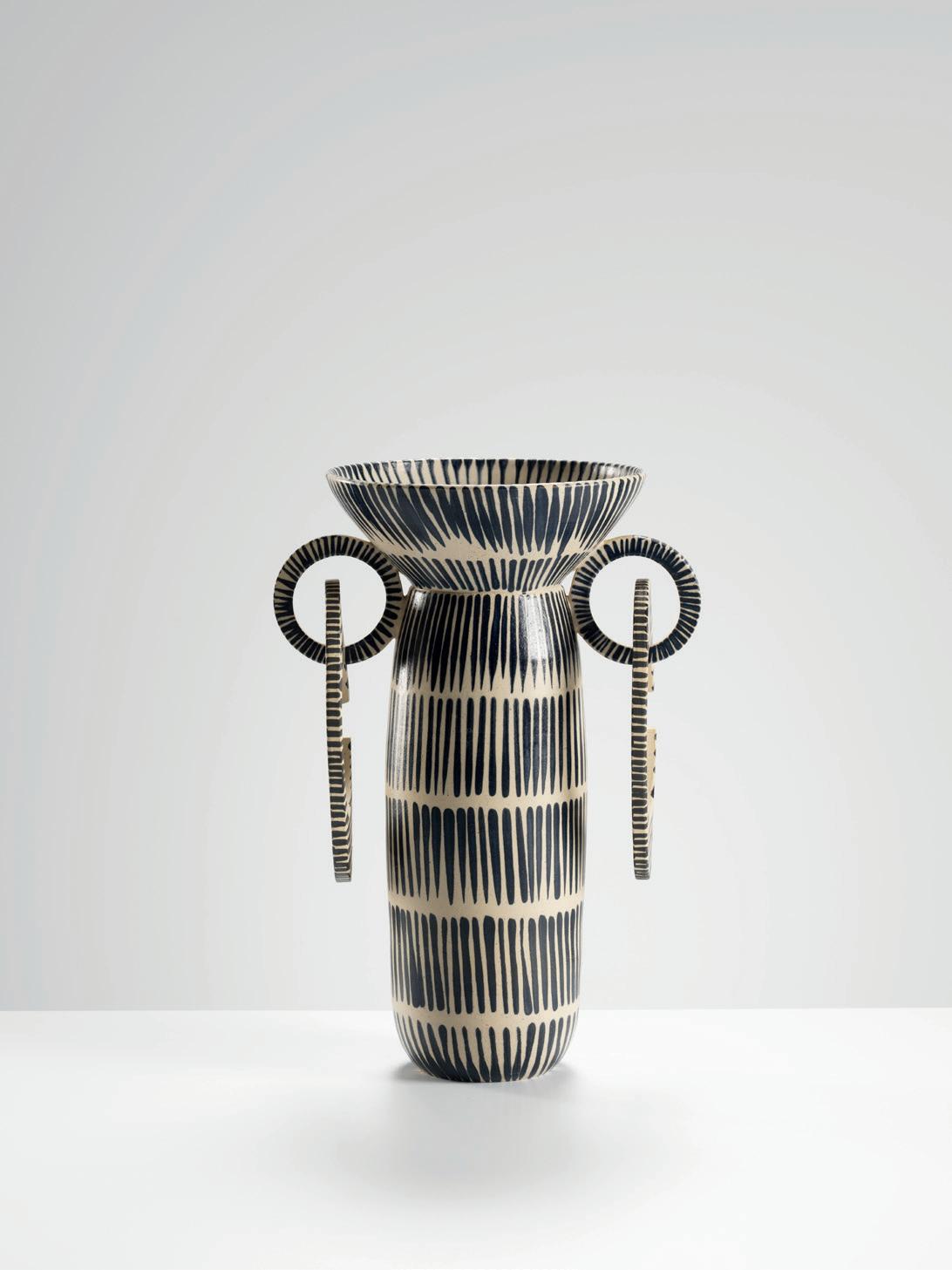
White fleck stoneware with hand painted pattern and transparent matte glaze
H 31 cm, w 21 cm, d 12 cm
Zebra Composed Vessel with Double Handles and Hoops
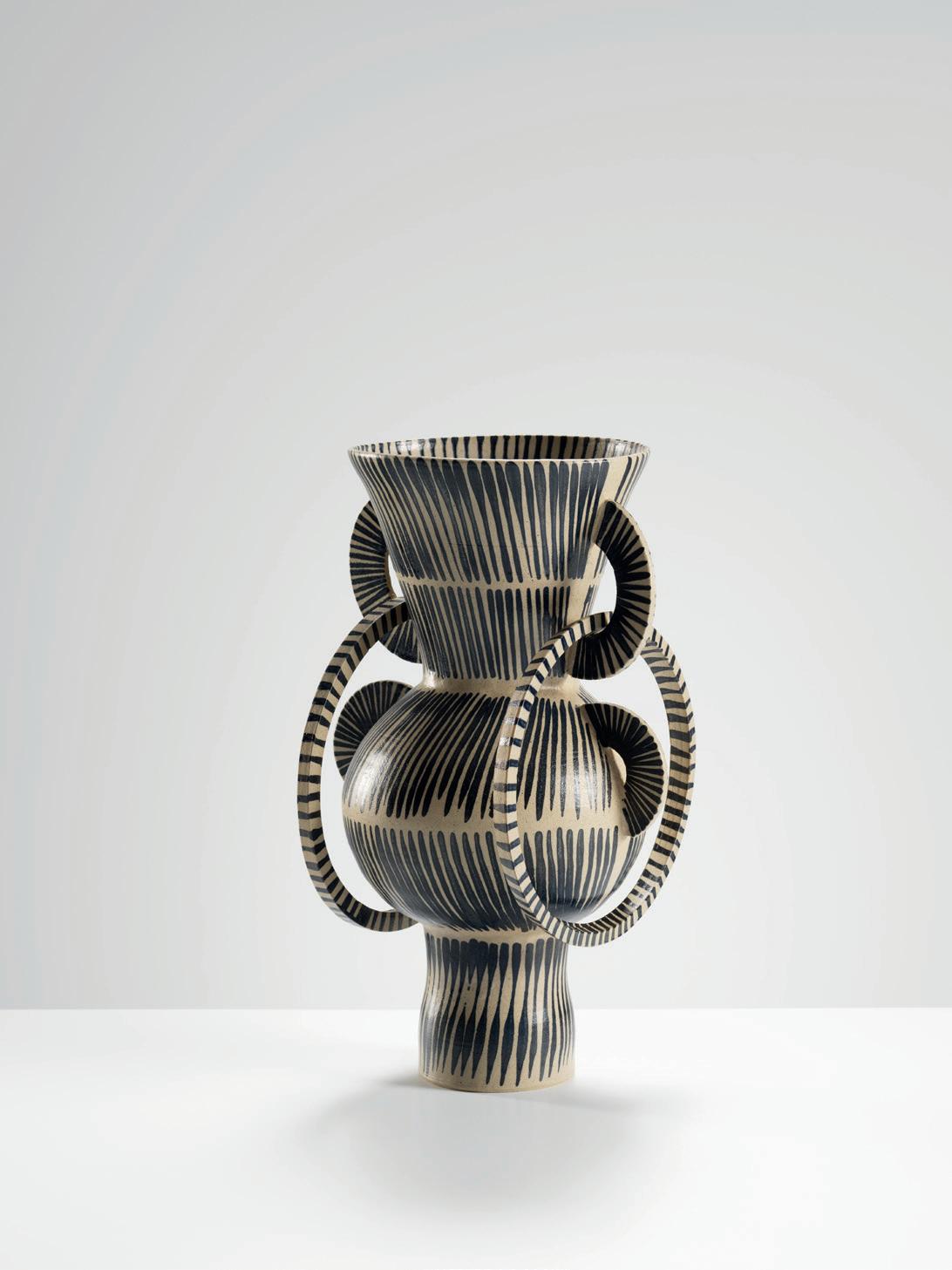
White fleck stoneware with sgraffito pattern
and transparent matte glaze on interior
H 32 cm, w 18.5 cm, d 17 cm
Zebra Vessel with Maxi Hoops
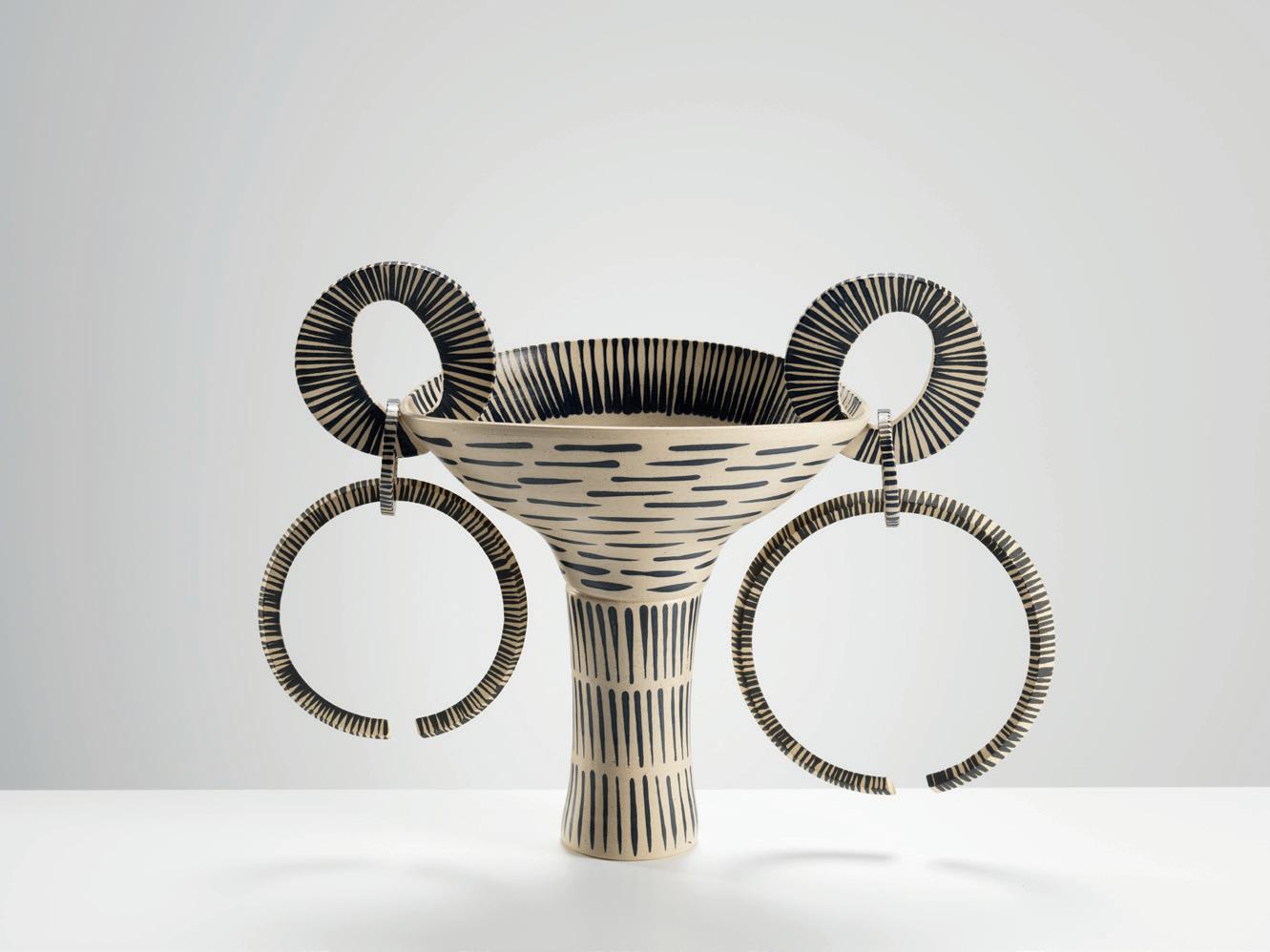
White fleck stoneware with sgraffito pattern
and transparent matte glaze on interior
H 36 cm, w 46 cm, d 24.5 cm
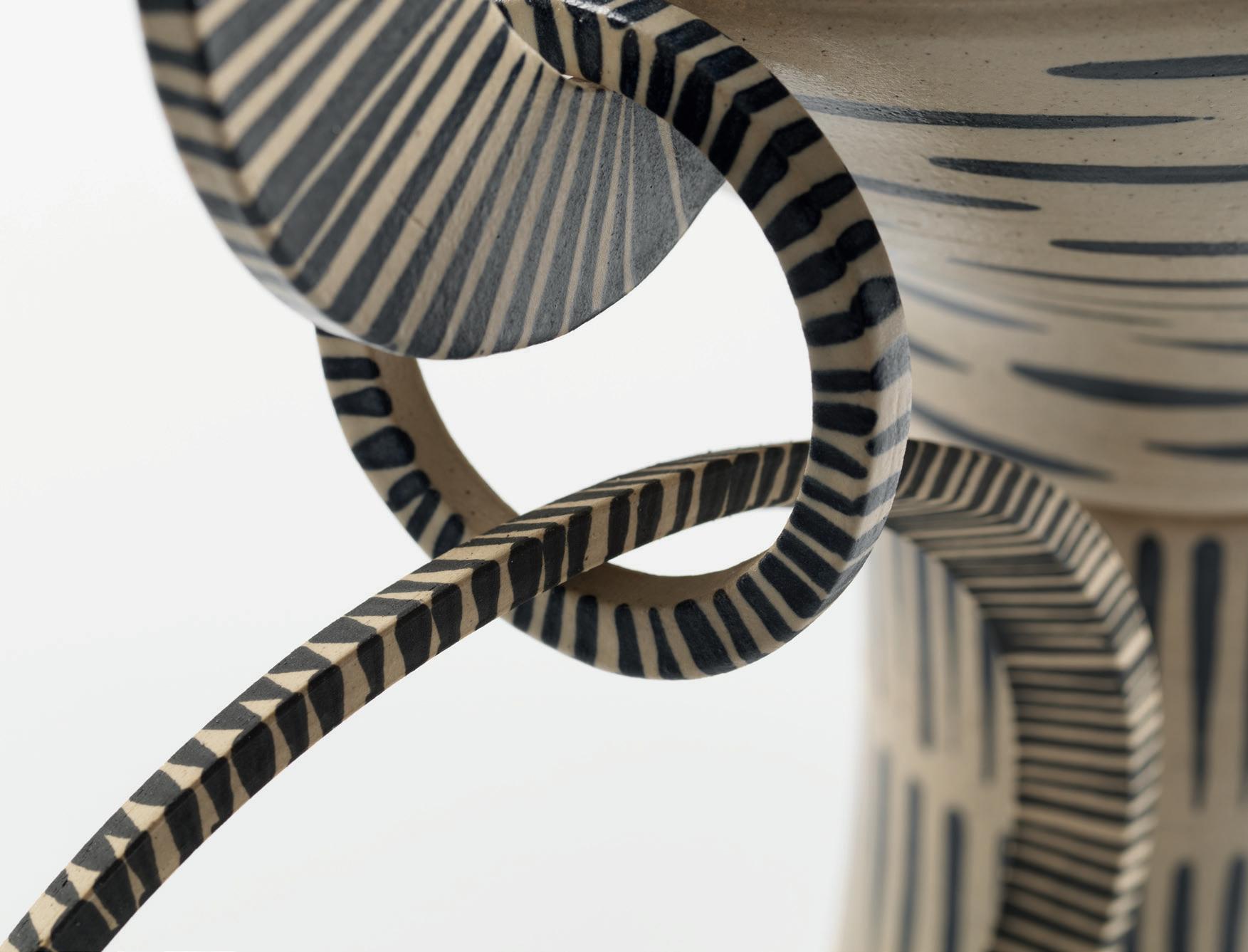
Zebra Elephant Ear Vessel
White fleck stoneware with hand painted pattern and transparent matte glaze
H 30.5 cm, w 19 cm, d 15 cm
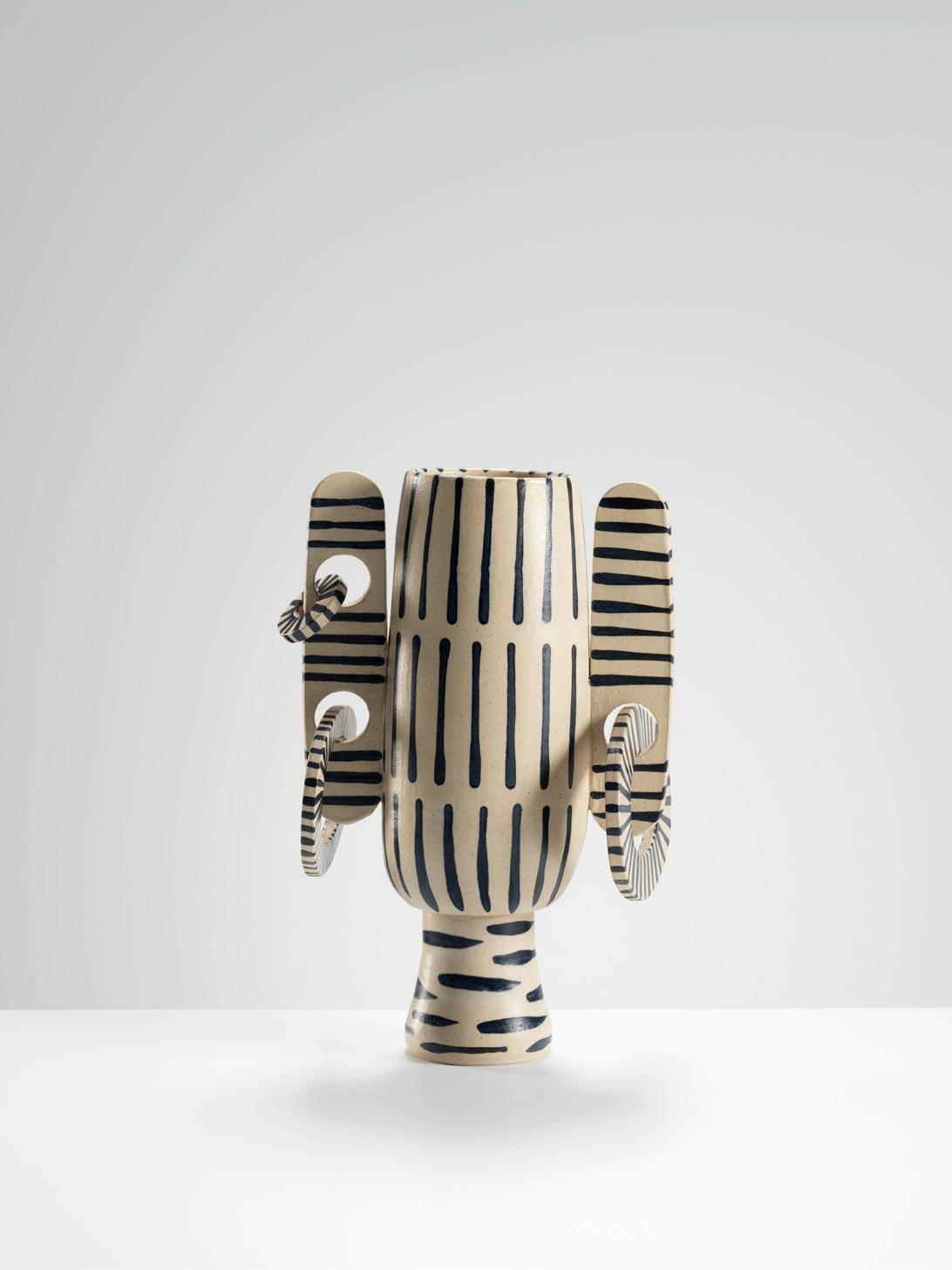
Zebra Kettle Vessel
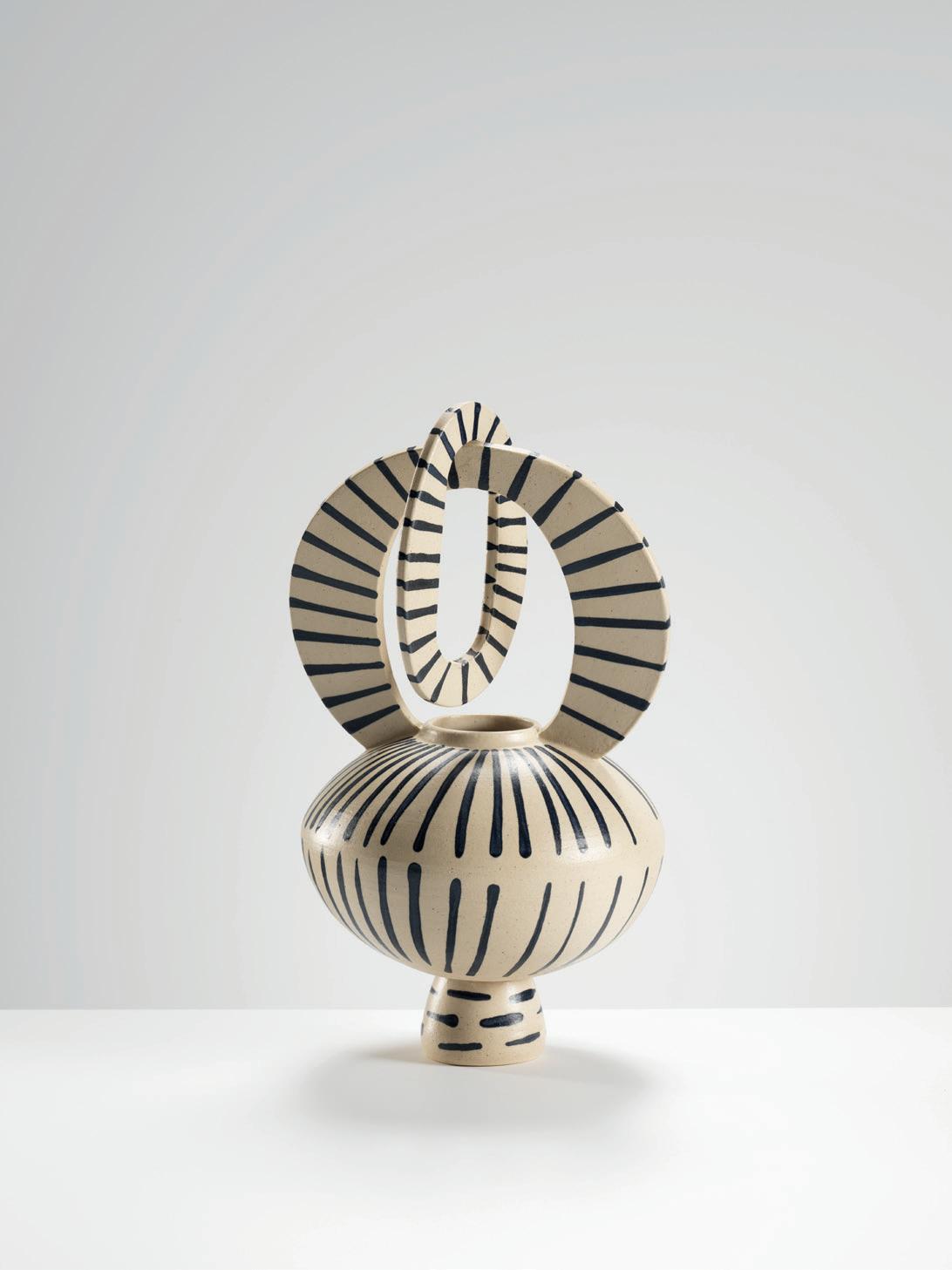
White fleck stoneware with hand painted pattern and transparent matte glaze
H 35 cm, w 19 cm, d 19 cm
Zebra Composed Vessel with Moon Hoop
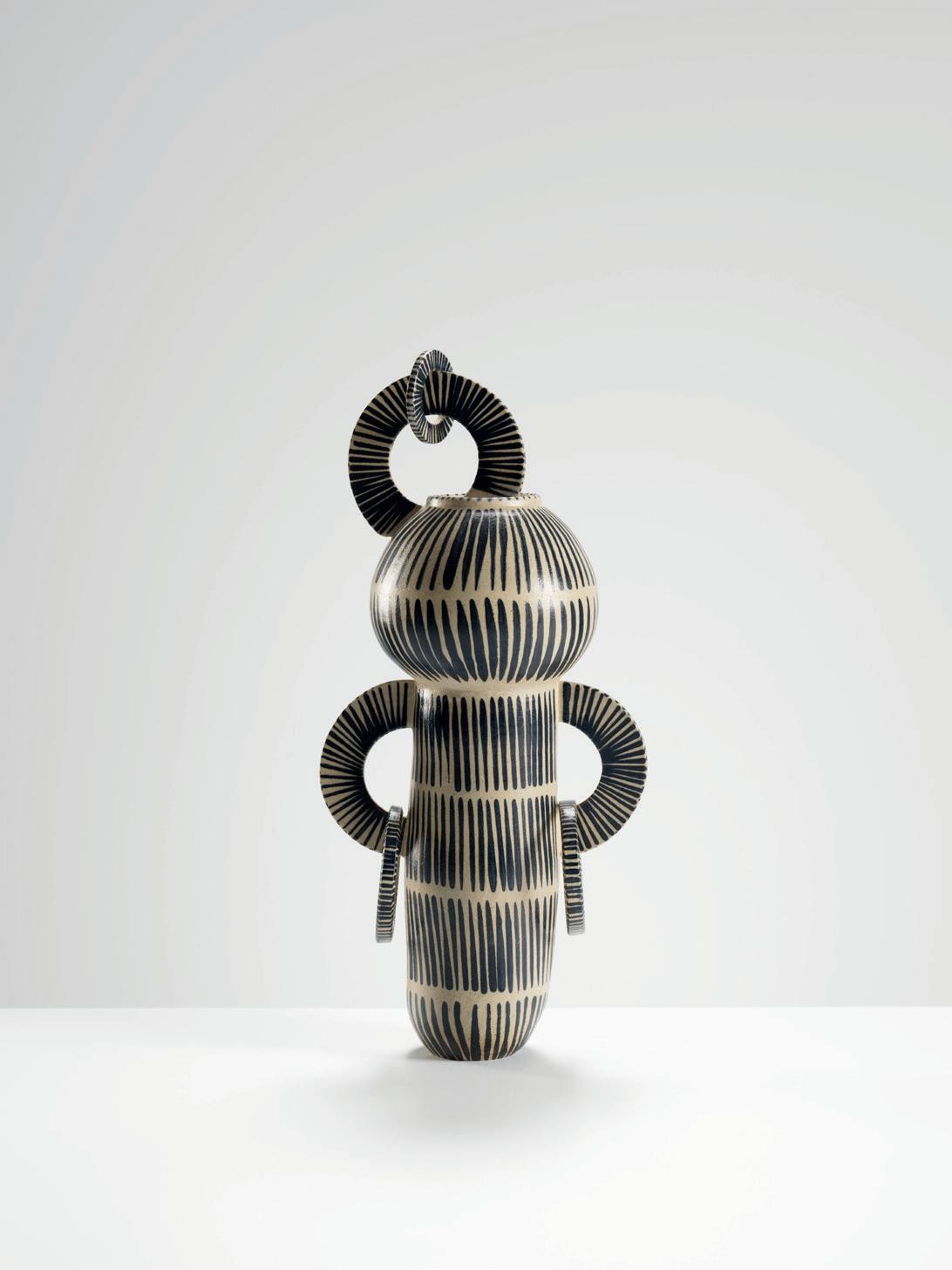
White fleck stoneware with hand painted pattern and transparent matte glaze
H 36 cm, w 16.5 cm, d 12 cm
Ebony Sgraffito Dog Ear Vessel
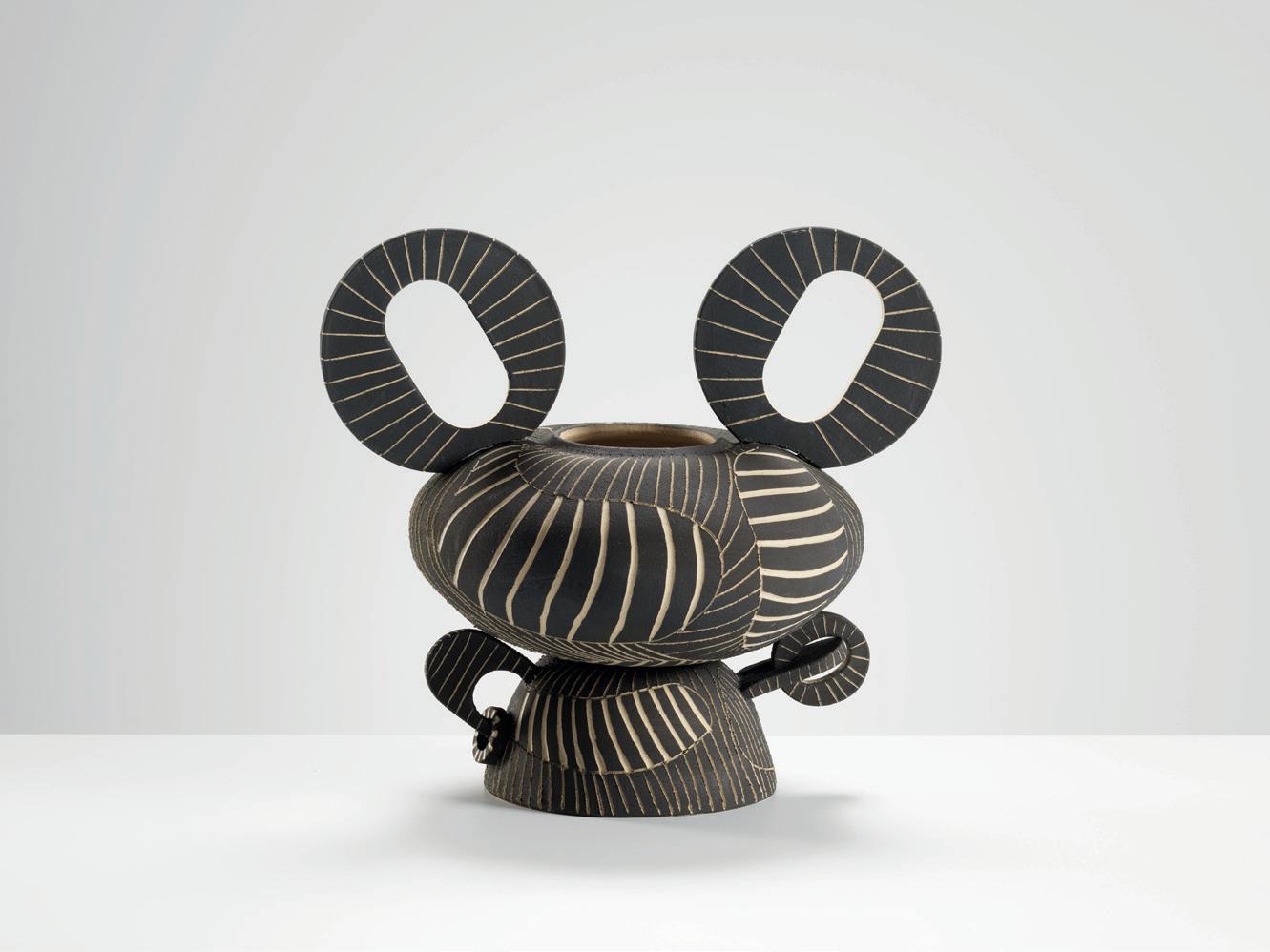
White fleck stoneware, sgraffito pattern, transparent matte glaze on interior
H 28 cm, w 29 cm, d 21 cm
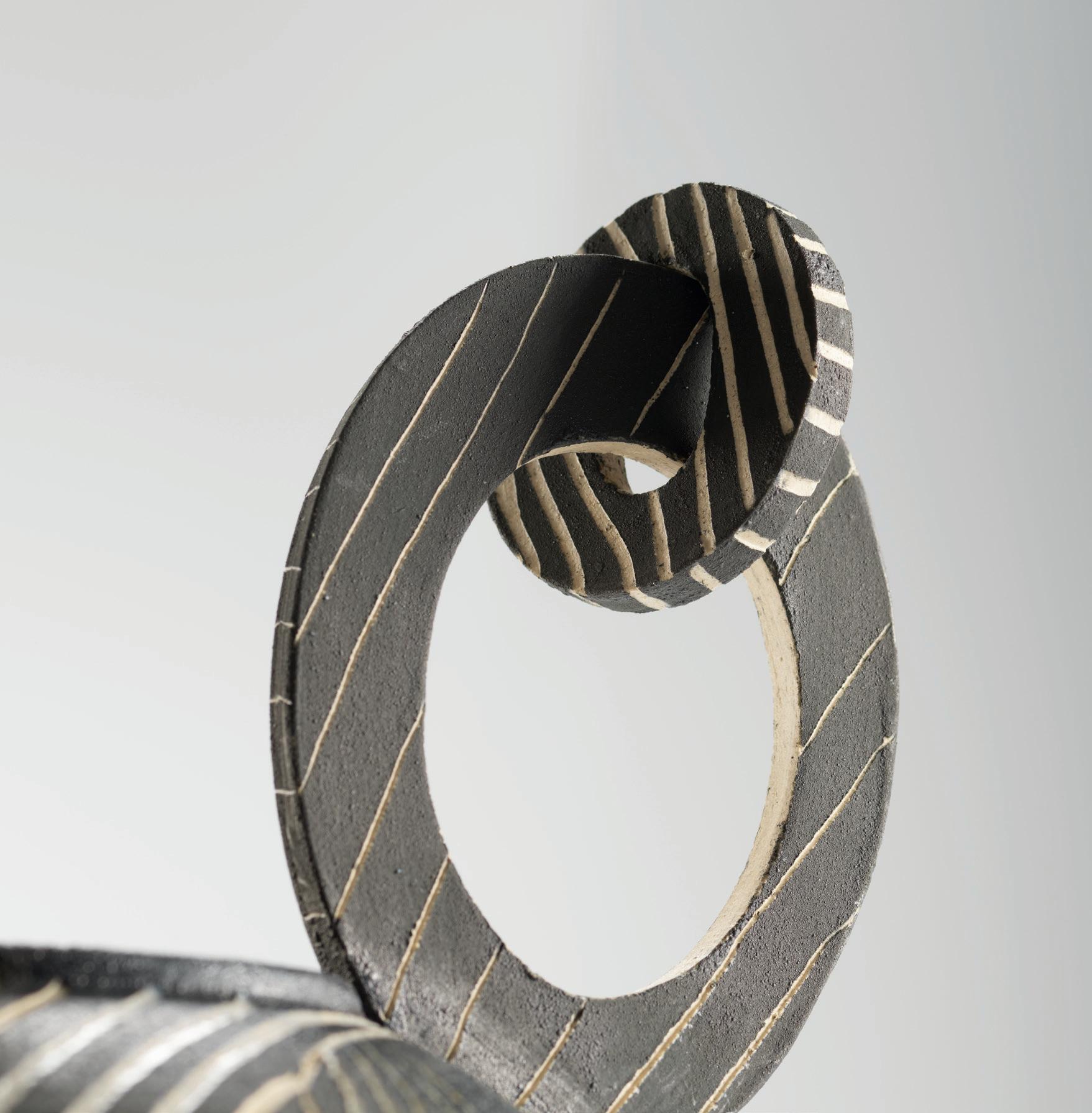
Ebony Sgraffito Rabbit Ear Vessel
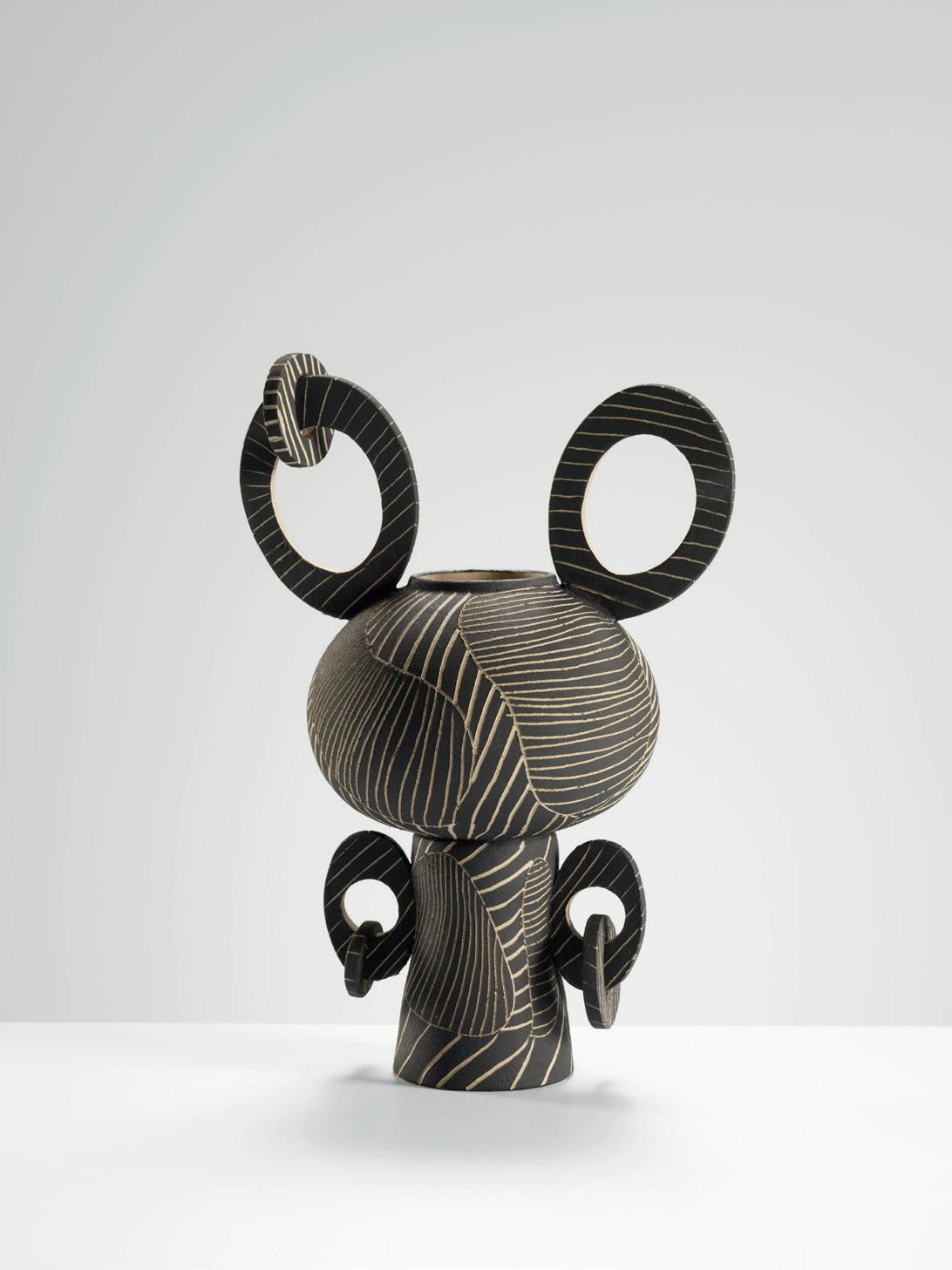
White fleck stoneware, sgraffito pattern, transparent matte glaze on the interior
H 34 cm, w 23.5 cm, d 16 cm
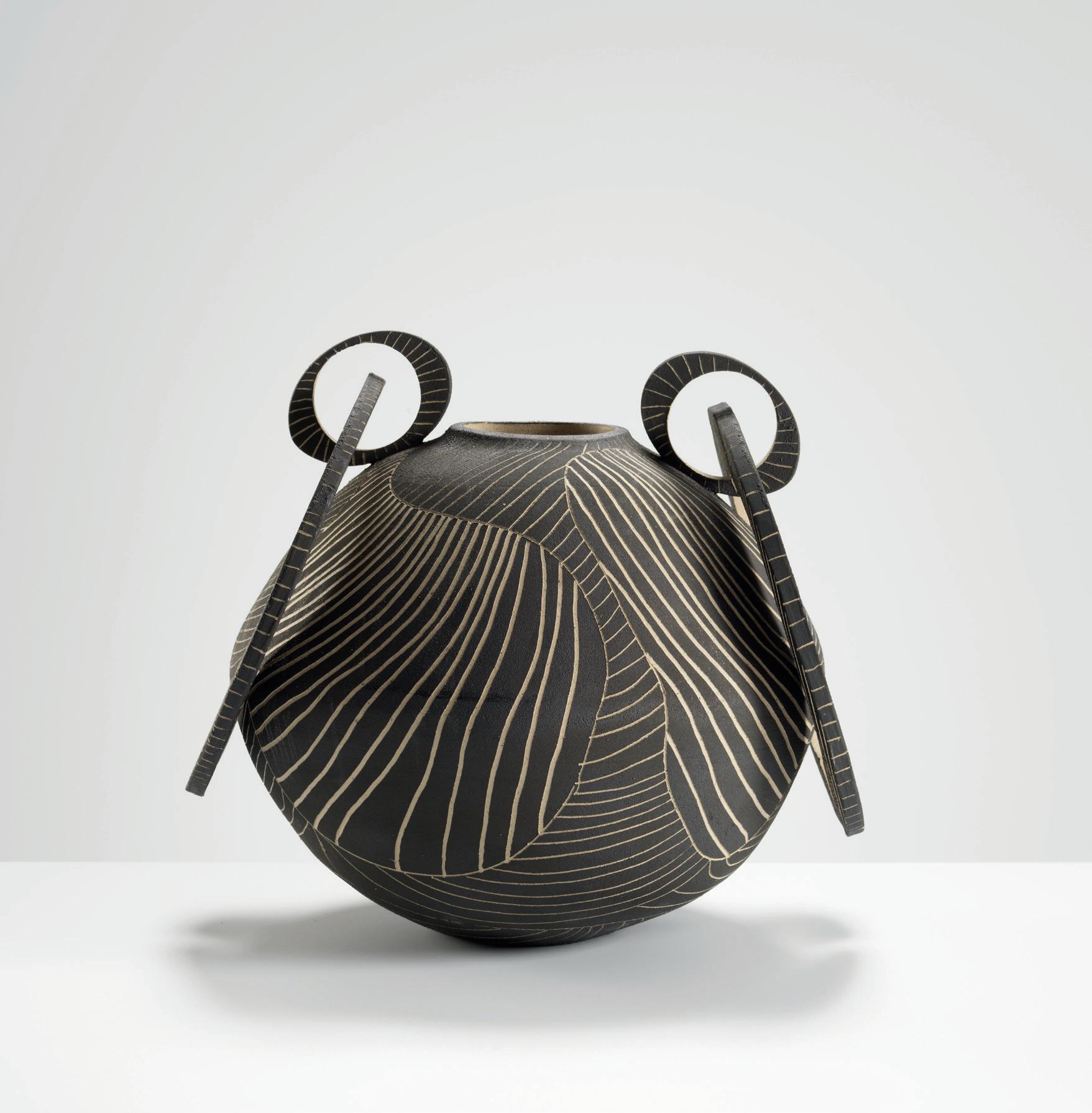
Ebony Sgraffito Moon Vessel with Large Hoops
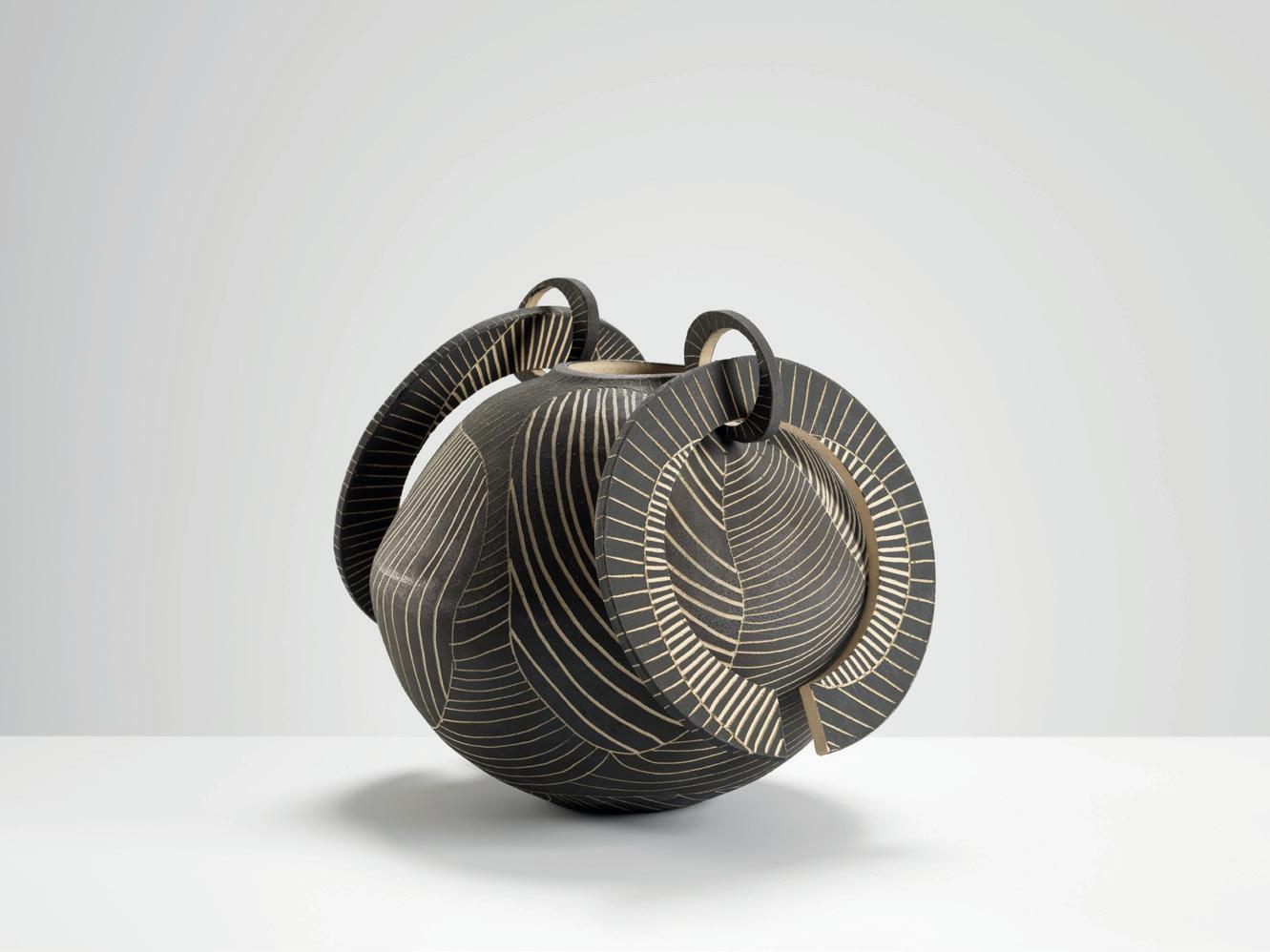
White fleck stoneware, sgraffito pattern, transparent matte glaze on interior
H 21 cm, w 24 cm, d 24 cm
Nina Gerada
Nina Gerada was raised in a land of limestone, dust and roots. At the onset of adulthood she moved to a country of humus and clay. From an early age she had a rigorous and traditional technical training, but for all her artistic life she has been drawn to pattern finding and collage. Ceramic lends itself to neither.
Gerada’s work remembers archeological digs, maps, empty swimming, the female form, bricks, blueprints, typesetting blocks, the home, the temple. Her process begins by carving and tearing the clay, exposing fault lines, adding insertions. These broad actions are combined with bold but intricately tooled forms that skirt close to figurative imaginings of the megalithic temples of her homeland.
Still unfired, Gerada slices her tightly evocative sculptures into smaller sections. The pieces are contemplatively recomposed, searching for patterns and connections across multiple scales. Spaces are uncovered, providing at once protection and a means of escape. Courtyards, rooms and tombs appear as reflections of women’s bodies, wombs, breasts and vulvas. Totemic symbols intertwining notions of women as life giving vessels, of mothering and the psychological theories of containment, the impulse to be embedded in the rock, and a yearning for community and connectedness.
Firing clay exacts irreversible molecular change - ceramics are the imposition of human agency on geological time. Honouring this; Gerada’s recent work is often intentionally cracked in the kiln, reminding us of weathered buildings and ageing skin. This stochastic movement makes connections between timescales: the artist and her life story; her audience and its prehistory.
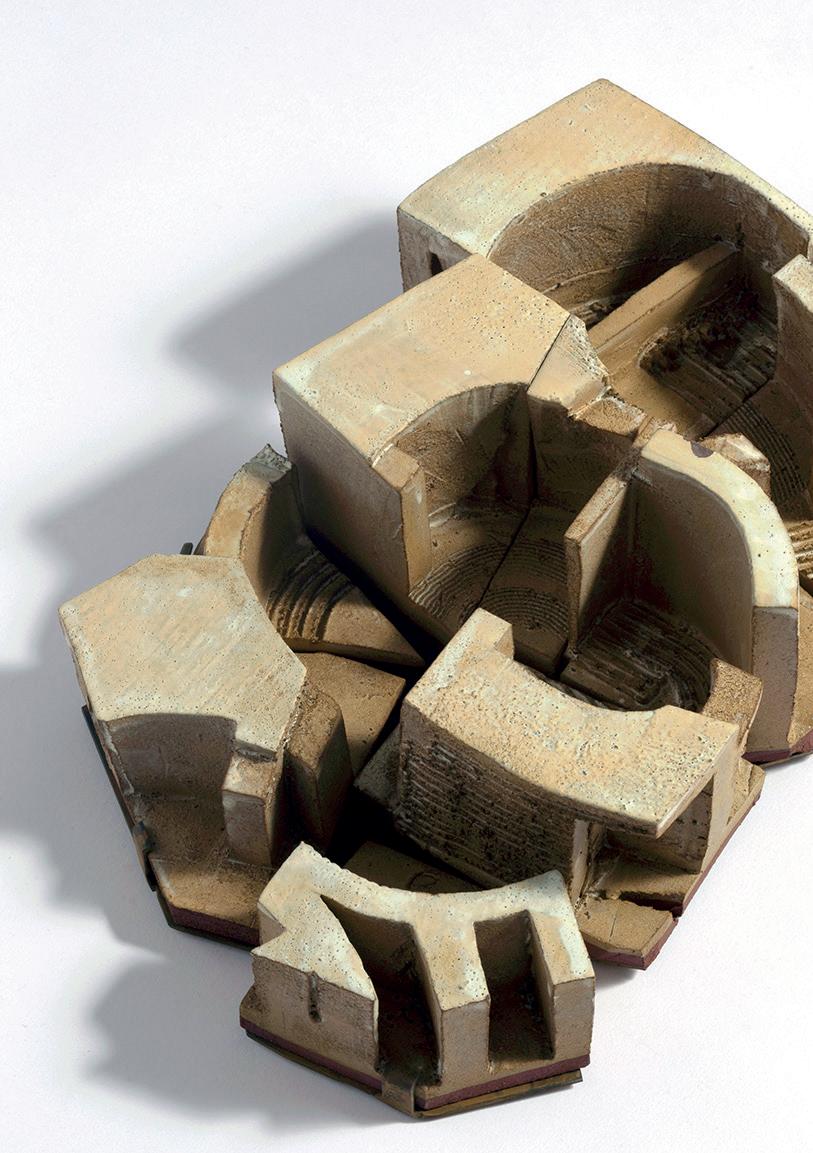
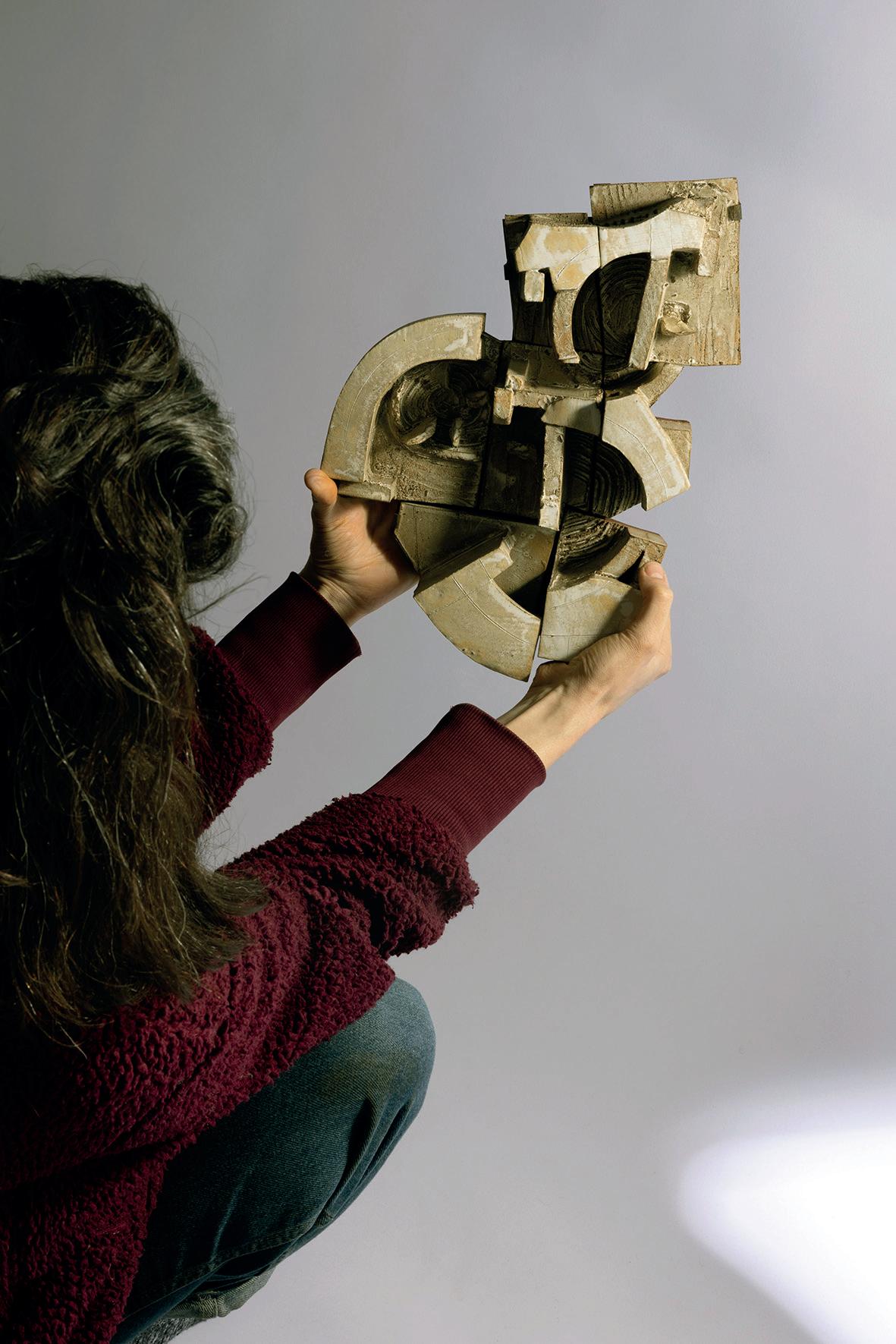
Nina Gerada is a Maltese artist, designer and teacher. She is a graduate of London Metropolitan University (2011), The Bartlett School of Architecture, UCL (2006), Chelsea College of Art (2003) and is a Higher Education Teaching Fellow (2018).
Her sculptures merge figurative and architectural motifs, exploring the interconnectedness between buildings, communities and people. References to the Neolithic statues, temples and artefacts of Malta appear in her work, exploring the female, immigrant and post-colonial experience. Her training in architecture and urban design are evident in the vast scales and spatial preoccupation of her work.
This is Gerada’s second year at Collect having exhibited with Thrown Contemporary in 2022. Amongst other exhibitions, Gerada has exhibited at London Craft Week (2021) and as part of The Daphne Festival (2022) commemorating the assassination of Maltese journalist Daphne Caruana Galizia. She has collaborated with The Bbook Project and exhibited at ‘Let’s Talk Breast’. Gerada is a member of Spilt Milk Gallery, a collective of artist mothers, and has participated in ‘Mater nochronics’ (2021) and ‘Cartography of Care’ (2022) both exploring themes of parenting and care through art.
Her ‘Nollini’ sculptures were featured in Wired Magazine (2021). In her work as a Production Designer on the feature film ‘Simshar’, Gerada won the Best Production Design Award at the Bridges International Film Festival (2014). She is currently collaborating with Caz Hildebrand and a brick works to develop large public sculptures.
Gold 1
Ceramic and steel
H 37 cm, w 28 cm, d 7 cm
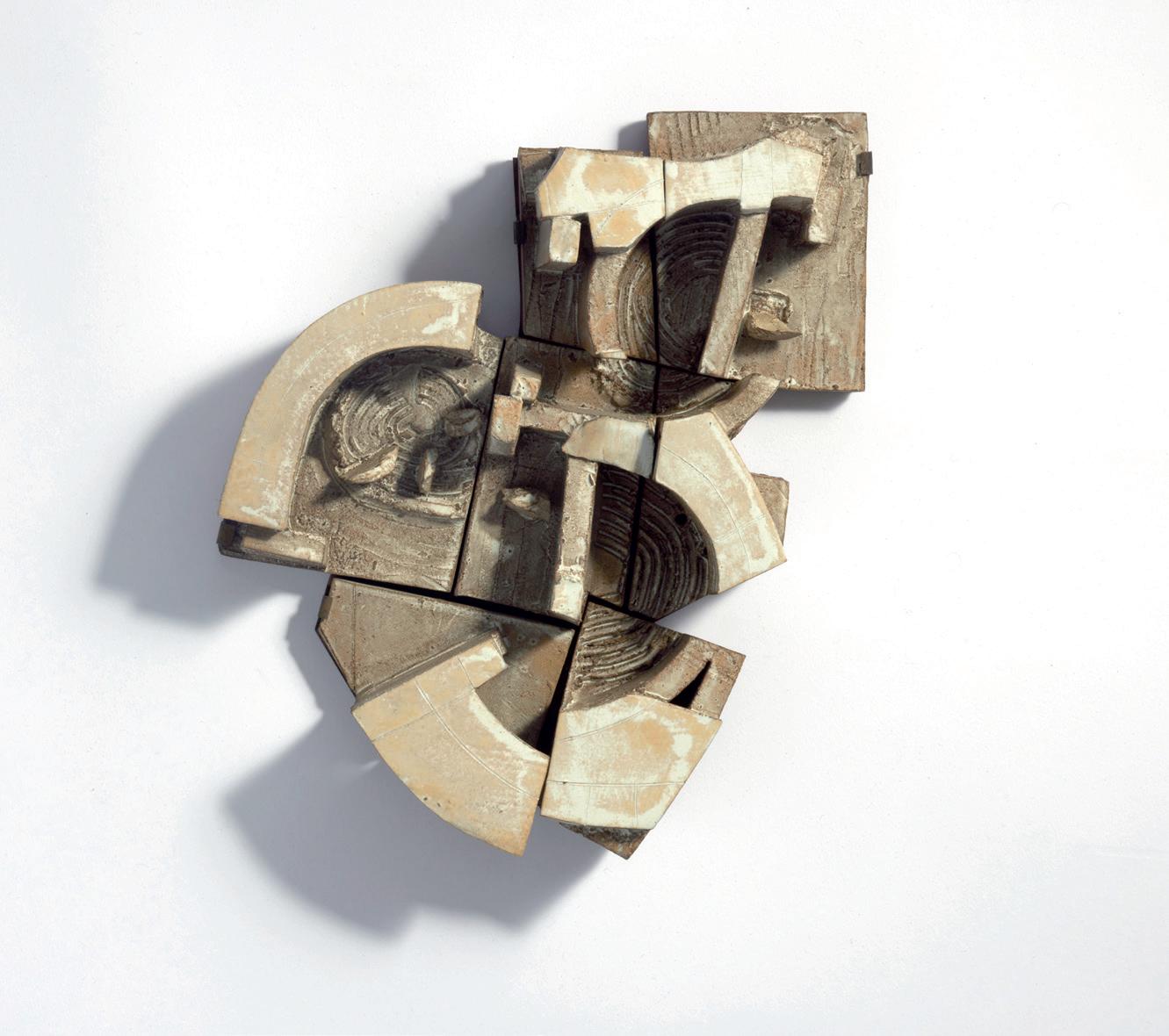
Gold 2
Ceramic and steel
H 33 cm, w 22 cm, d 10 cm
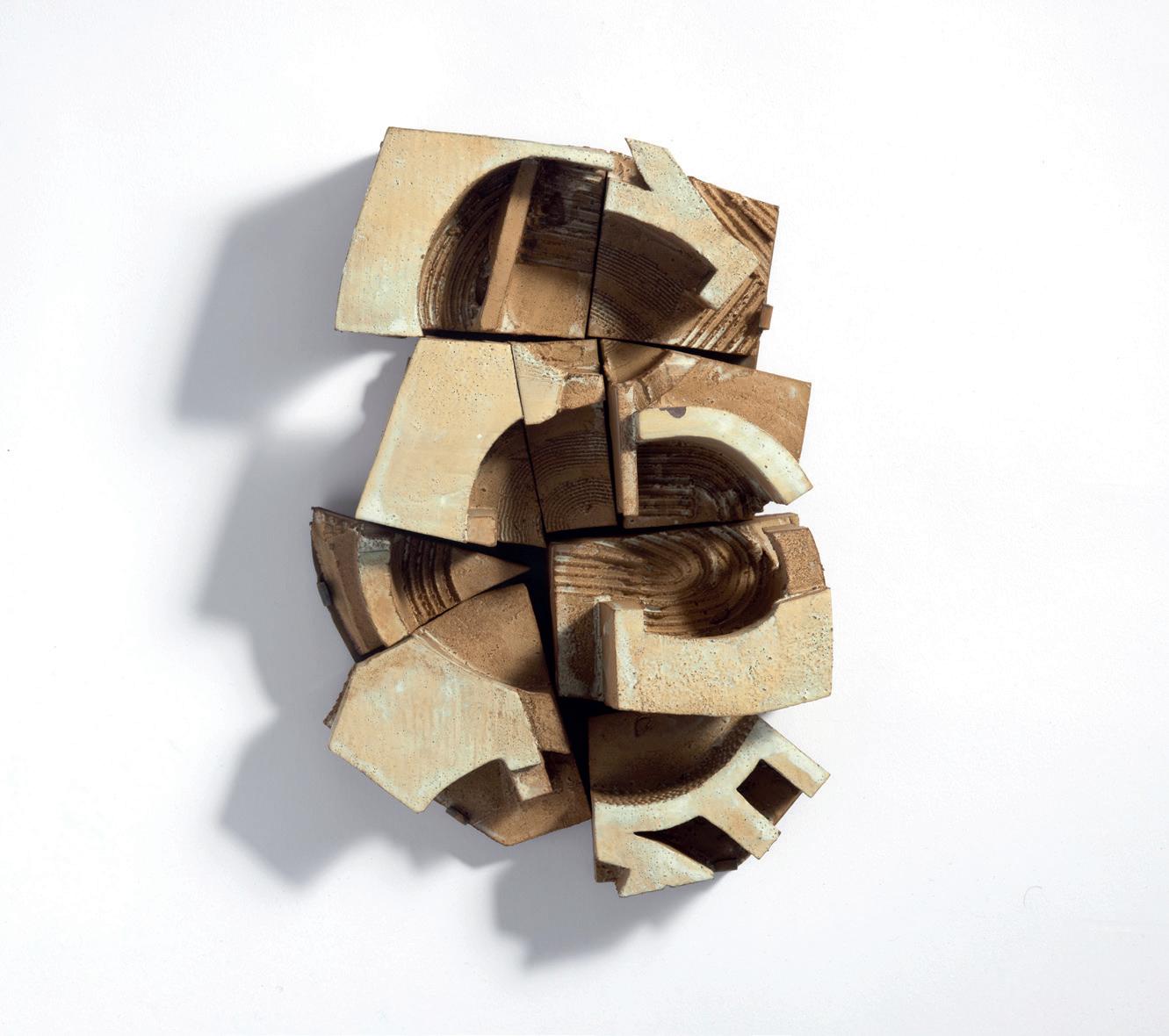
Gold 3
Ceramic and steel
H 28 cm, w 22 cm, d 9 cm
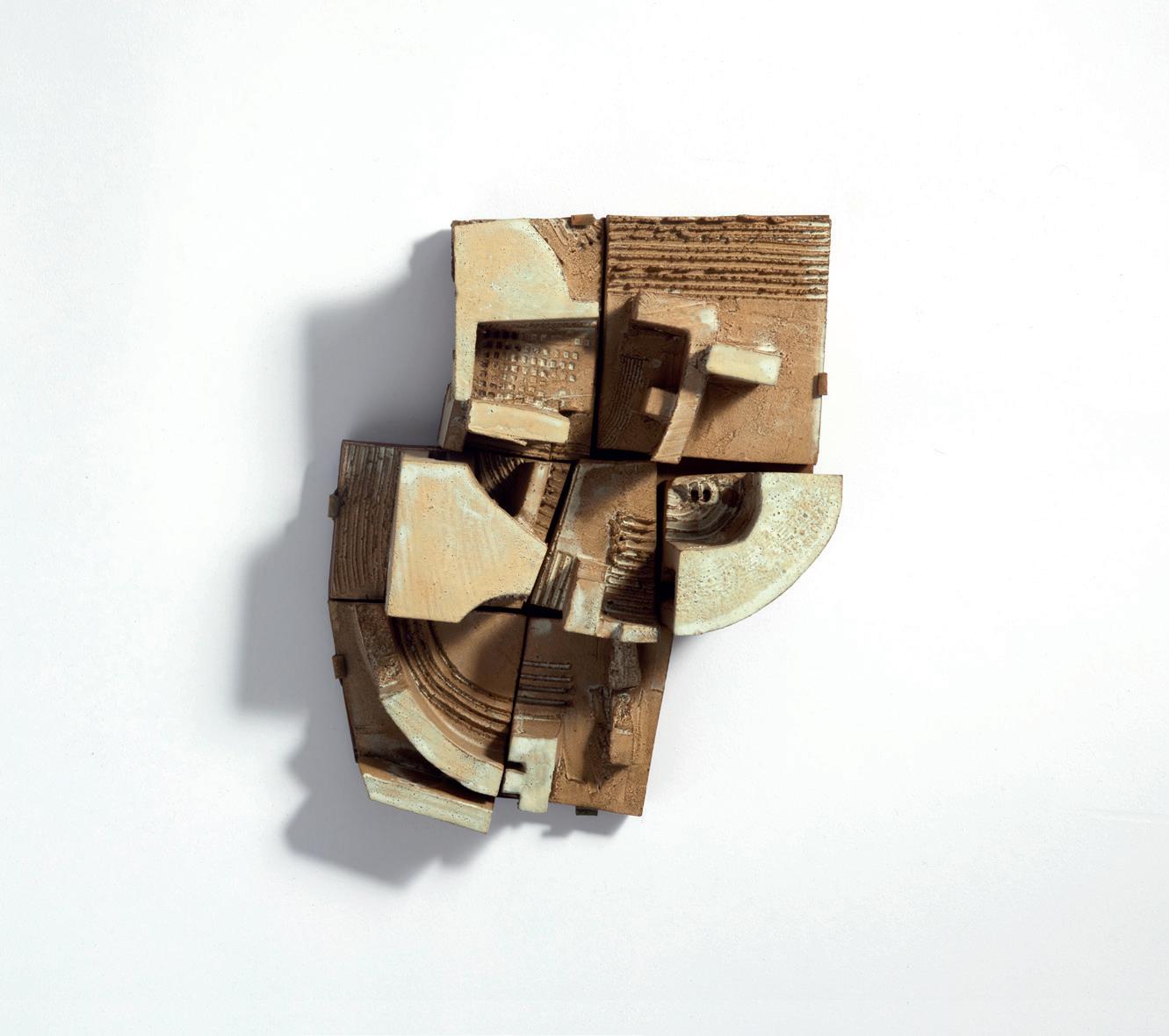
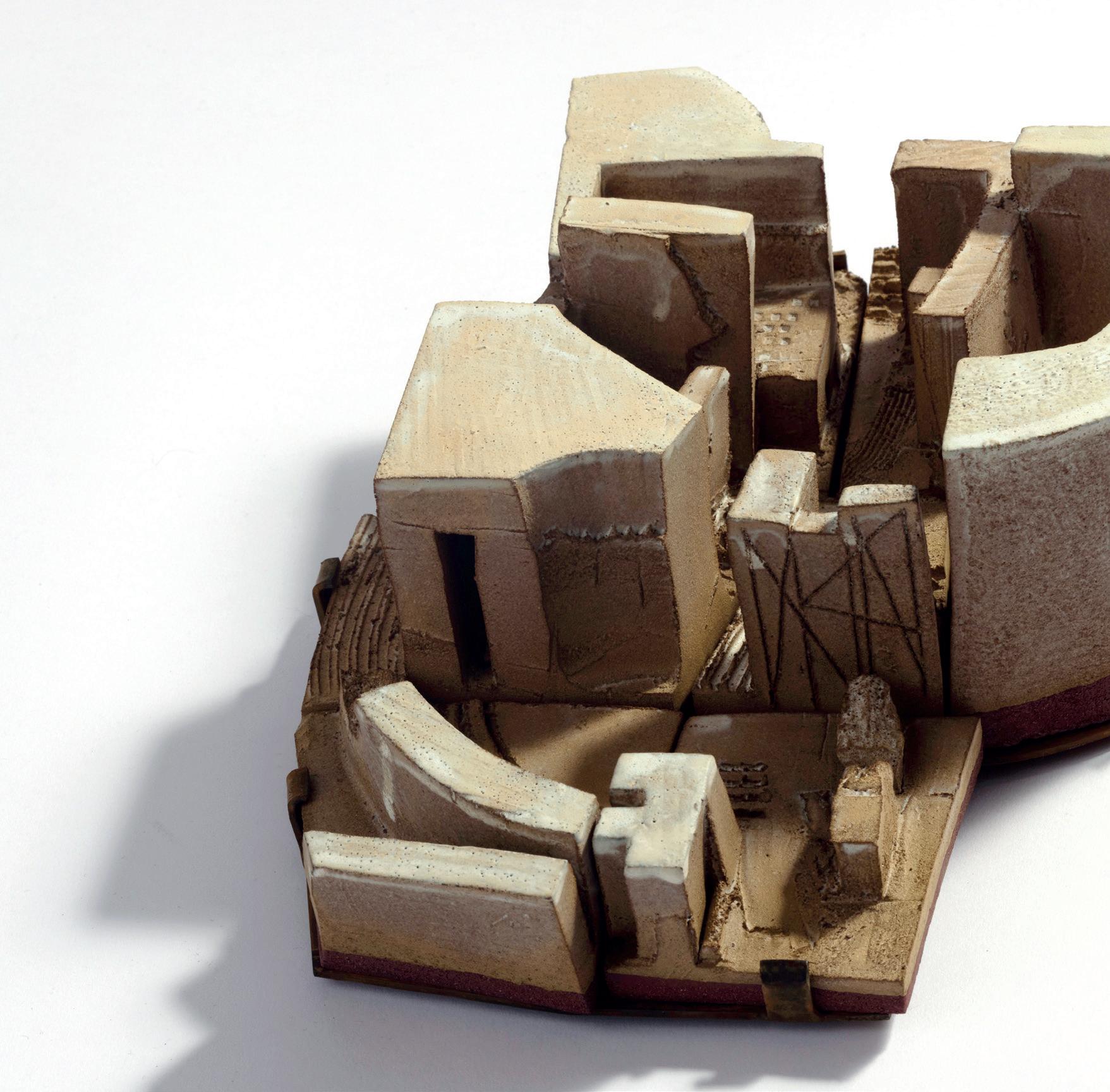
Black 1
Ceramic and steel
H 25 cm, w 30 cm, d 8 cm
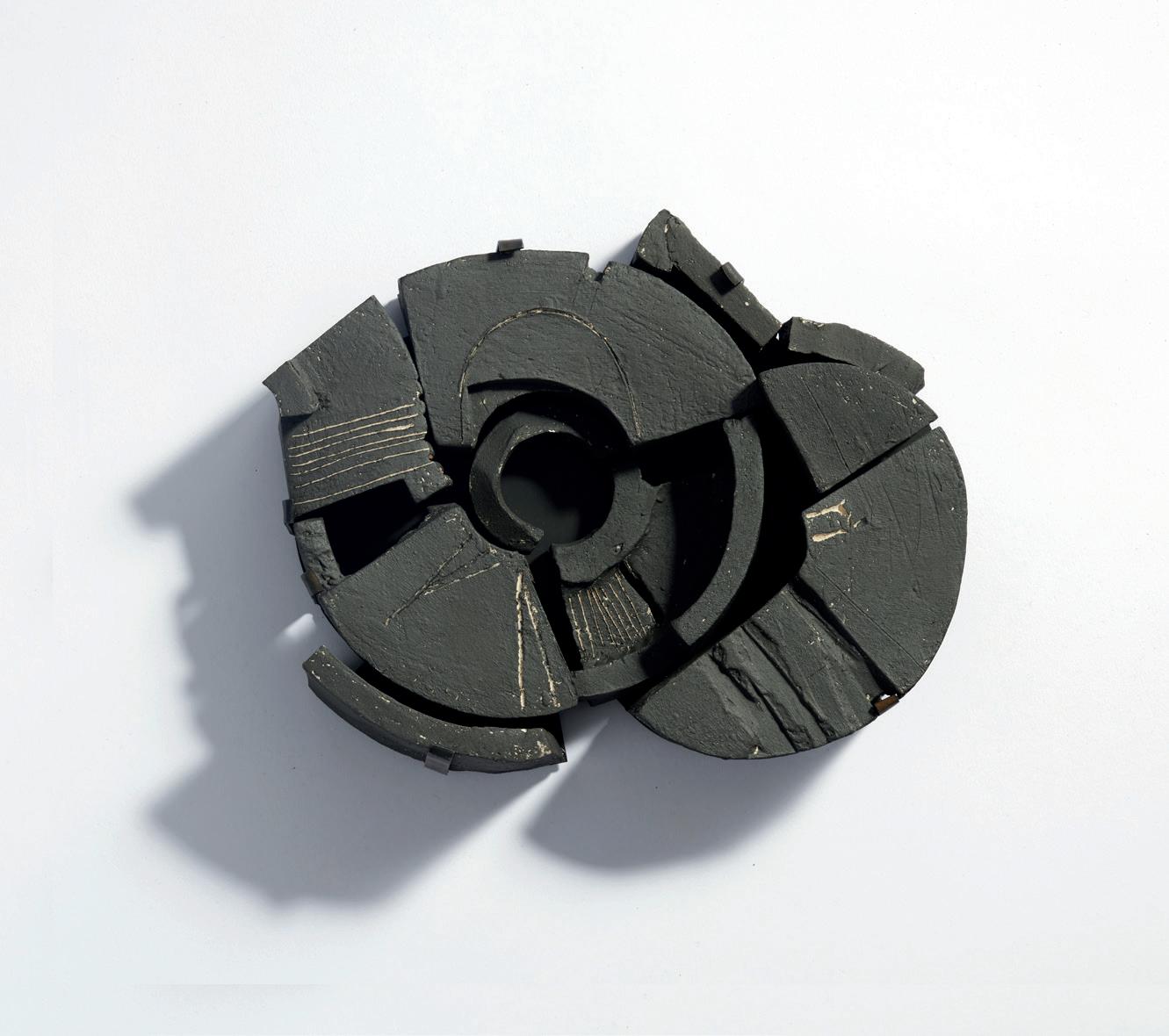
Black 2
Ceramic and steel
H 28 cm, w 30 cm, d 6.5 cm
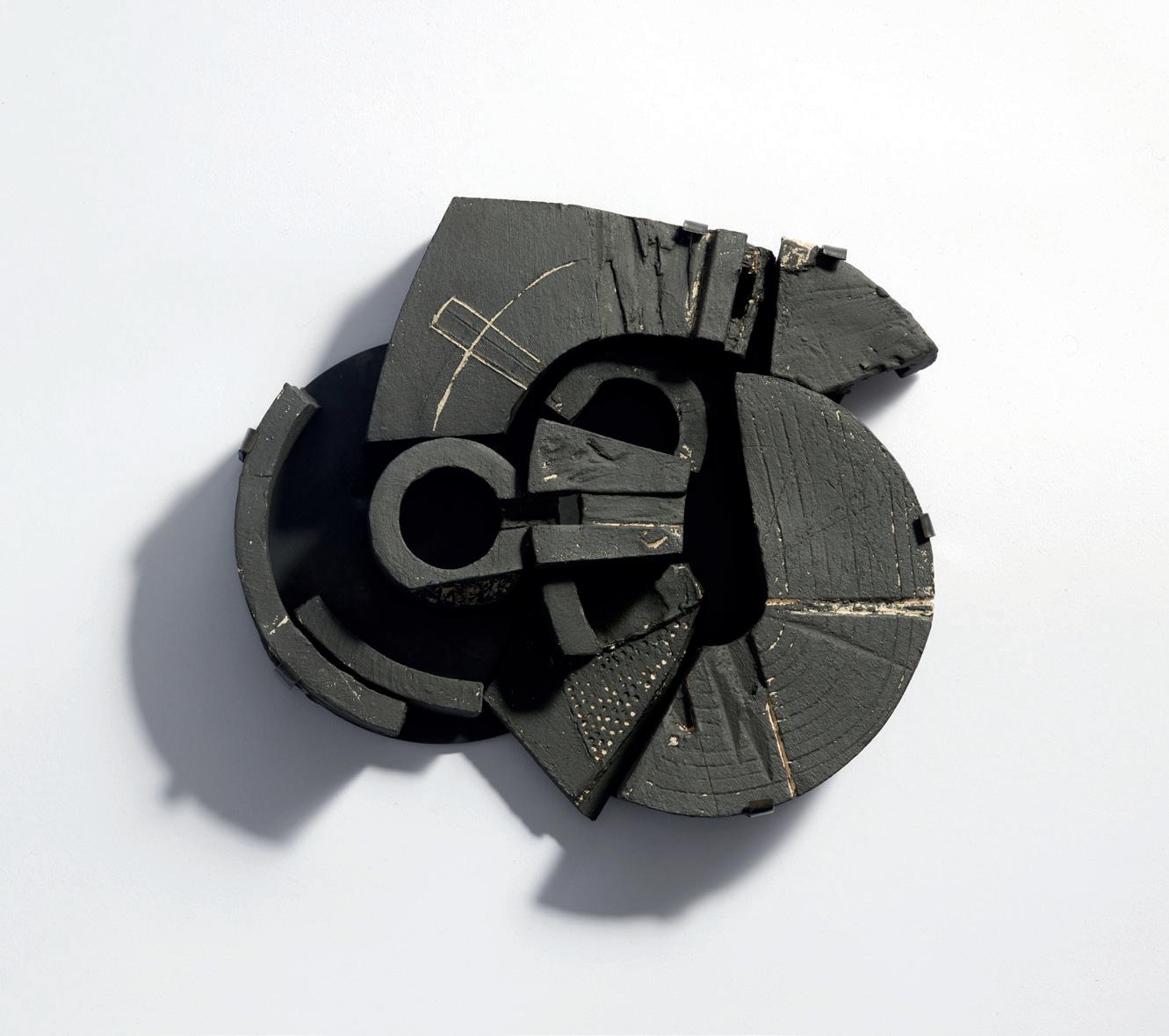
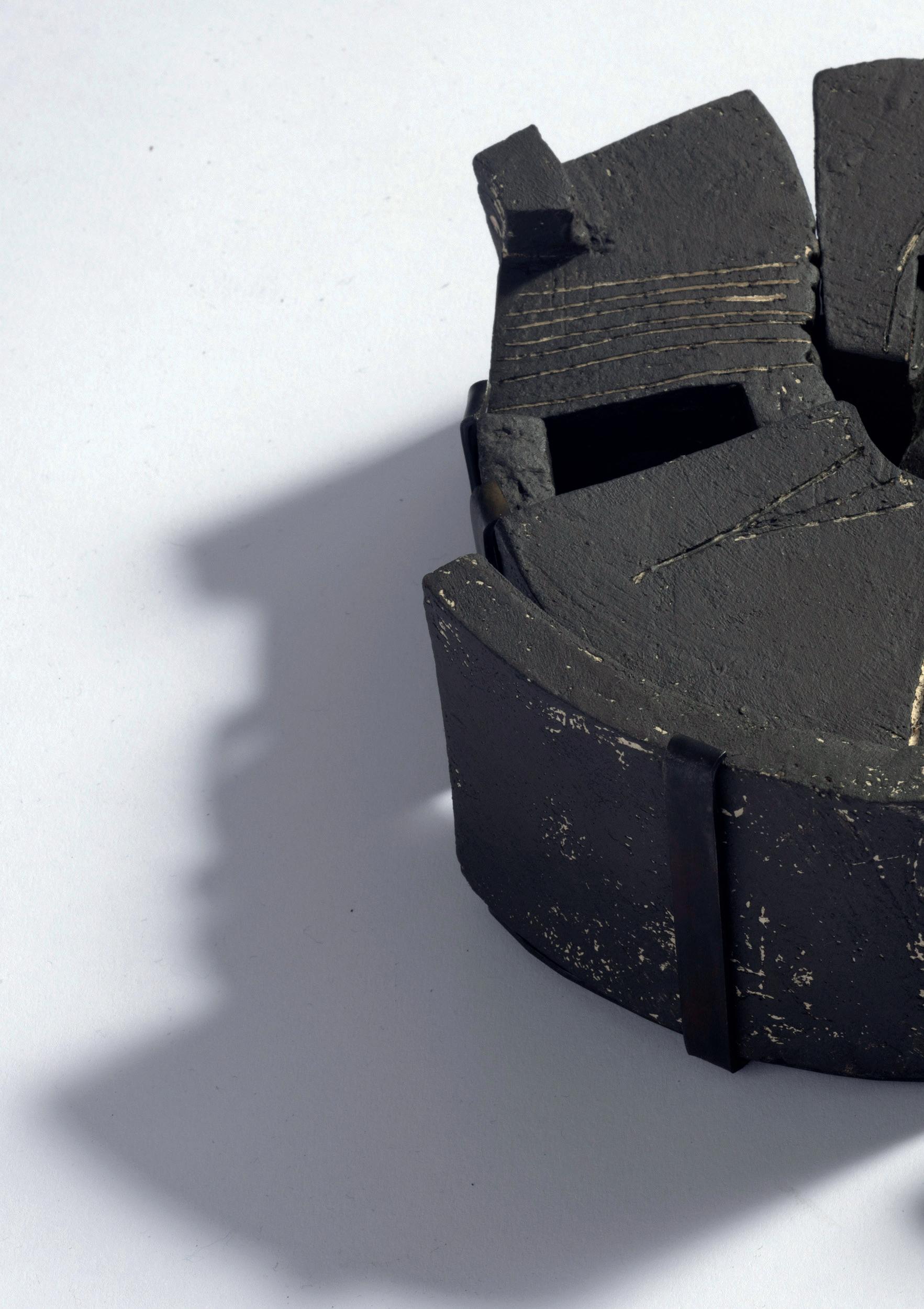
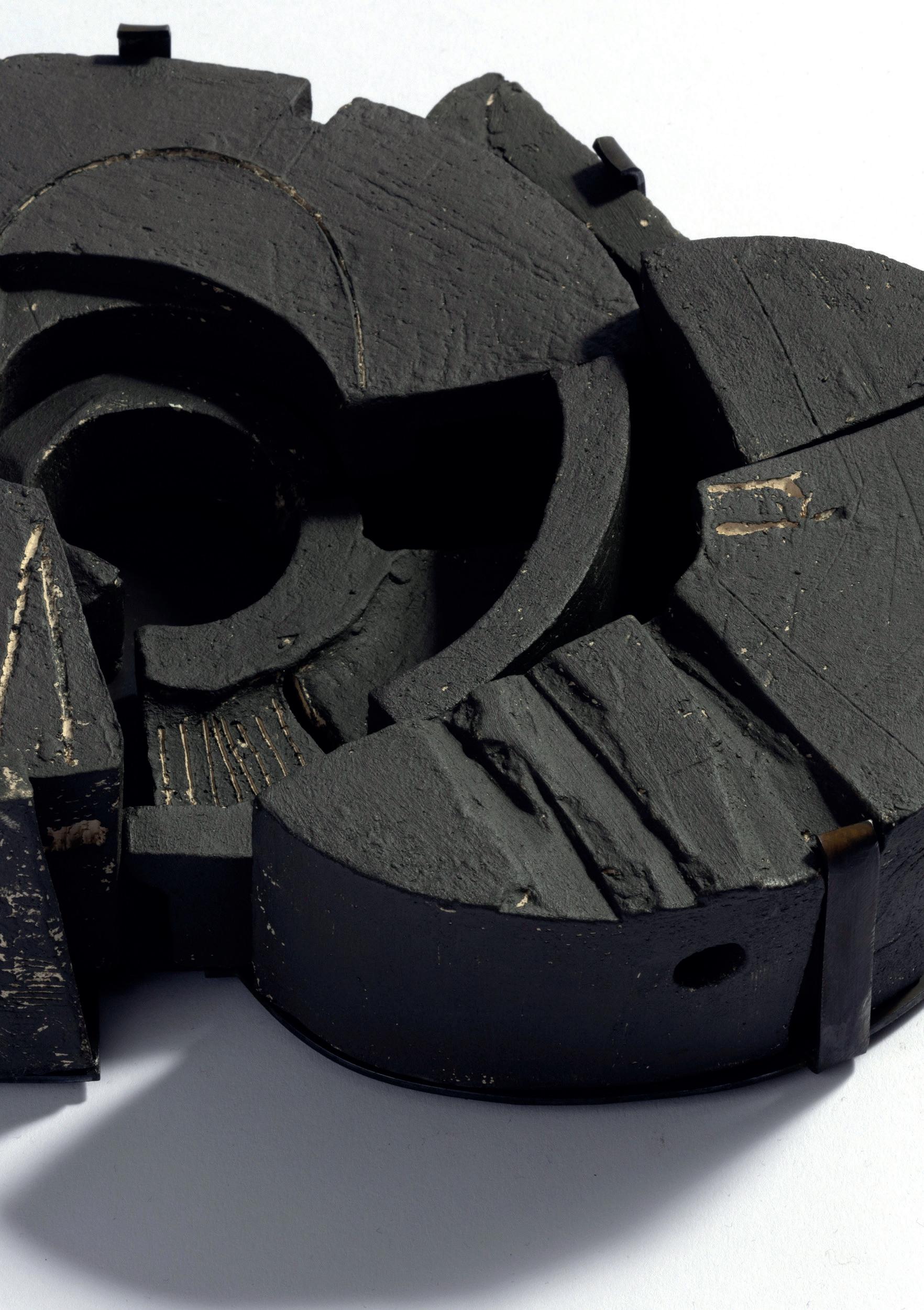
Clara Holt x Unurgent Argilla
Sonia Pasquinelli, aka Clara Holt, is an Italian illustrator and a decorator. She completed her classical studies and has always had a passion for classical literature, Greek epics and the surrealist current, which guide her in her research and personal interpretation of her subjects. Each piece she makes is a one-off, illustrated with a drawing inspired by places, mythology or childhood stories.
Nina Salsotto Cassina is an Italian ceramicist. In 2019 she founded Unurgent Argilla, focusing on material research of non-industrial wild materials. Unurgent Argilla is a vocabulary of wild materials, a study of what’s around us, repeated on spherical vessels, which she uses as a canvas to convey a spatial narrative. The final vases function as both signposts and autobiographical archival memories.
In 2021, Clara Holt and Unurgent Argilla started a collaboration to narrate specific places through their combined styles of storytelling: materials and decoration.
Together they are working on a series of vessels and tiles made and decorated with different wild clays and rocks collected throughout Italy. Each piece is thrown and the illustration is specific to the setting where the materials were collected.
Their first vessels together focused on volcanic rocks from Pantelleria, they are now working with a wider range of wild high fire clays, slips and oxides foraged mainly around the Alps.
Nina Salsotto Cassina (left) and Clara Holt (right)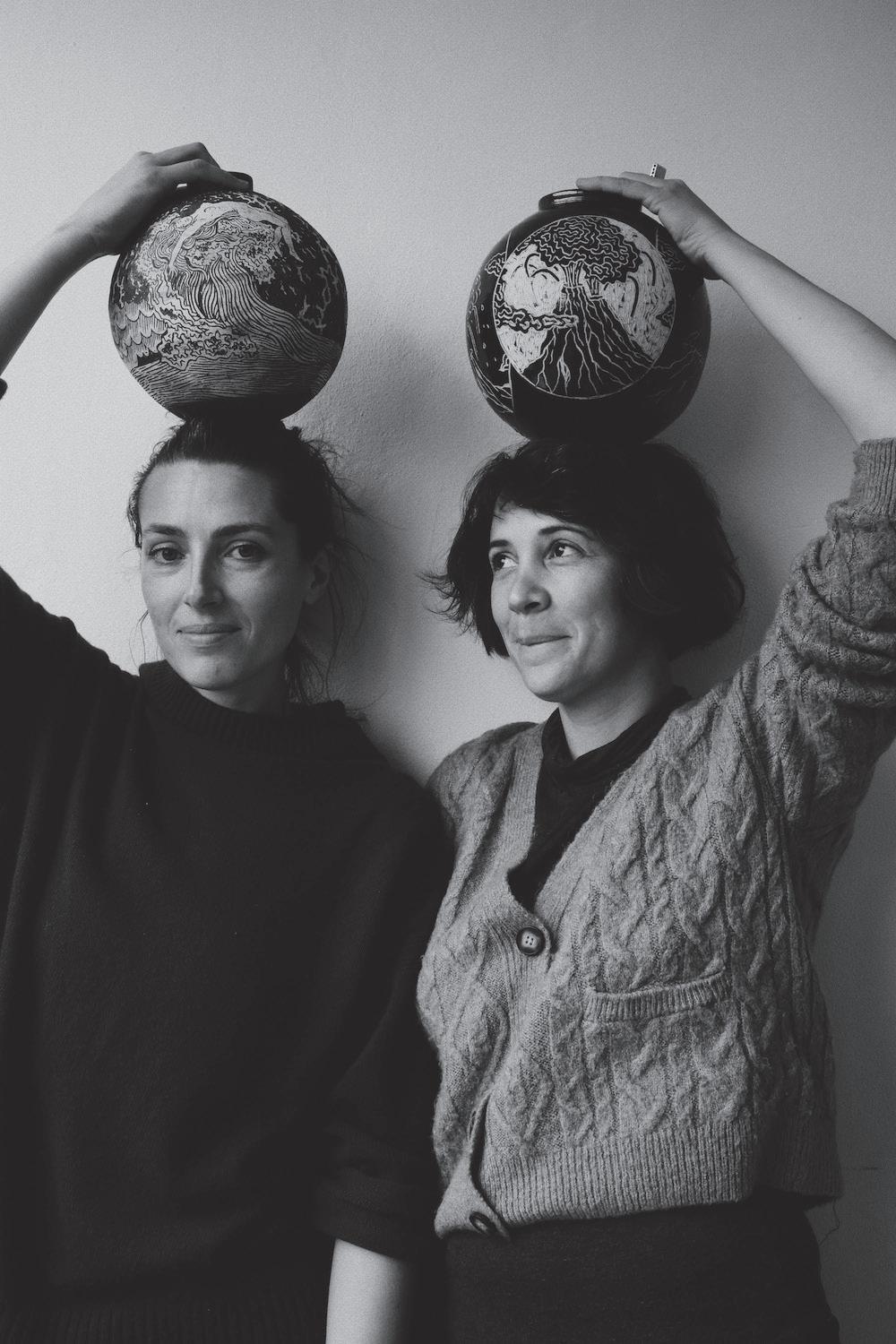
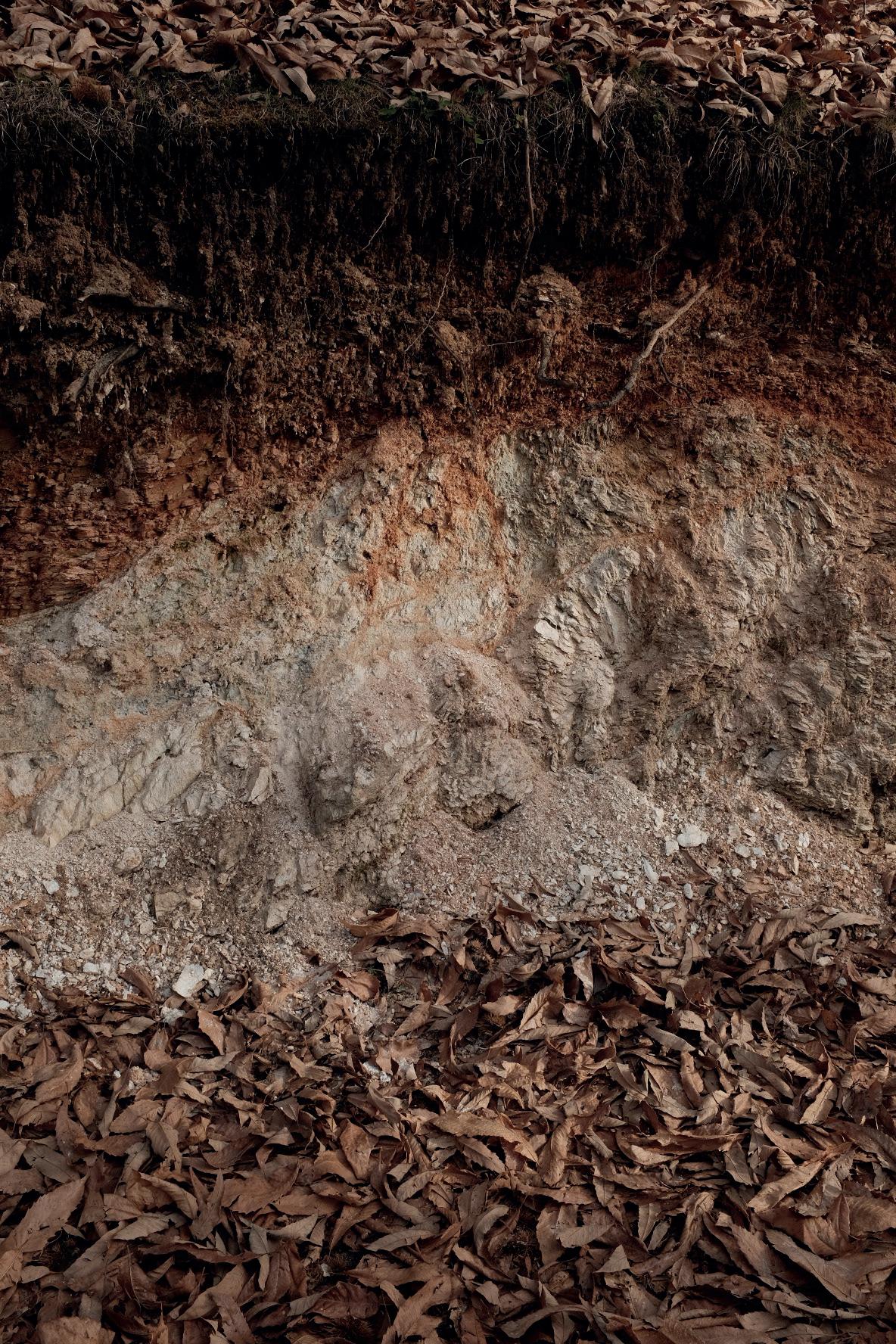
I hugged a wolf
Wild red clay and kaolin slip from Bisalta
Turned at the wheel. Fired in oxidation at 1250°C
H 23 cm, ø 23 cm
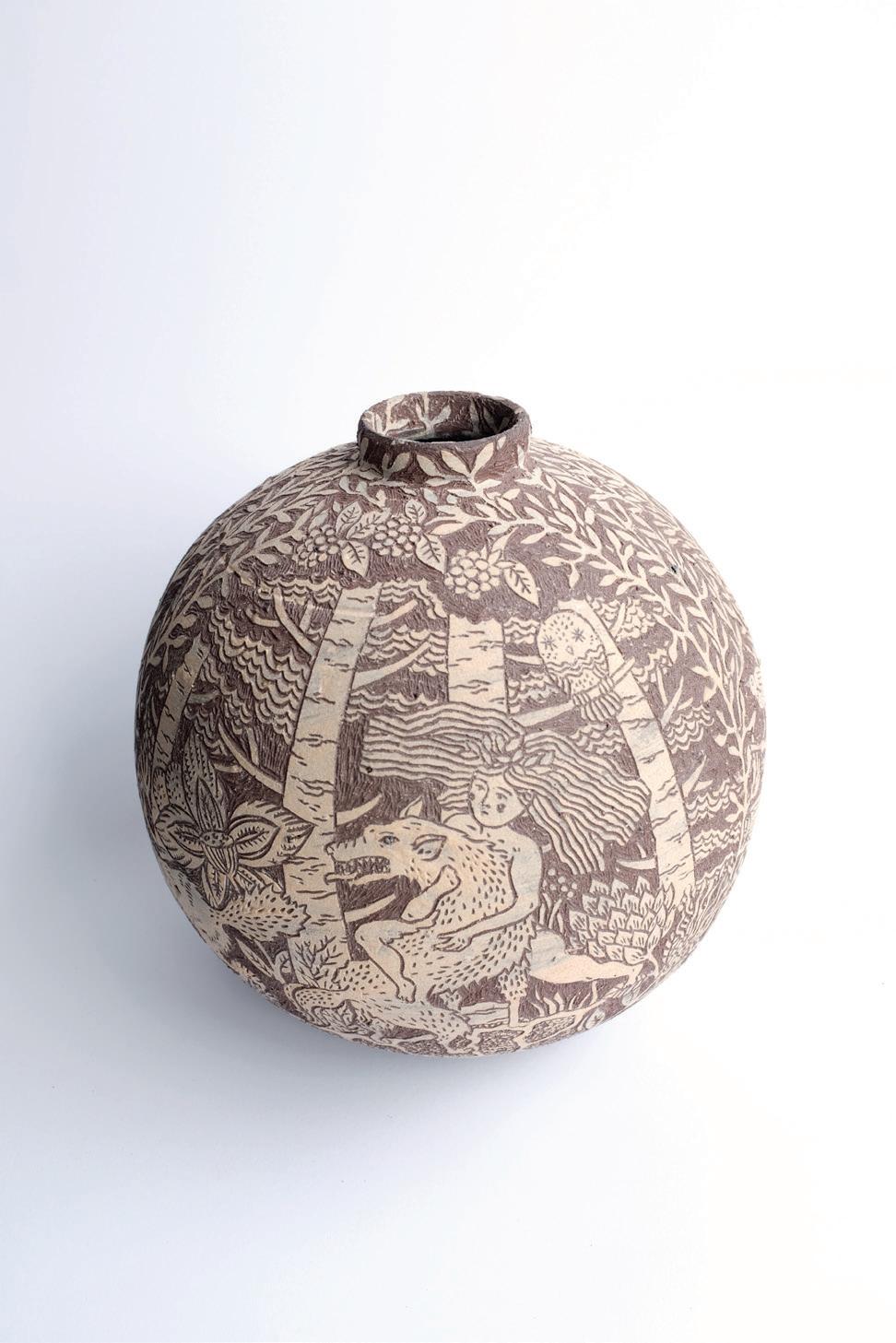
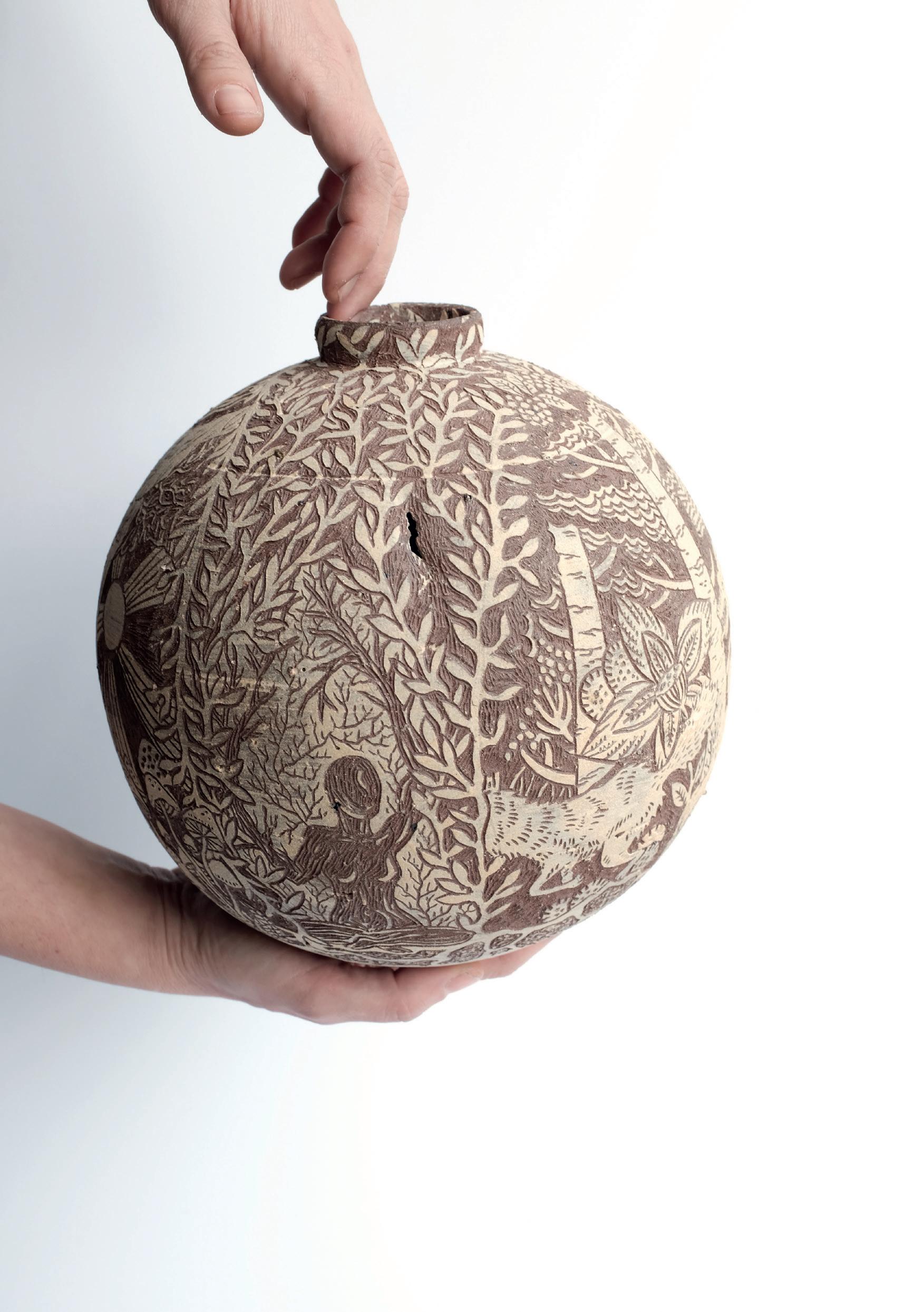
Deep roots and tangled foliage. A rustle in the bushes nearby.
Shadows run in the silence, like elusive ghosts among the birch trees. Growling, biting, bleeding like heartless hunters.
The wolf sighs, and lonely sings his sad wolf song.
I hugged a wolf: but was I dreaming?
The clay for this vase was foraged from a deposit of quartzitic clay on Mt Bisalta. The bright kaolin slip comes from just a few hundred metres below, from a small vein of weathered Bisaltite, a type of green rhyolite typical of the mountain.
The vessel was thrown at the wheel and later decorated with the sgraffito technique.
Mt Bisalta is a mountain in the south of Piedmont. It’s a special place for its recognizable two-tops shape visible from all around the region, a symbol of the Italian Resistenza and the partisans’ liberation fight from the fascist regime.
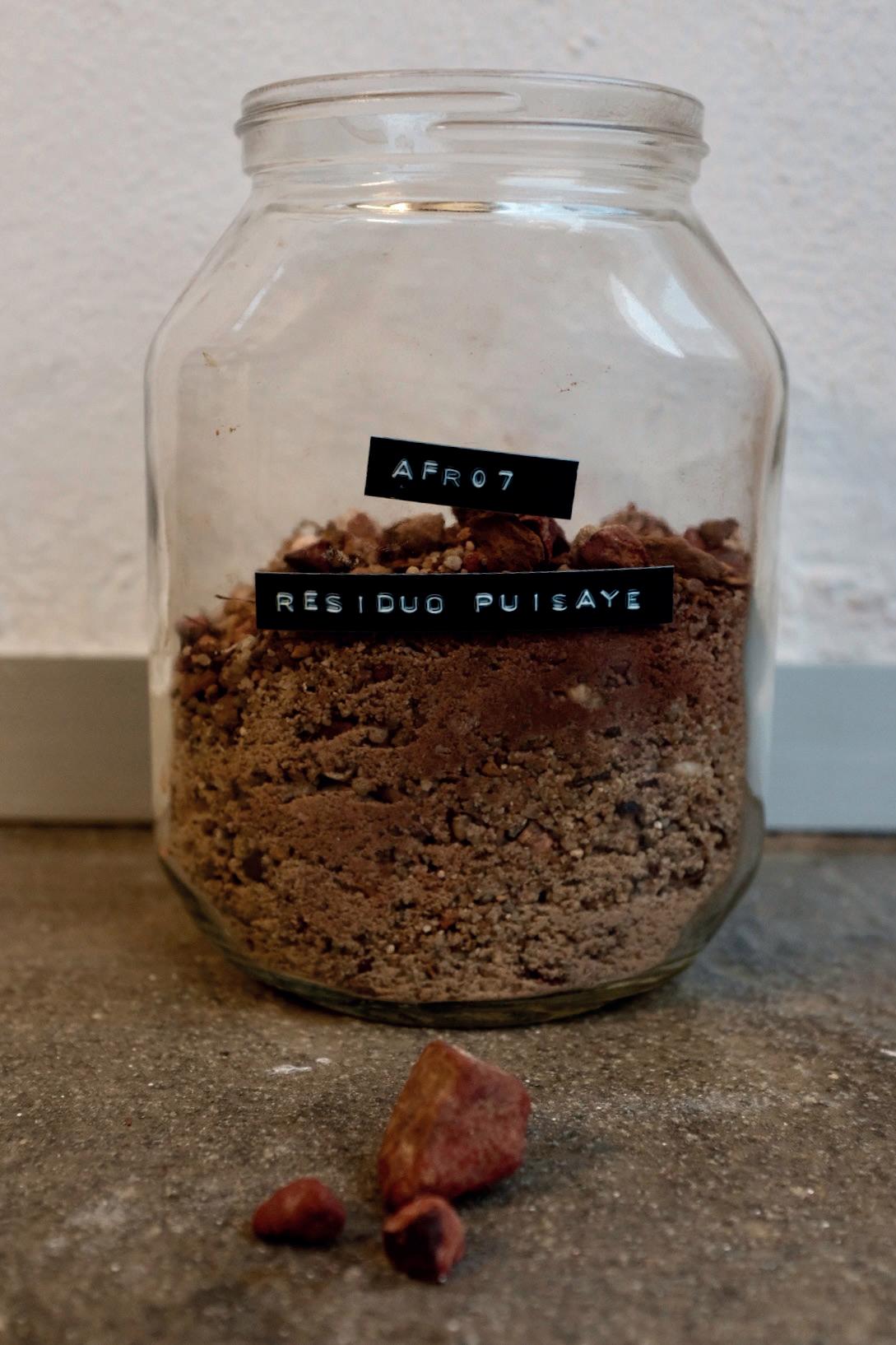
I eat mushrooms, I am slow
Wild clay and red ochre wash from Puisaye
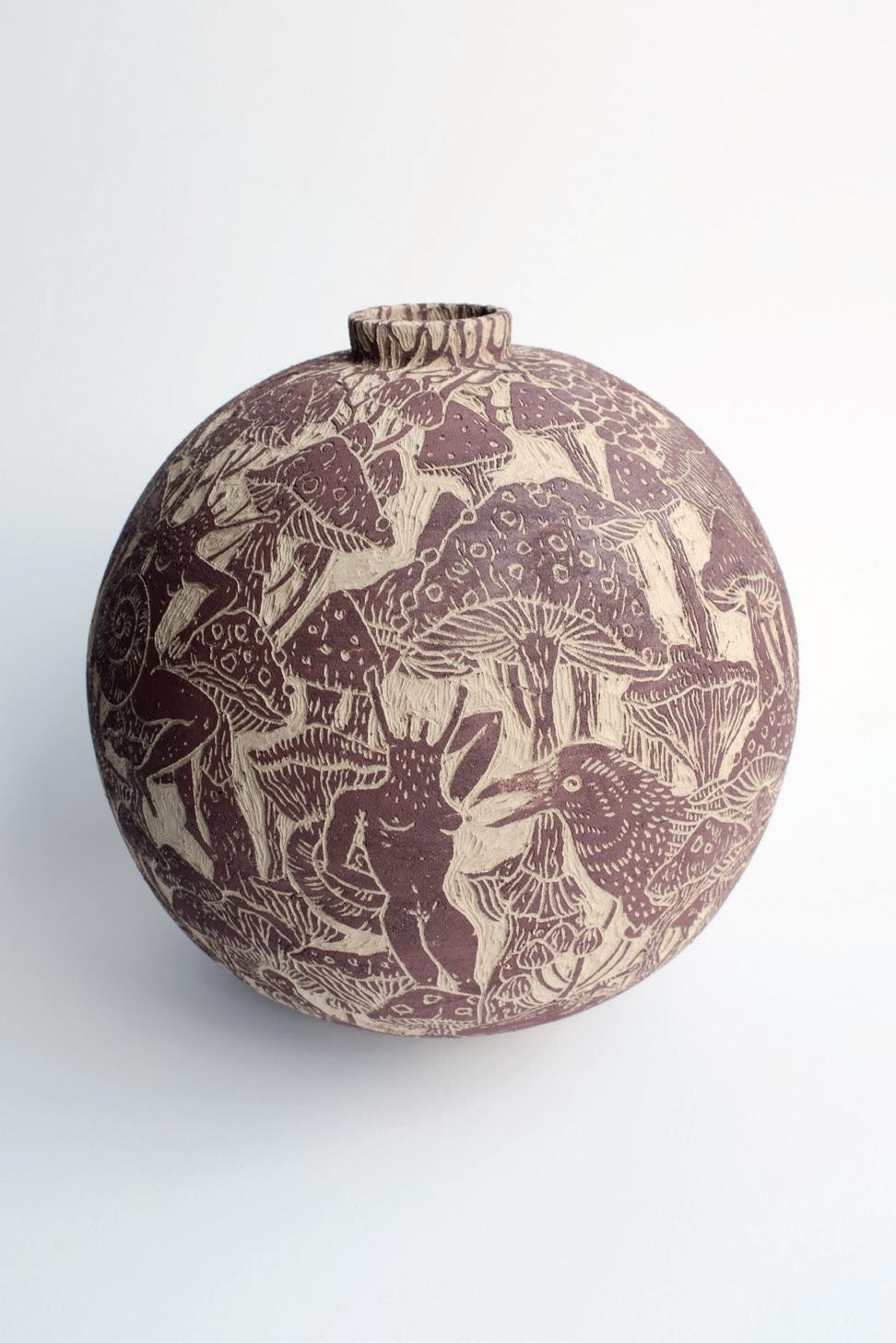
Turned at the wheel. Fired in oxidation at 1250°C
H 24 cm, ø 24.5 cm
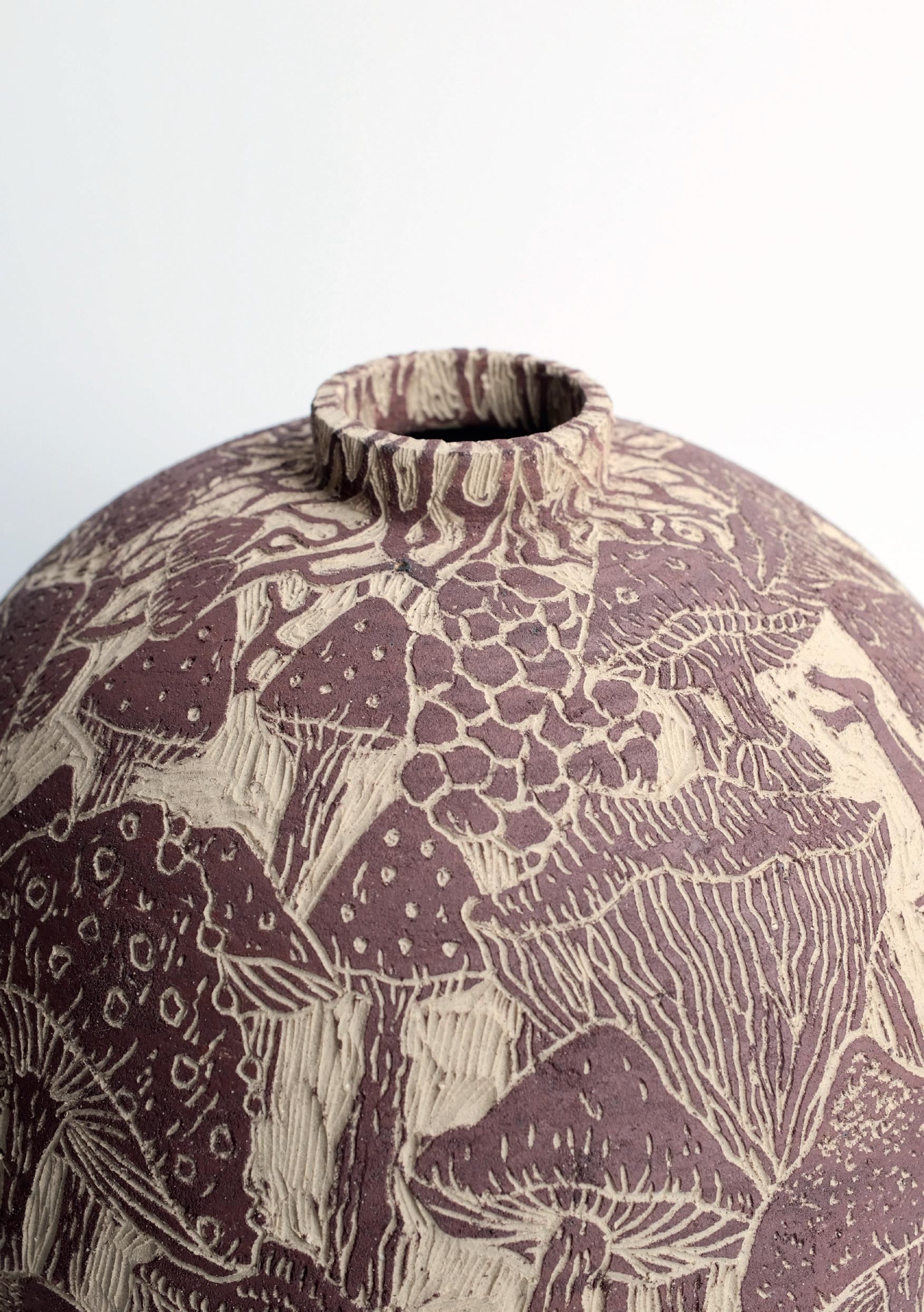
No one pokes their nose into the small world. A people of beings with wide hats and earthy feet. Fragile to the touch, and deadly to the tongue. In the soggy fresh soil, snails crawl, clothed only in their tiny homes. Sensuous curves, gentle bites.
The clay for this vase was foraged from the Puisaye region. The red oxide wash is made from limonite pebbles sieved from the clay itself.
The vessel was thrown at the wheel and later decorated with the sgraffito technique.
The Puisaye region in France has a secular pottery tradition dating back to the Middle Ages, also thanks to the vast high fire clay deposit it sits upon.
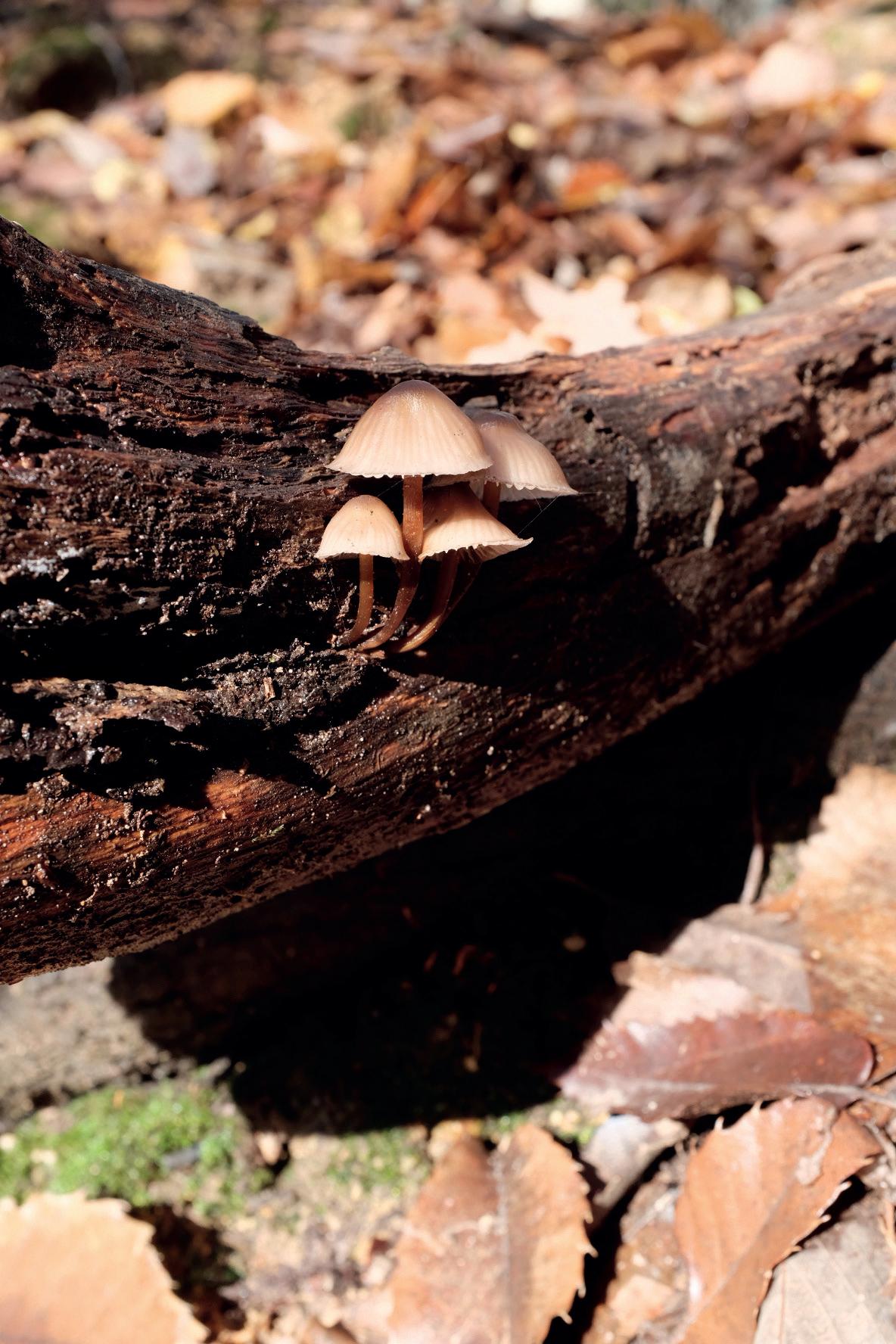
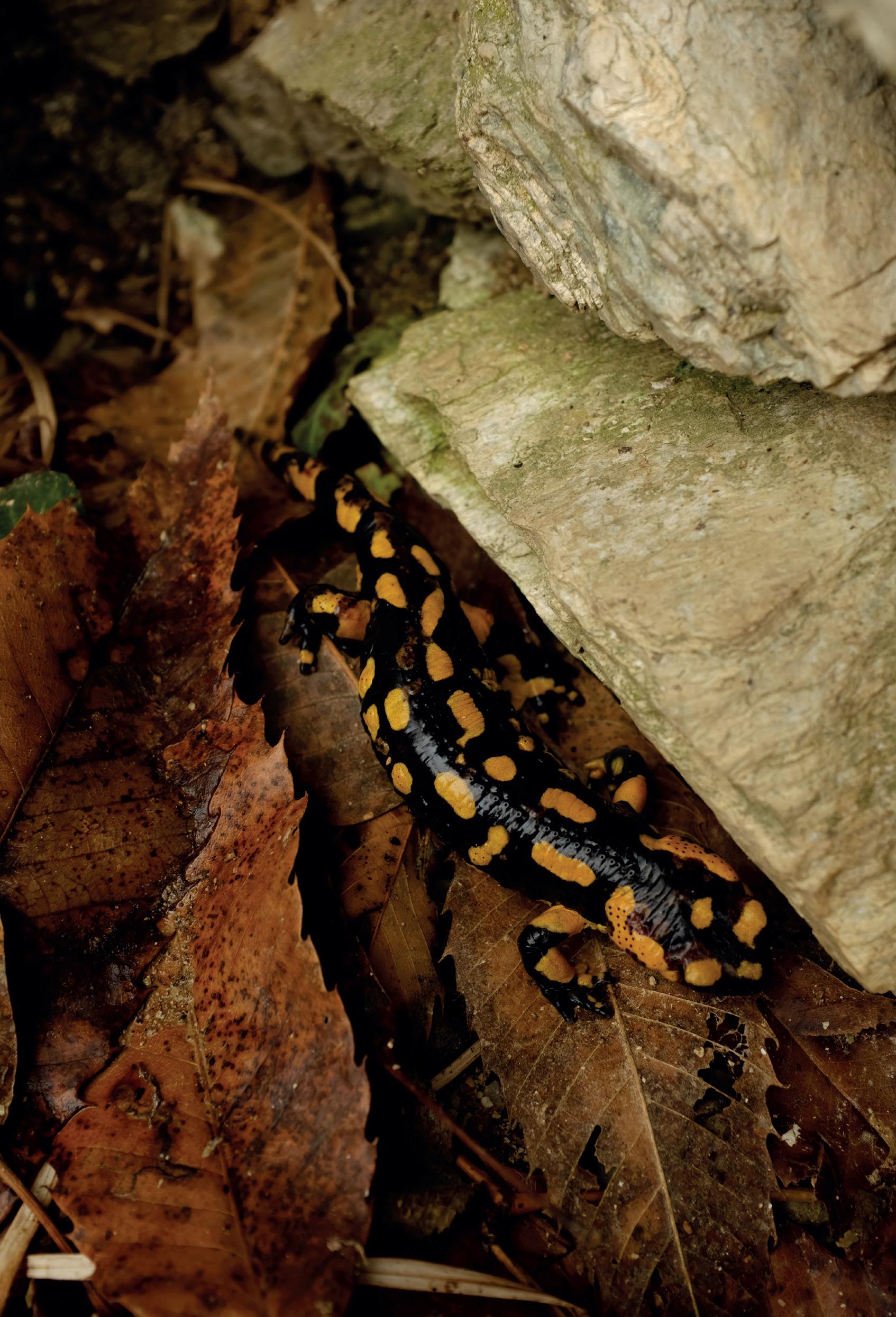

I see as a lizard, I bloom as a flower
Wild red clay and kaolin slip from Bisalta
Fired in oxidation at 1250°C
ø 32.5 cm
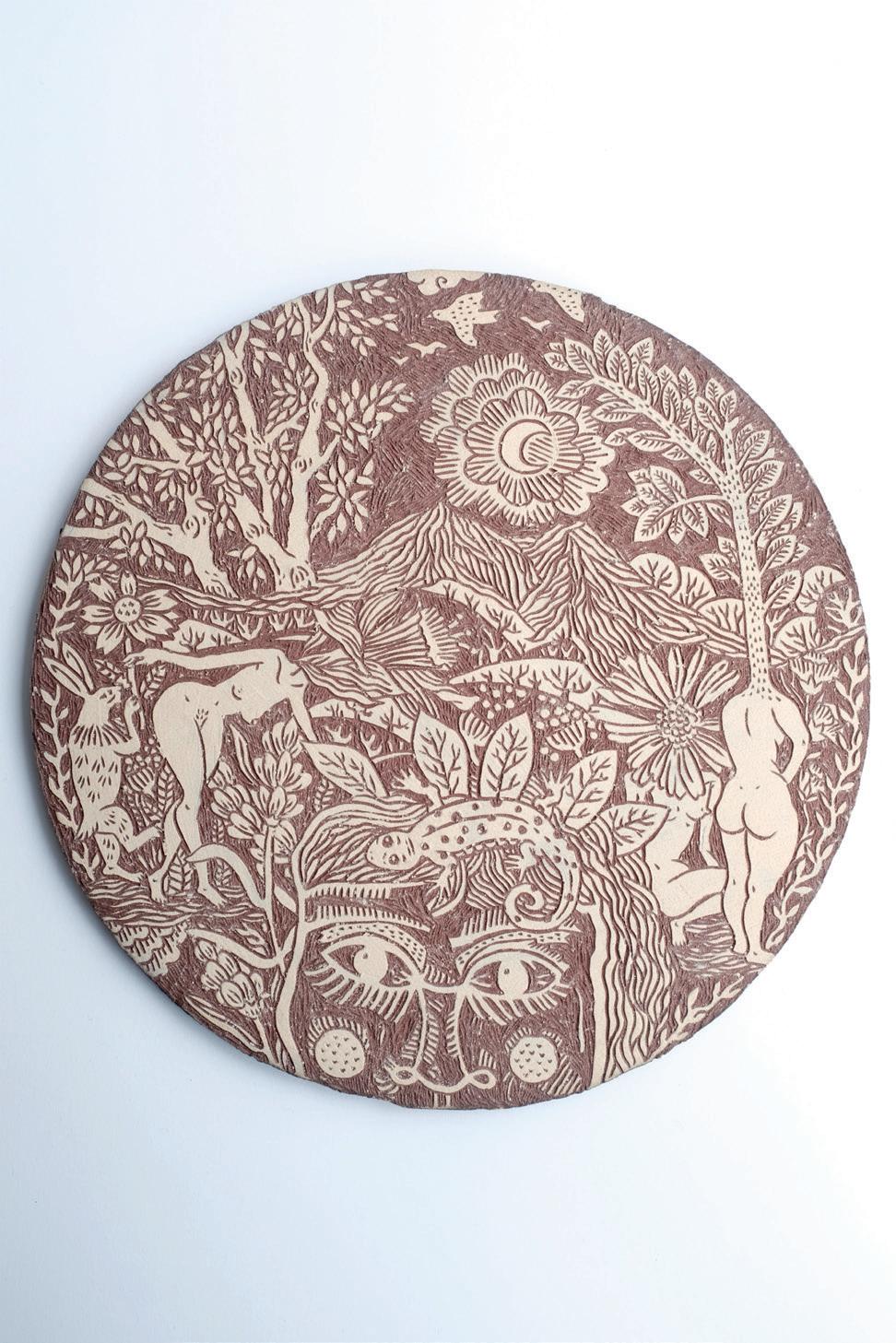
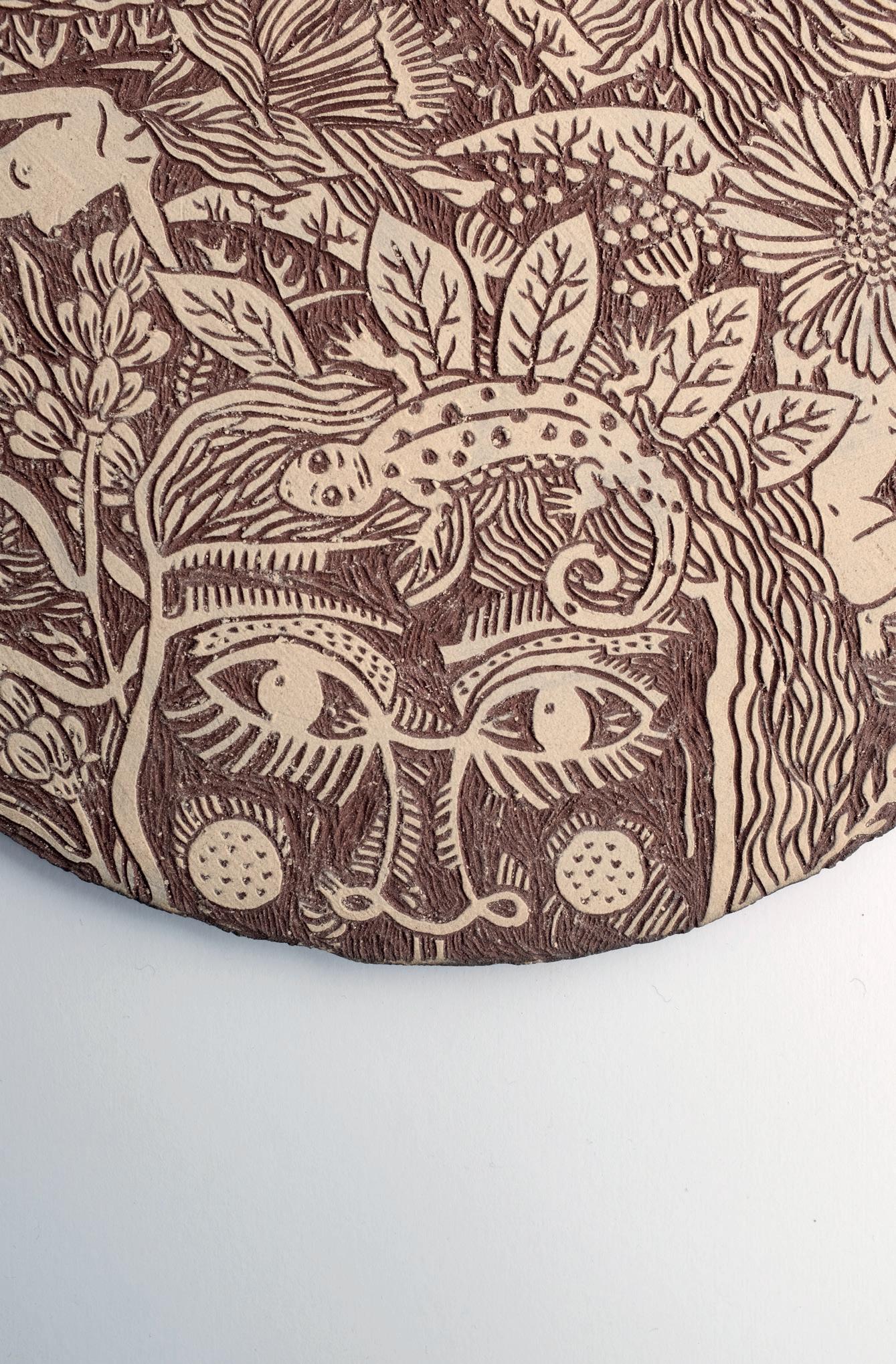
She winters in blankets of leaves and cracks of logs.
She lives in the midst of the flame without pain, her icy gaze extinguishes the fire with a breath.
She slips out when the flowers bloom, stretching their long green arms in the shadow of the mountain peaks, weaving the thoughts of men.
When I see you, I am a lizard in the sun.
The clay for this large round tile was foraged from a deposit of quartzitic clay on Mt Bisalta. The bright kaolin slip comes from just a few hundred metres below, from a small vein of weathered Bisaltite, a type of green rhyolite typical of the mountain.
It is decorated with the sgraffito technique.
Mt Bisalta is a mountain in the south of Piedmont. It’s a special place for its recognizable two-tops shape visible from all around the region, a symbol of the Italian Resistenza and the partisans’ liberation fight from the fascist regime.

Sometimes I wear my beast head
Wild clay and limonite wash from Puisaye
Fired in oxidation at 1250°C
ø 31.5 cm
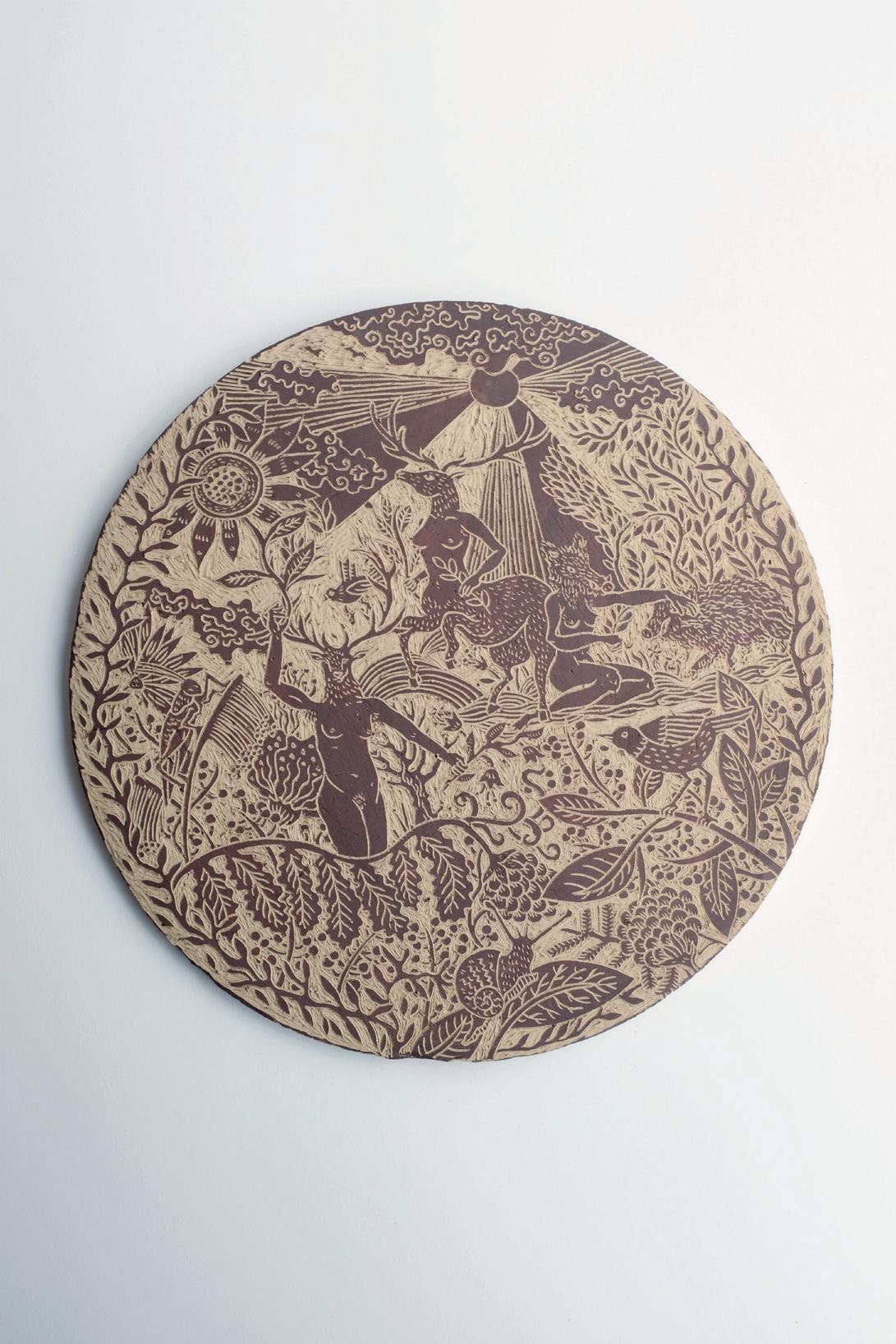
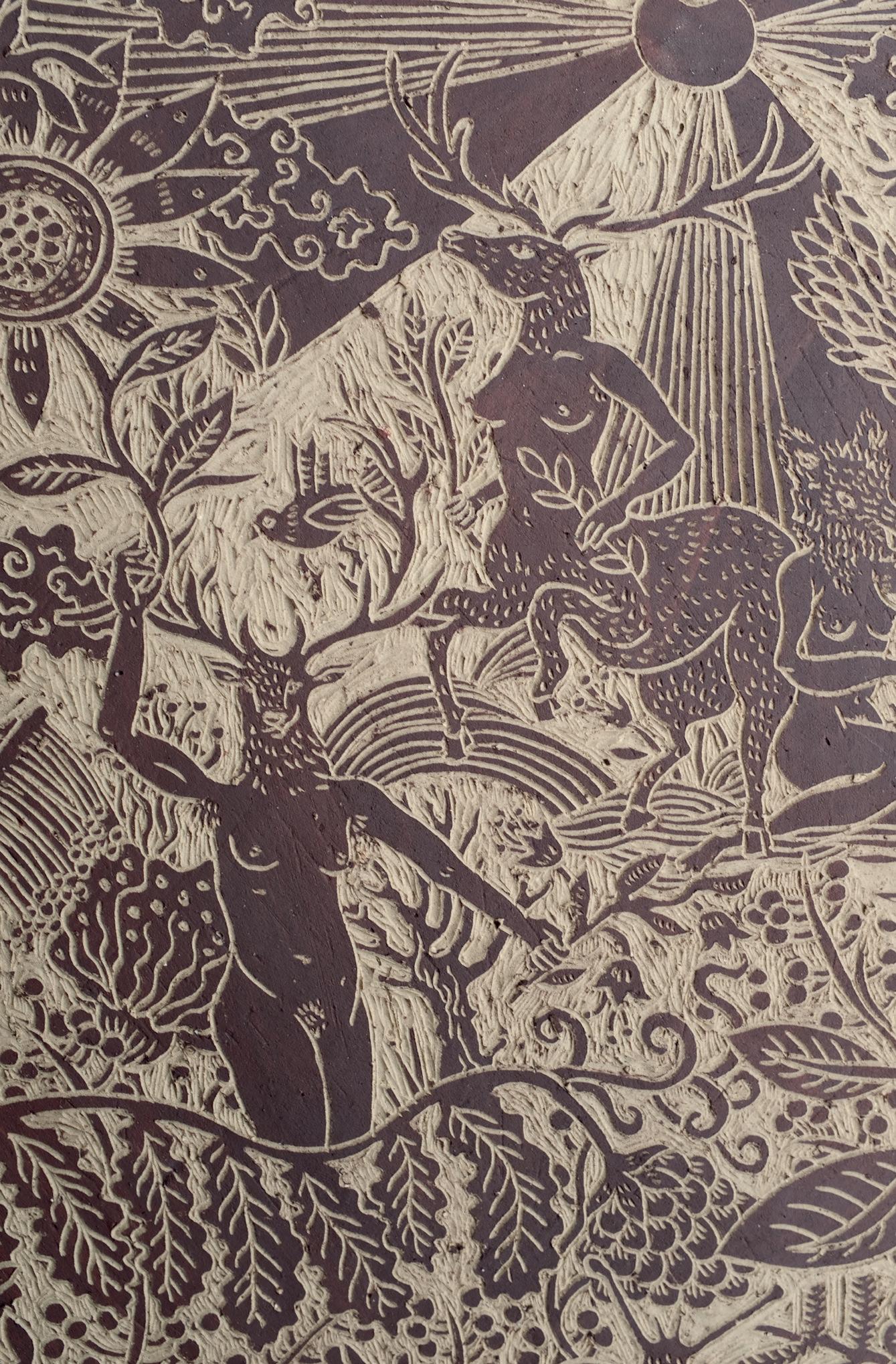
In the city, we are caged, with concrete walls so high, Our spirits yearn for freedom, beneath the endless sky, We dream of open spaces, where our hearts can truly soar, And turn wild, like the creatures that we were meant to be before.
So we venture to the wilderness, where the air is pure and clear, And leave behind the noise, the chaos, and the fear, We breathe in the freshness, and let our souls ignite,
As we turn wild, and bask in the rustle of the night.
We run with deers, we dance with the bears,
We roll with boars, and let our laughter fill the air,
We walk in the light of the moon, and let the stars guide us home,
As we turn wild, and let our true selves roam.
The clay for this large tile was foraged from the Puisaye region. The yellow oxide wash is made from limonite pebbles sieved from the clay itself. It is decorated with the sgraffito technique.
The Puisaye region in France has a secular pottery tradition dating back to the Middle Ages, also thanks to the vast high fire clay deposit it sits upon.
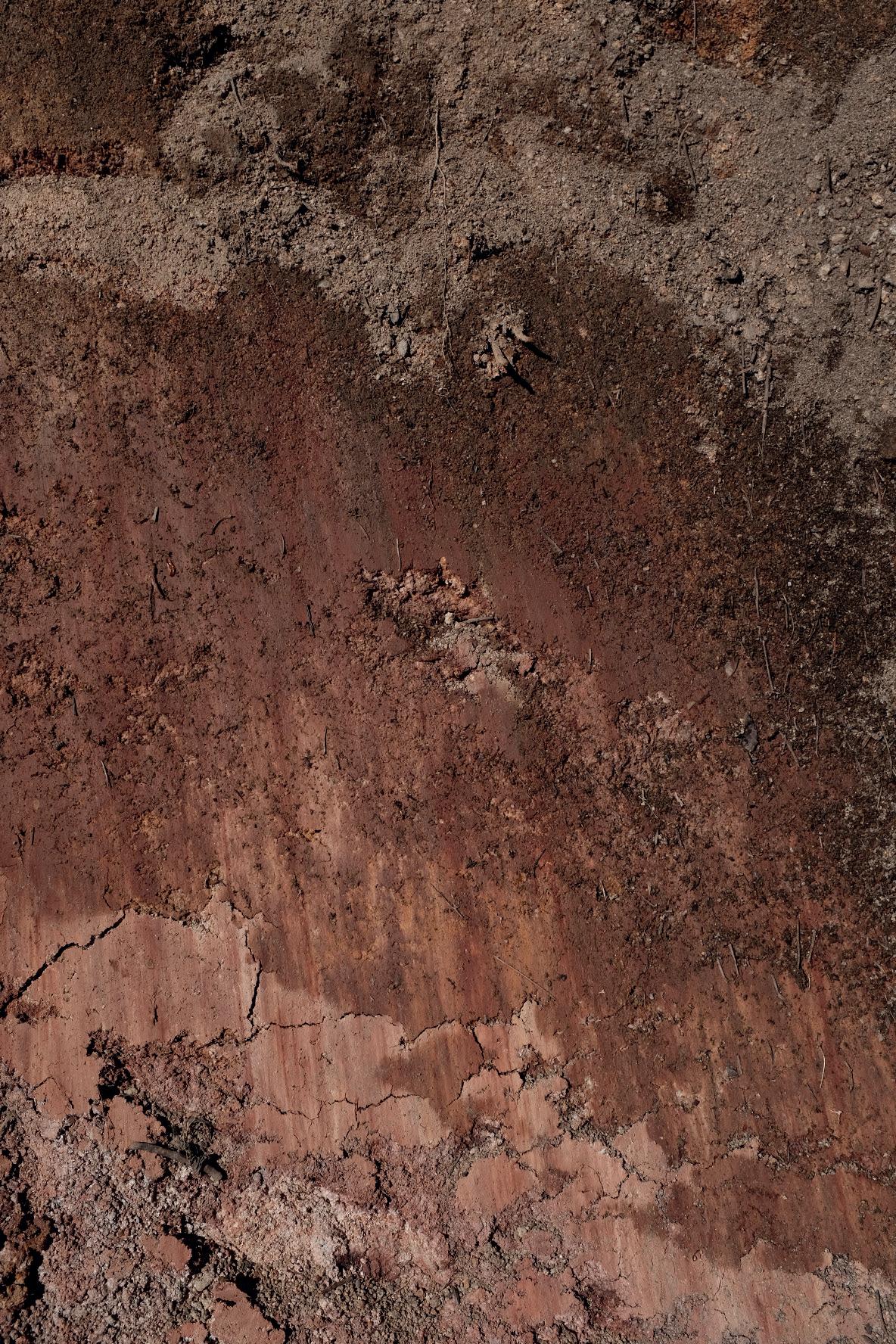
I flow with swans
Wild pink granitic clay and weathered basalt from Ardèche
Fired in oxidation at 1220°C
ø 31.5 cm
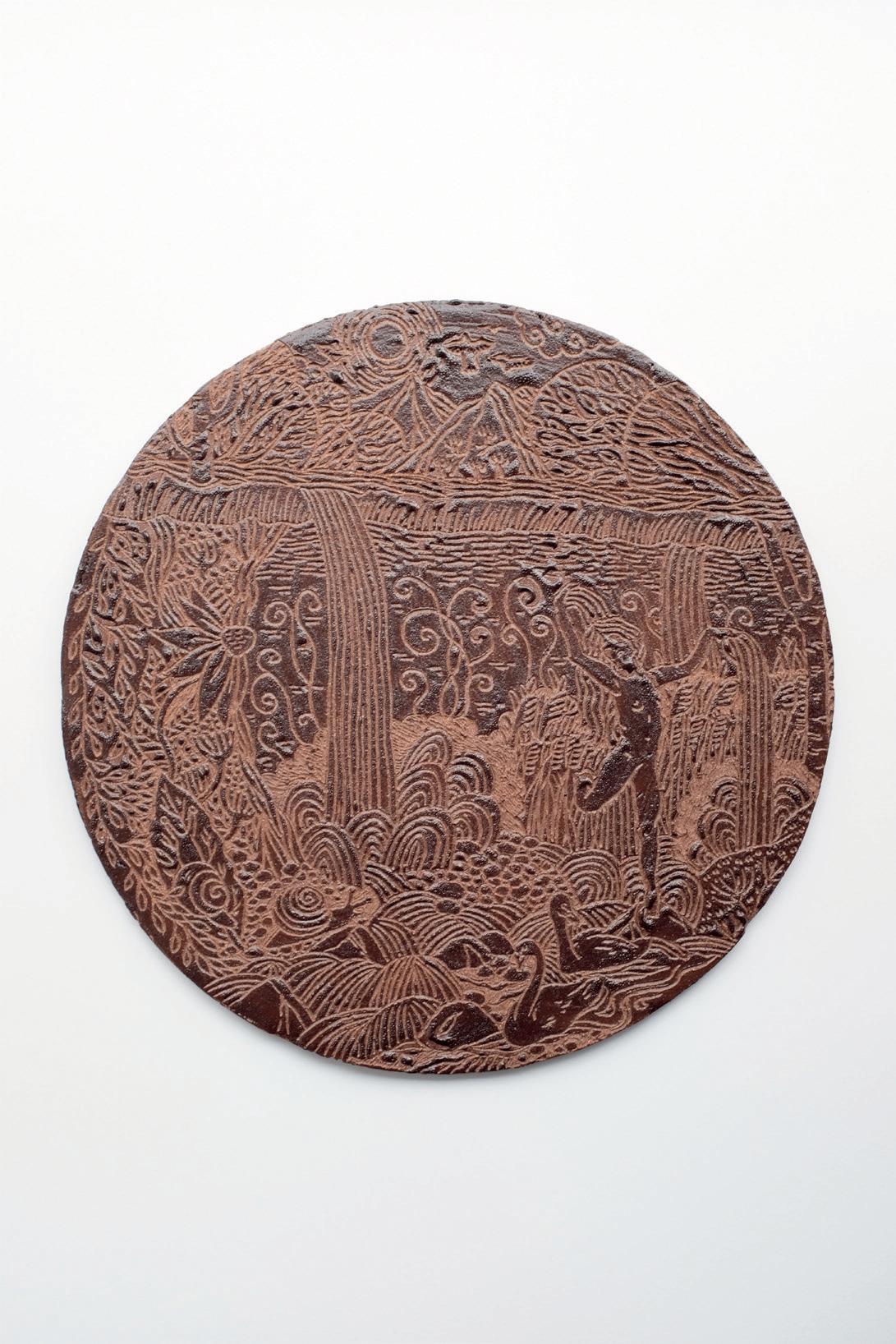

I saw two swans the other day. Their whiteness ruffled pillows of soft feathers.
You said: do you know that with their wings they can break a man’s arm? They glided in the gentle undertow, between swirls and eddies. They reminded me of those little swanshaped pedal boats from which we used to dive down the river.
You said: do you know that swans constantly put their heads under water obsessed with having their shoes untied?
The materials for this large tile were foraged in Ardèche. The refractory body comes from a deposit of weathered pink granite, while the vitrified clay that decorates it is made of a partially weathered red basalt found nearby.
The tile was decorated with the sgraffito technique.
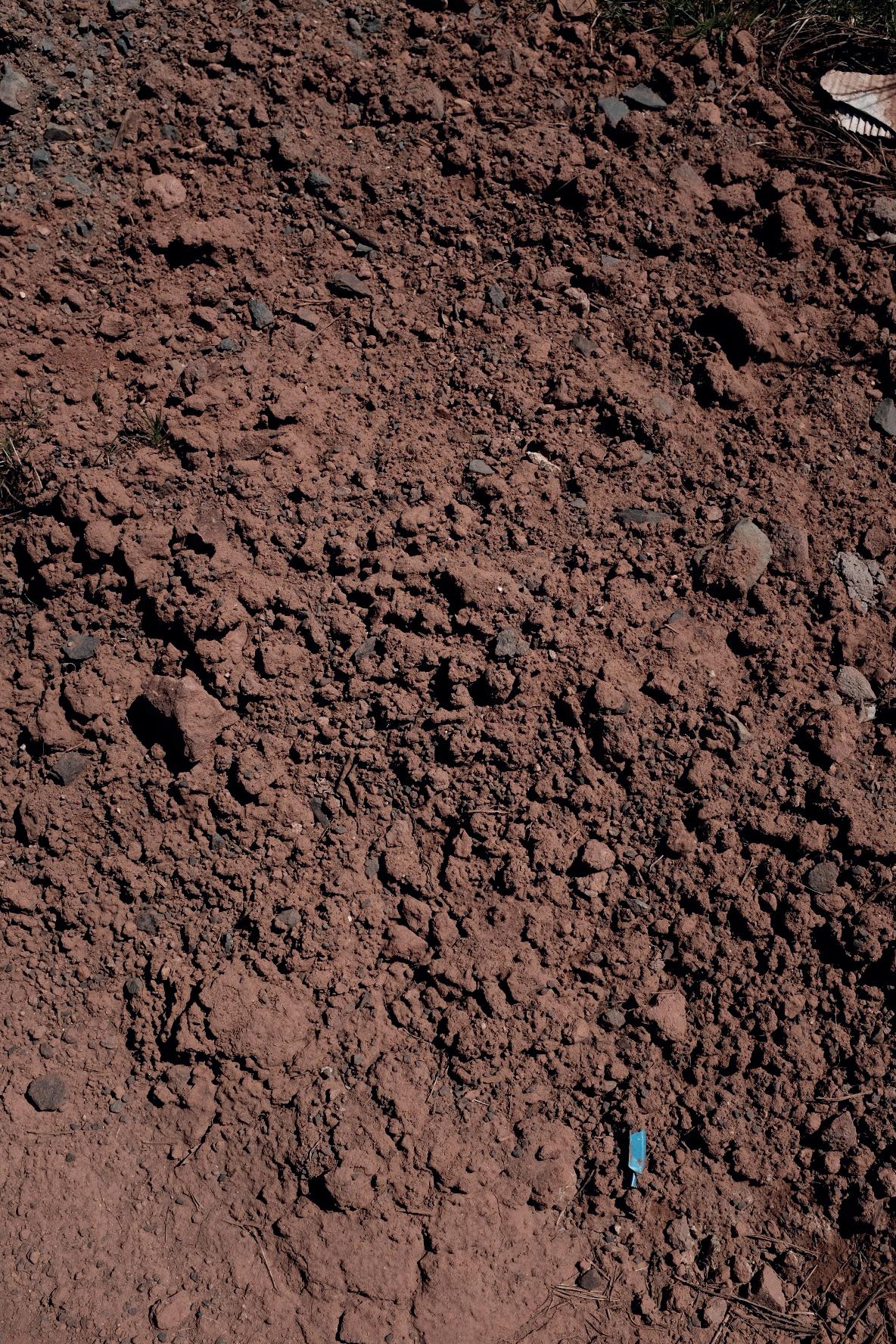
I took a bath with the moon
Wild pink granitic clay and weathered basalt from Ardèche
Fired in oxidation at 1220°C
ø 31.5 cm
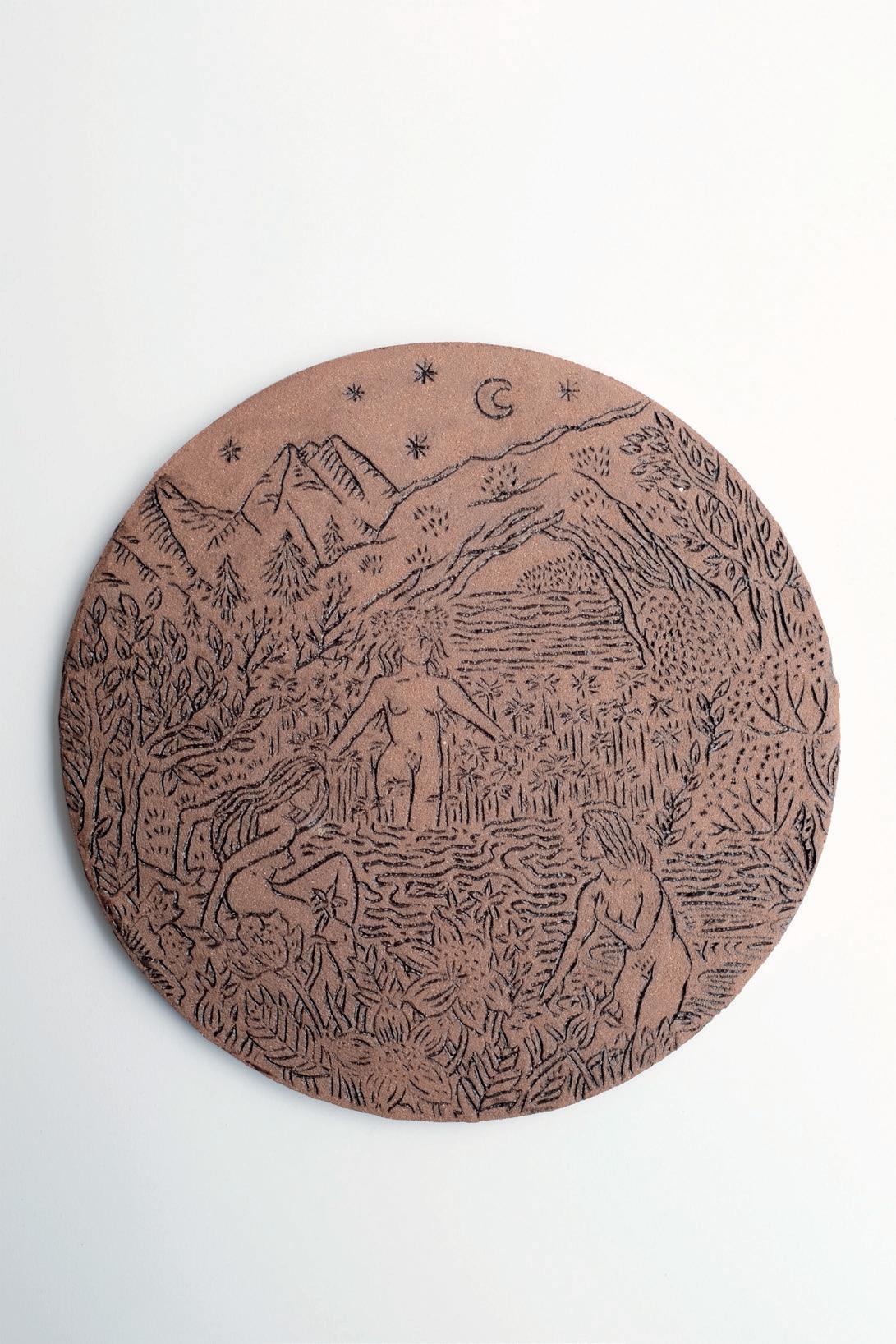
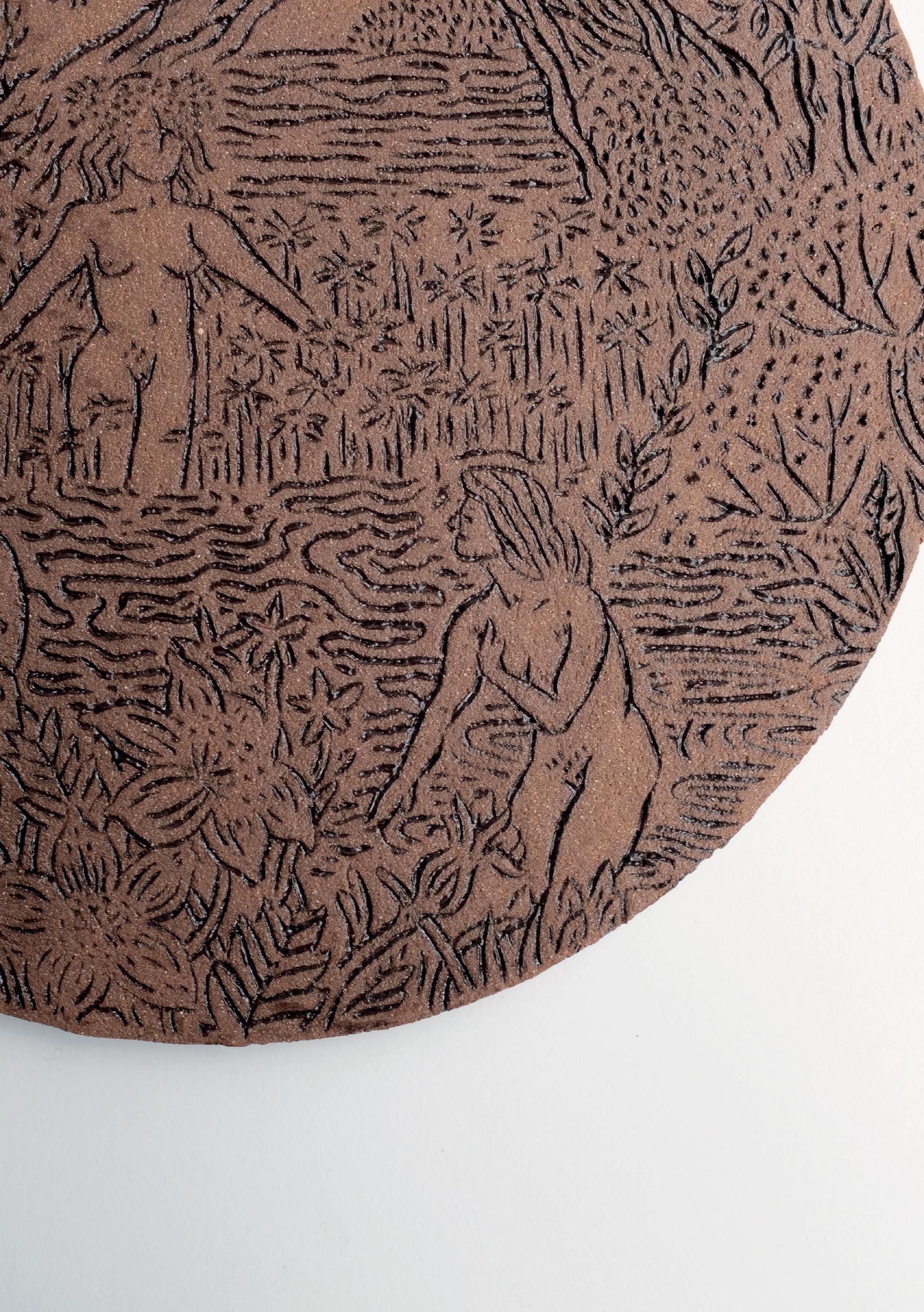
Remember that time we found the old book in the dusty attic, and we wanted to brew a magic potion?
“Different times of the lunar cycle can produce different energetic effects” it said
“Waning moon: best for forgiveness, letting go, giving thanks, releasing, and grounding.”
We plunged up to the navels in the mirror of frozen water.
“The sky must be clear so the water can absorb all the silver rays through the glass jar”.
But the first time the ostrich egg yolk stuck to the bottom of the cauldron. The second time, the willow bark was too dry.
And that time we got distracted chasing fireflies?
Then we grew old, and we didn’t believe it any more.
The materials for this large tile were foraged in Ardèche. The refractory body comes from a deposit of weathered pink granite, while the vitrified clay that decorates it is made of a partially weathered red basalt found nearby.
The tile was decorated with the sgraffito technique.
Fernando Garcés‘I had contact with ceramics from a very young age. I discovered the pleasure of working with different clays and materials, surprised by its transformation as it passed through the kiln, the many creative possibilities. Ceramics helped me to “understand” the world of art, enjoy the pieces I found in museums, their history...’
‘My workshop is dedicated to making unique ceramic pieces using the potter’s wheel as the main tool, located in Talavera de la Reina, a world- renowned ceramic production center with centuries of tradition.’
‘Opposite materials coexist in my work, from white porcelain to rough clay, enhancing even more, if possible, the qualities of each one.’
Fernando Garcés studied ceramics at the Official School of Ceramics in Madrid. Throughout the last thirty years, his work has evolved as a result of experience, study and constant relationships with artists and potters from different countries. In 1991 he joined the “Talavera” School of Art as a professor of Ceramics, of which he was director from 2014-2017.
Fernando’s work can be seen in different museums, institutions and national and international collections including Museum of the City of Madrid, Ceramic Museum of Deruta, Italy, Museum of Fine Arts of Kaoshiung, Taiwan, andFLICAM, International Contemporary Ceramic Art Museum, Fuping, China, among others.
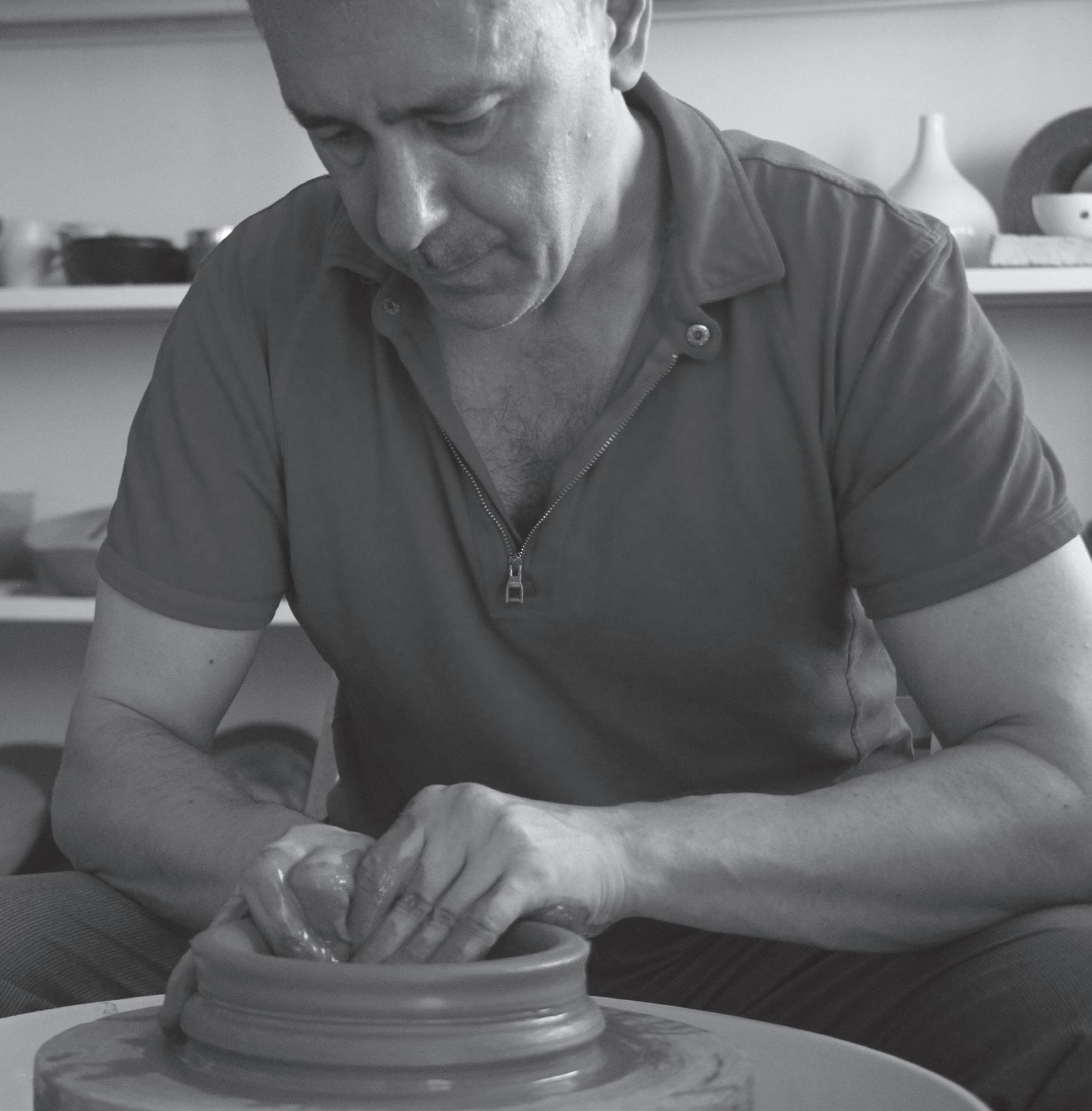
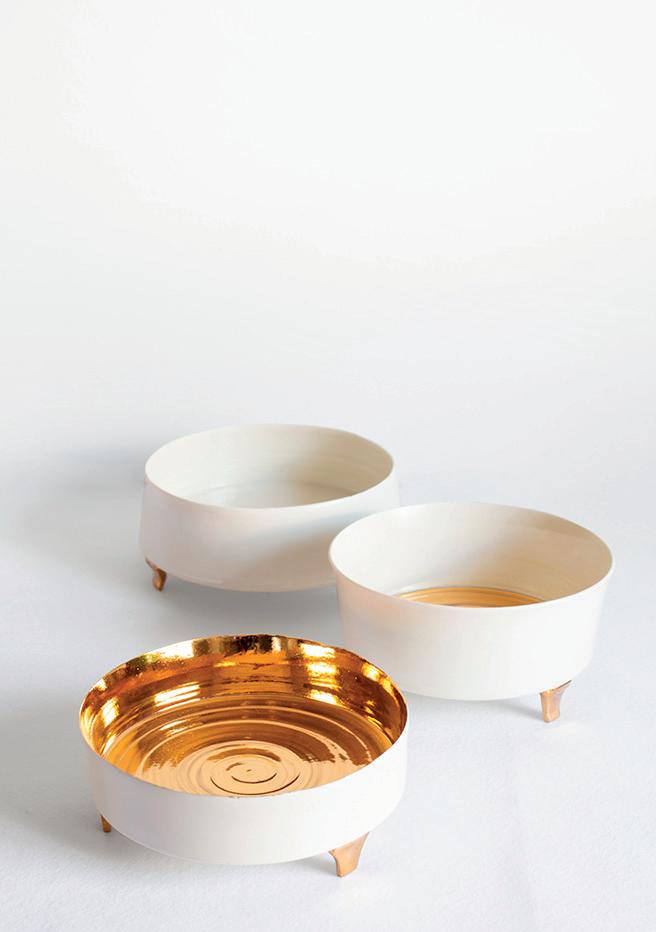
About the series White Star:
Wheel-thrown porcelain vessels, with straight shapes, and sometimes asymmetrical, broken and textured lips, which bring tradition closer to our days, evoking the most classic and elegant European porcelains of past centuries with a renewed classicism.
The pieces transmit delicacy and strength at the same time, maintaining the freshness with which they came out of the potter’s wheel. Finger marks can be seen on them, which make each piece unique and break the monotony of the surface.
They rest on small porcelain legs, also golden, which create interesting contrasts between the irregular and textured edge of the vessel, and the precise and sharp legs on which it stands.
Fernando GarcésWhite Star 1
Wheel-thrown and glazed porcelain with gold lustre
H 24 cm, ø 9 cm
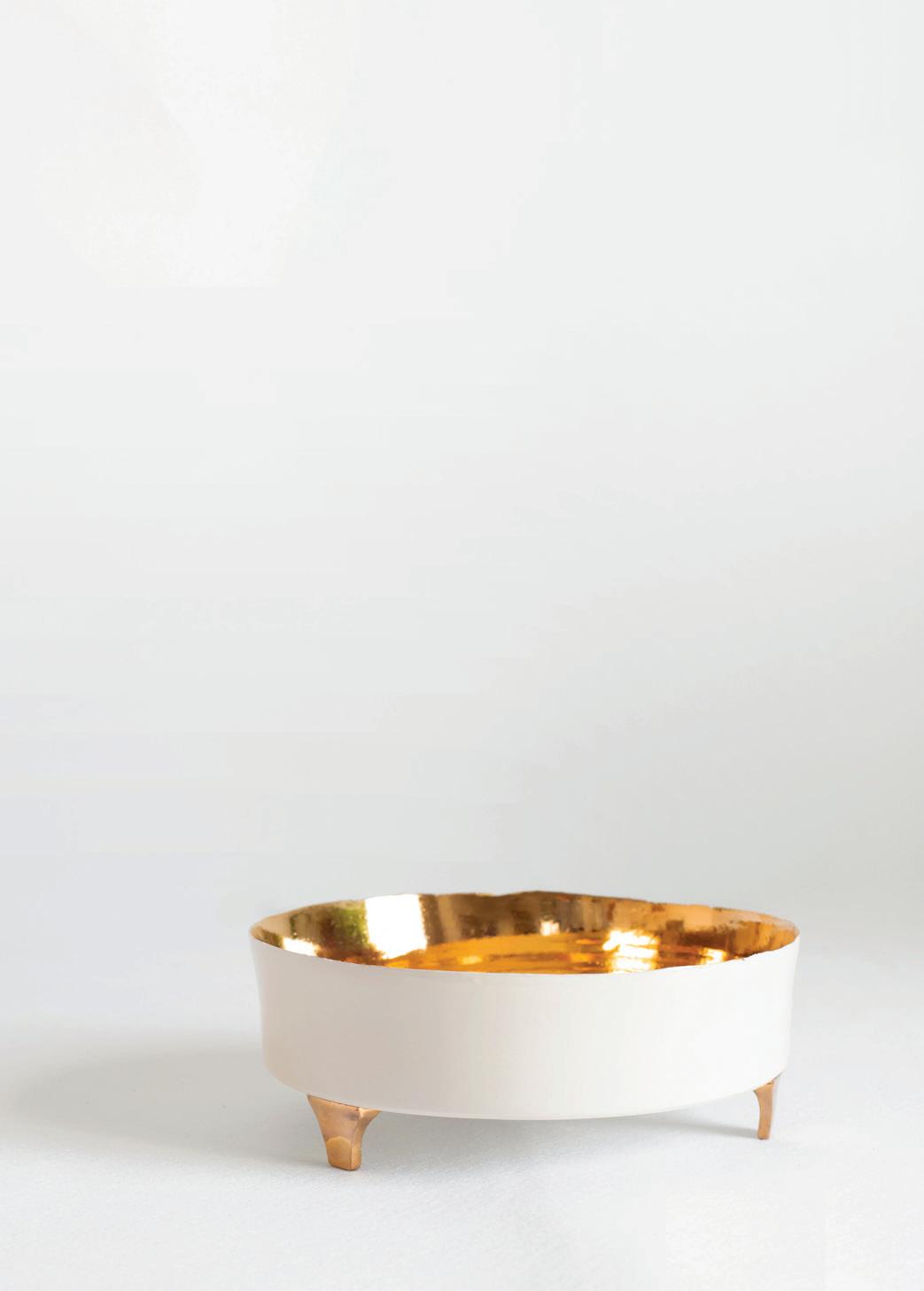
White Star 3
Wheel-thrown and glazed porcelain with gold lustre
H 28 cm, ø 11.5 cm
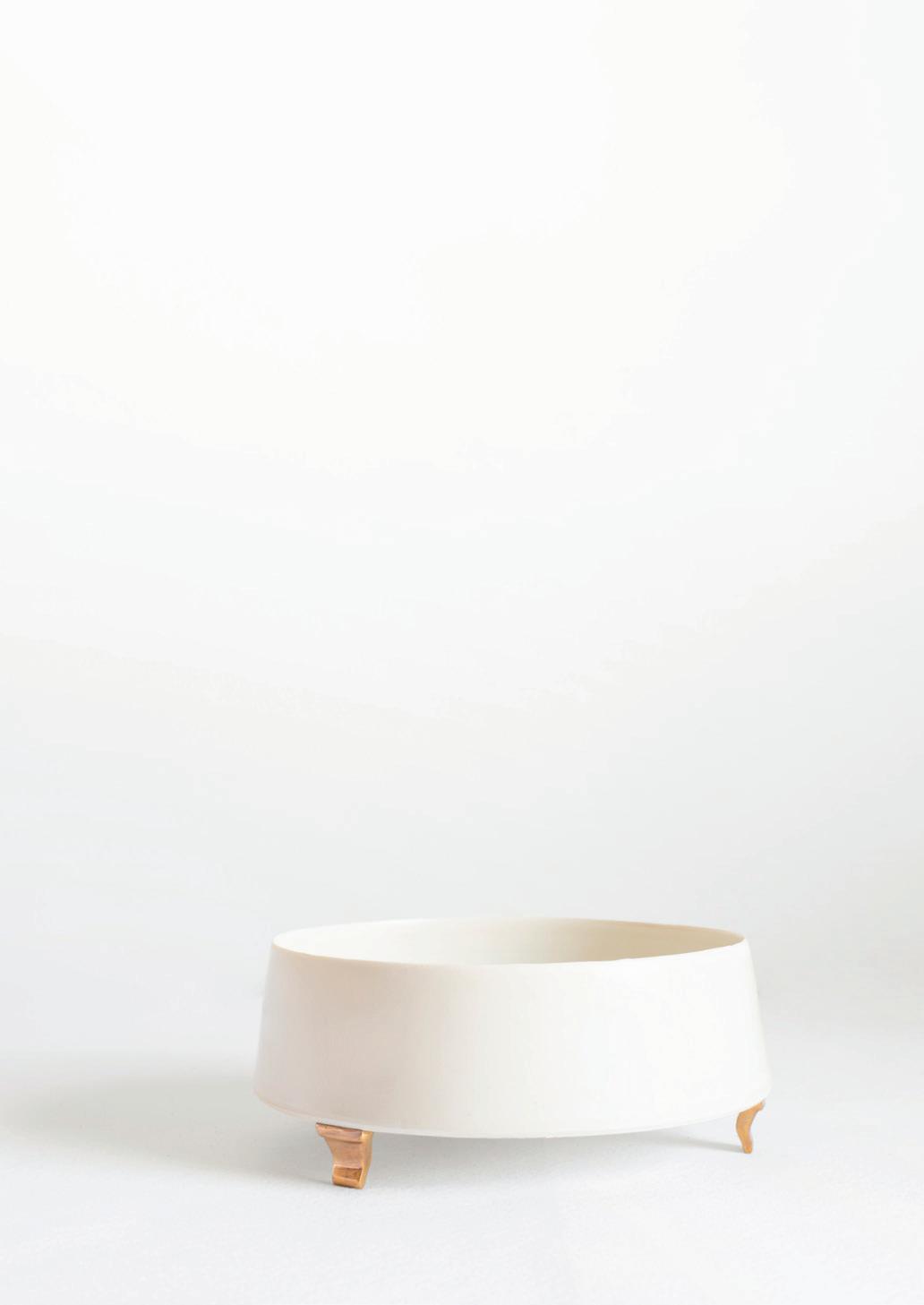
White Star 2
Wheel-thrown and glazed porcelain with gold lustre
H 24.5 cm, ø 12.5 cm
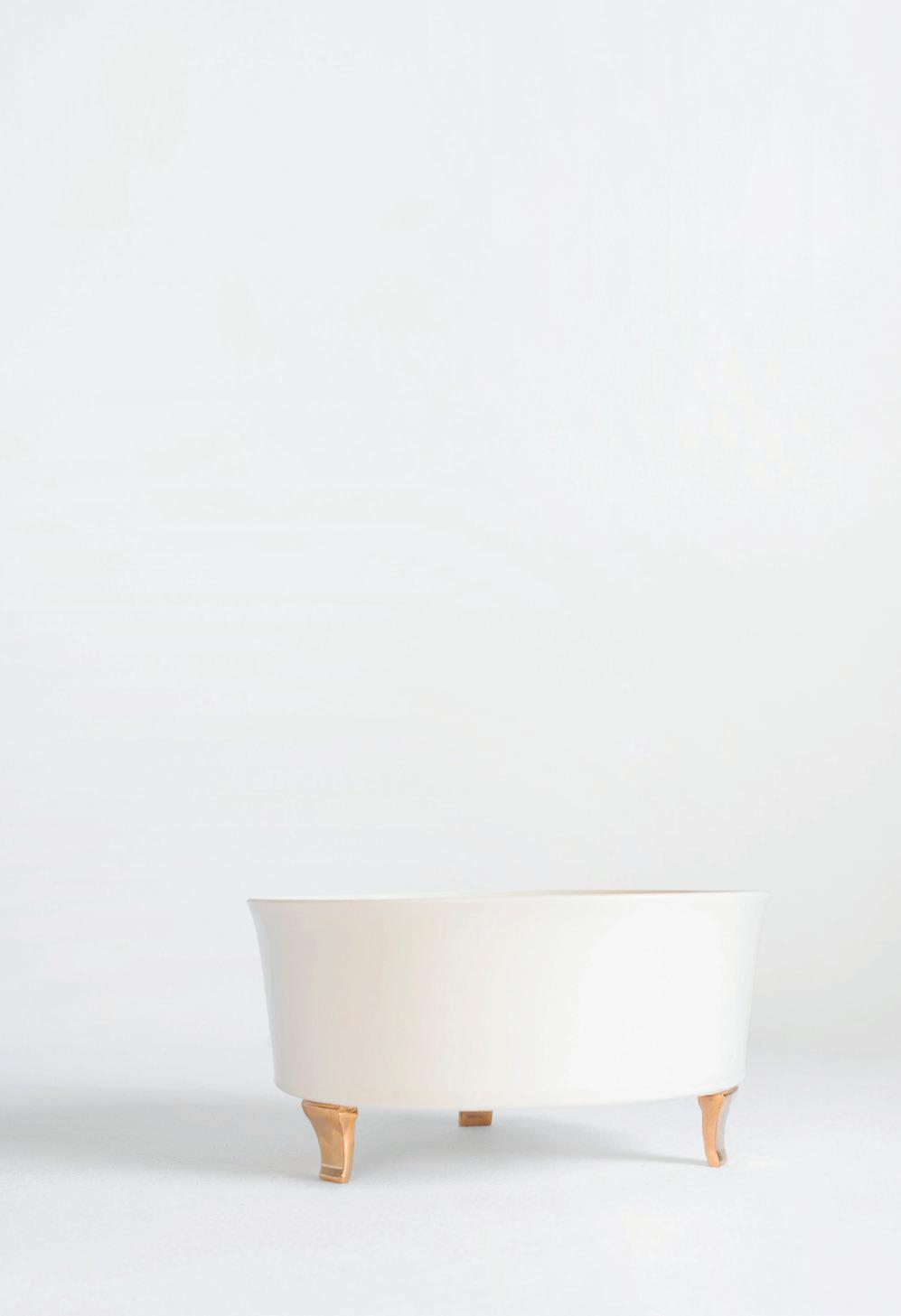
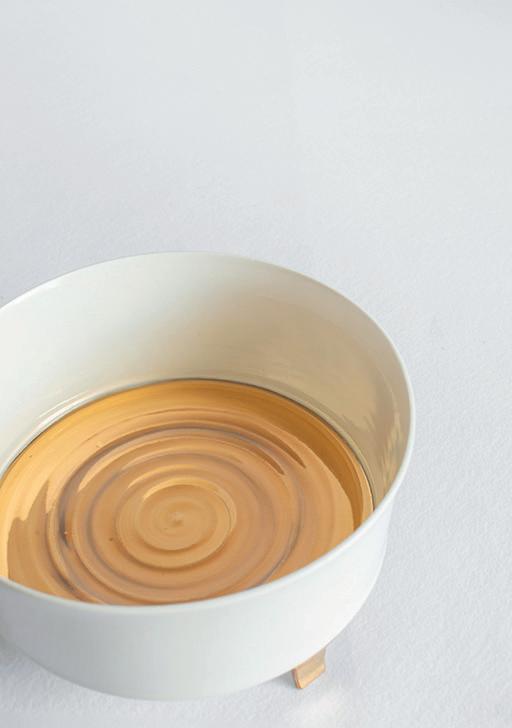

About the series Southern Skies:
A pair of semicircular pieces, thrown in white stoneware, which contrast between fullness and emptiness, resounding and lightness, between the blue of the southern skies and the warm glow of the sun, which with simple profiles dances freely on the surface where it rests, imposing its presence to connect us to the earth.
The exterior glaze, created by simple ash melted during firing, offers us characteristic and unmistakable surfaces, which evoke the effects caused by ancient oriental kilns.
Clear and concrete work, where the essence of tradition, nature and forms coexist.
Fernando GarcésSouthern Sky 1
Wheel-thrown stoneware with ash glaze and gold lustre
ø 31 cm
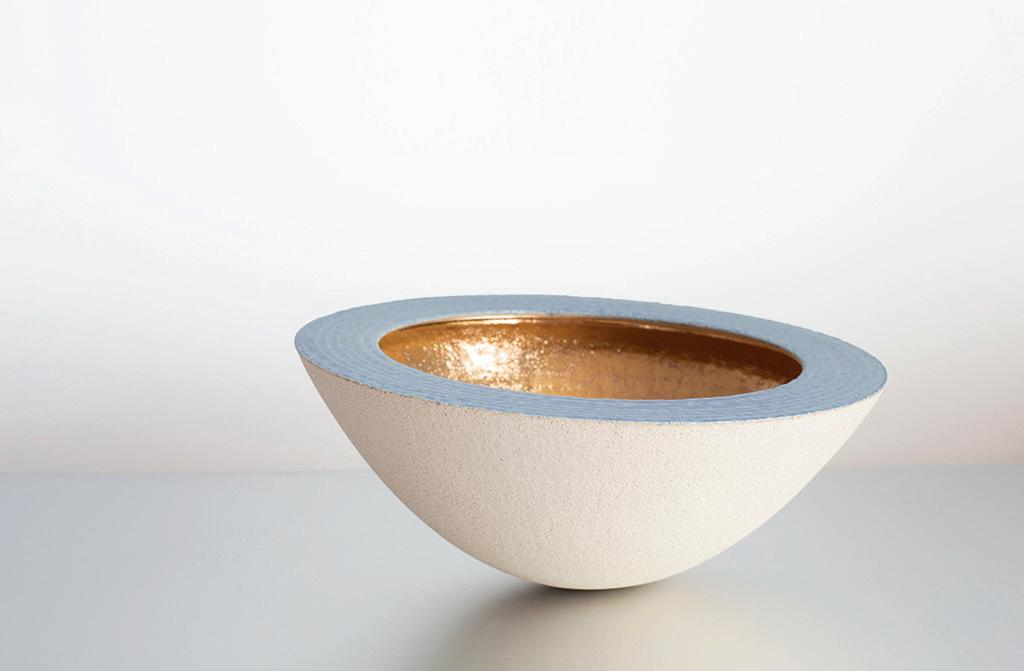
Southern Sky 2
Wheel-thrown stoneware with ash glaze
ø 29 cm
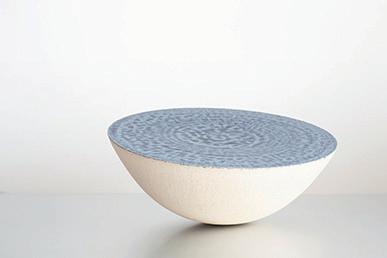
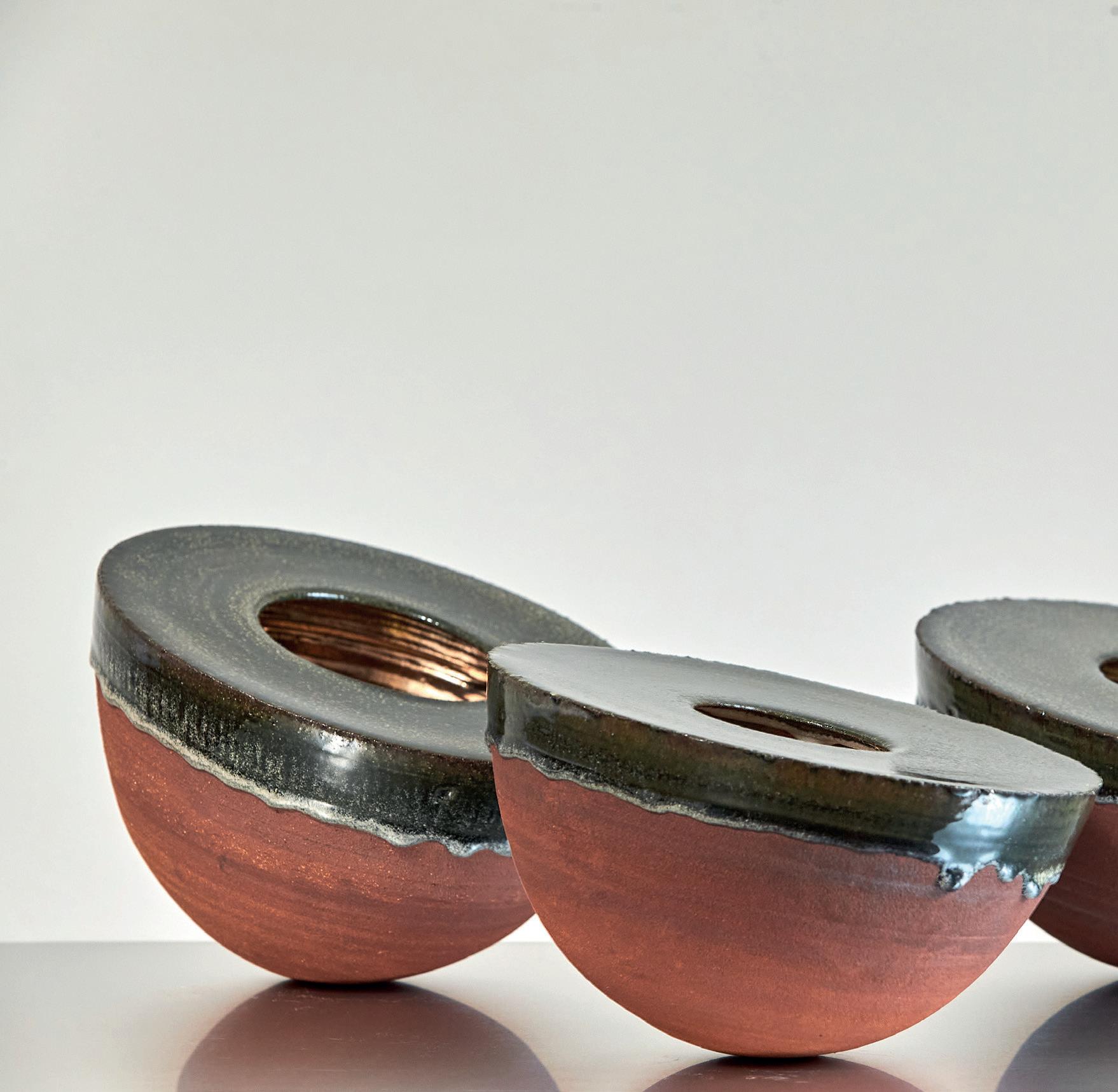
About the series Hidden Light:
Resounding pieces, with simple profiles, to which we can peek into, attracted by the sparkles of gold, moving freely on the surface on which they rest.
The gold luster of the interior is perceived as the glow of lava coming out of a volcano, or the flash of lightning in the sky, and contrasts with the exterior finish, in which the melted black glaze slides over the nude paste of the color of the earth with the force of nature.
In them you can see the way in which they have been built, the marks of the potter’s hands, the natural flow of the glazes.
Fernando GarcésHidden Light 1
Wheel-thrown stoneware, black glaze and gold lustre
ø 25 cm
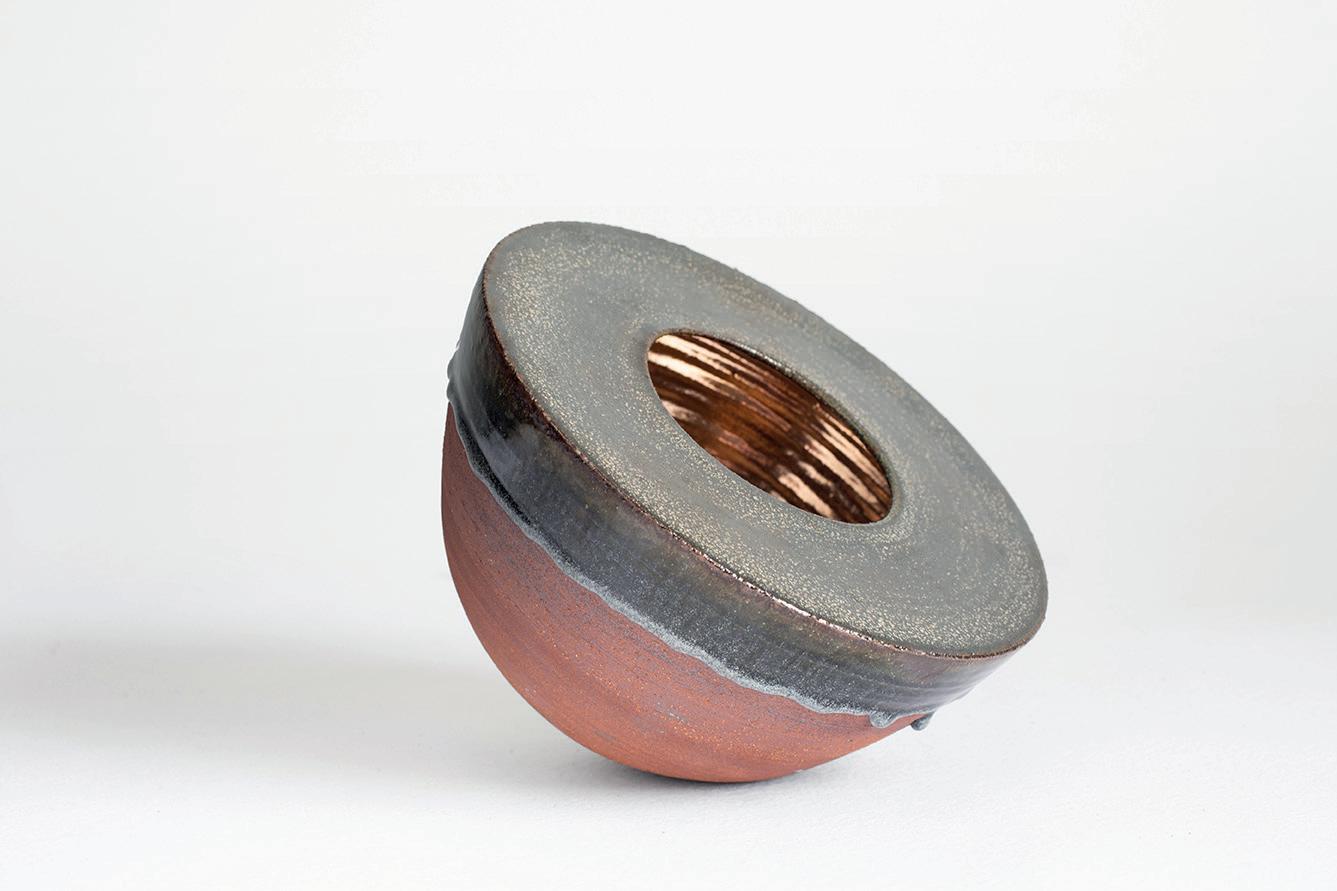
Hidden Light 2
Wheel-thrown stoneware, black glaze and gold lustre
ø 26 cm
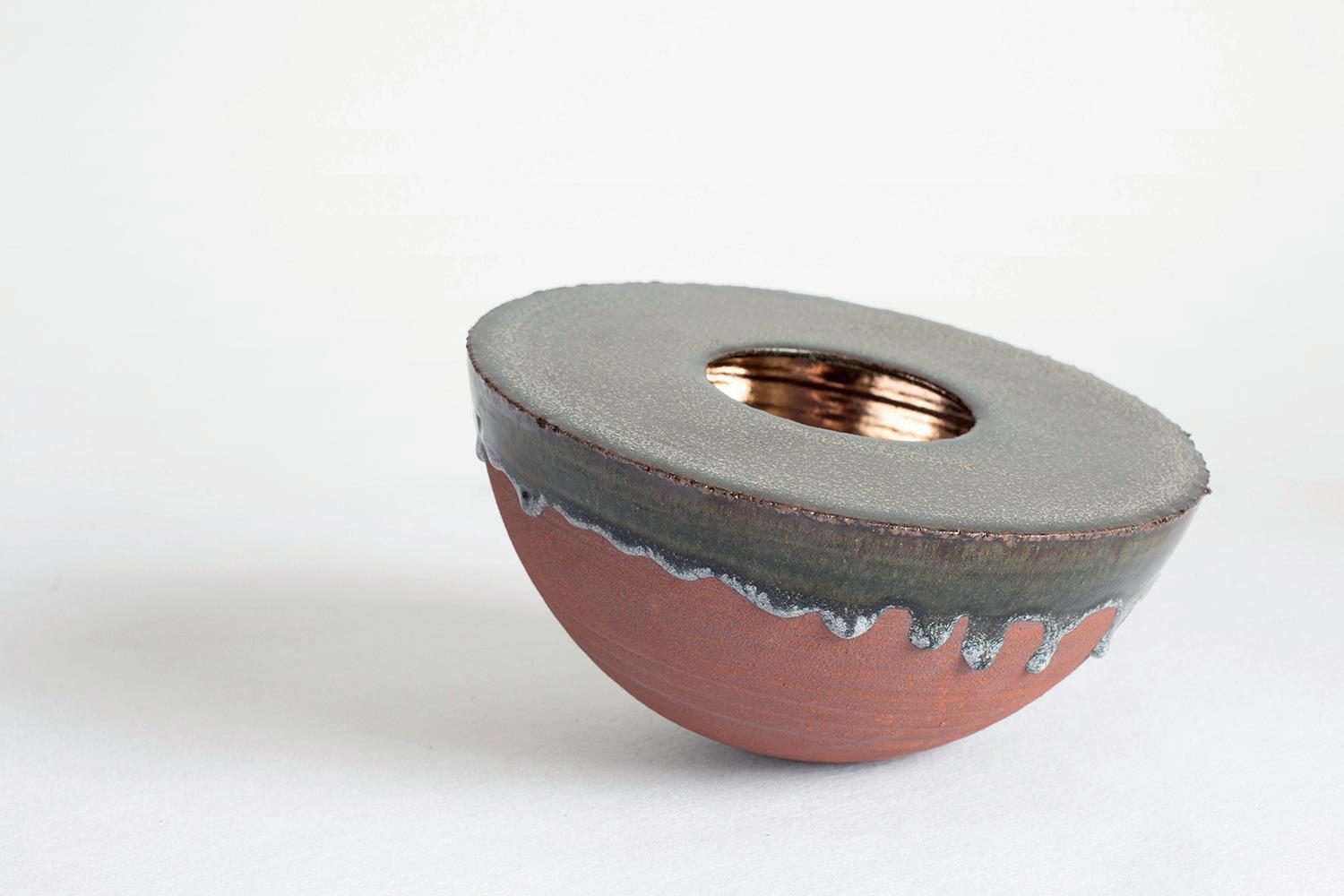
Hidden Light 3
Wheel-thrown stoneware, ash glaze and gold lustre
ø 26 cm
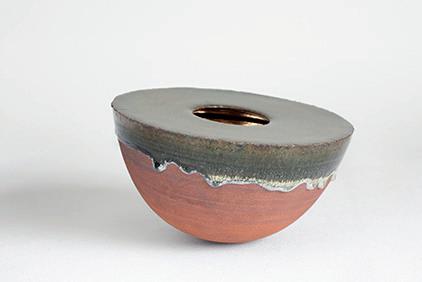
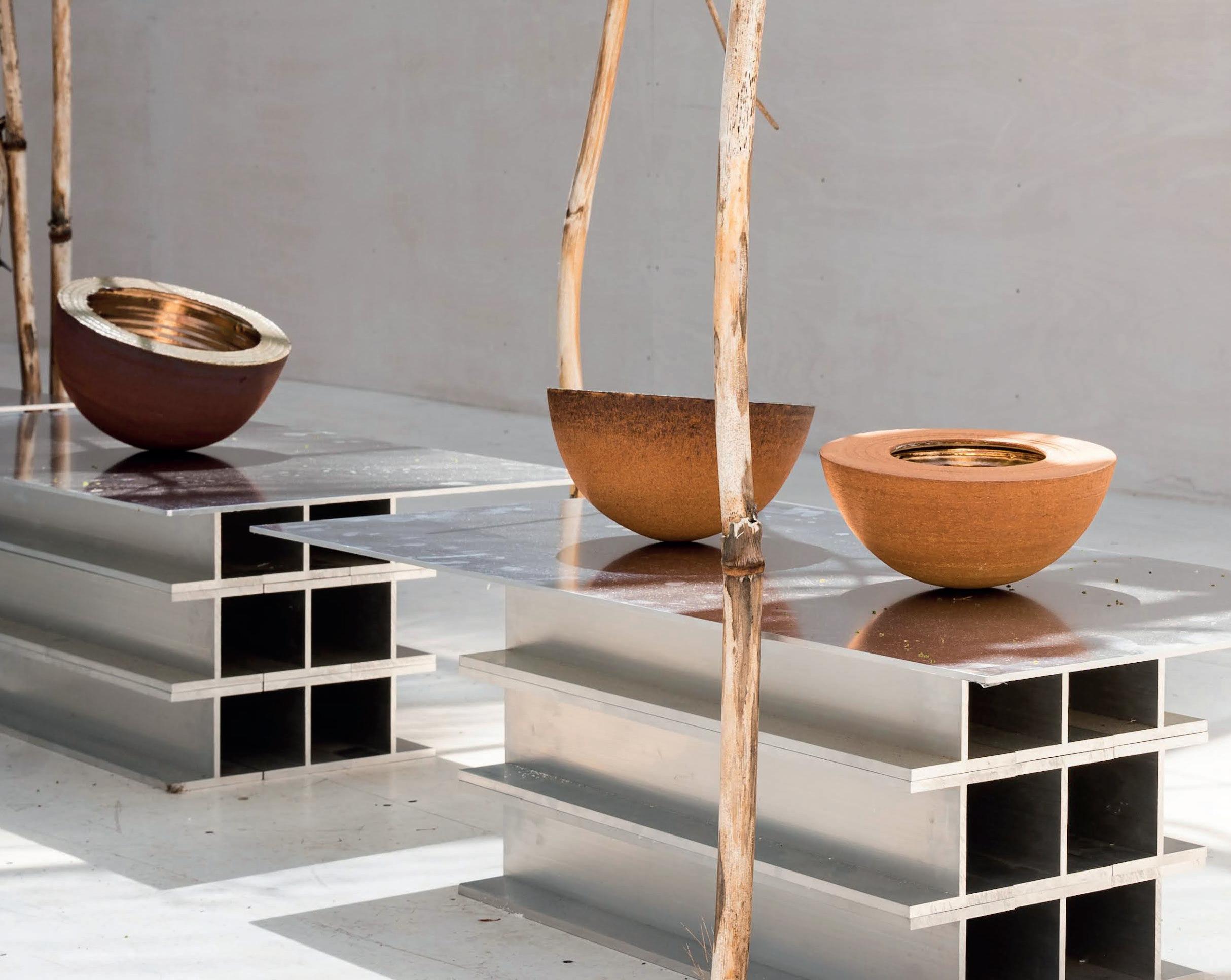 Photograph by Will Hearle for OmVed Gardens
Photograph by Will Hearle for OmVed Gardens
The clay, sometimes naked, evokes the colours of the earth, and show the potter’s fingerprints as the only decoration. The ash are transformed into glazes, creating rivers, fields, snow, water... The traditional techniques and the surrounding materials make each work unique, they bring us closer to nature, with its own personality.
The gold inside the pieces is perceived as the glow of lava coming out of a volcano, or the radiance of a lightning in the sky, while at the same time, it roots us with the production of Hispano-Moresque lusterware, or the golden European porcelains. The clean profiles, reduced to their essence and stripped of any distraction, focus on sobriety, tranquillity, rhythm, proportion, and movement, to transmit in a timeless way the essence of an ancient activity. Simple pieces that reflect the personality of the potter, his references, his tastes, his training, and his experience.
Early Snow
Wheel-thrown stoneware and white glaze
ø 25 cm
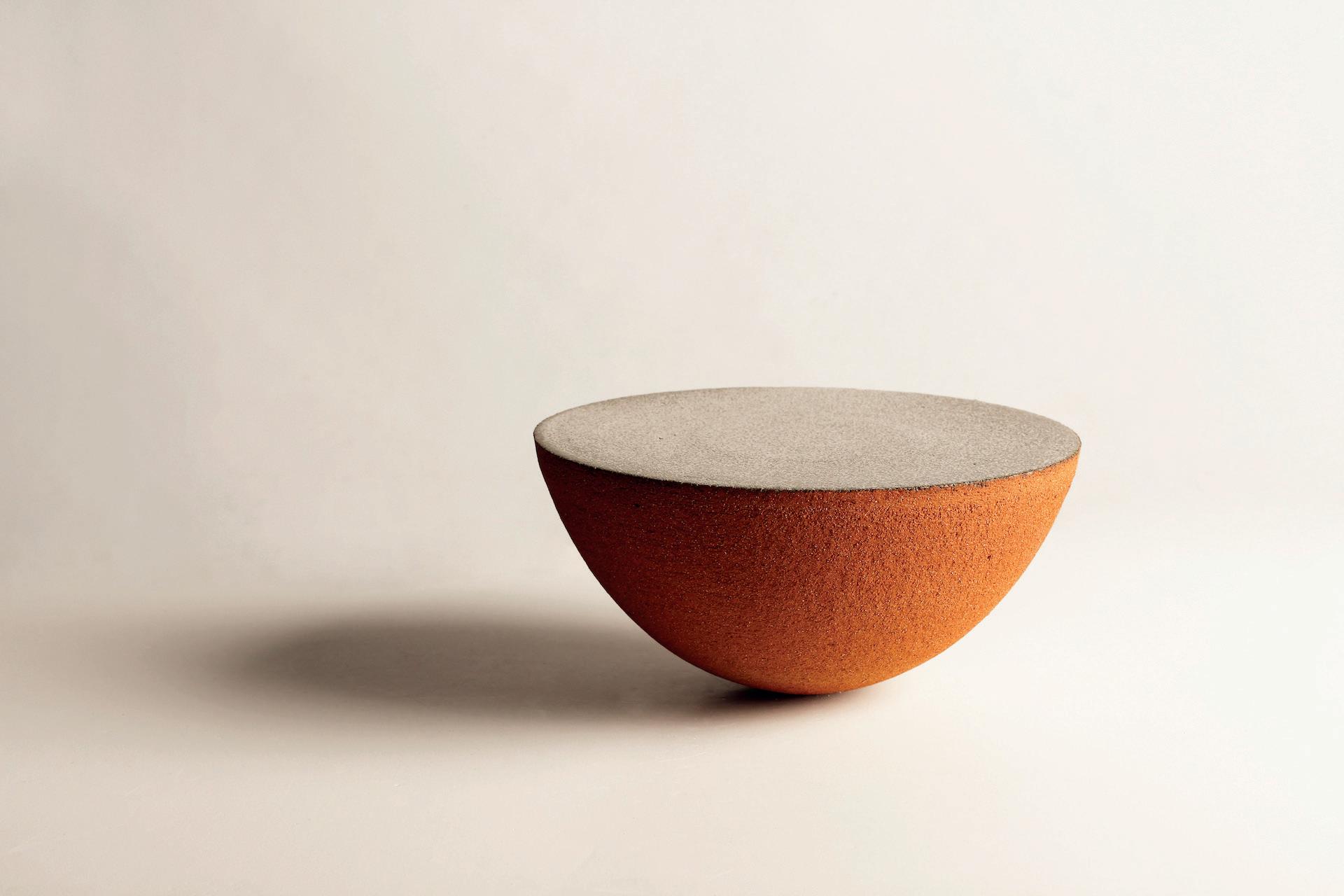
Midsummer
Wheel-thrown stoneware and white glaze
ø 23.5 cm
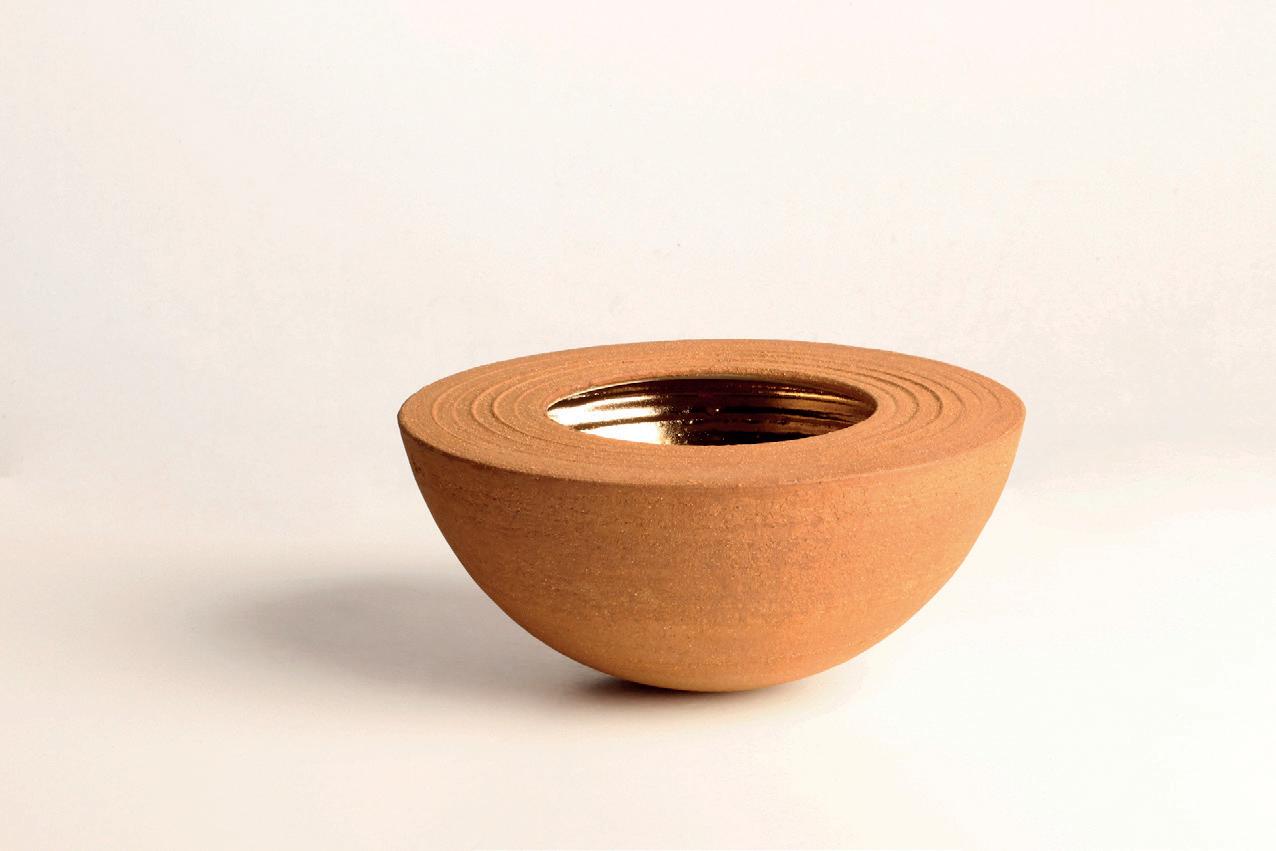
Volcano
Wheel-thrown stoneware, ash glaze and gold lustre
ø 25.5 cm
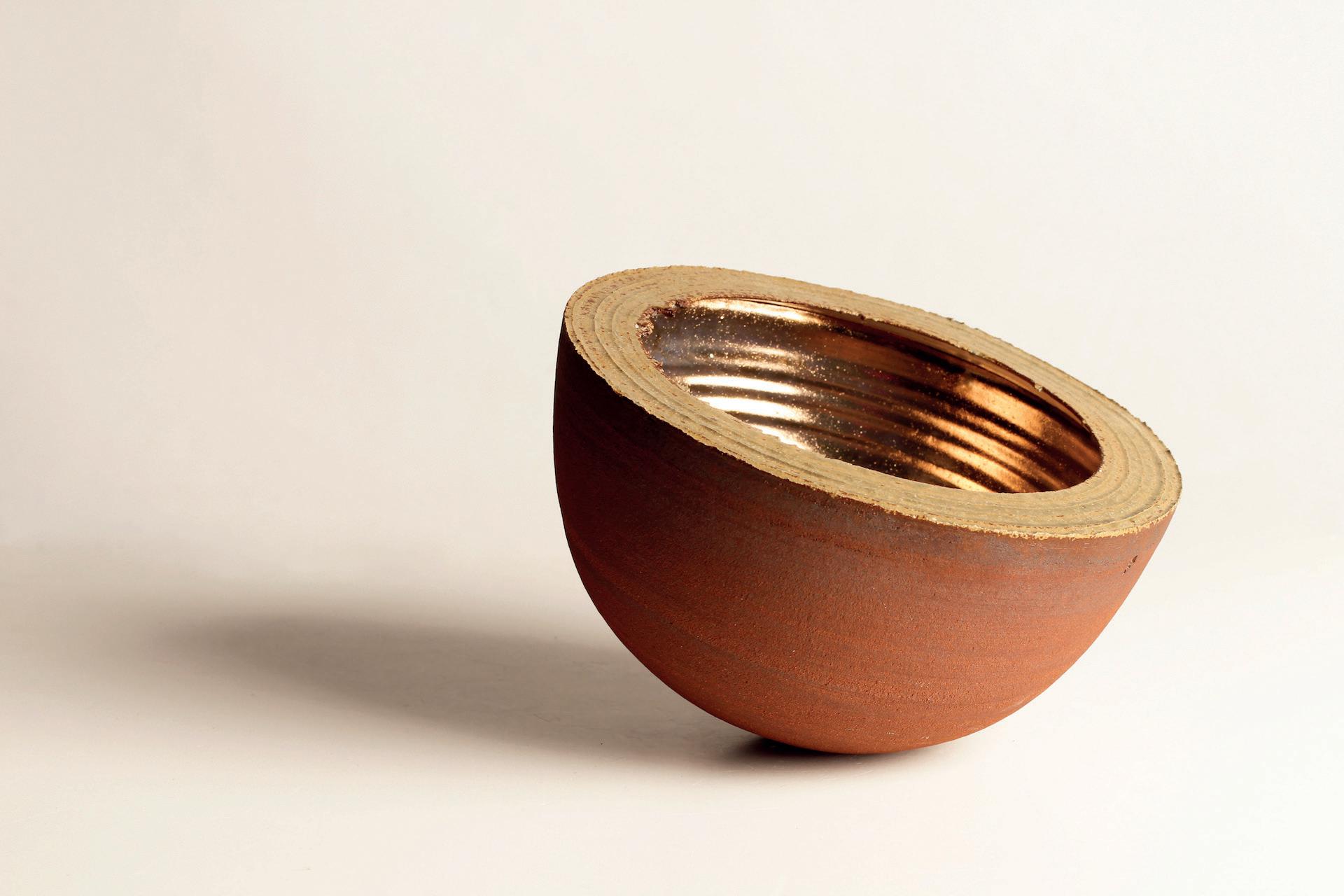
Autumn 1
Wheel-thrown stoneware and white glaze
ø 24.5 cm
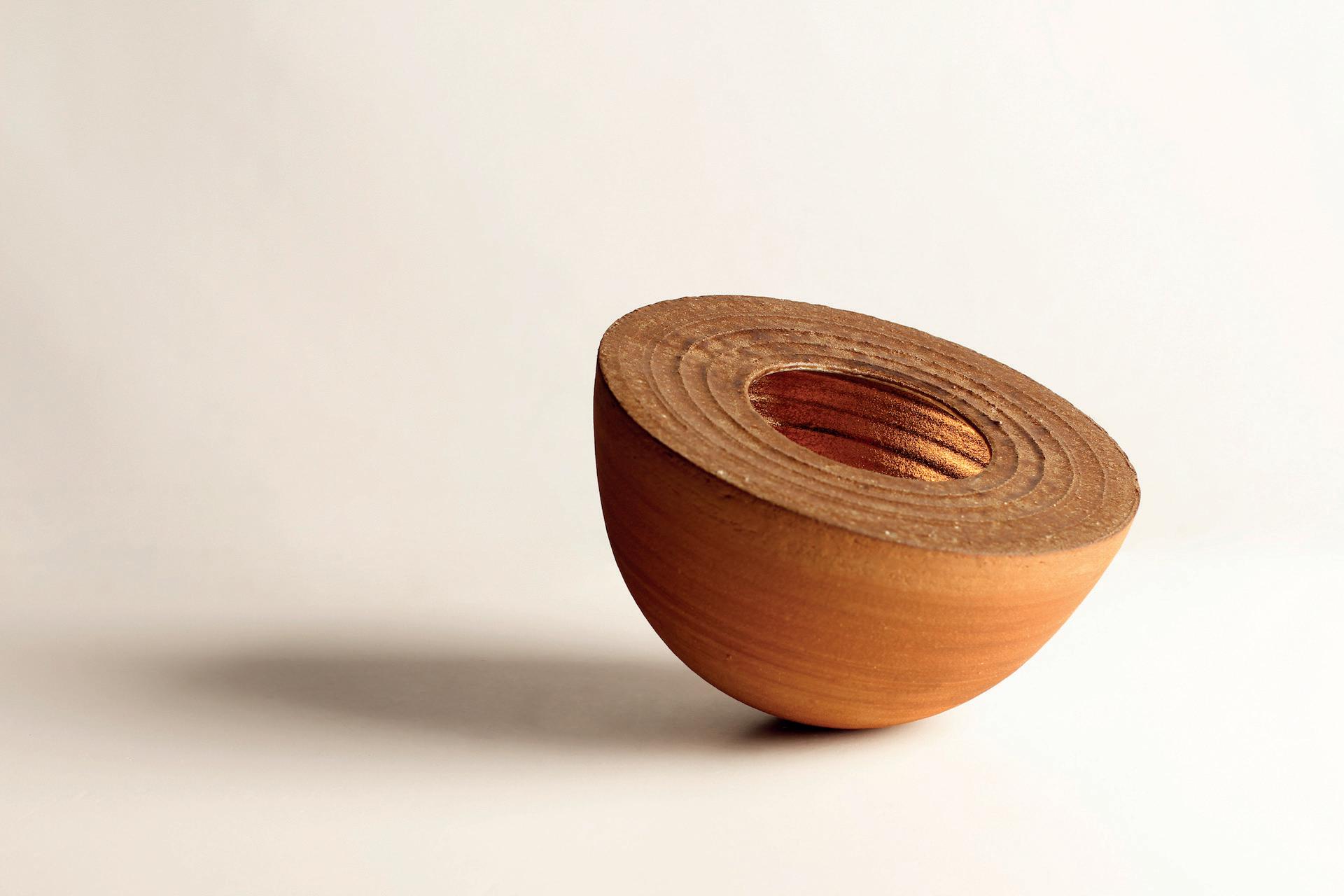 Matthew Cronshaw
Matthew Cronshaw
‘At the very core of my practice is a mastery of material. For the past three years I have been working in porcelain and I have lead myself down the path of mastering the techniques and processes that reflect what I see when I think of porcelain. I think of a showcase in refinement, delicacy, translucency, texture and decadence. Each piece perfectly paired back, no distractions from the material itself: the only allowable expressions are ones that enhance what I imagine porcelain should be.’
‘A harmony must be struck between what the material wants to exhibit and what I myself as the craftsmen want to showcase. It is the desire to learn this joint language fully that guides my work, leading me down a path of forever changing, throwing, refining, trimming and firing.’
Matthew Cronshaw is a Manchester-based ceramicist. Self-taught, he uses porcelain to pursue technically difficult hand thrown forms with a contemporary aesthetic.
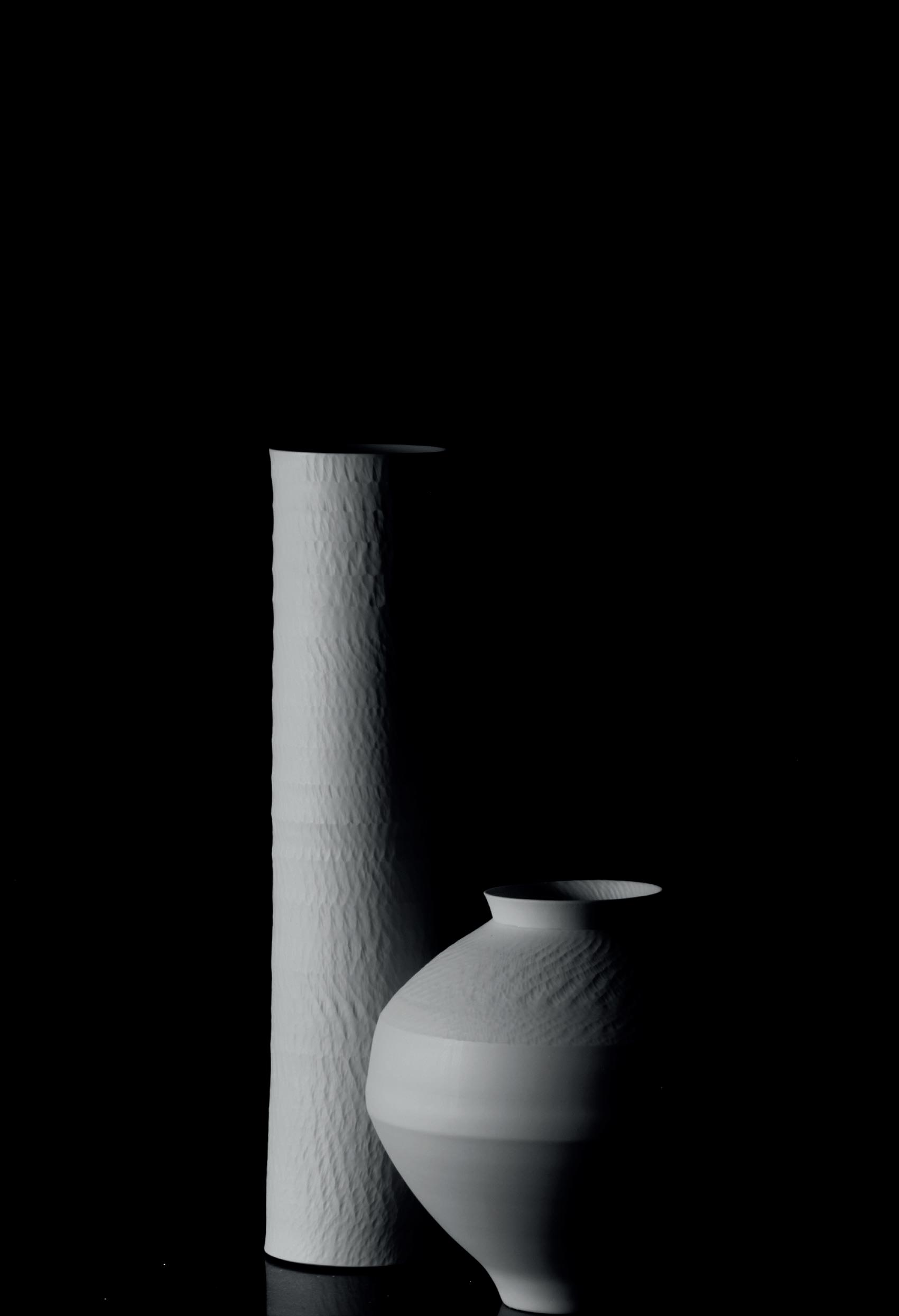
Moon Jar
Wheel-thrown porcelain with chattered surface
H 49 cm, ø 37 cm
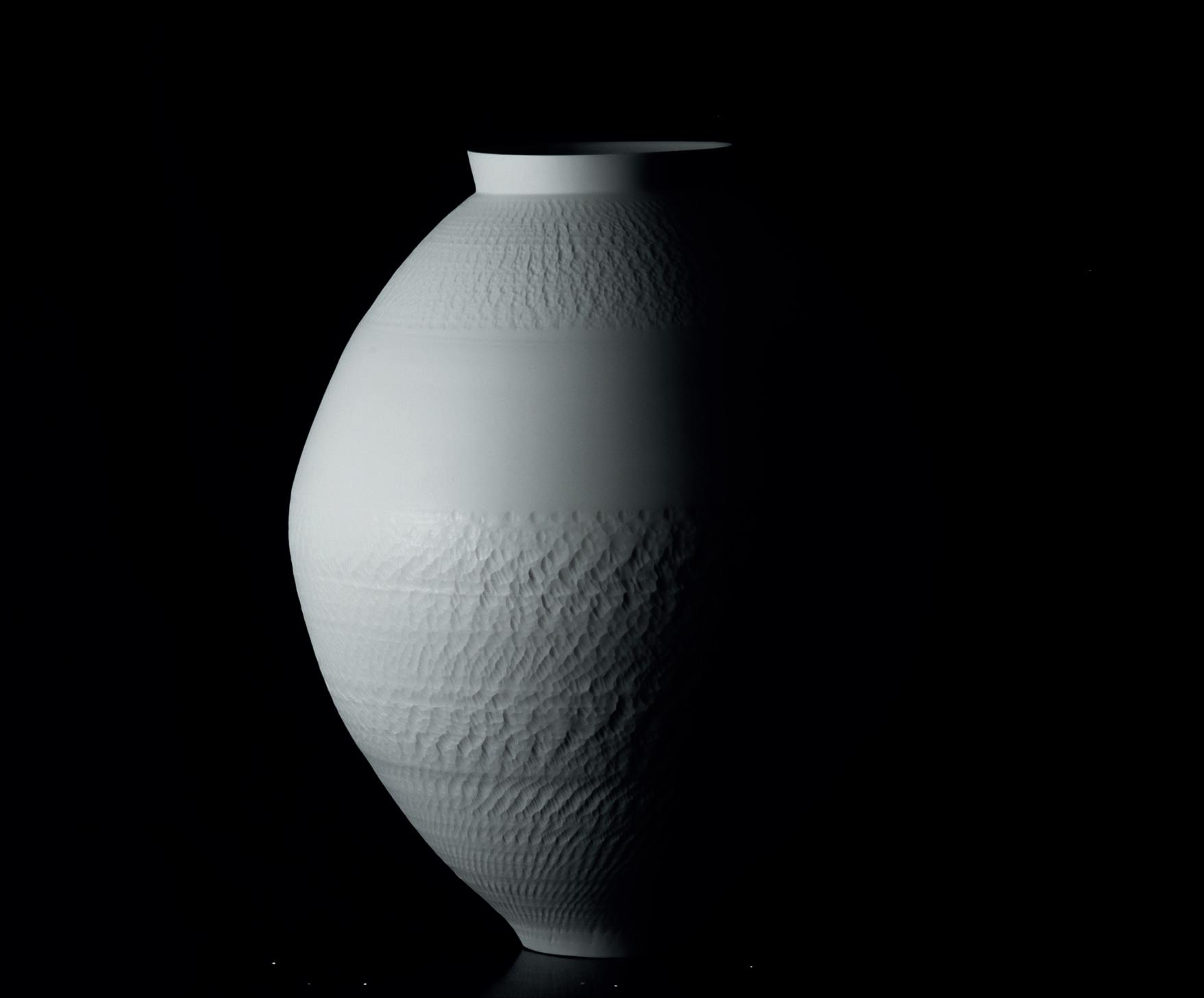
Moon Jars
Thrown in porcelain, Matthew’s Moon Jars explore and expand on the traditional Moon Jar forms and methods.
Drawn to the subtle flattening often found around the join of traditional moon jars, Matthew elaborates on this feature, accentuating its appearance.
The contrast between a smooth satin finish and chattered sections of the body bring attention, yet also veil the accentuated shape.
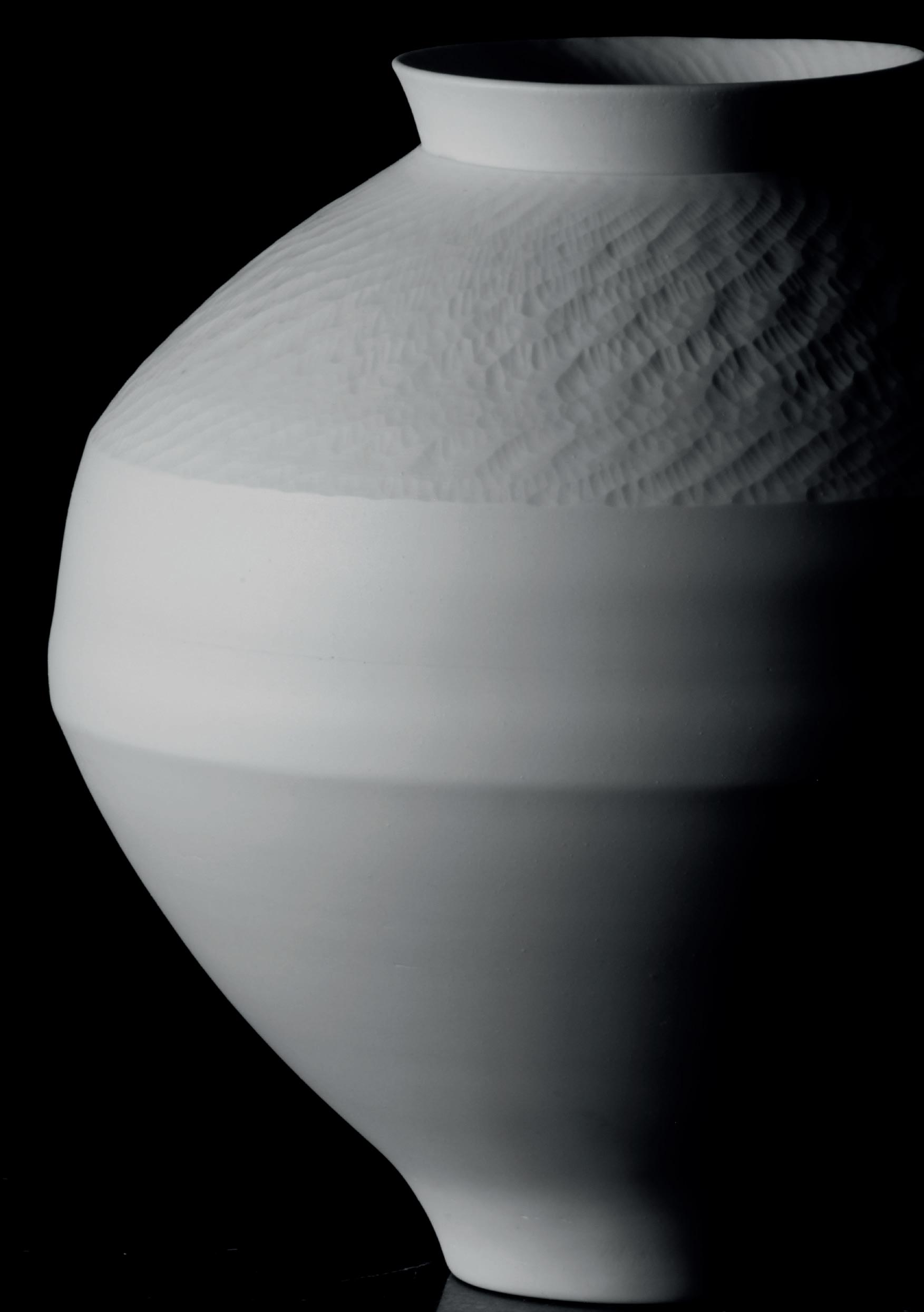
Moon Jar 2
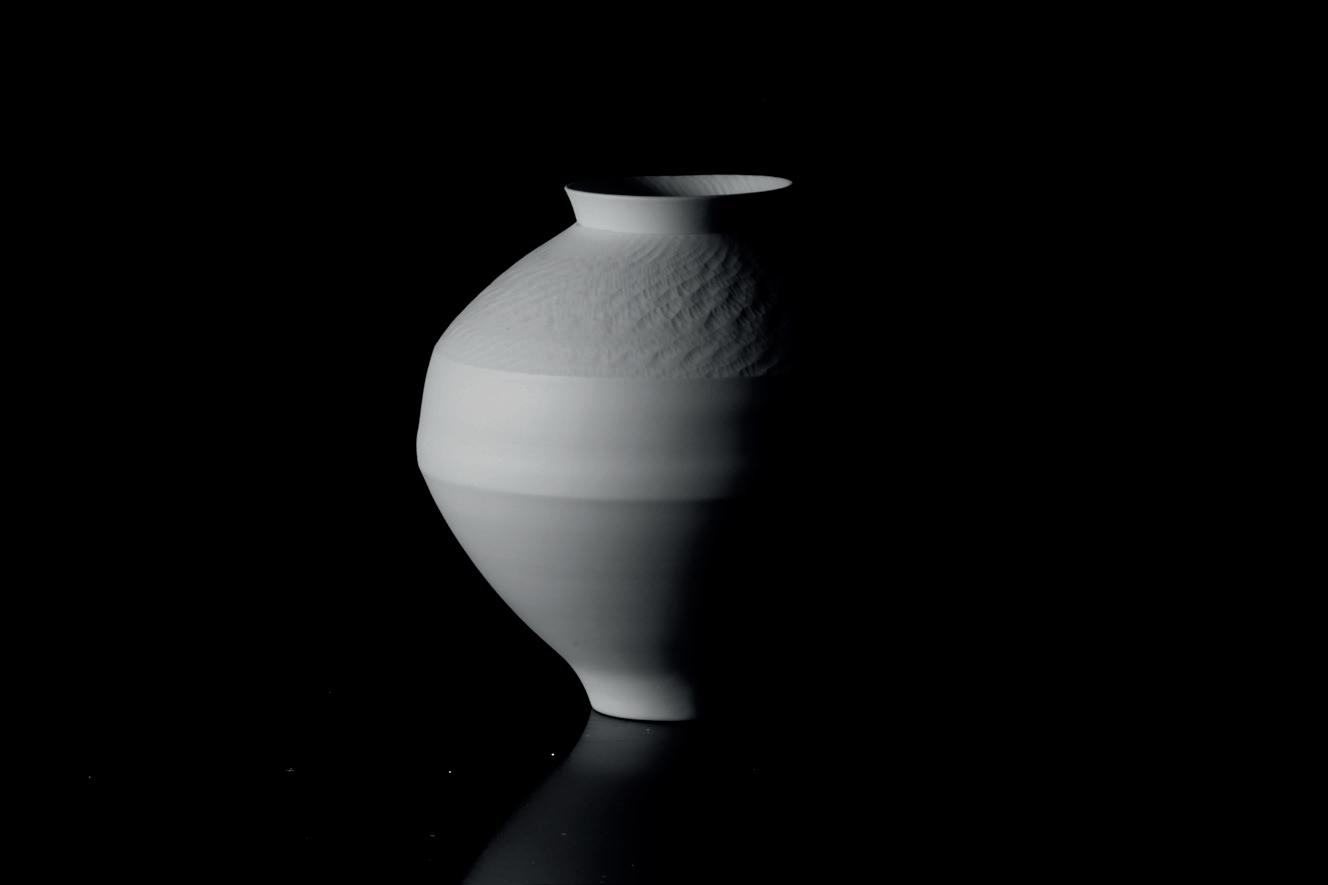
Wheel-thrown porcelain with chattered surface
H 24 cm, ø 23 cm
Lantern 1
Wheel-thrown porcelain with chattered surface
H 53 cm, ø 12 cm
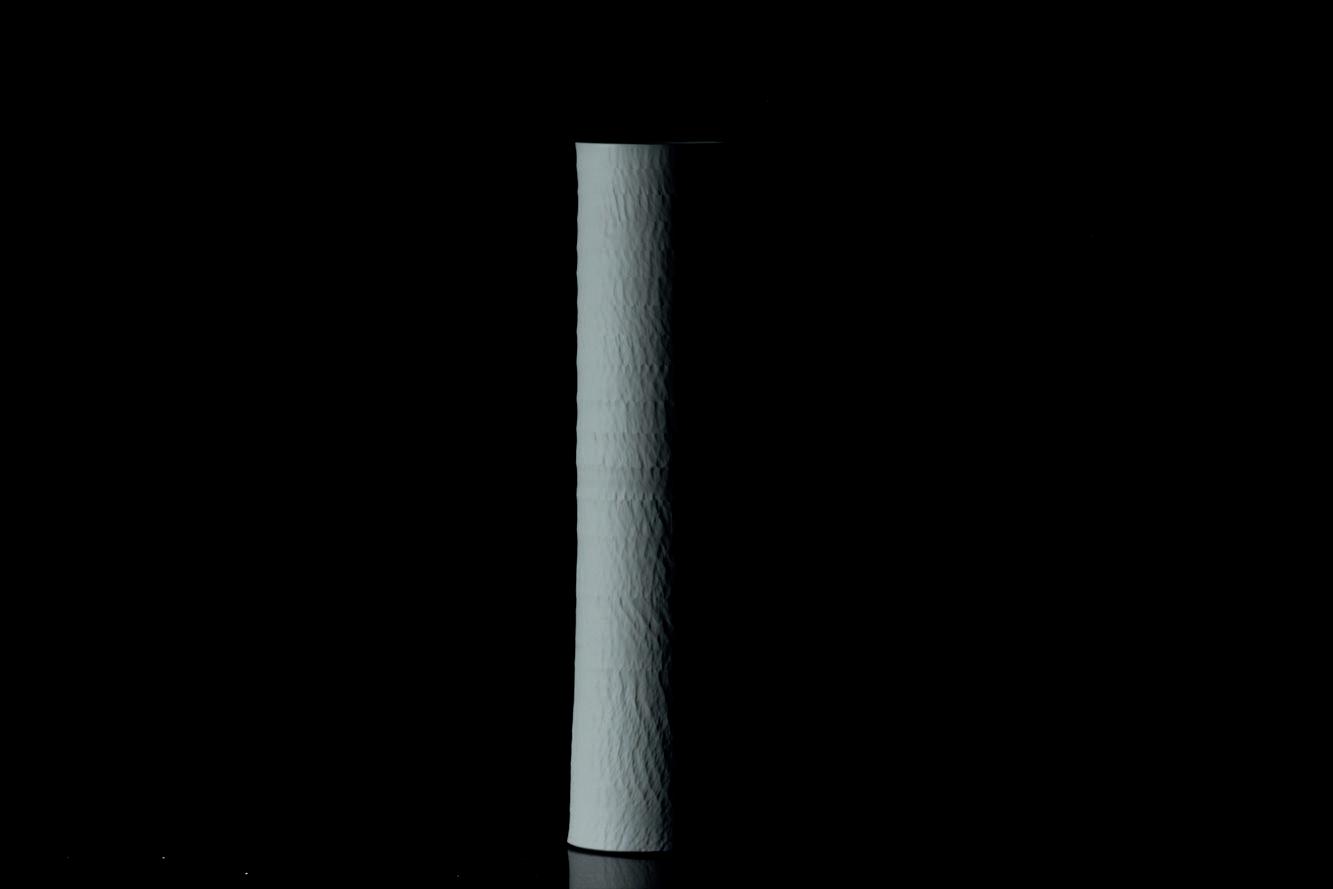
Lanterns
Matthew’s lantern cylinders explore further into light and shadow, which is thematic in his other works.
Lantern 1 is a tall narrow cylinder with segmented chattering, trimmed to a tolerance which utilises porcelains translucent qualities, highlighting the varying chatter marks when lit from the inside, offering a different perspective to this texture from his other works.
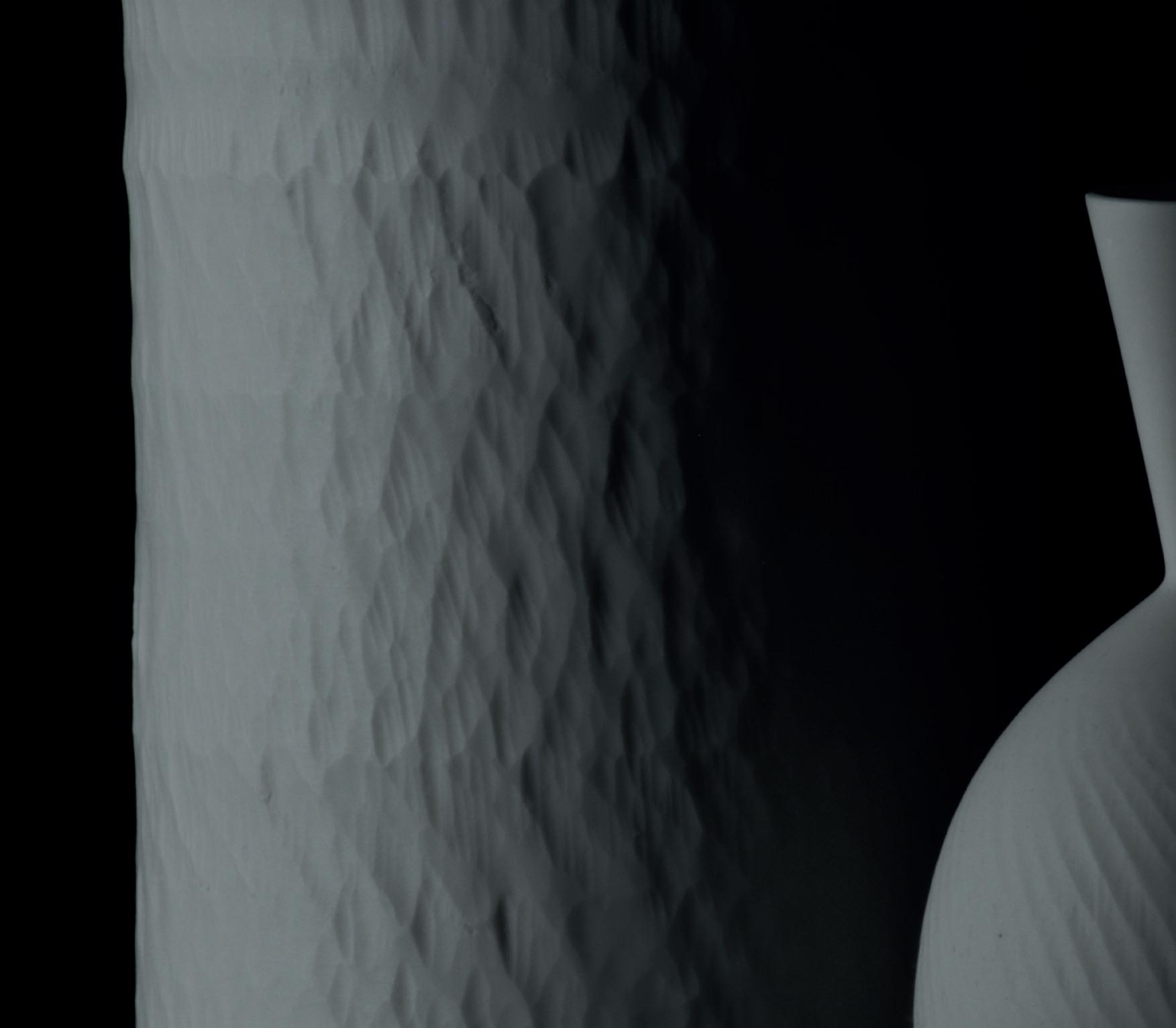
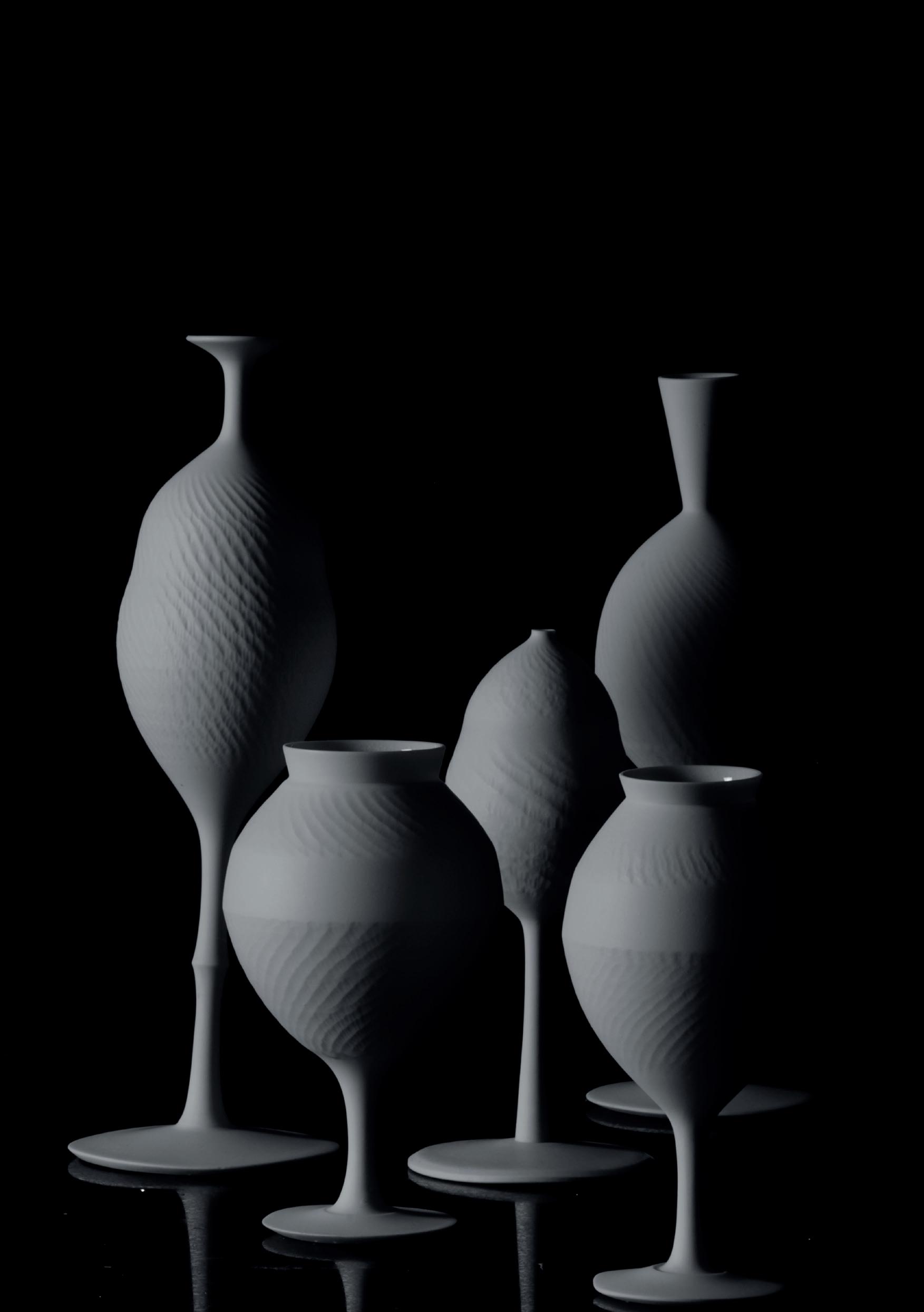
Stemmed Objects
Thrown in porcelain, Matthews stemmed objects are a an exercise into the technical difficulties of porcelain works.
Matthew tries to convey a harmony between architectural construction and firing methodology with a refined approach to aesthetic. Soft lines and delicate texture veiling the arduous and technical practicality.
Stemmed Object 1
Wheel-thrown porcelain, snow glaze interior and chattered body
H 29 cm, ø 9 cm
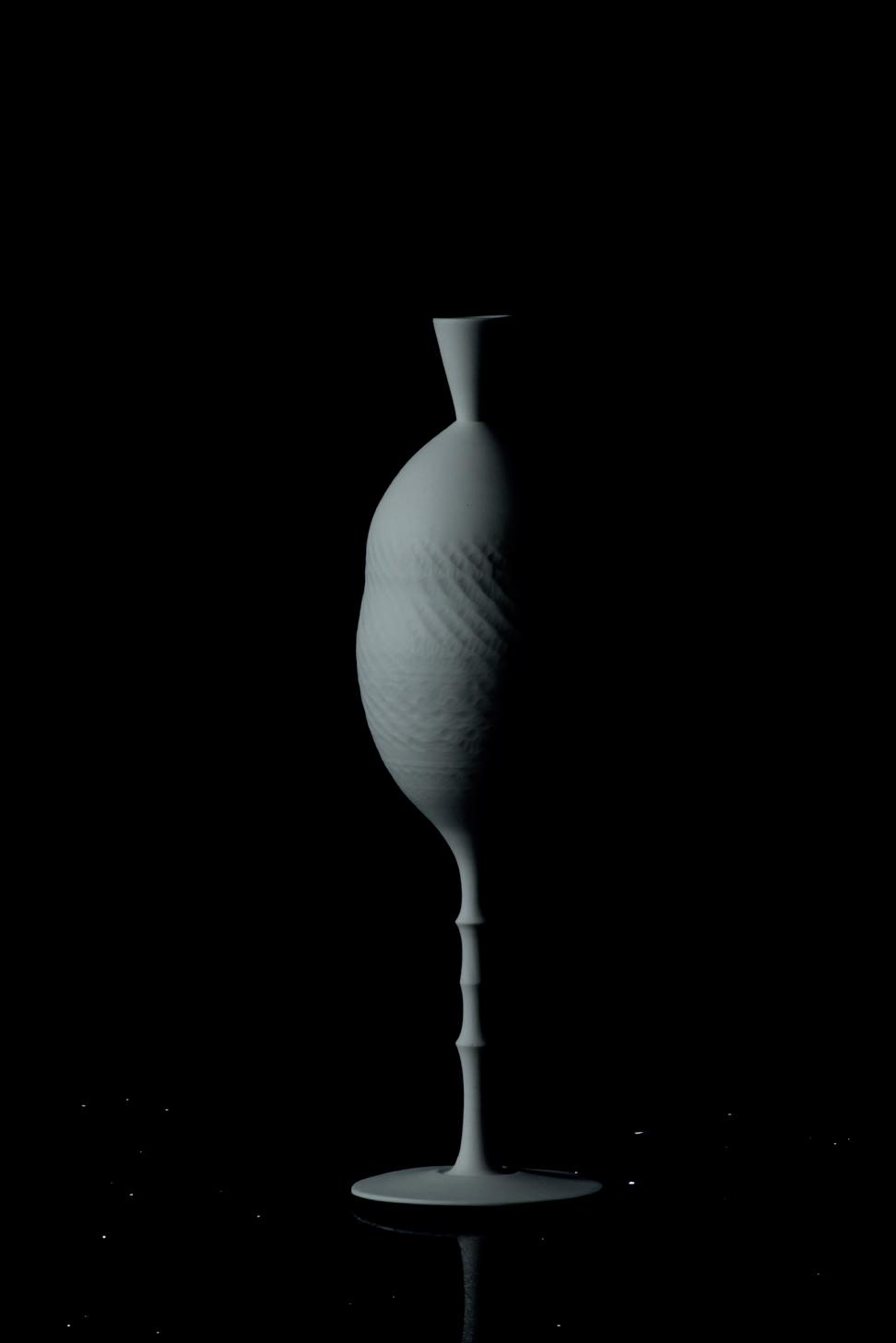
Stemmed Object 2
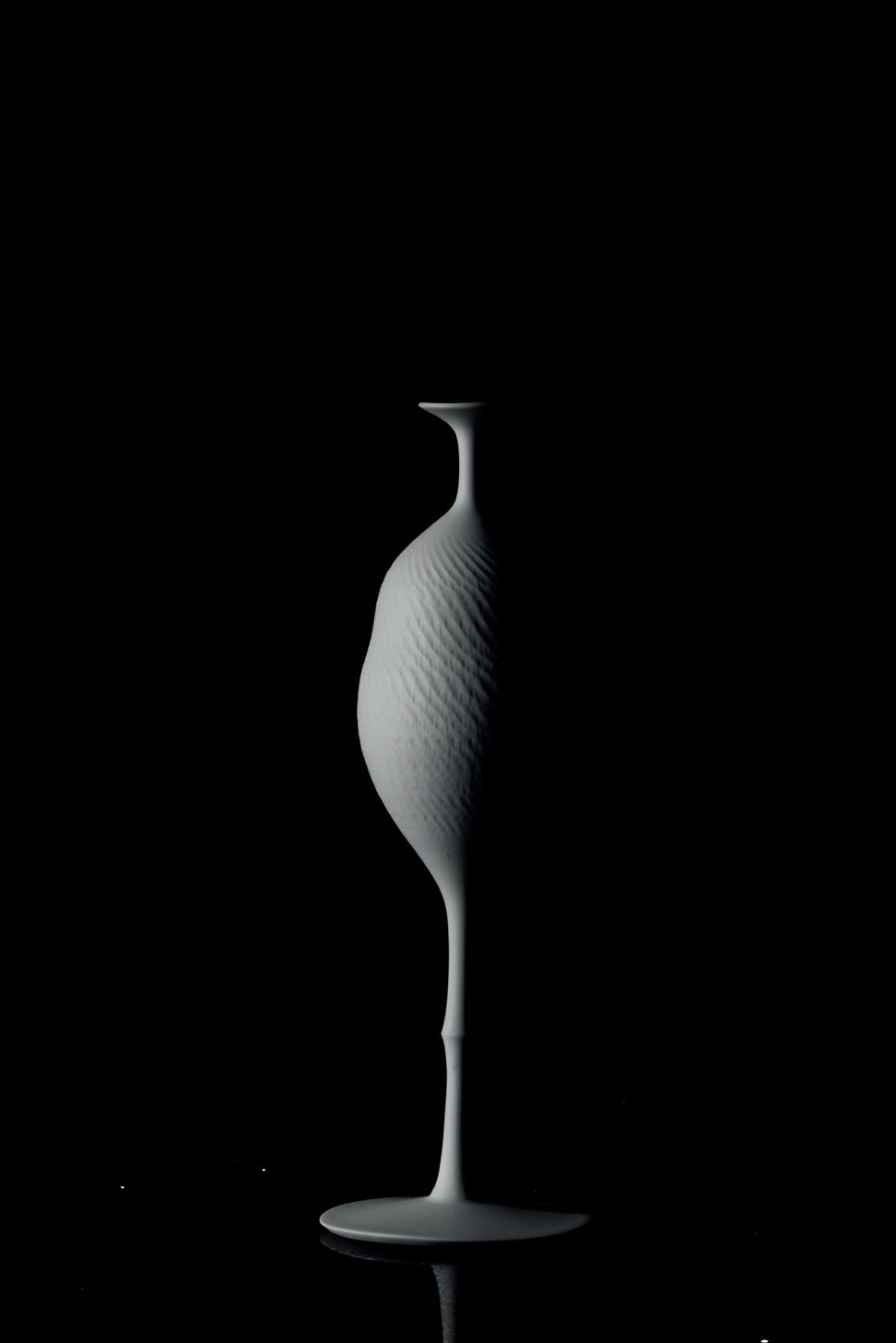
Wheel-thrown porcelain, snow glaze interior and chattered body
H 28 cm, ø 9 cm
Stemmed Object 3
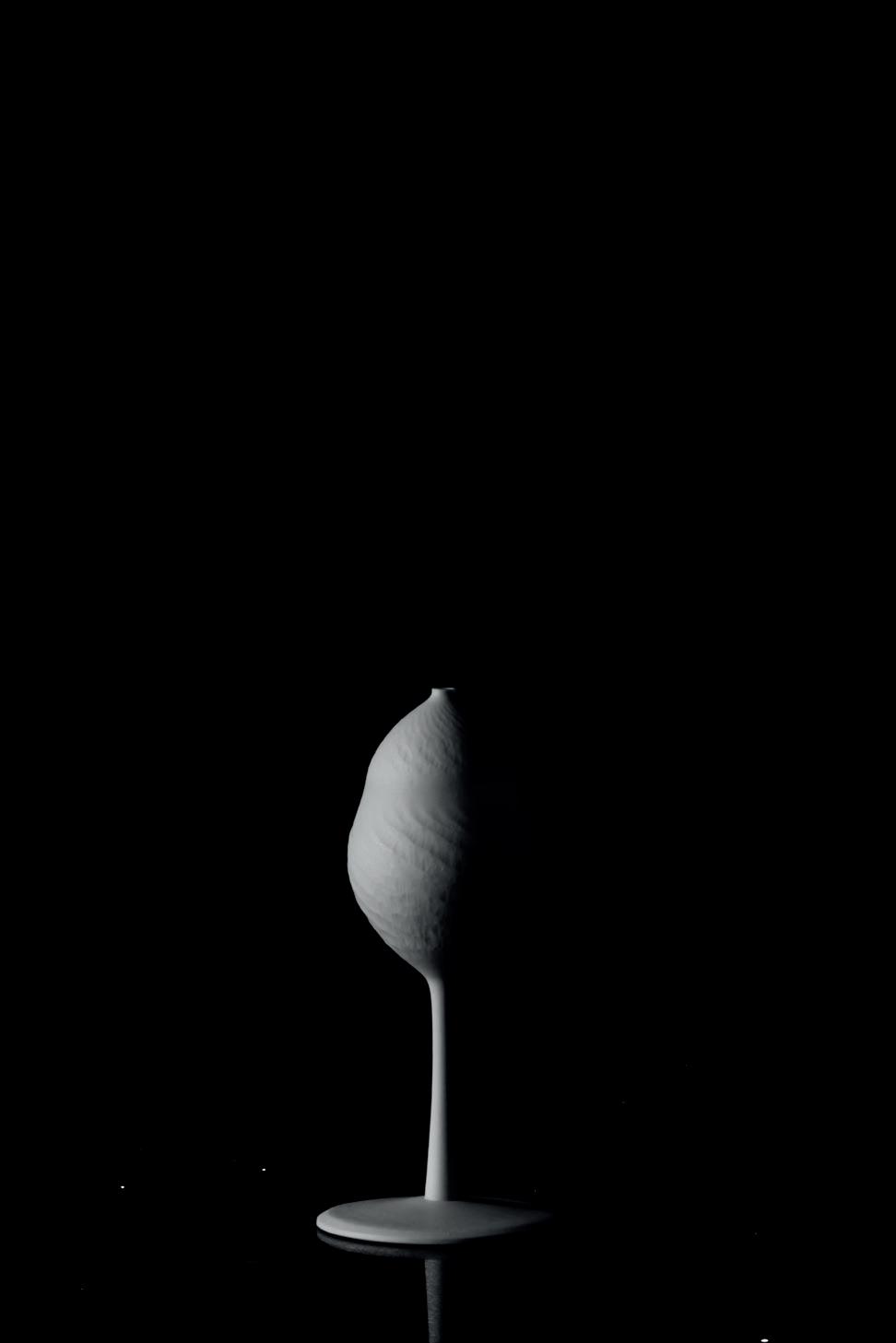
Wheel-thrown porcelain, snow glaze interior and chattered body
H 17 cm, ø 8 cm
Stemmed Object 4
Wheel-thrown porcelain, snow glaze interior and chattered body
H 15 cm, ø 16 cm
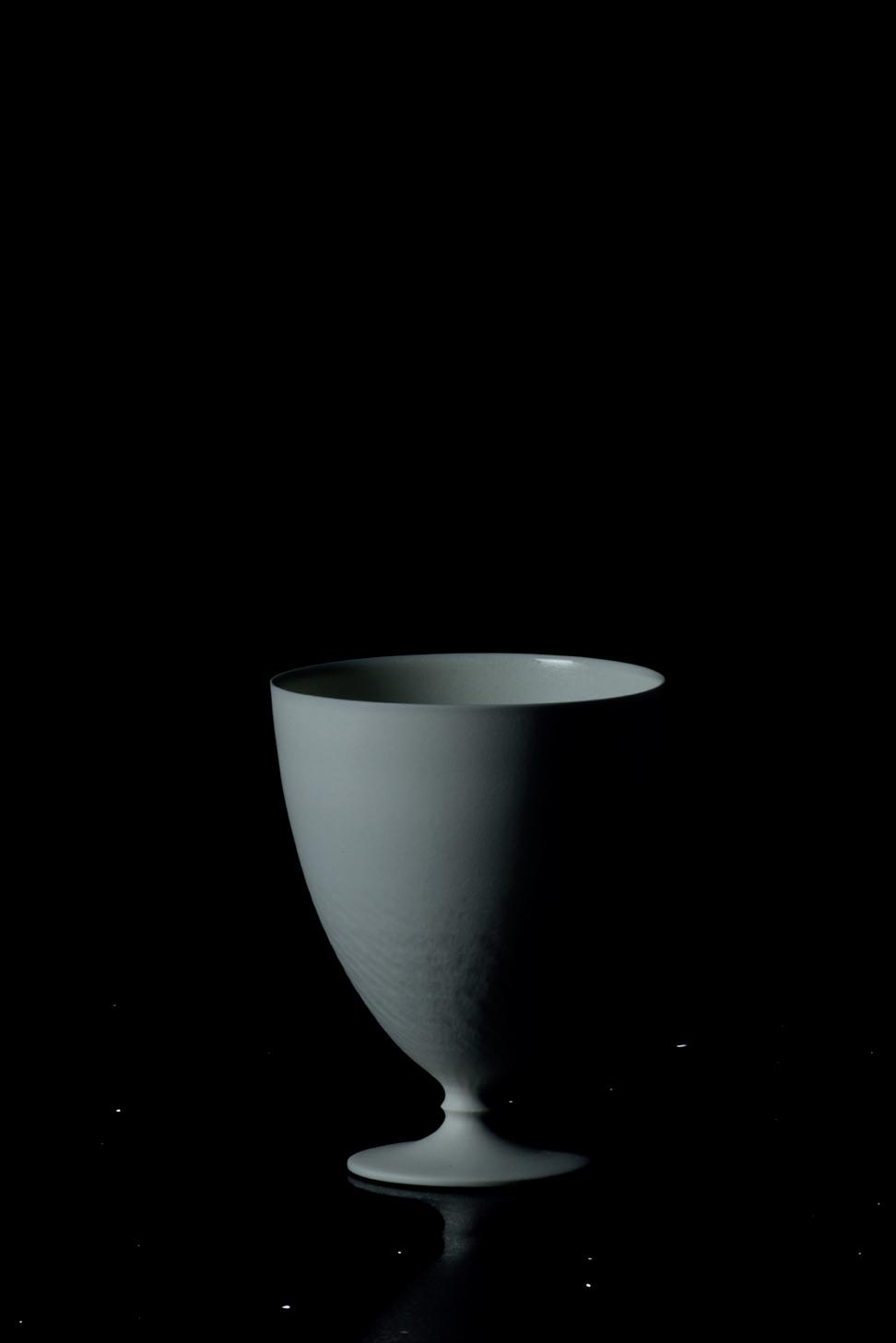
Stemmed Object 5
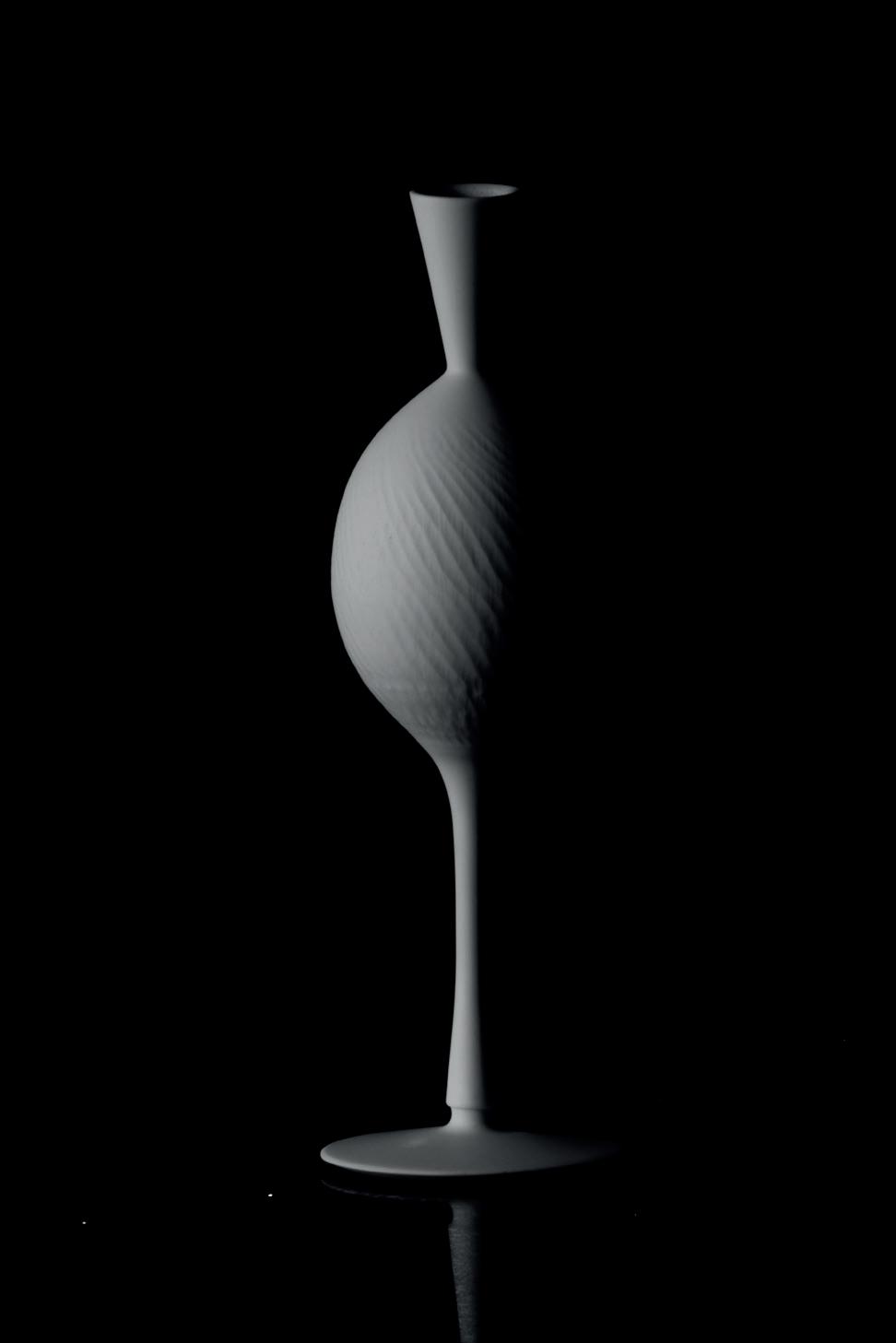
Wheel-thrown porcelain, snow glaze interior and chattered body
H 26 cm, ø 8 cm
Stemmed Object 6
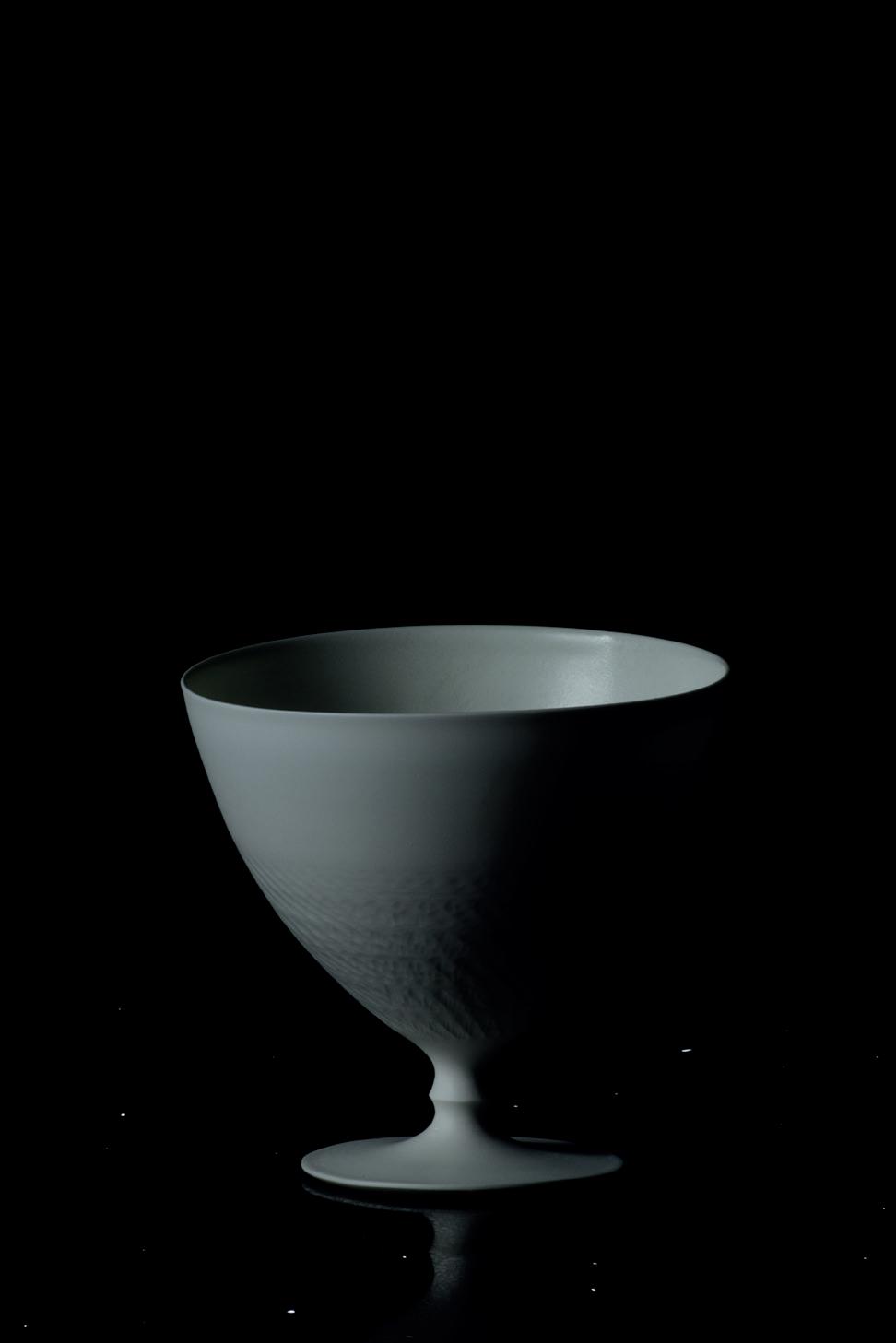
Wheel-thrown porcelain, snow glaze interior and chattered body
H 15 cm, ø 18 cm
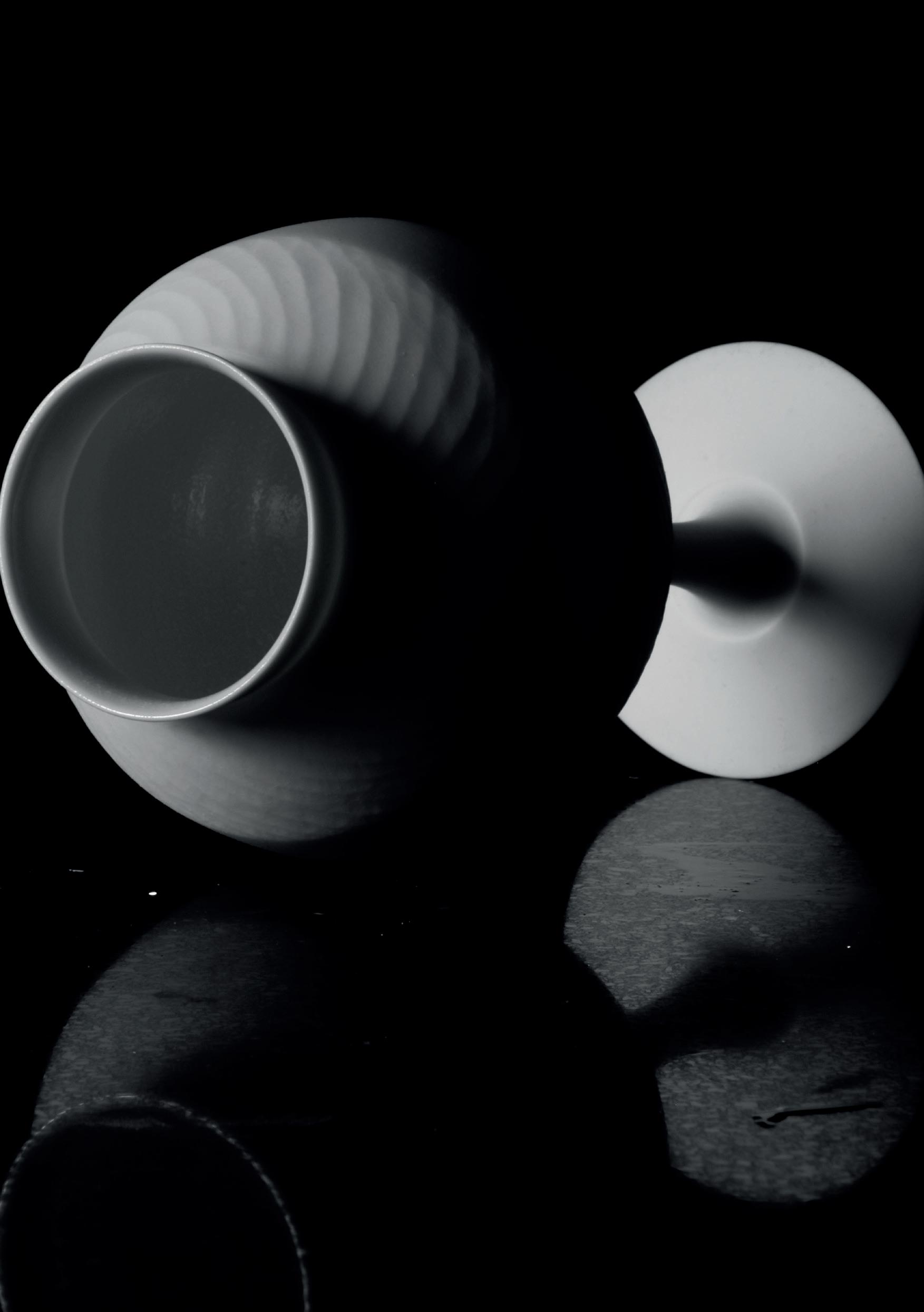
Stemmed Moons
Thrown in porcelain, Matthew’s stemmed Moons offer contrast and scale to his larger works in this collection, bringing attention and appreciation to aspects of each which may go unseen, alone.
As an exercise into the technical difficulties of porcelain works, Matthew tries to convey a harmony between architectural construction and firing methodology with a refined approach to aesthetic. Soft lines and delicate texture veiling the arduous and technical practicality.
Stemmed Moon 1
Wheel-thrown porcelain and chattered body
H 16 cm, ø 9 cm
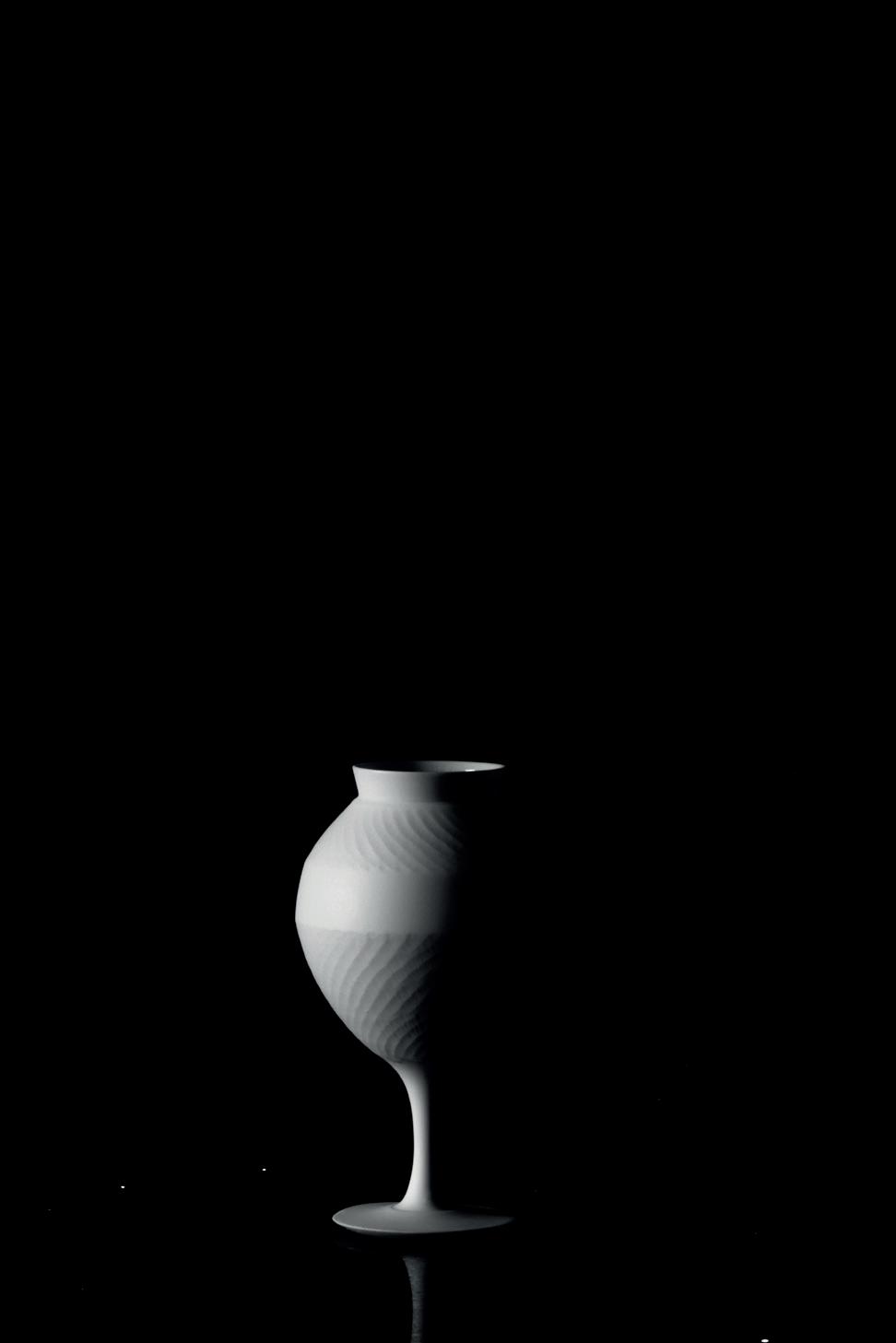
Stemmed Moon 2
Wheel-thrown porcelain and chattered body
H 16 cm, ø 8 cm
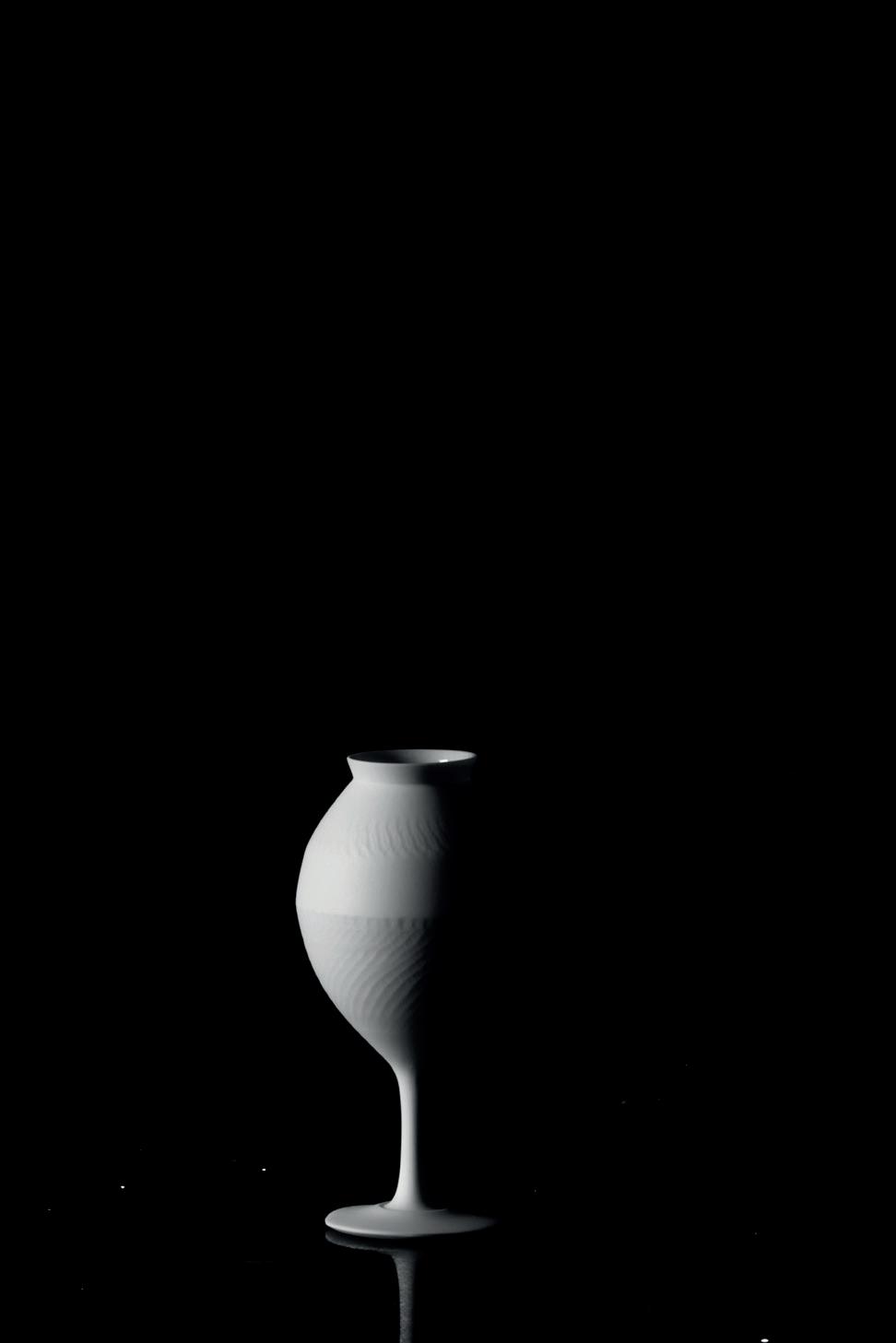
Stemmed Moon 3
Wheel-thrown porcelain and chattered body
H 17 cm, ø 10 cm
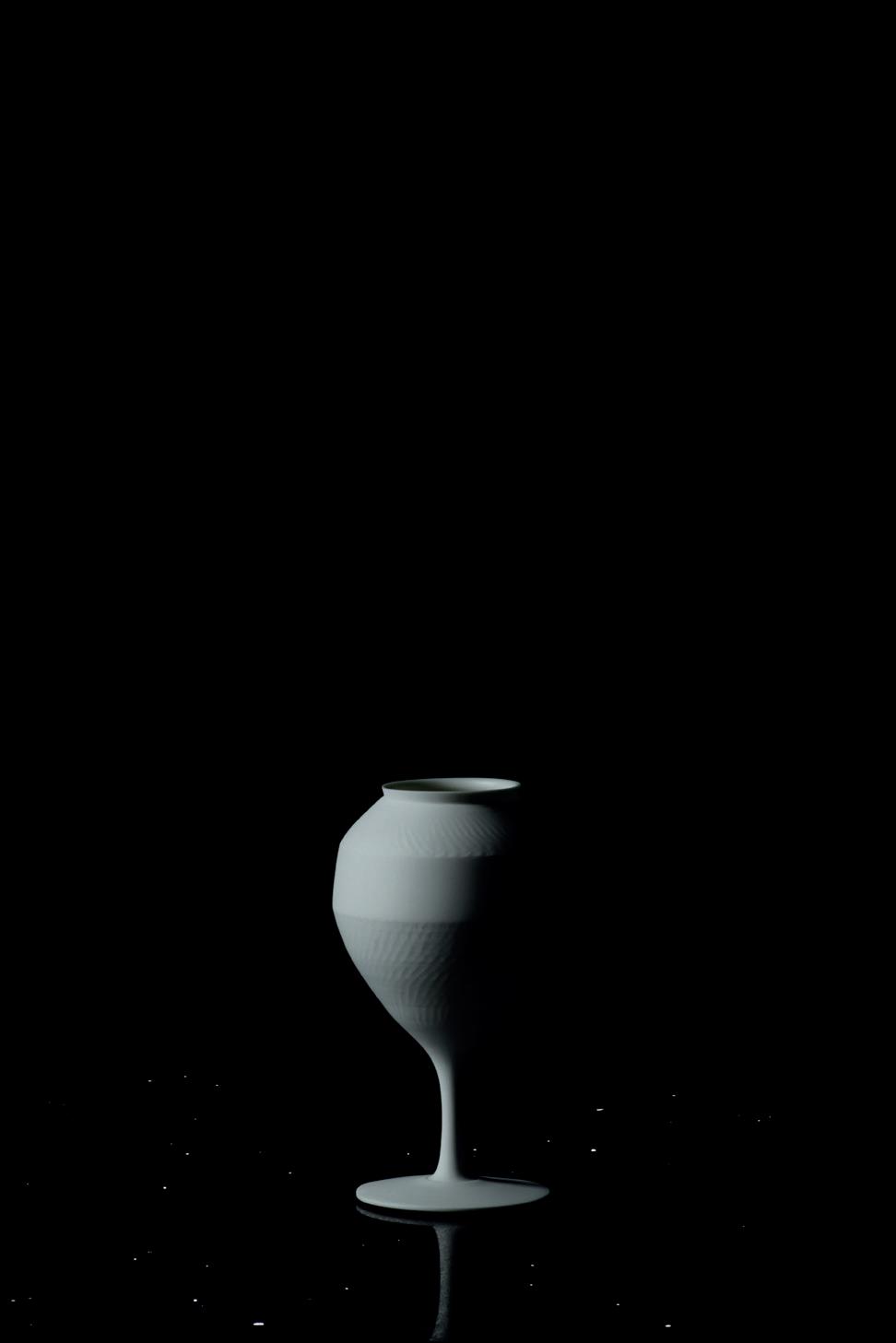
Stemmed Moon 4
Wheel-thrown porcelain and chattered body
H 15 cm, ø 8 cm
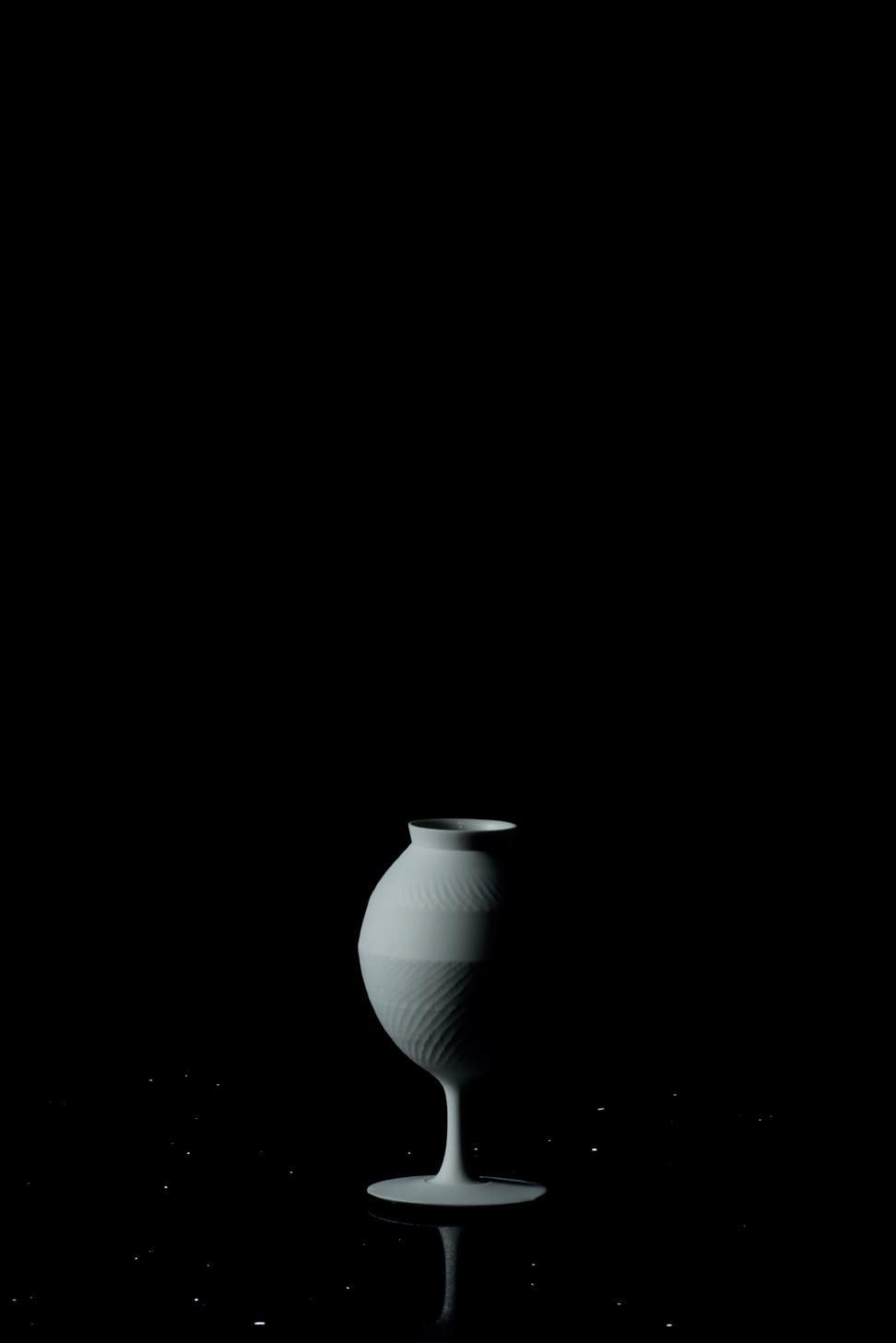
All rights reserved. No part of this publication may be reproducted, stored in a retrieval system or transmitted in any form or by any means electronic, mechanical, photocopying, recording or otherwise without the prior permission of the publishers.
Photography by the artists and Thrown unless otherwise cited.
